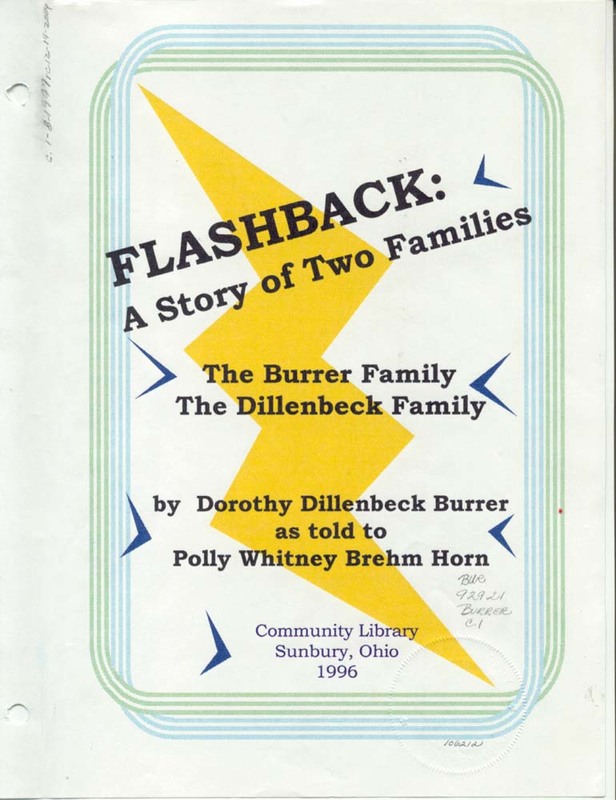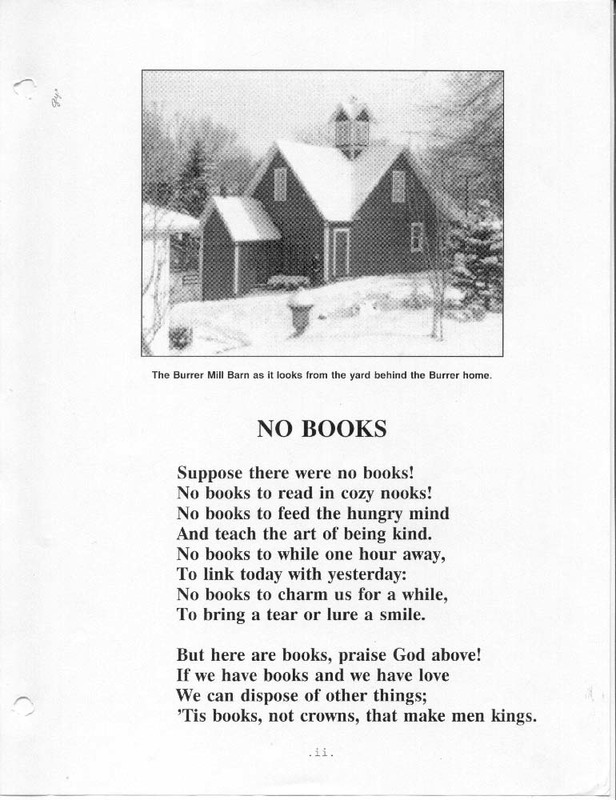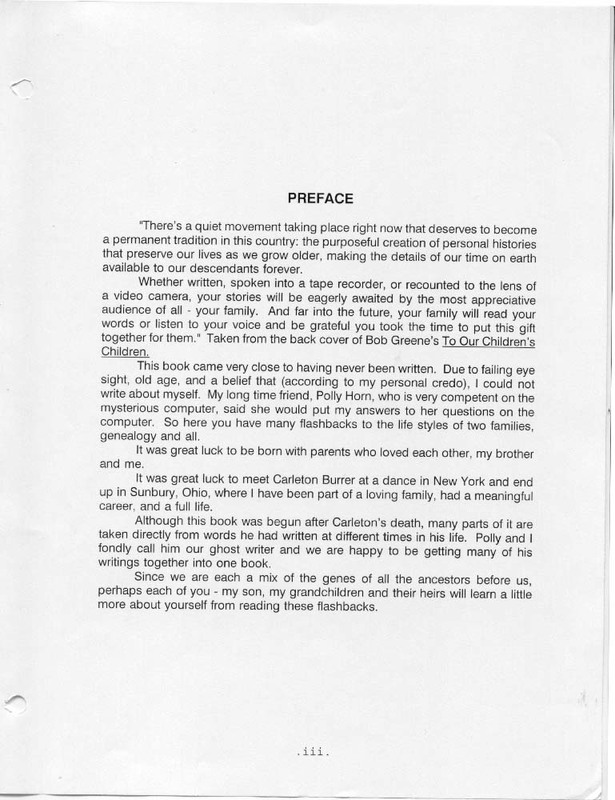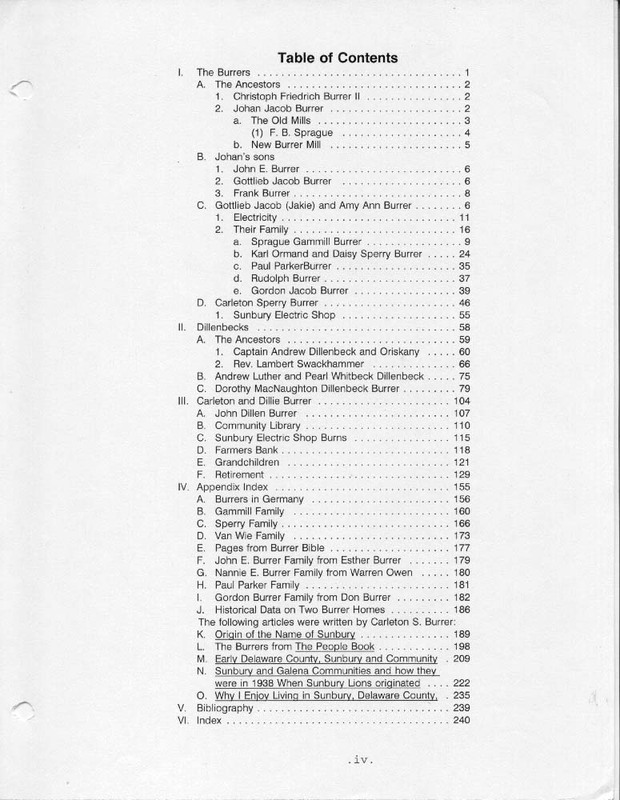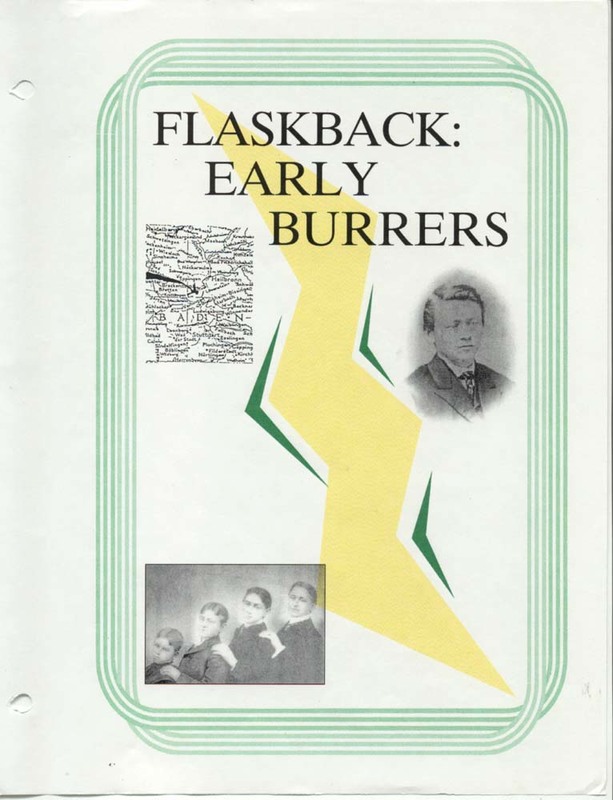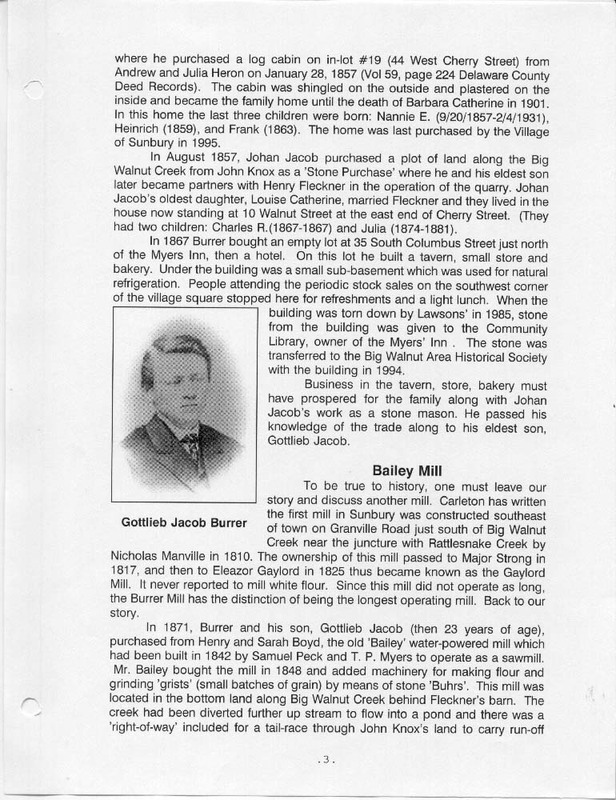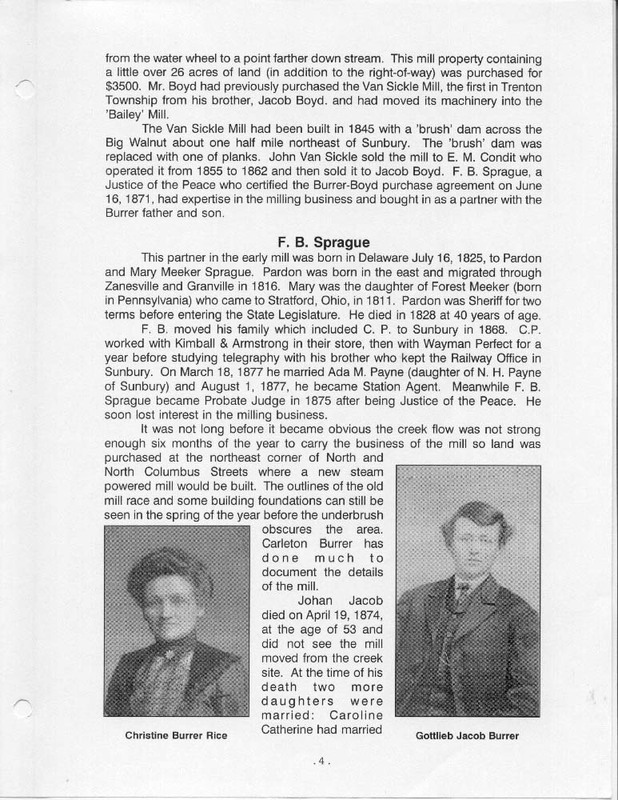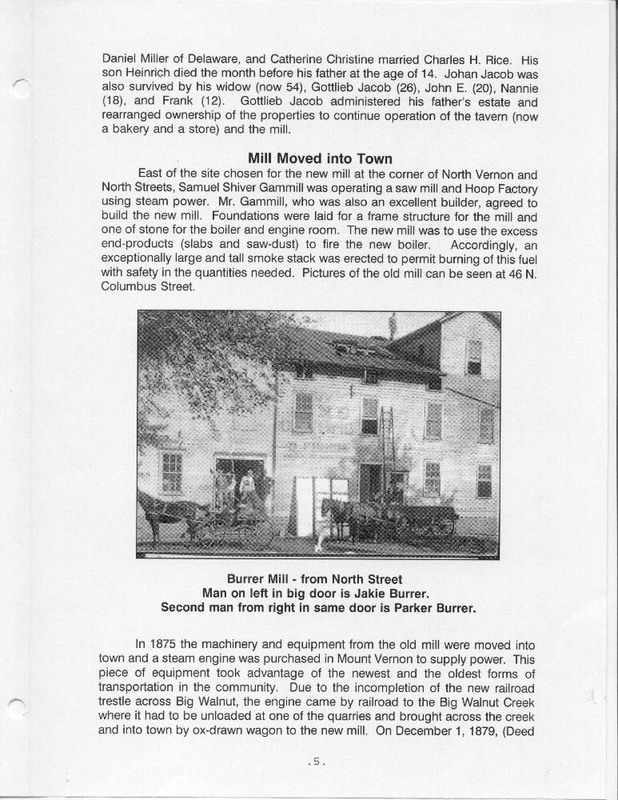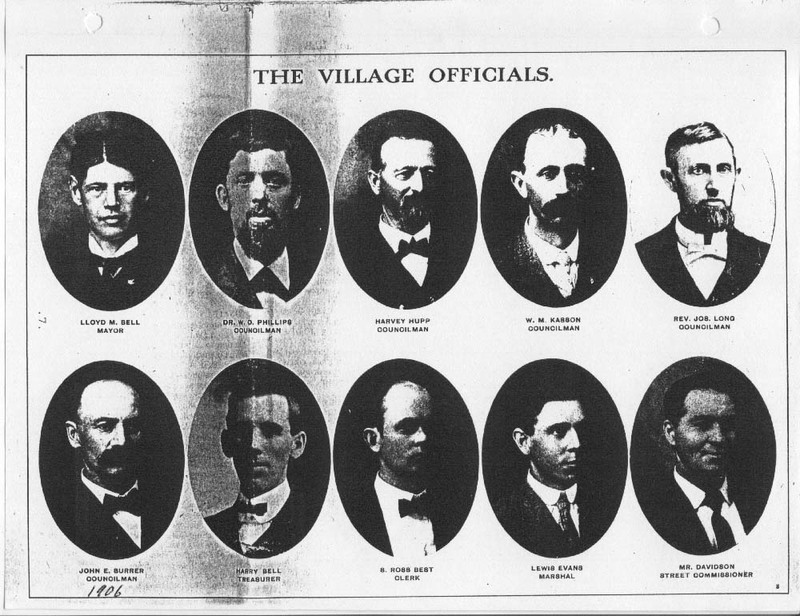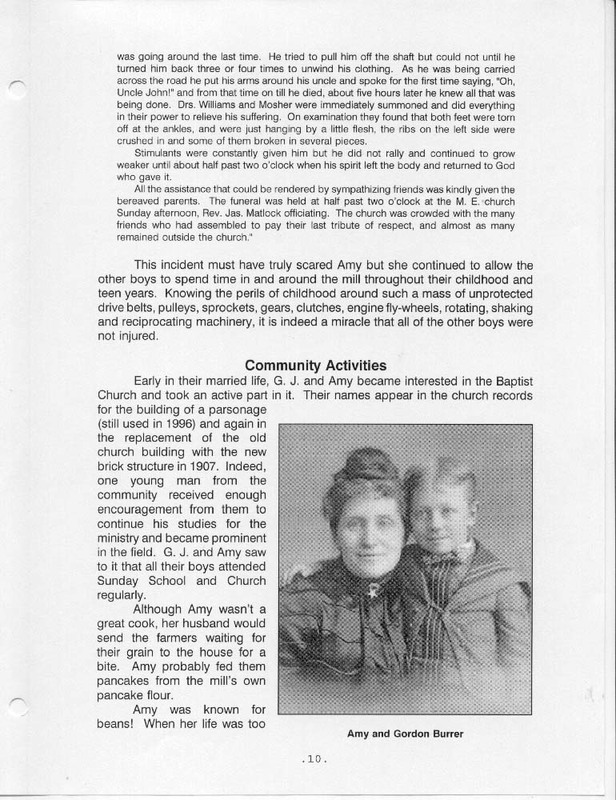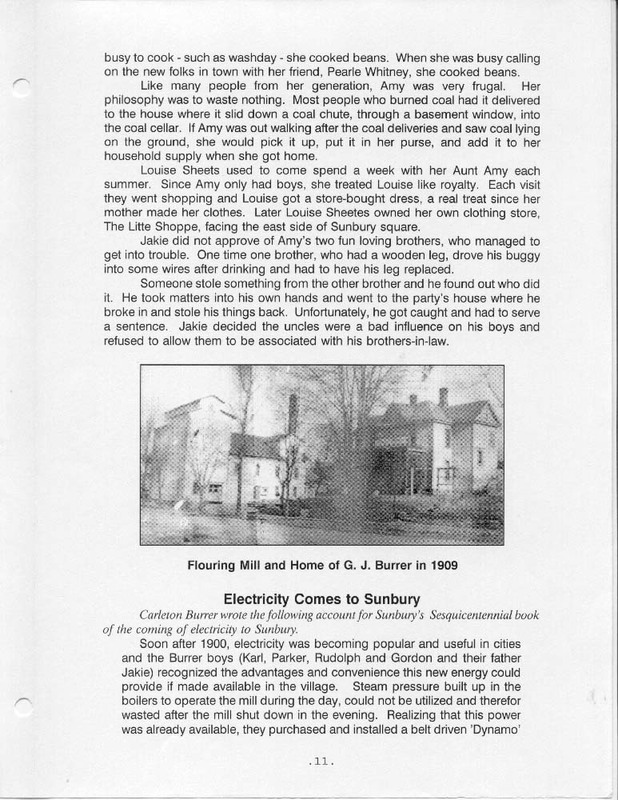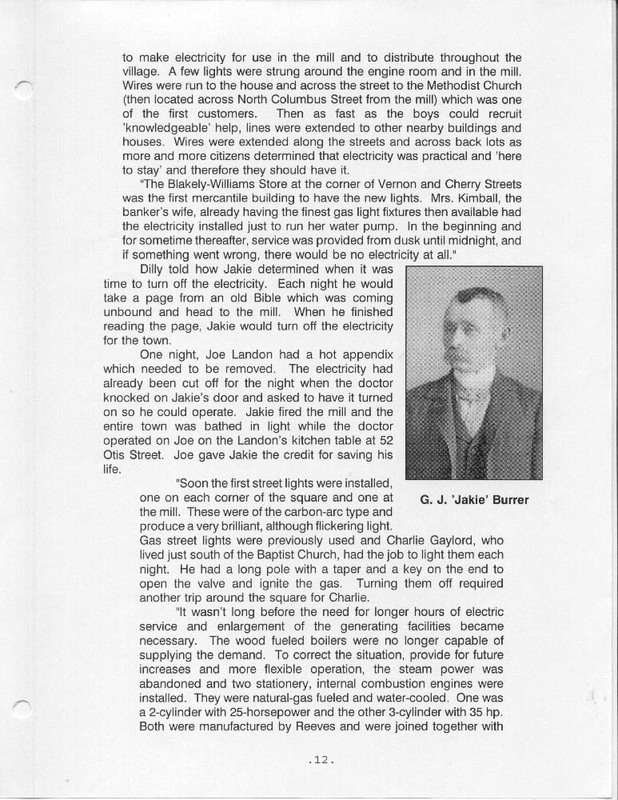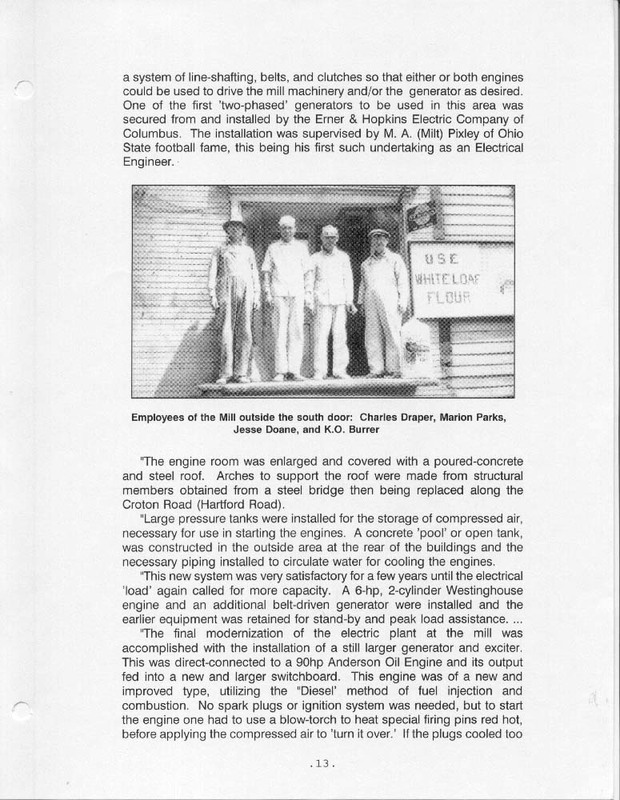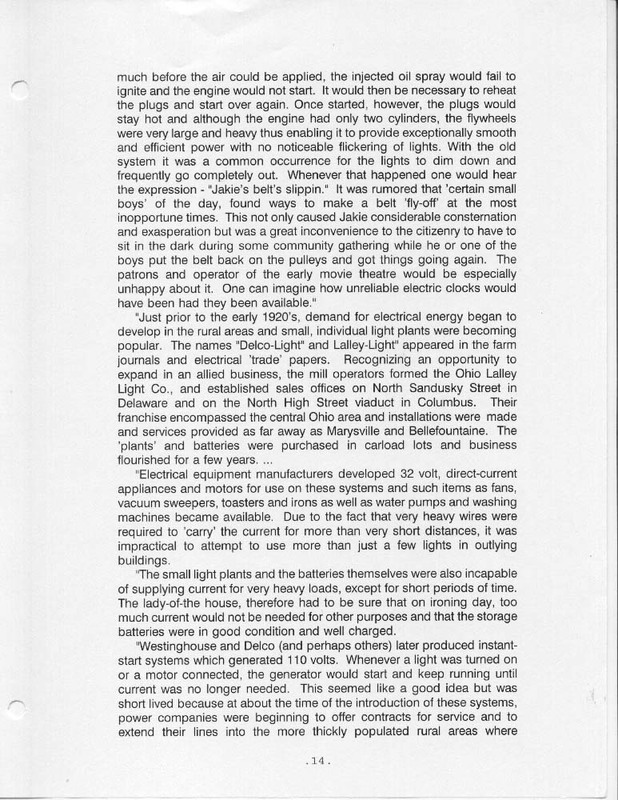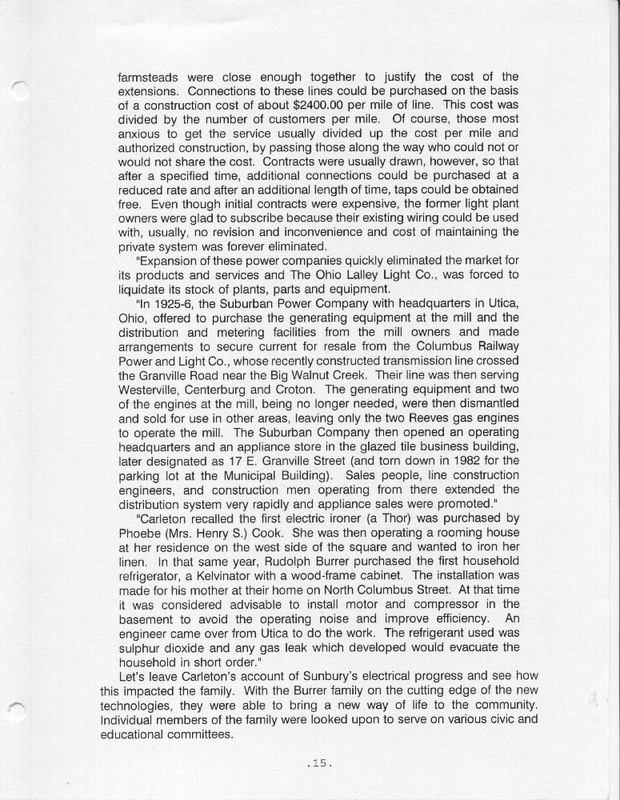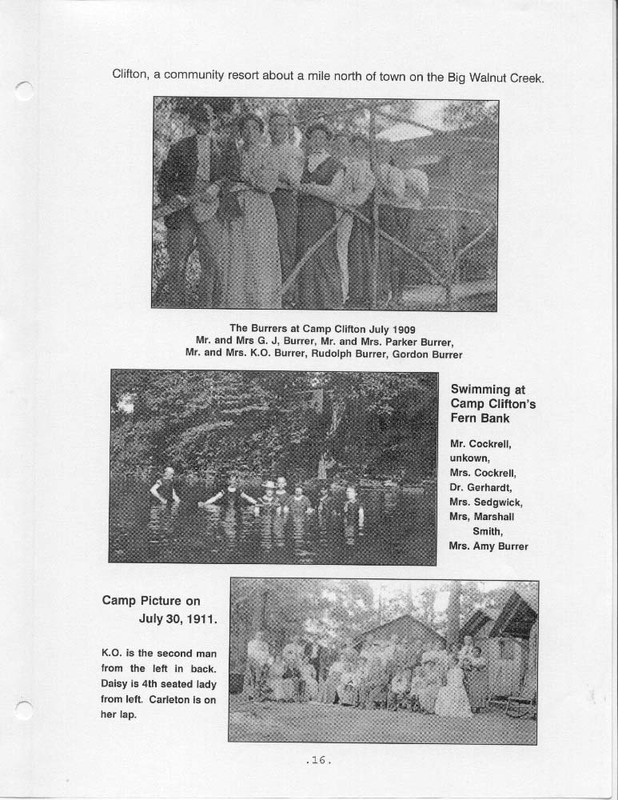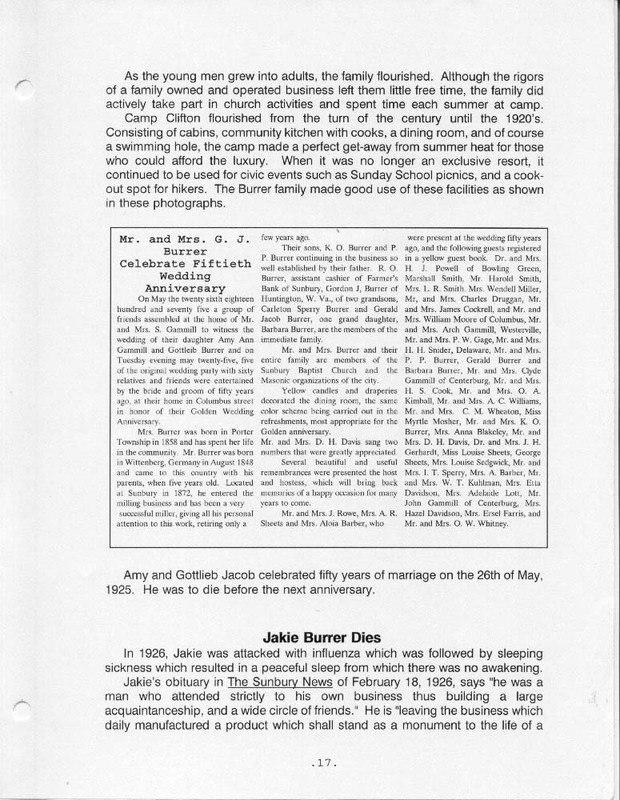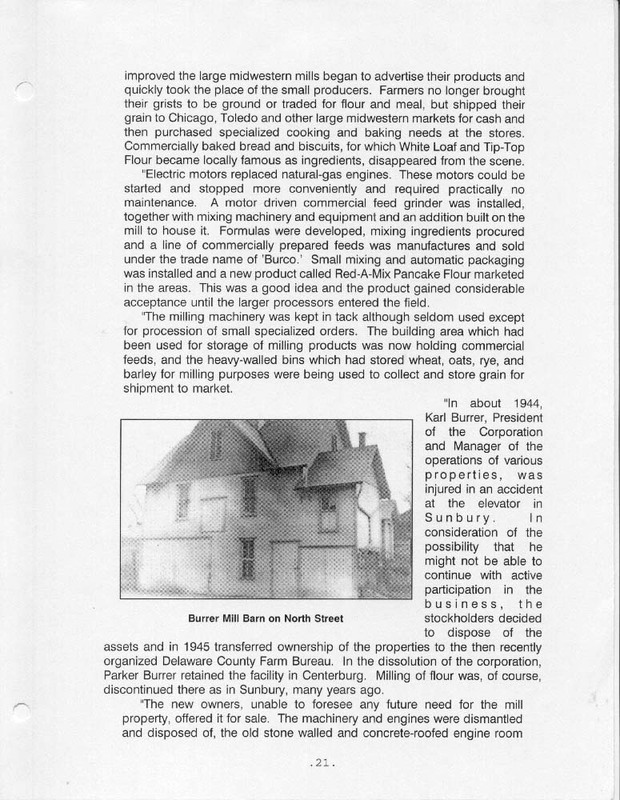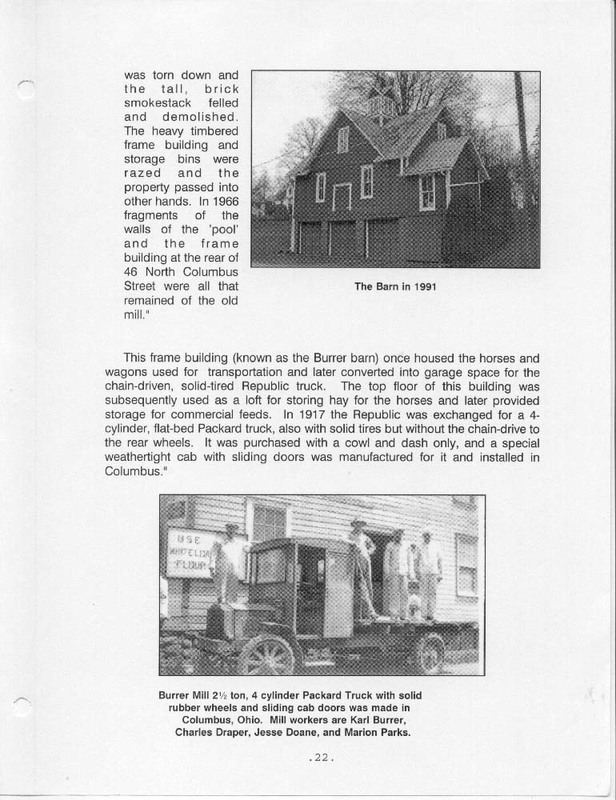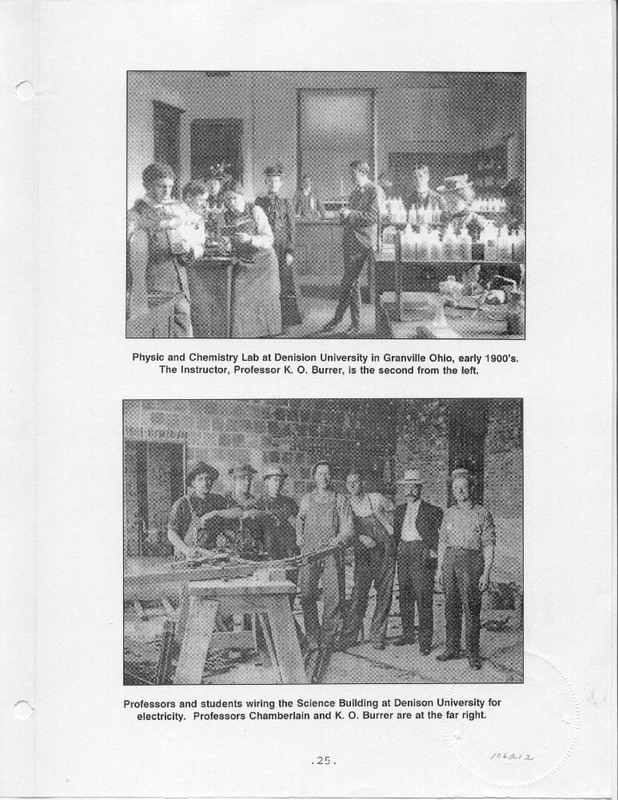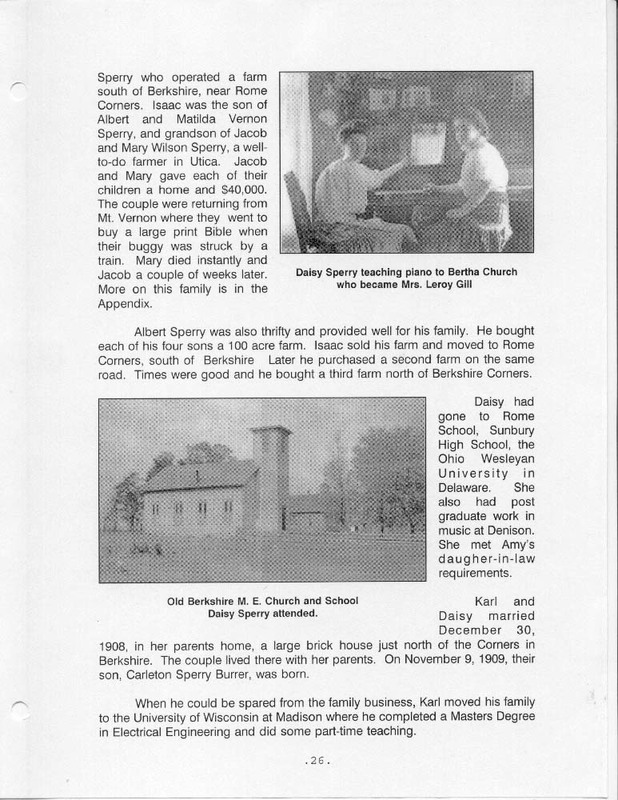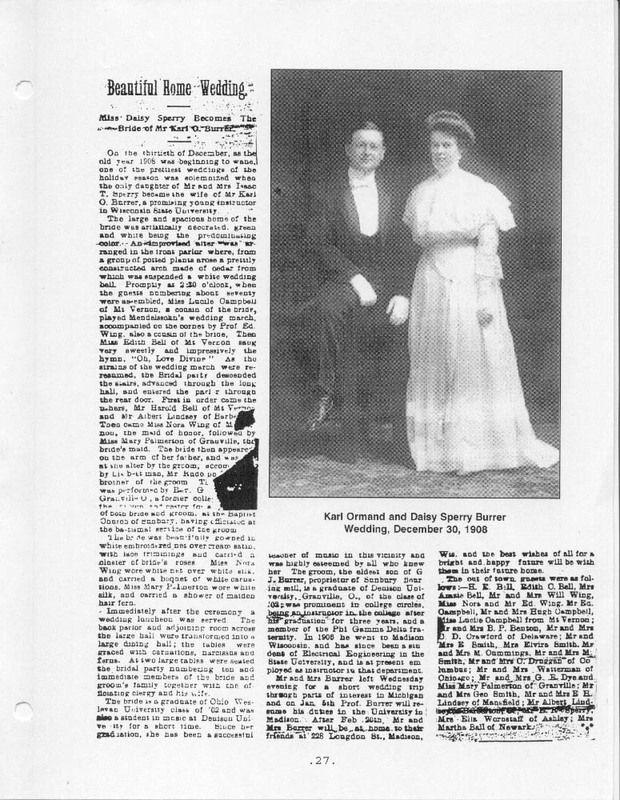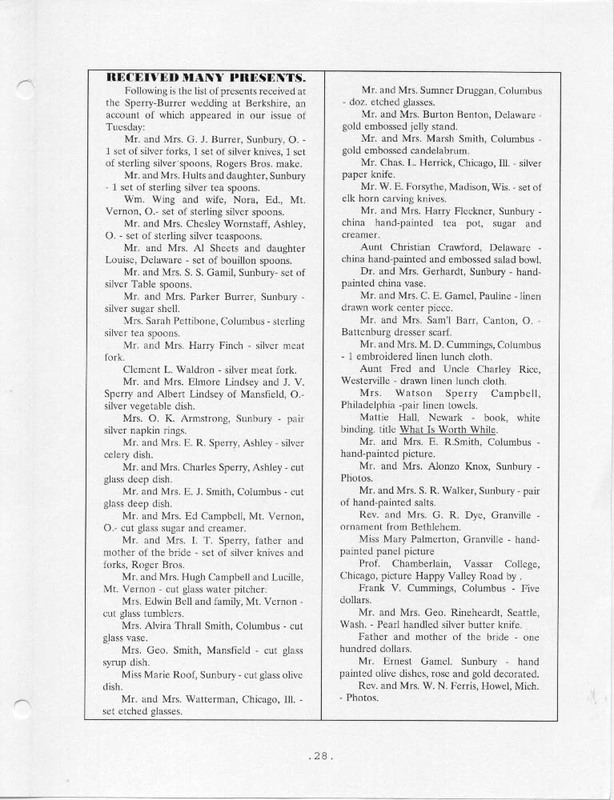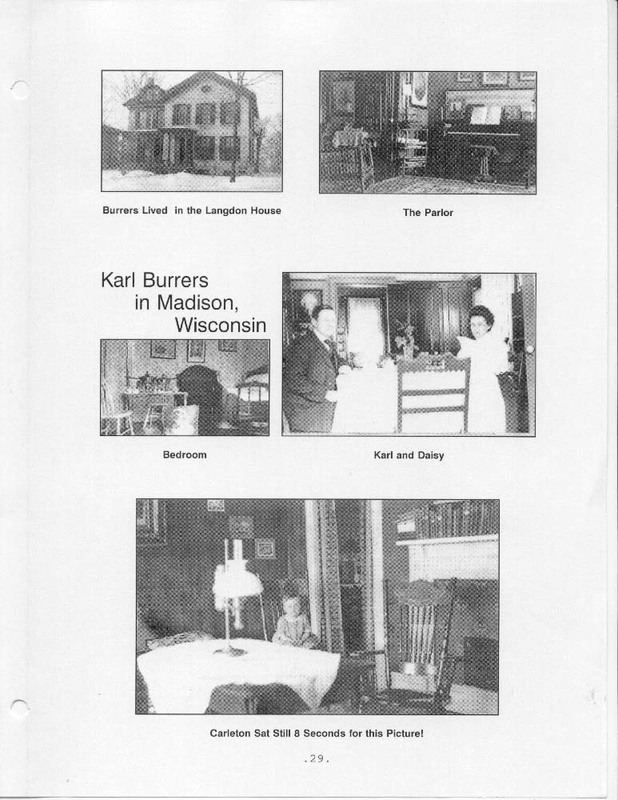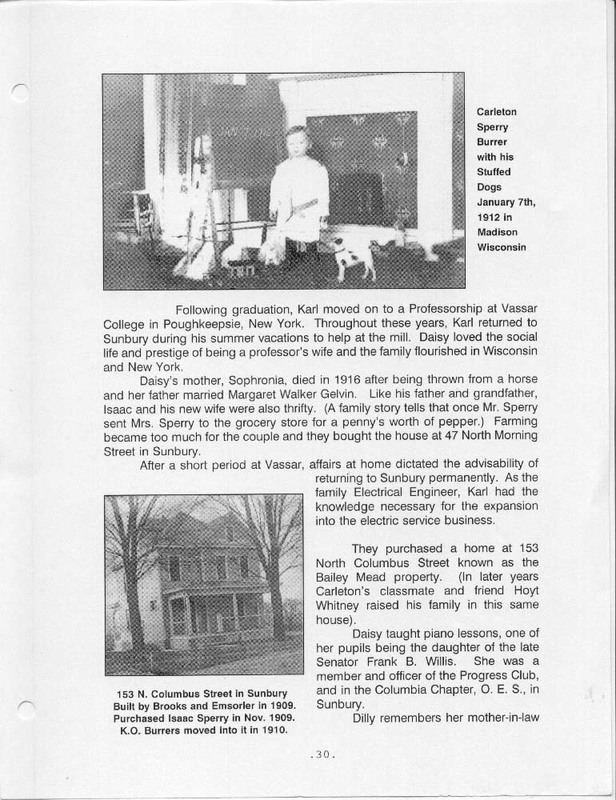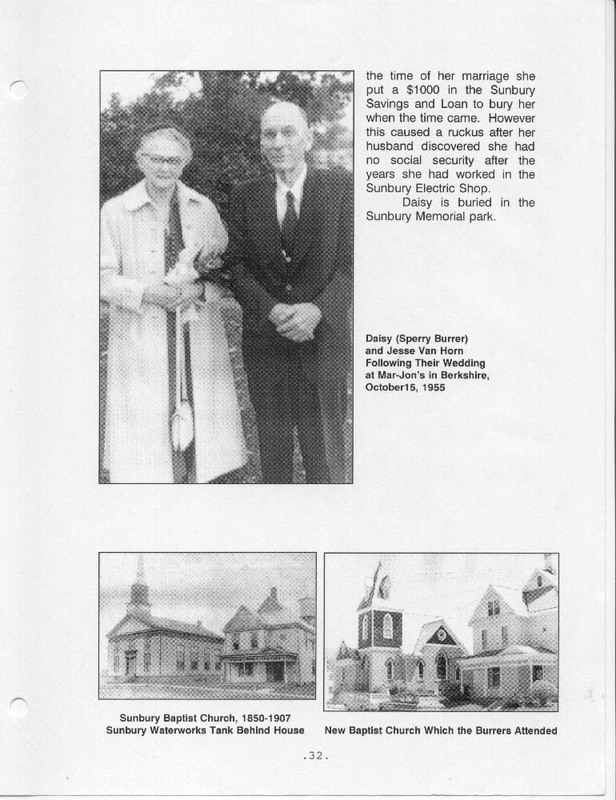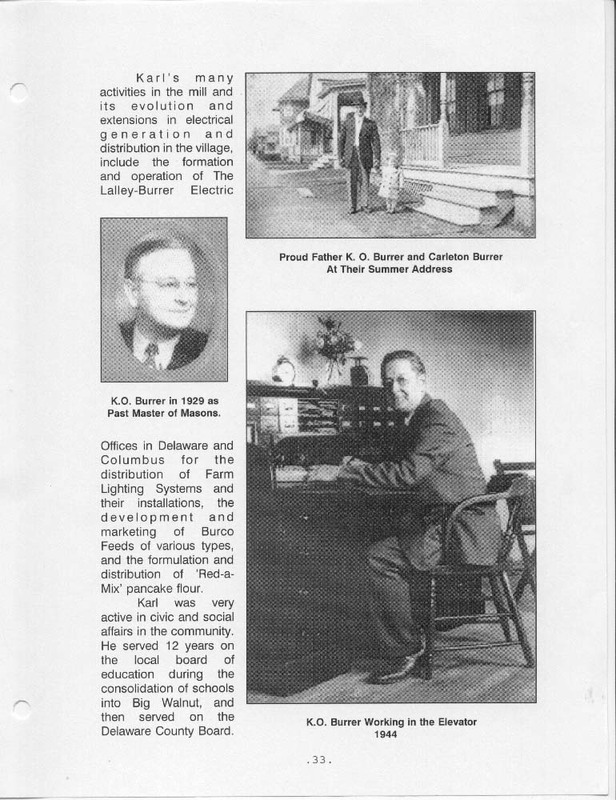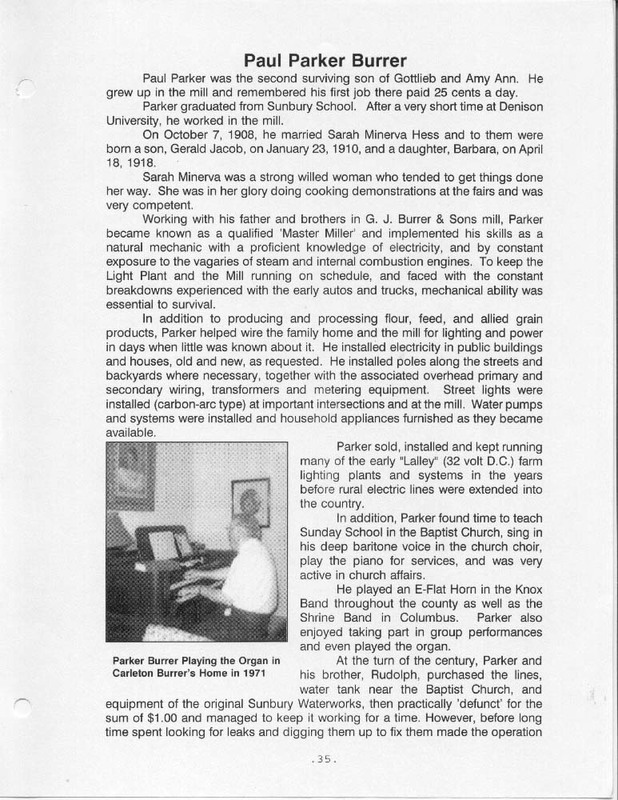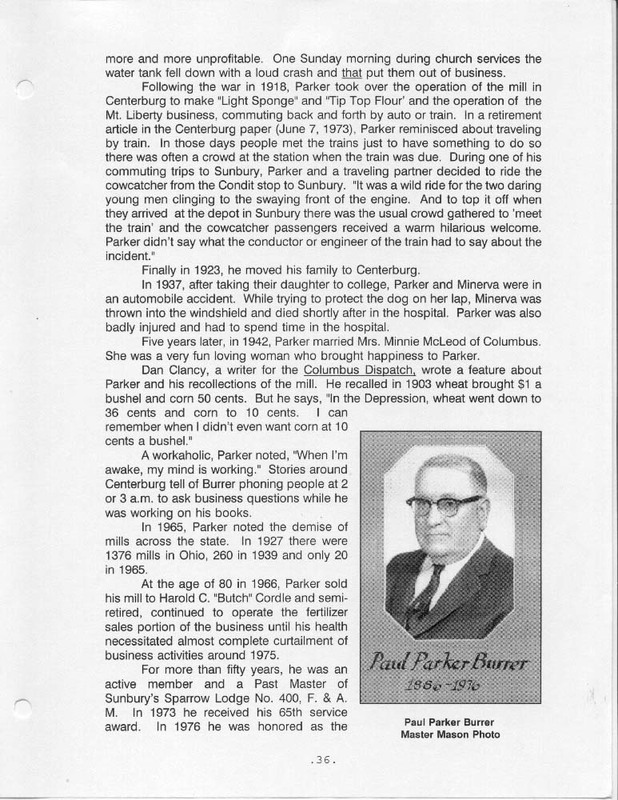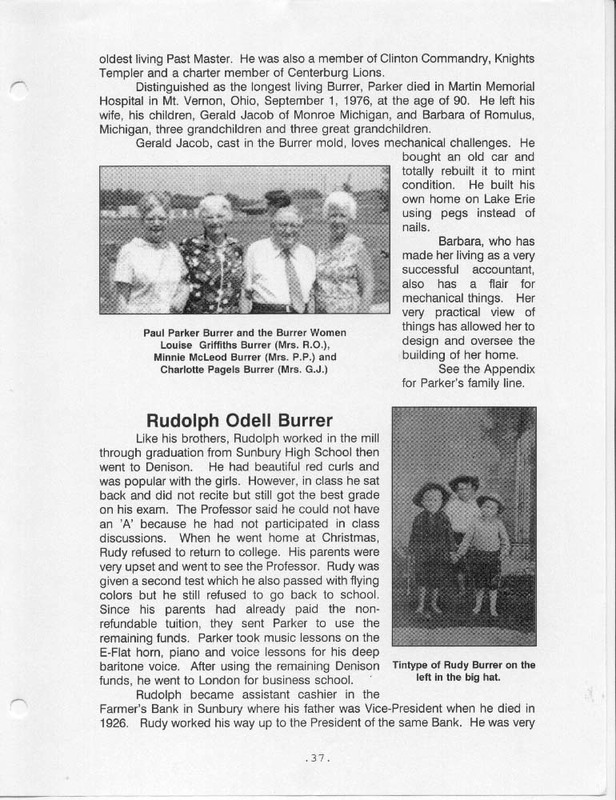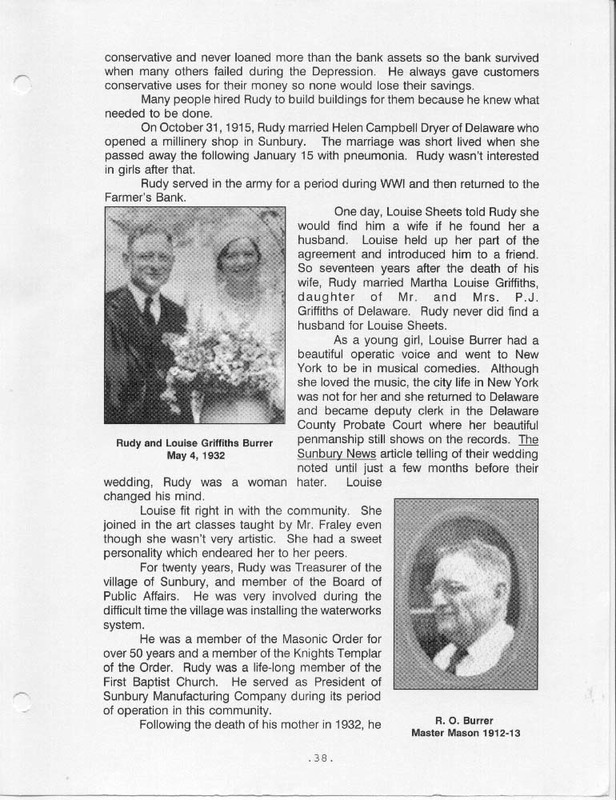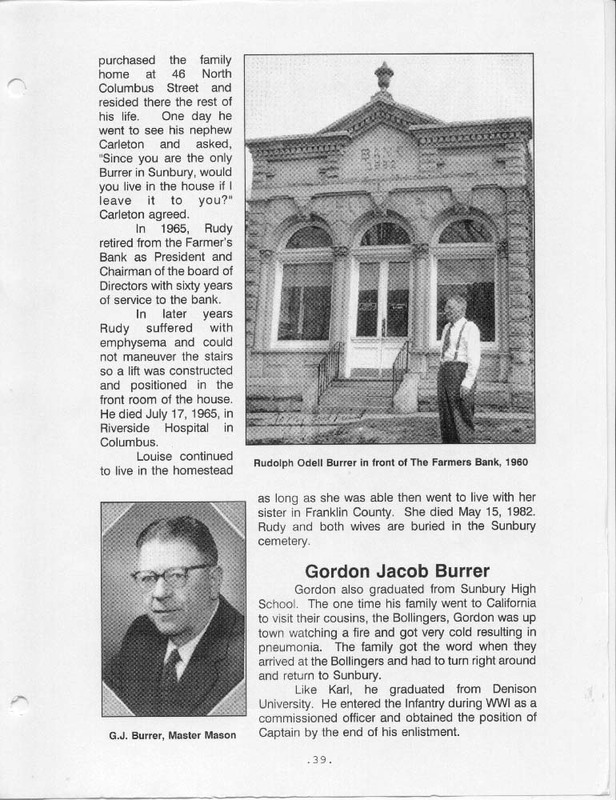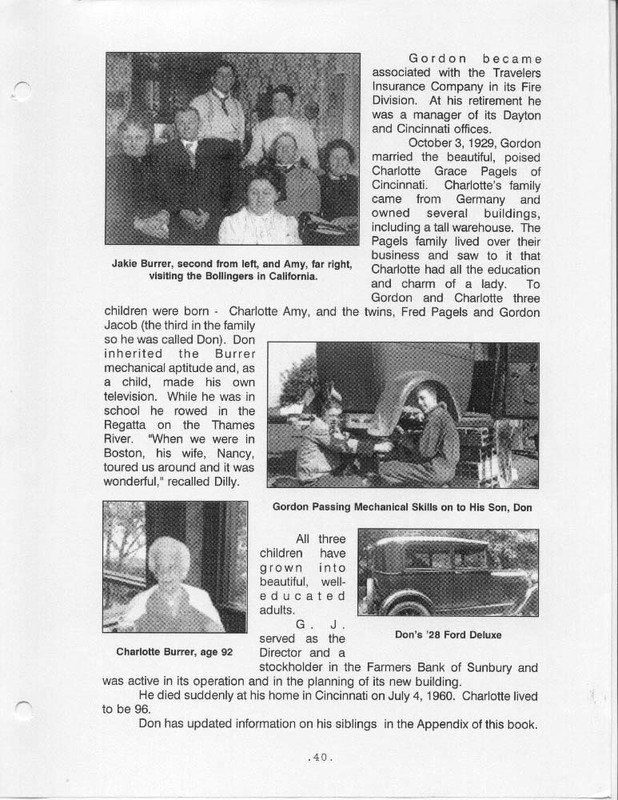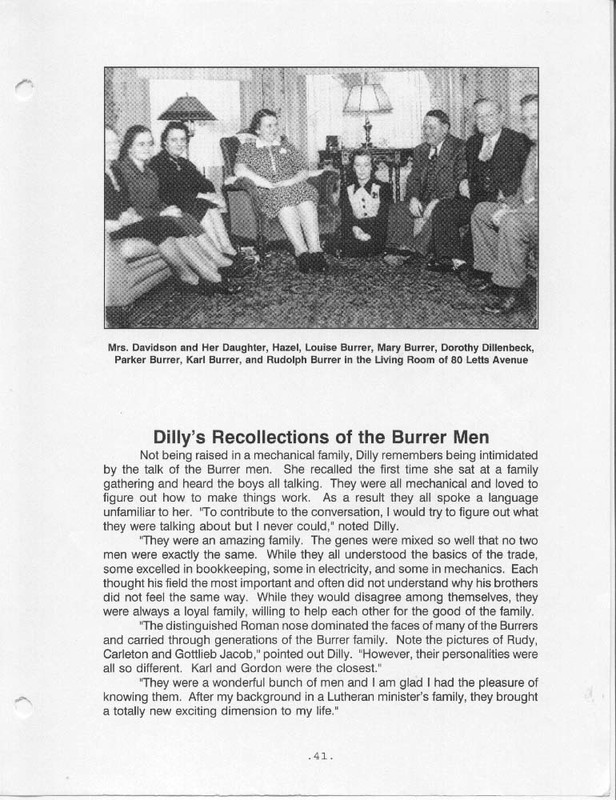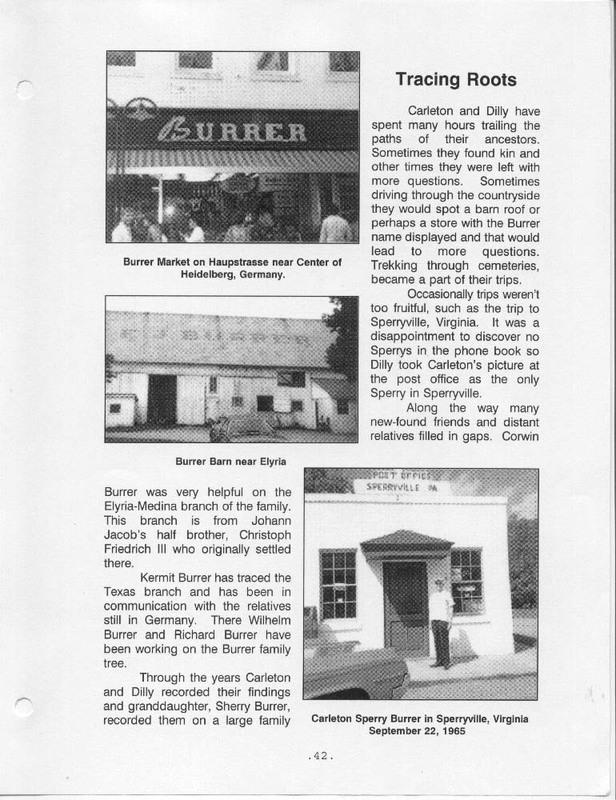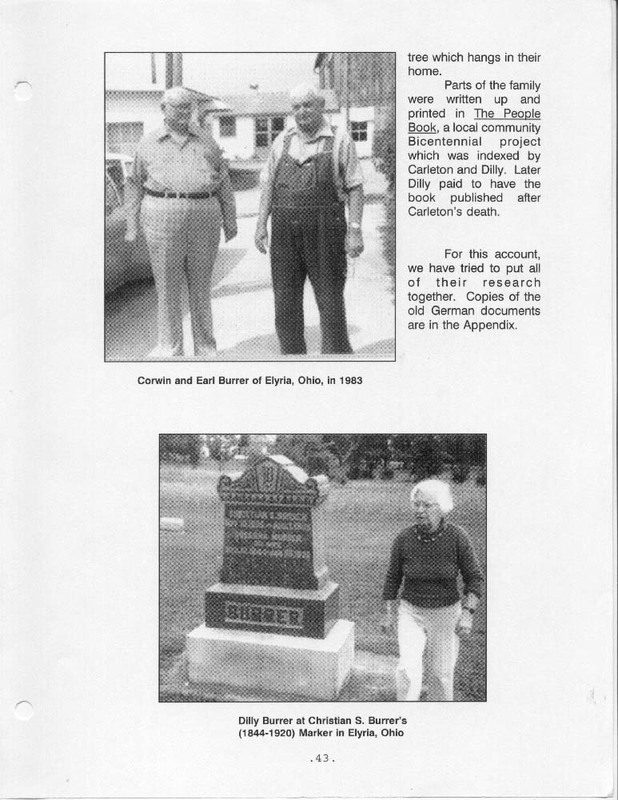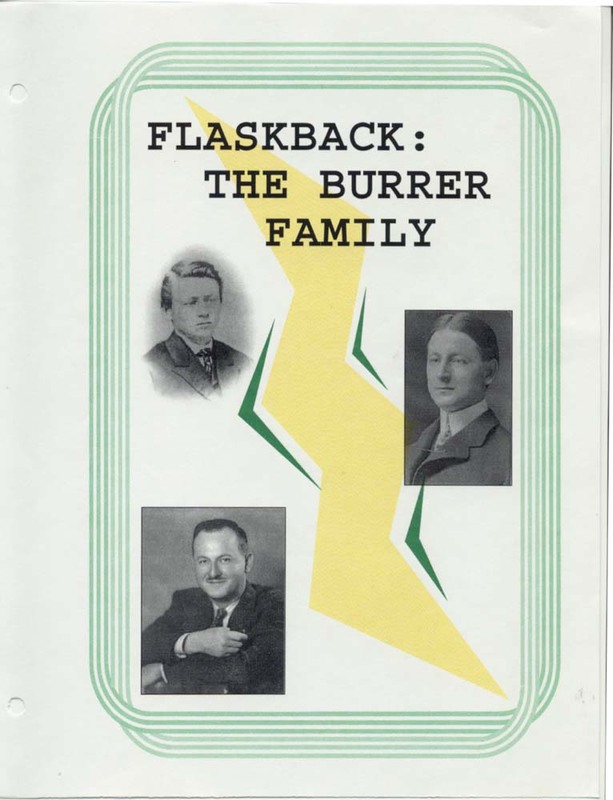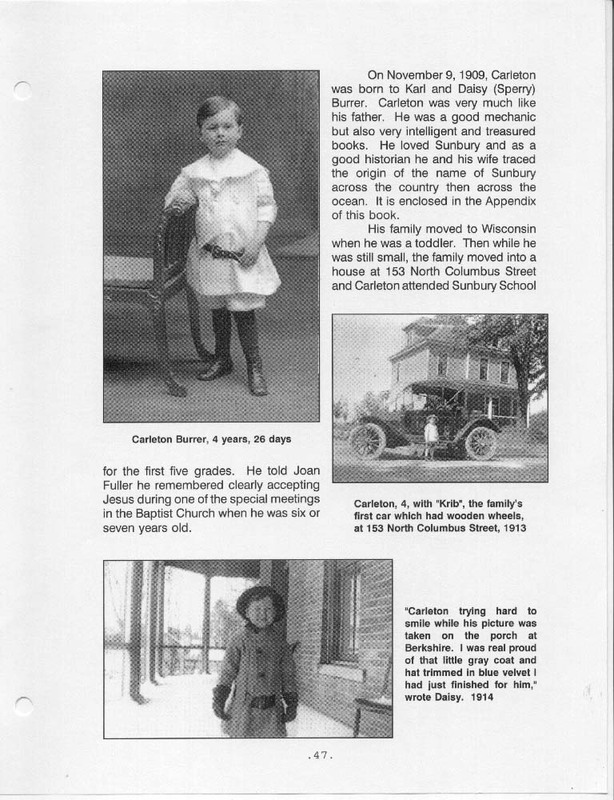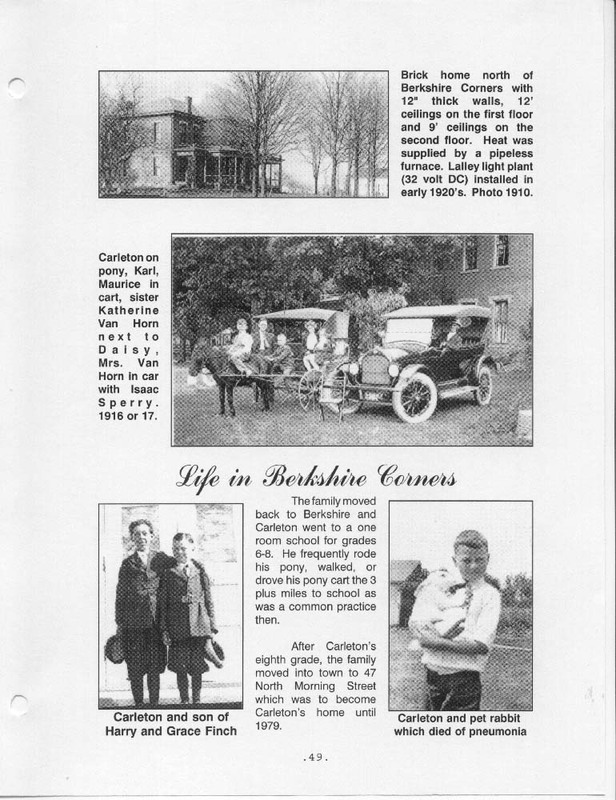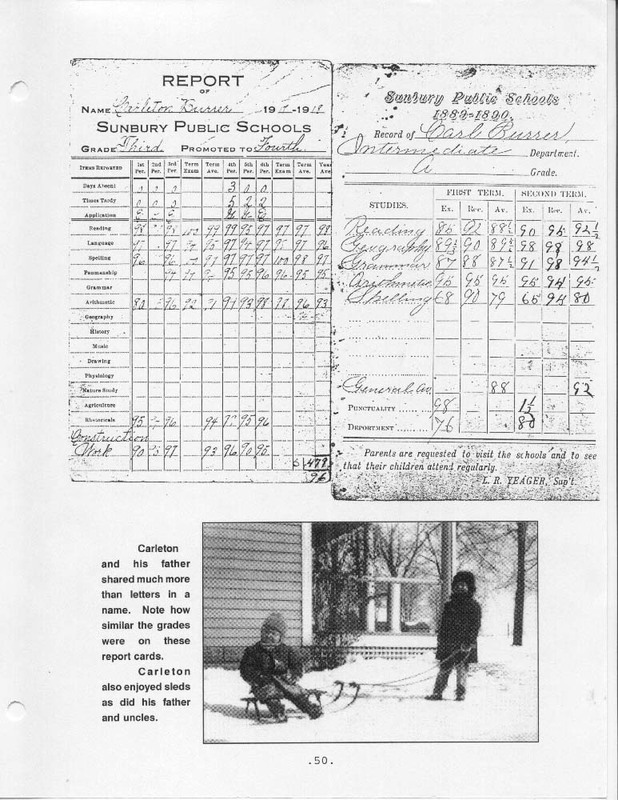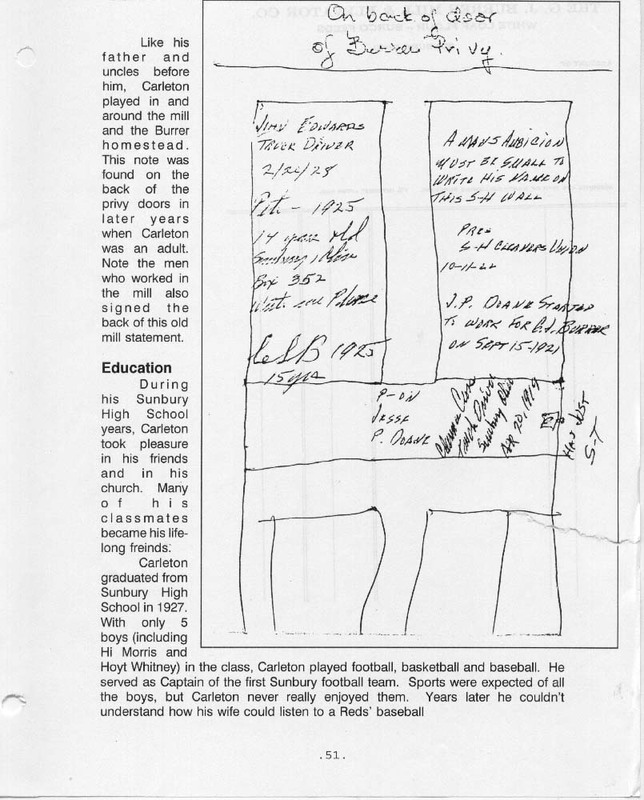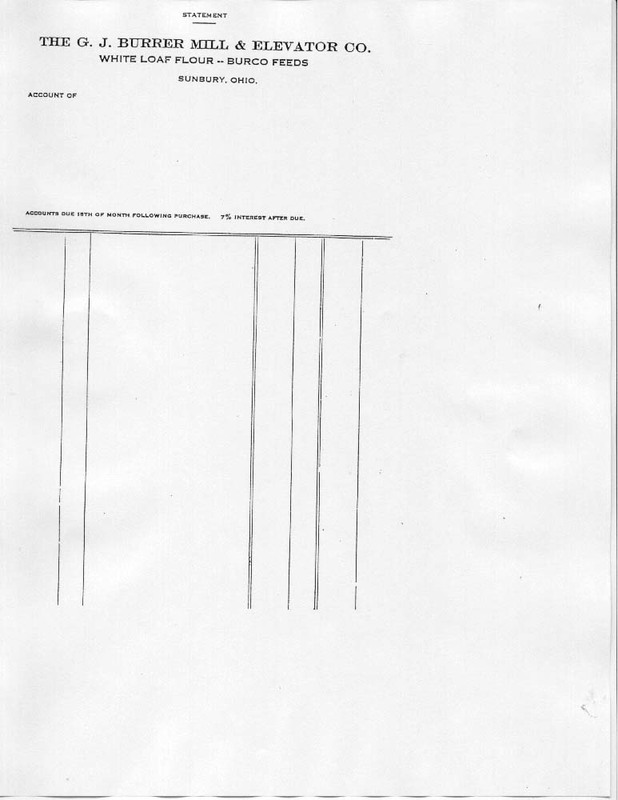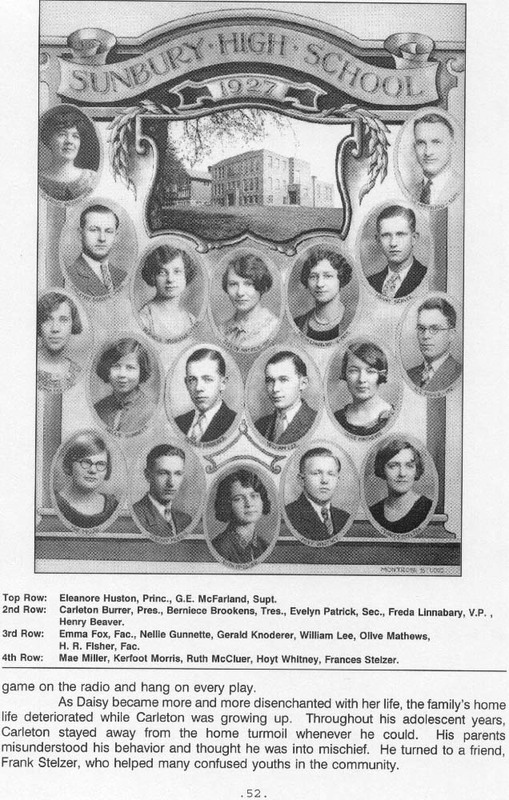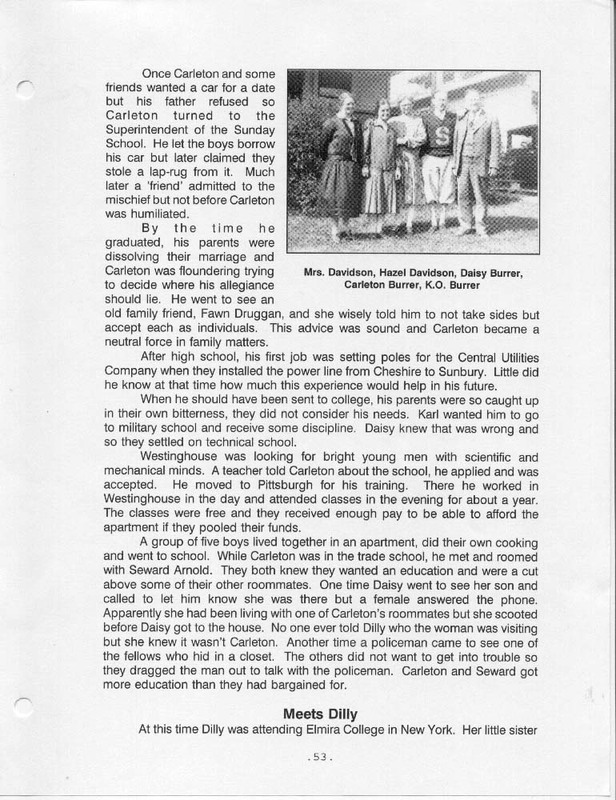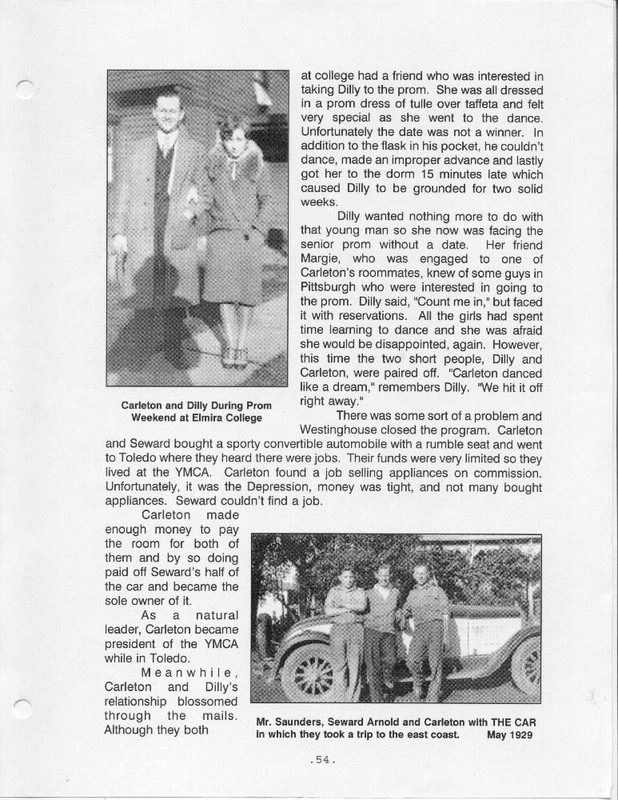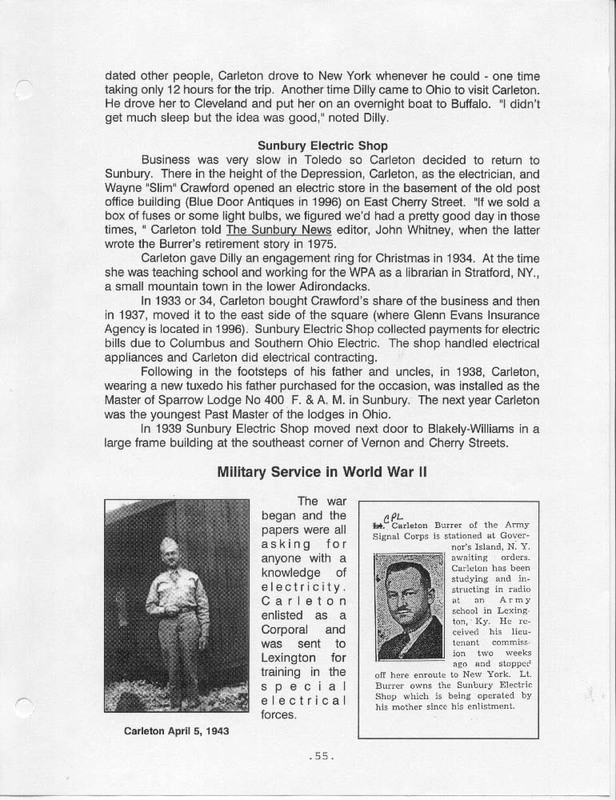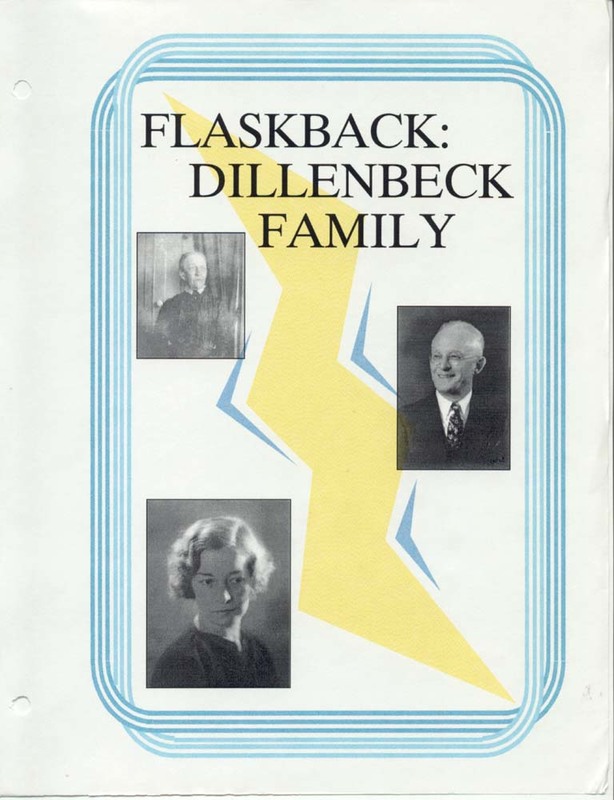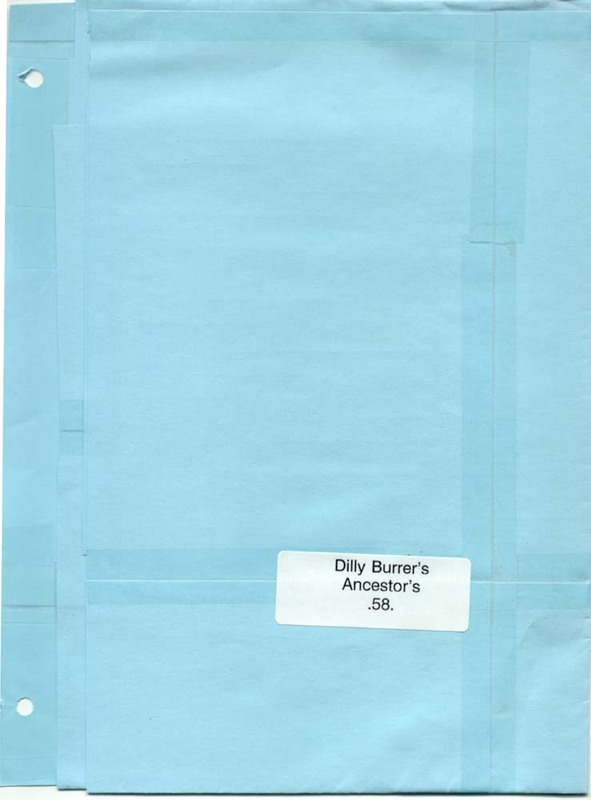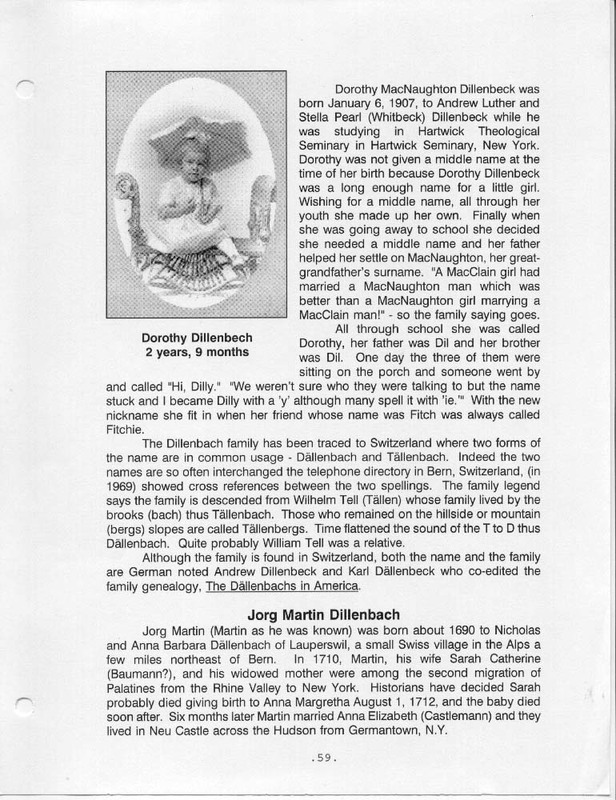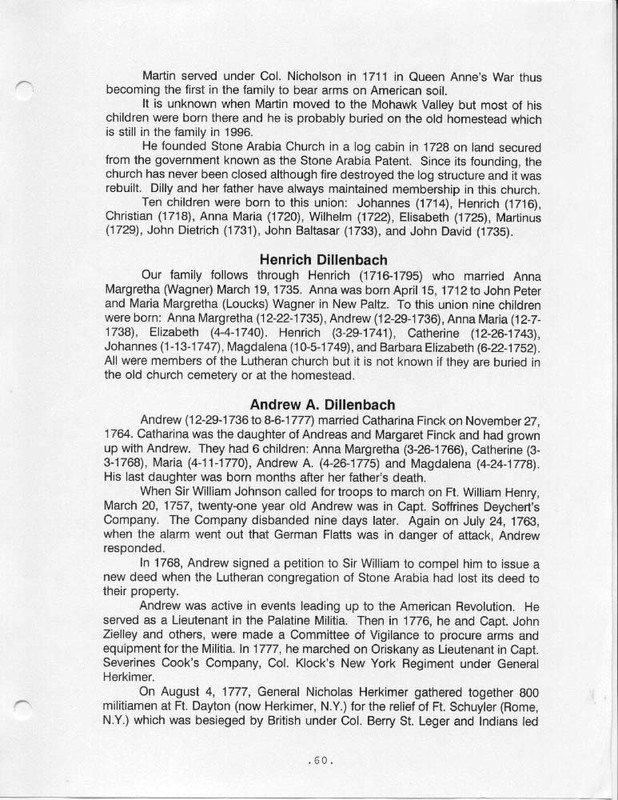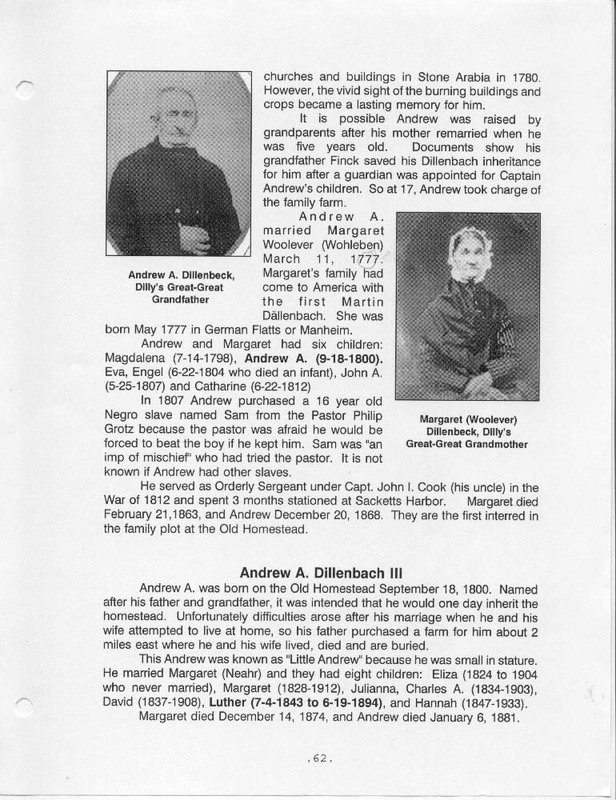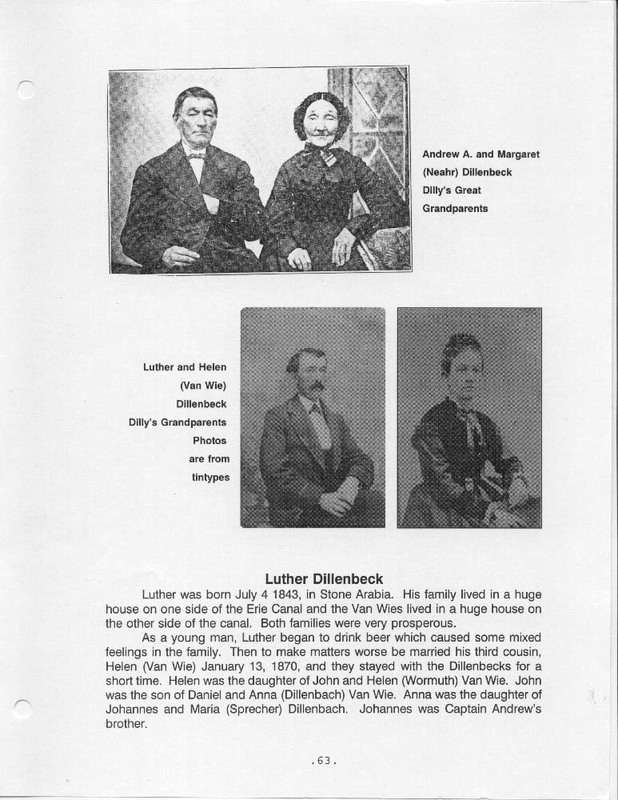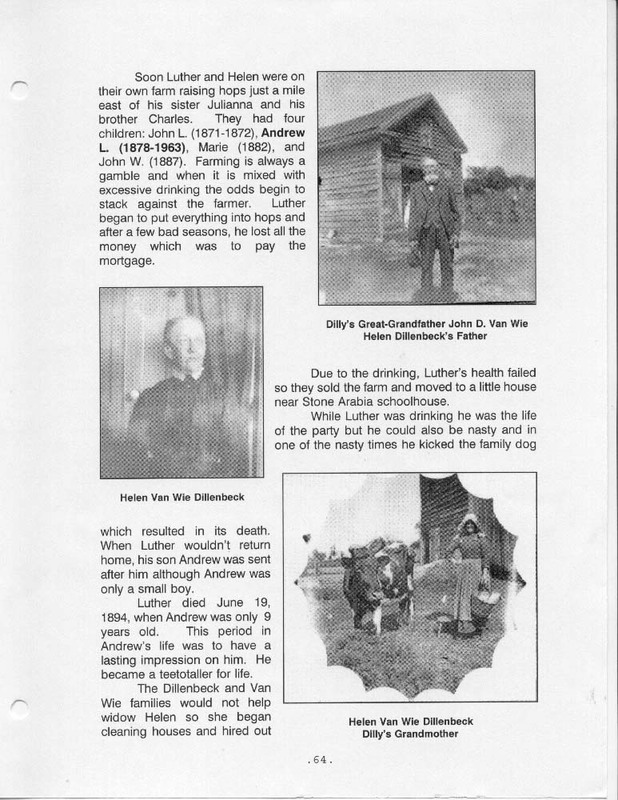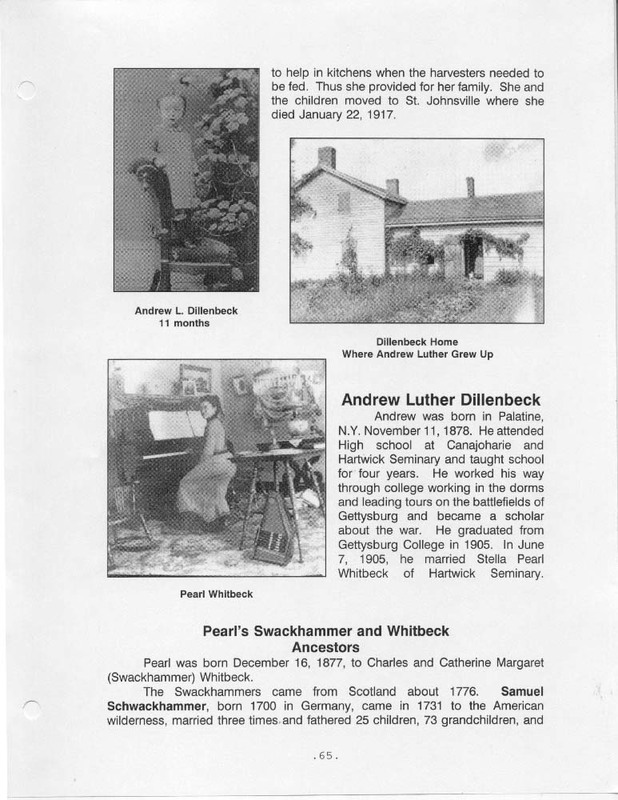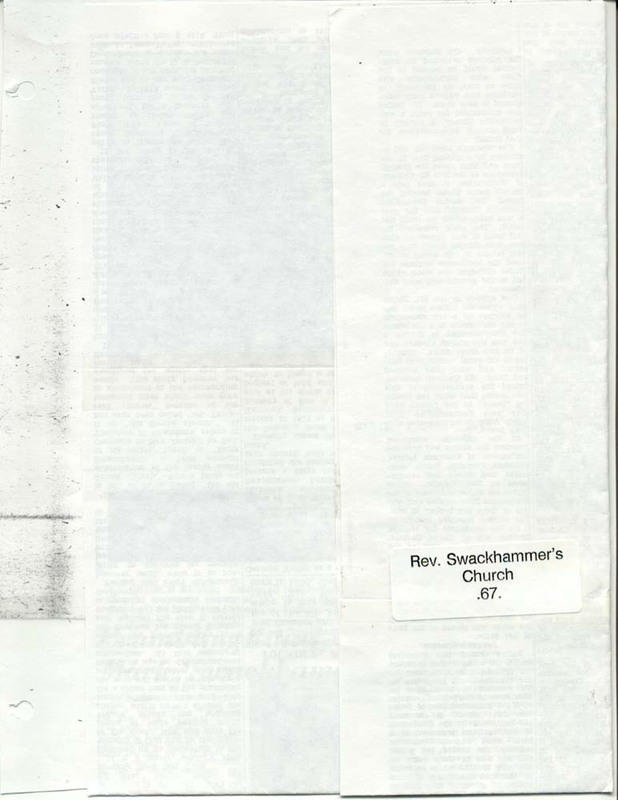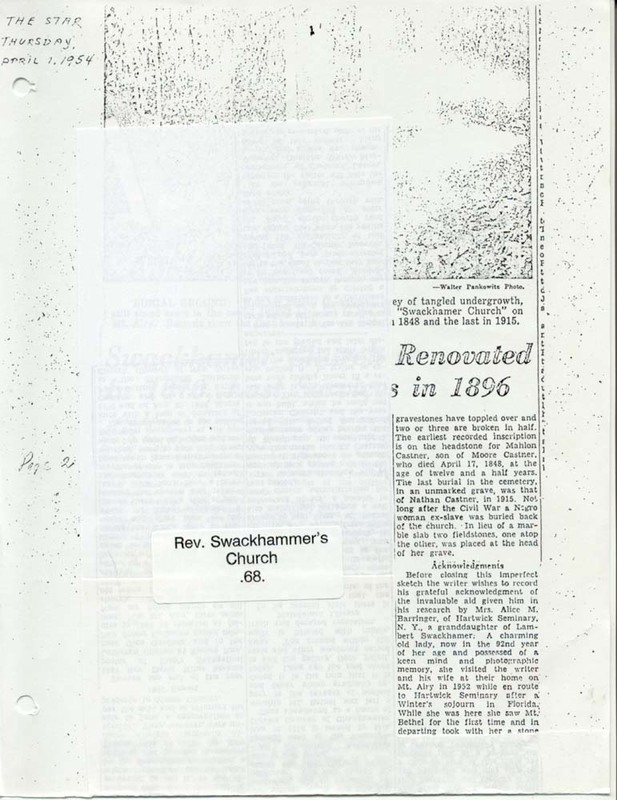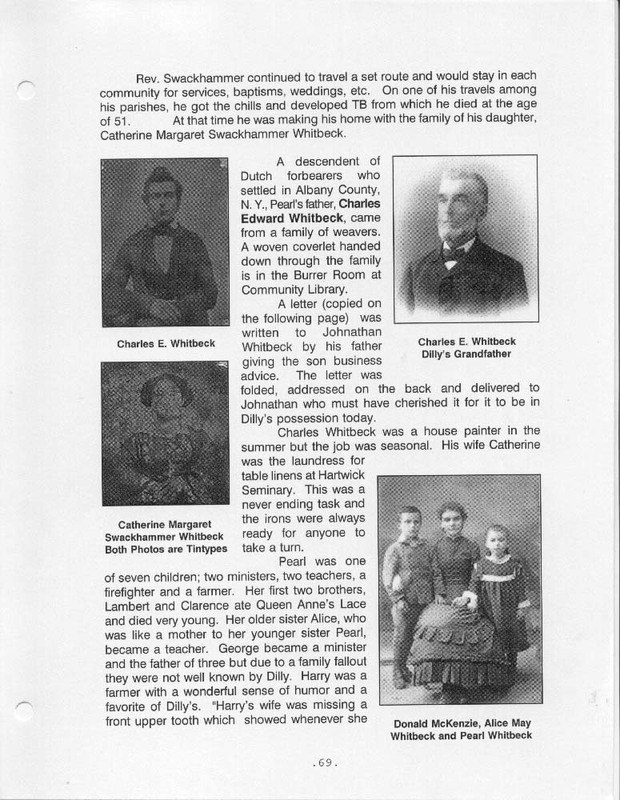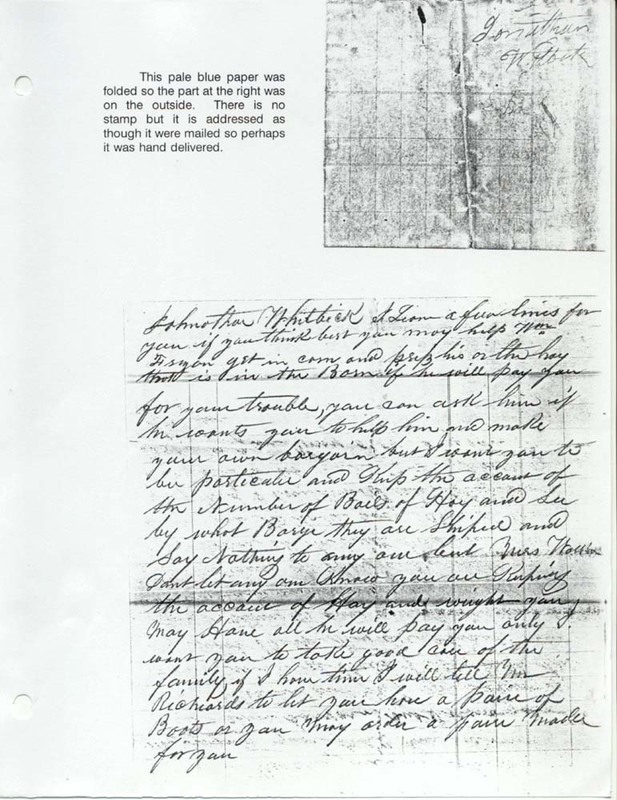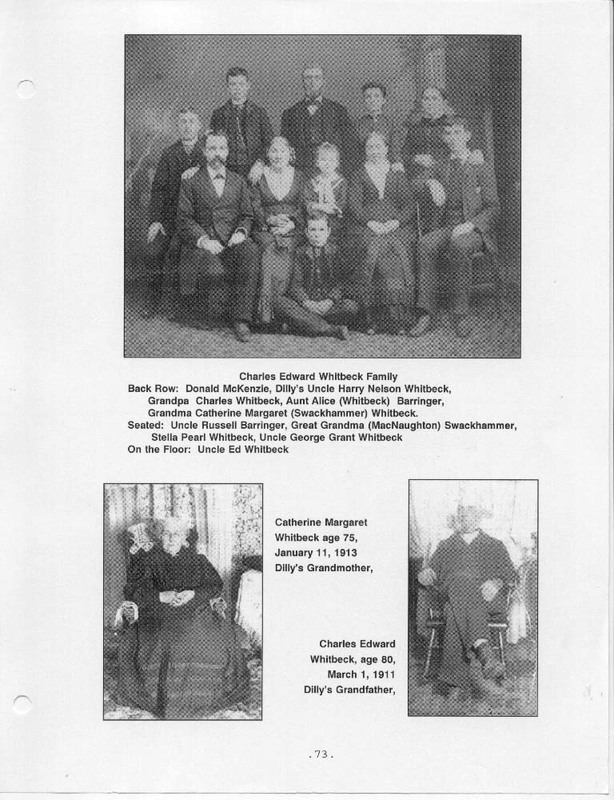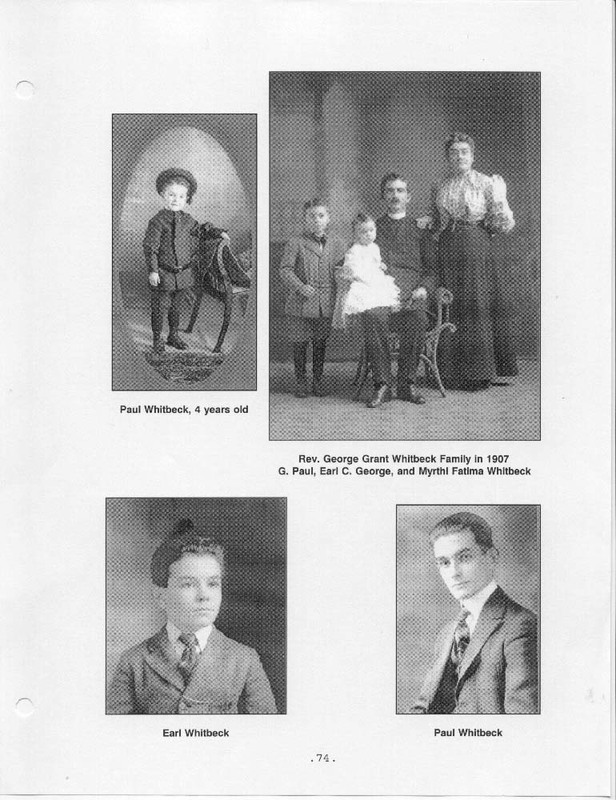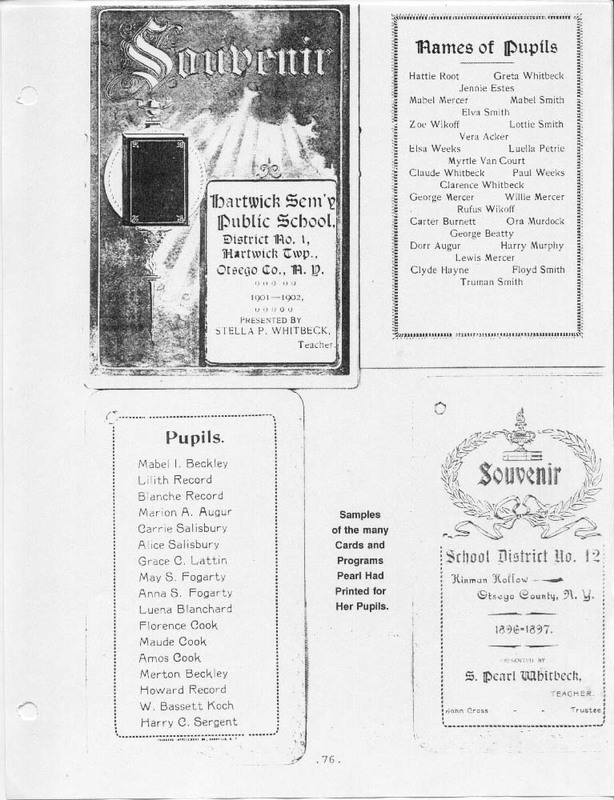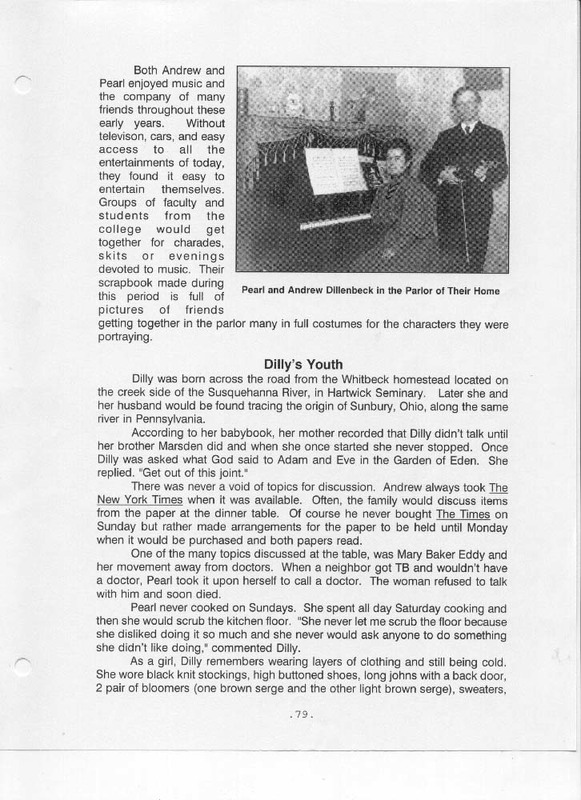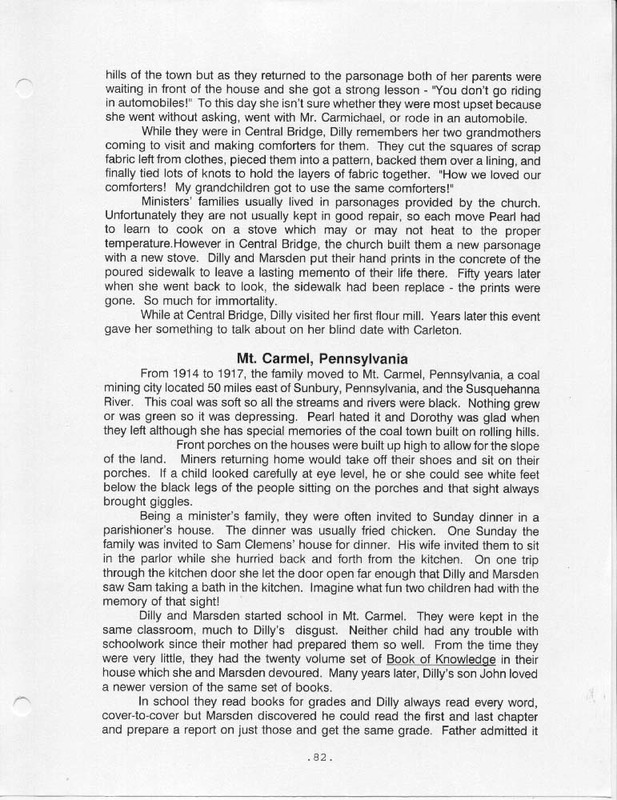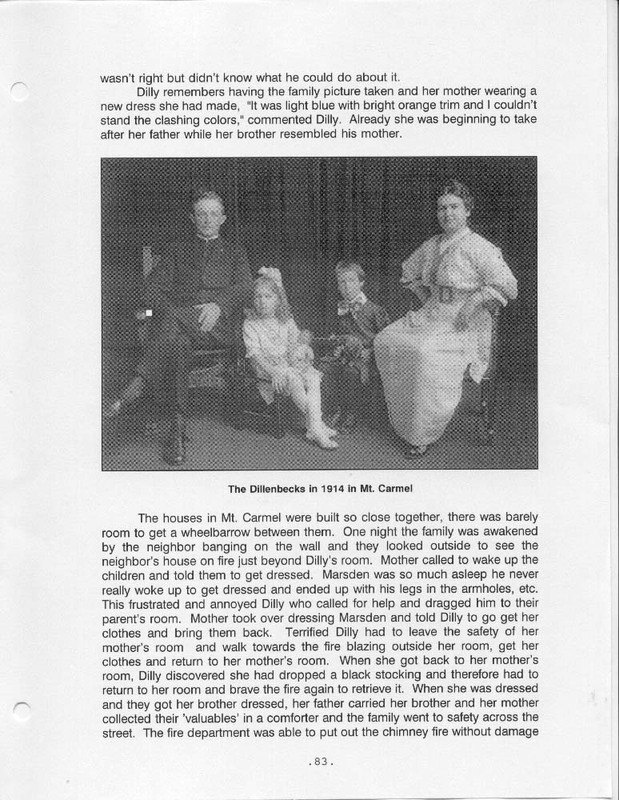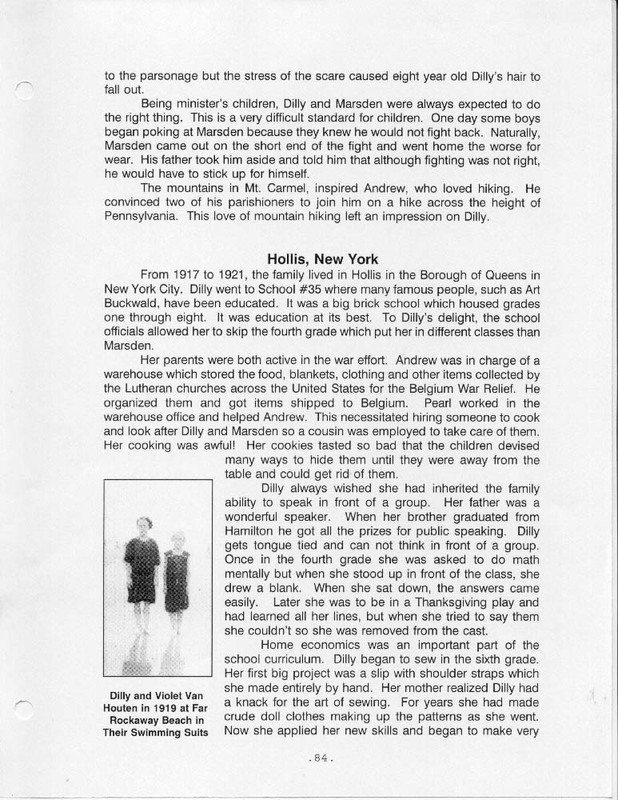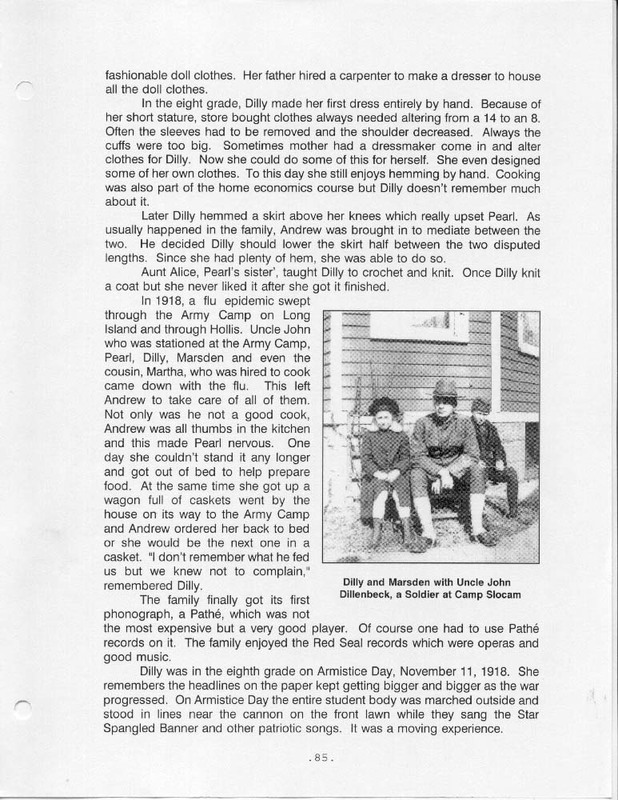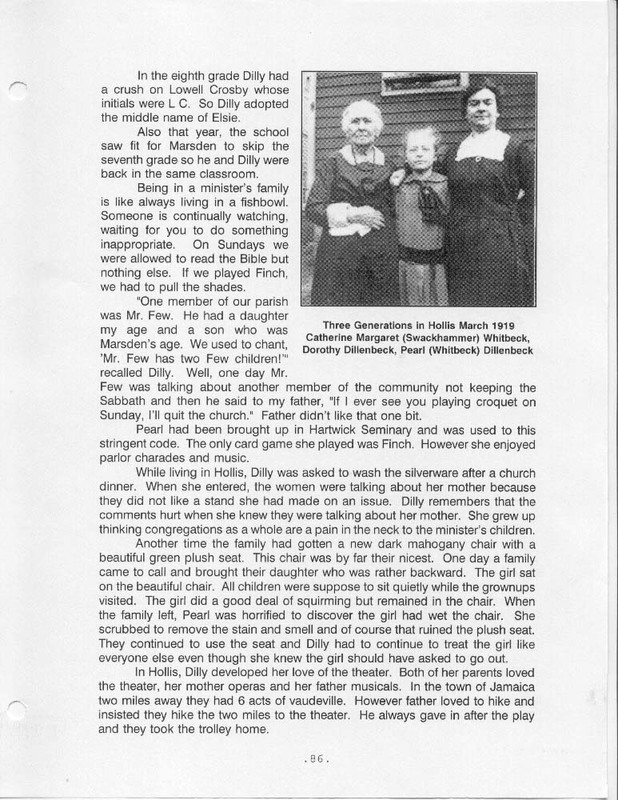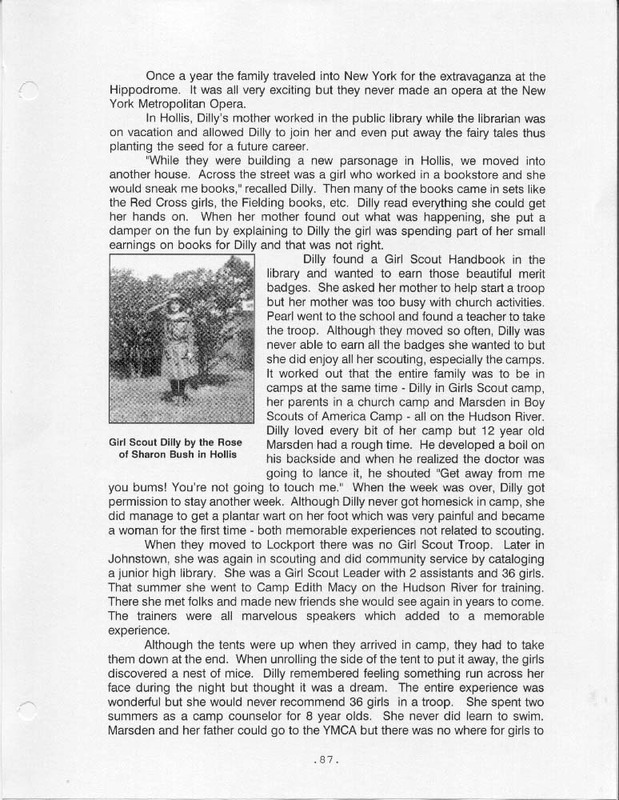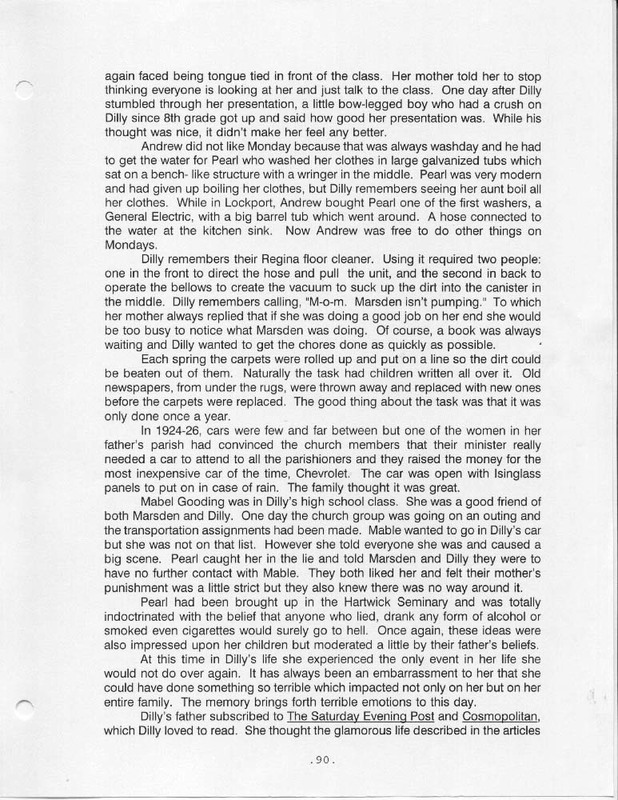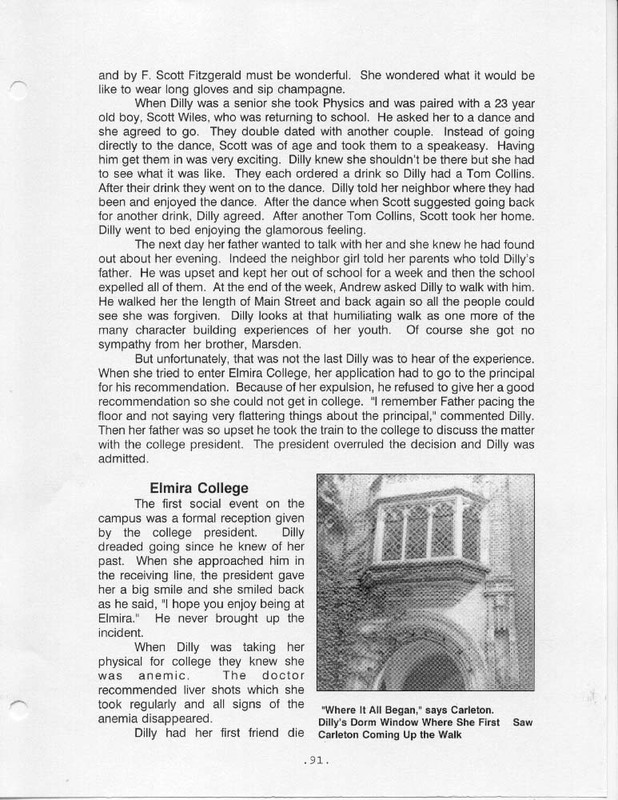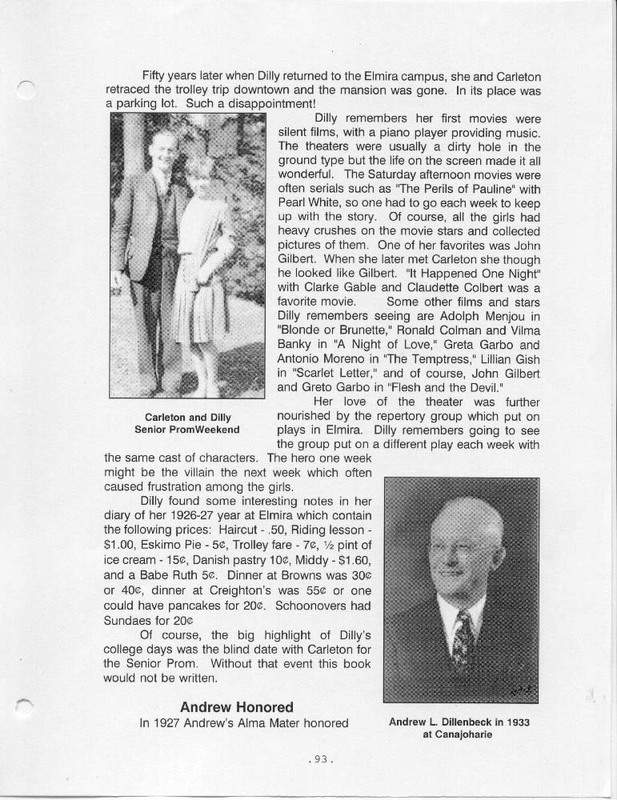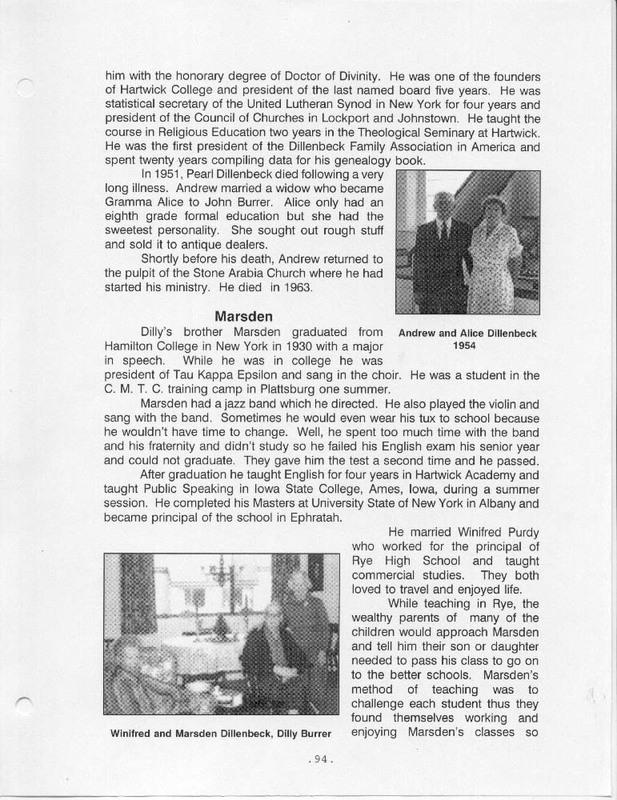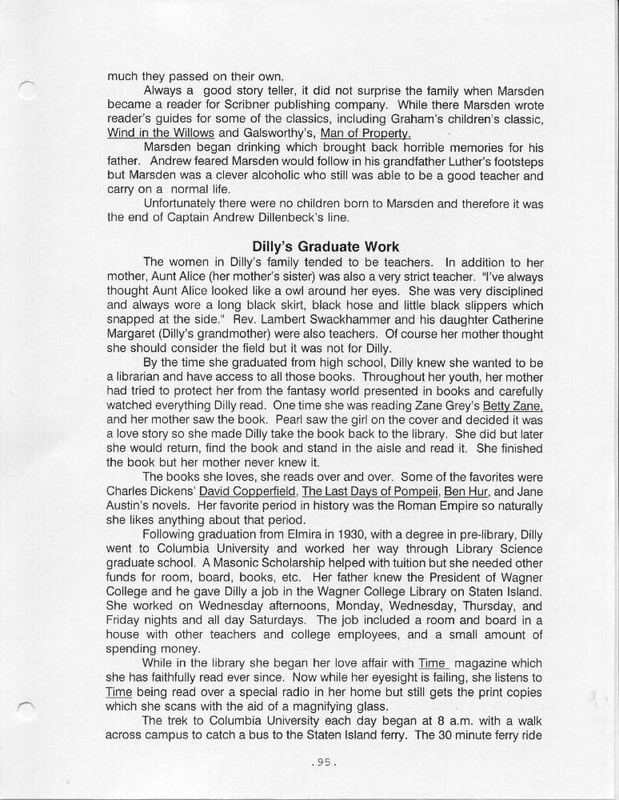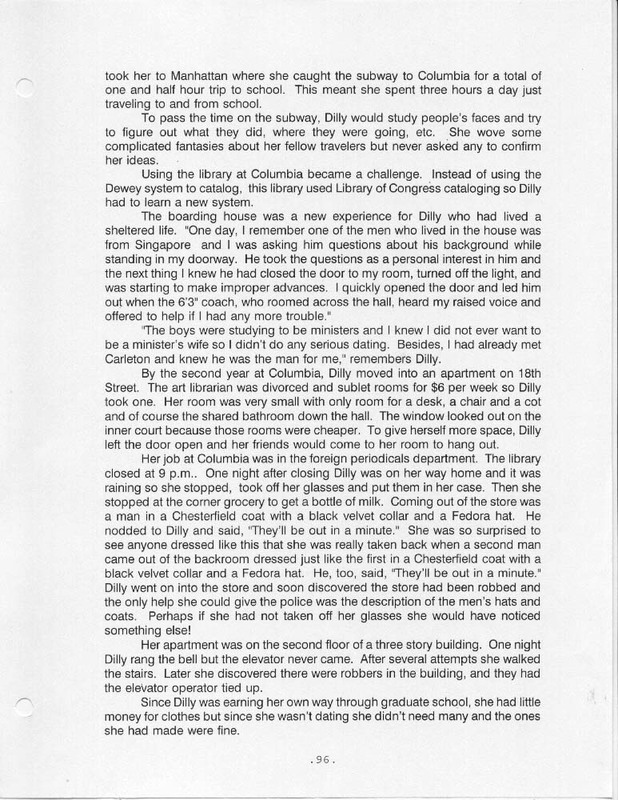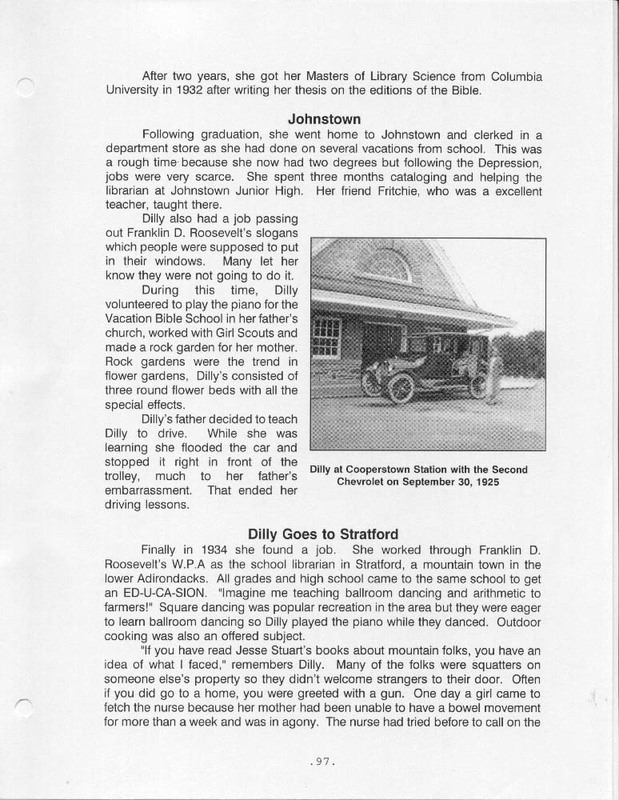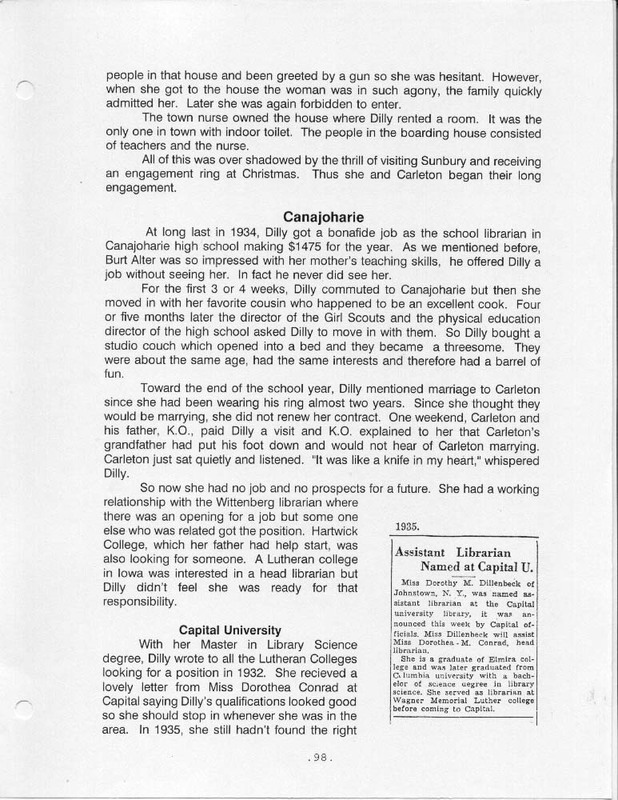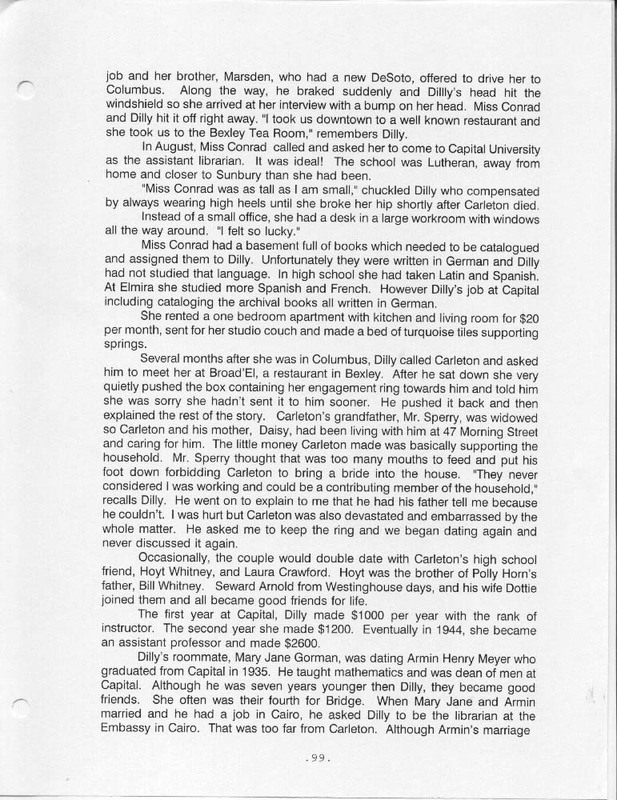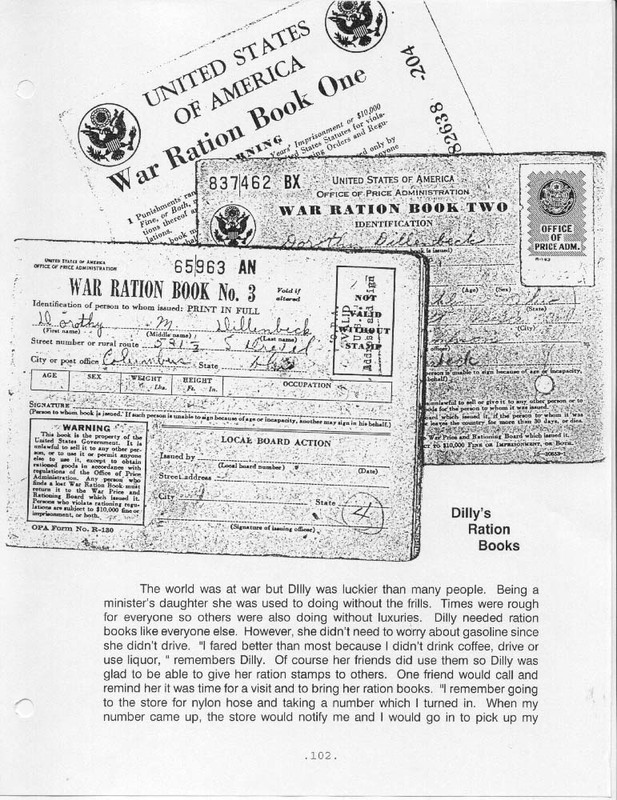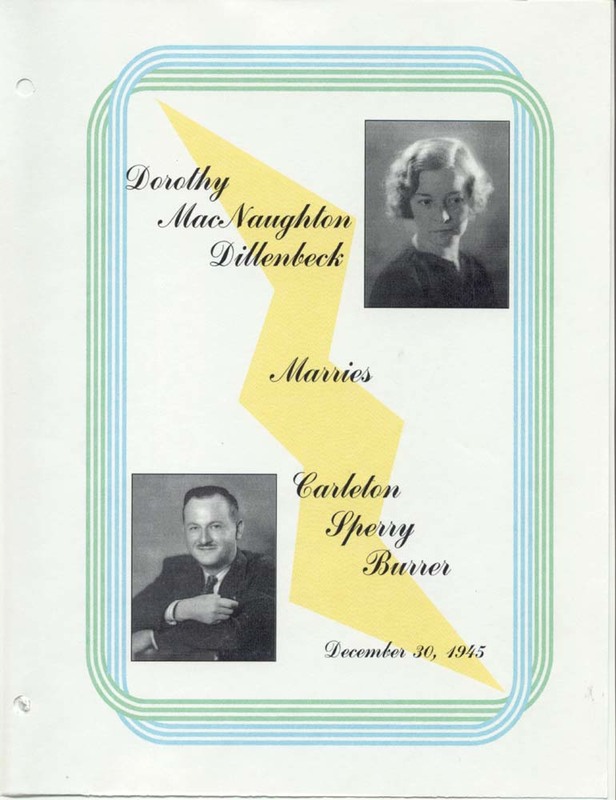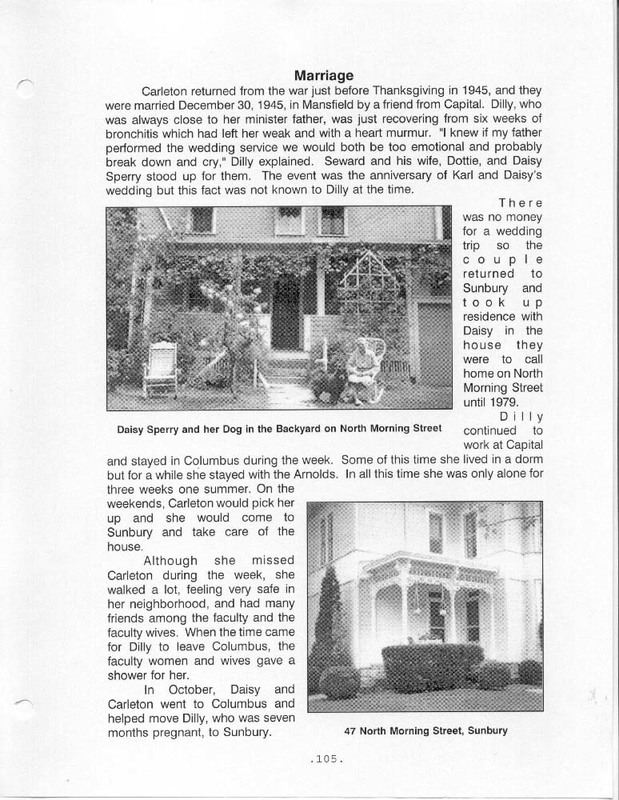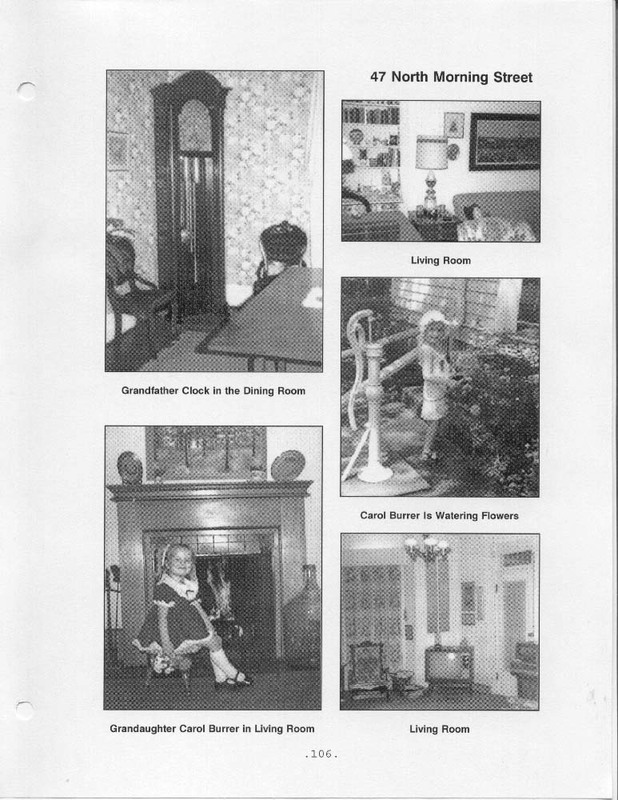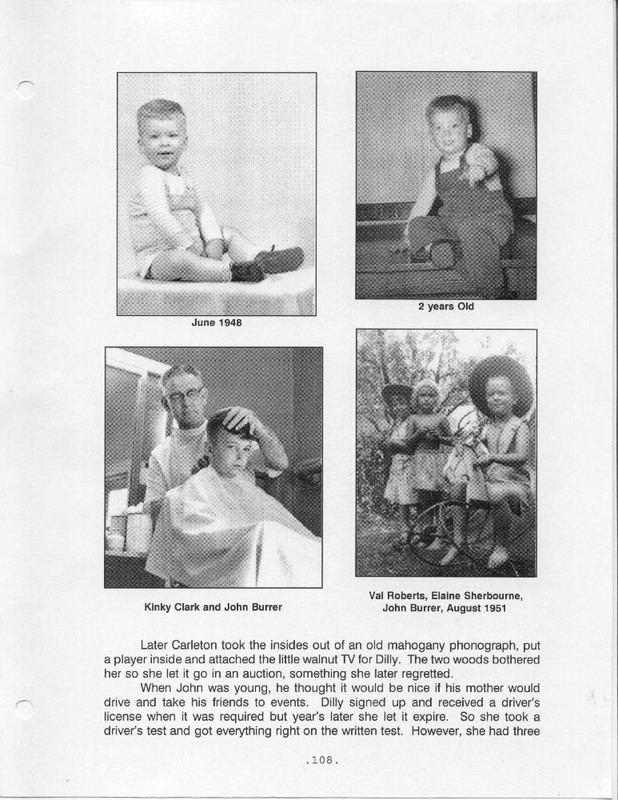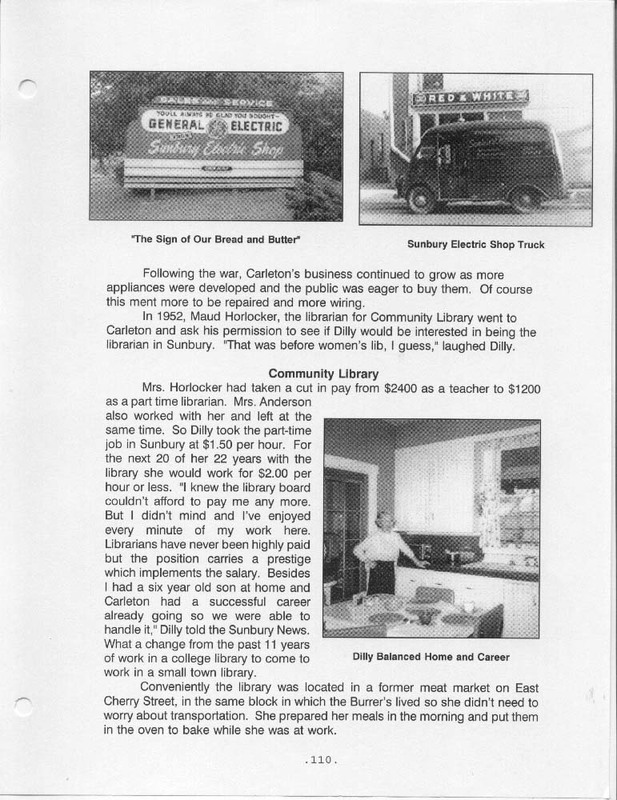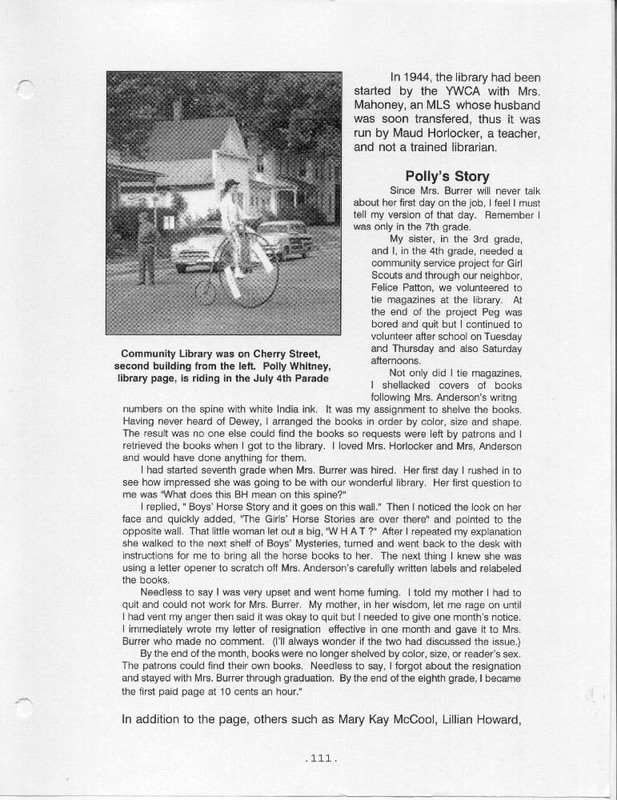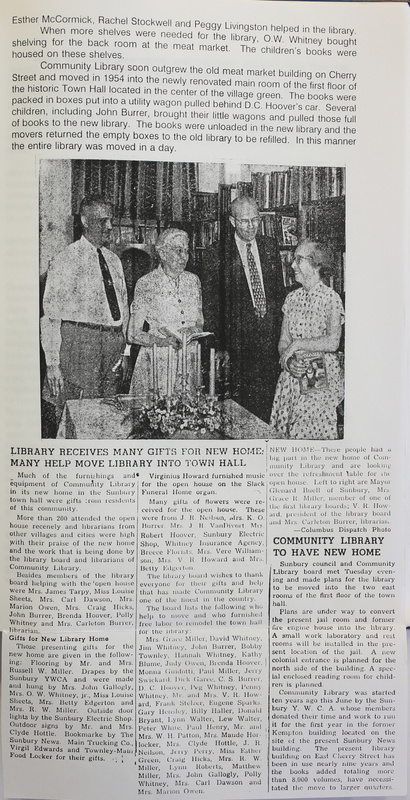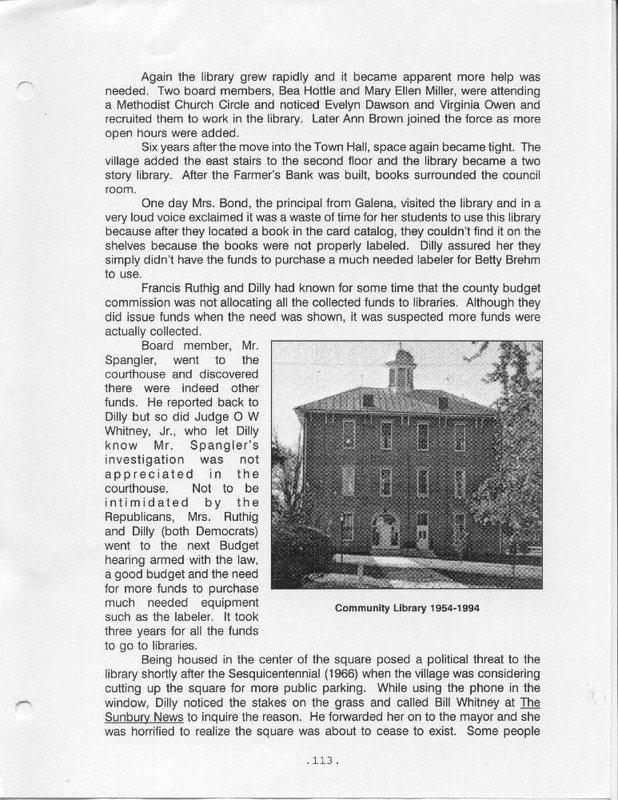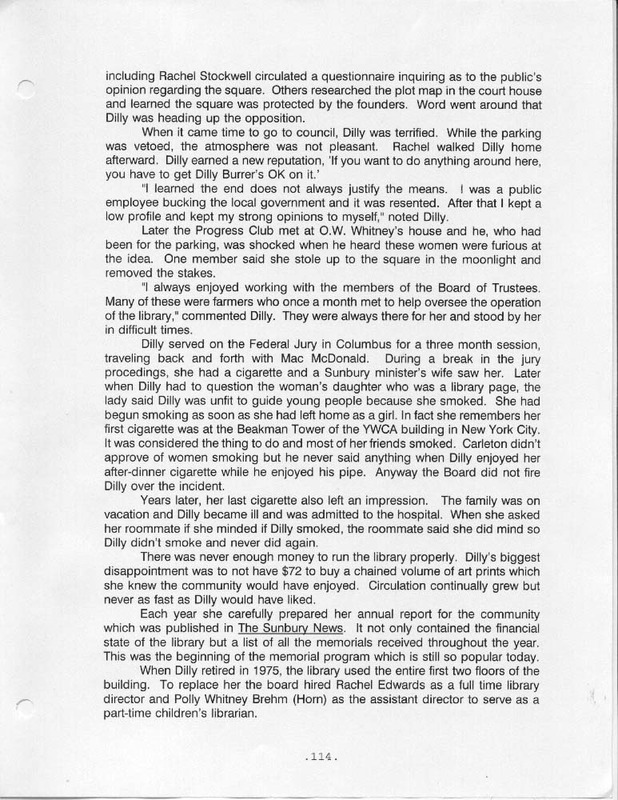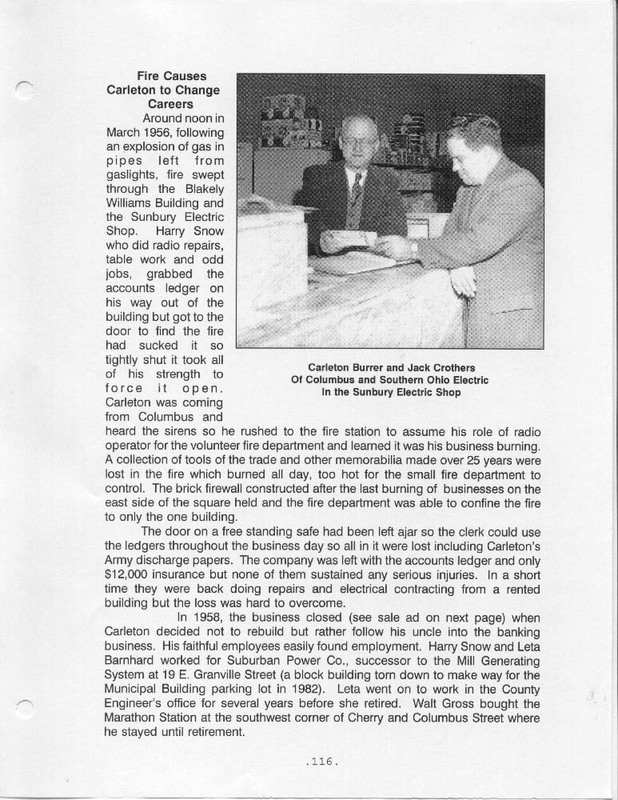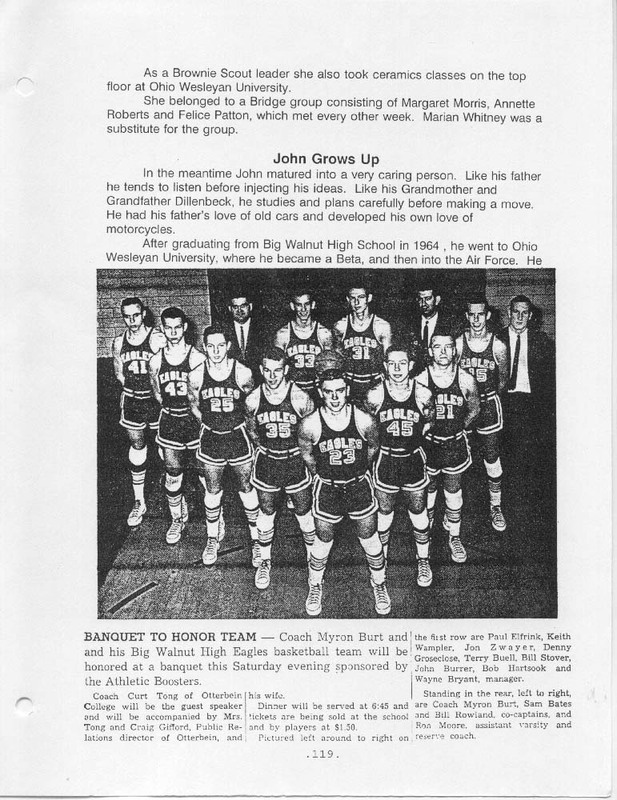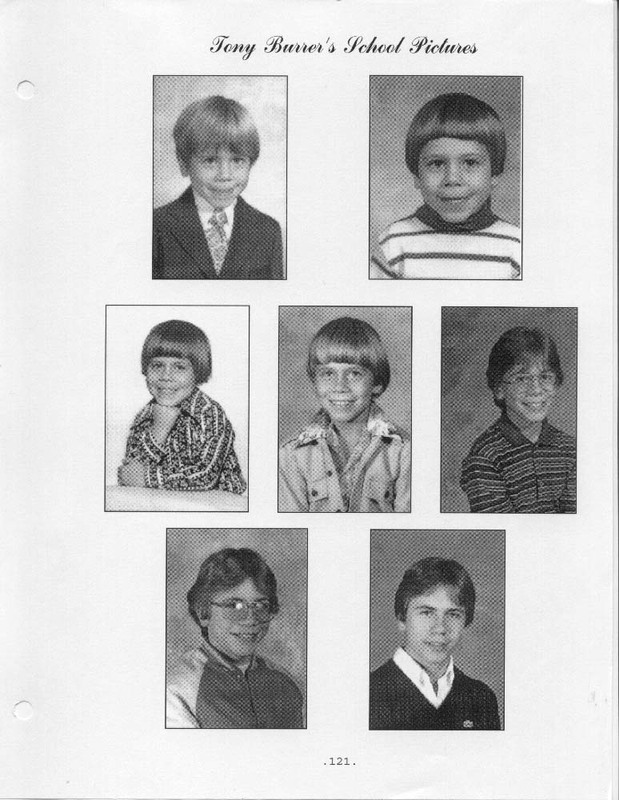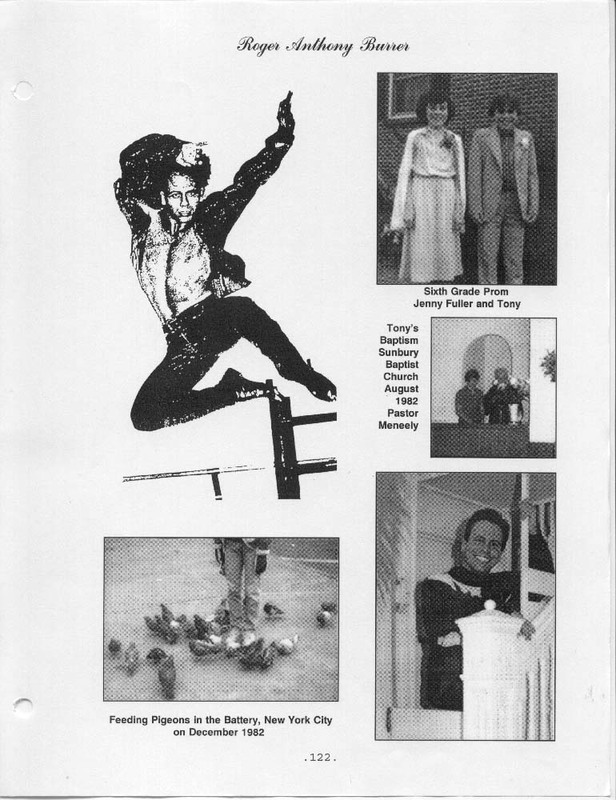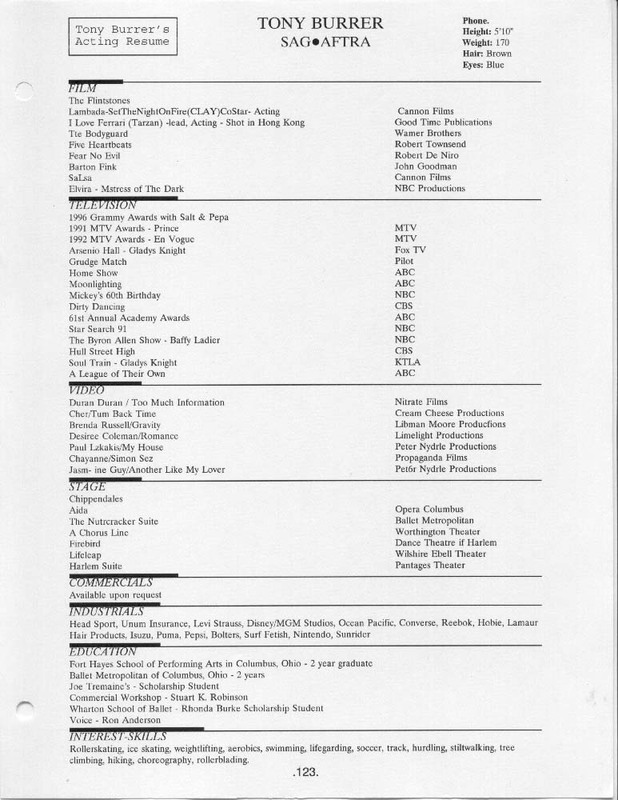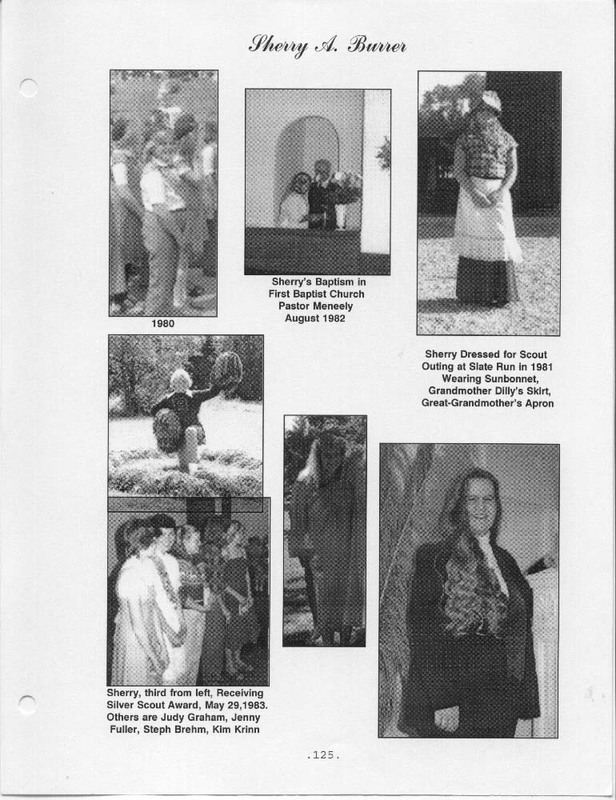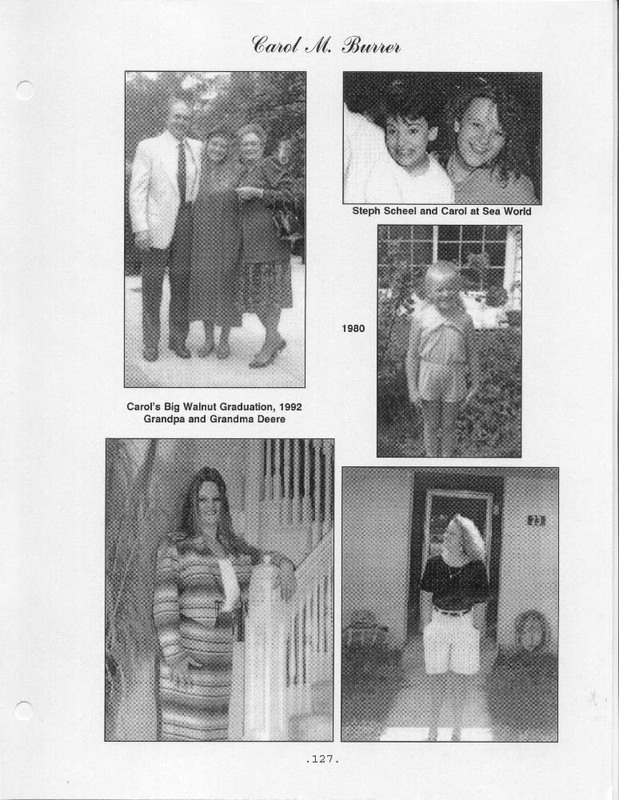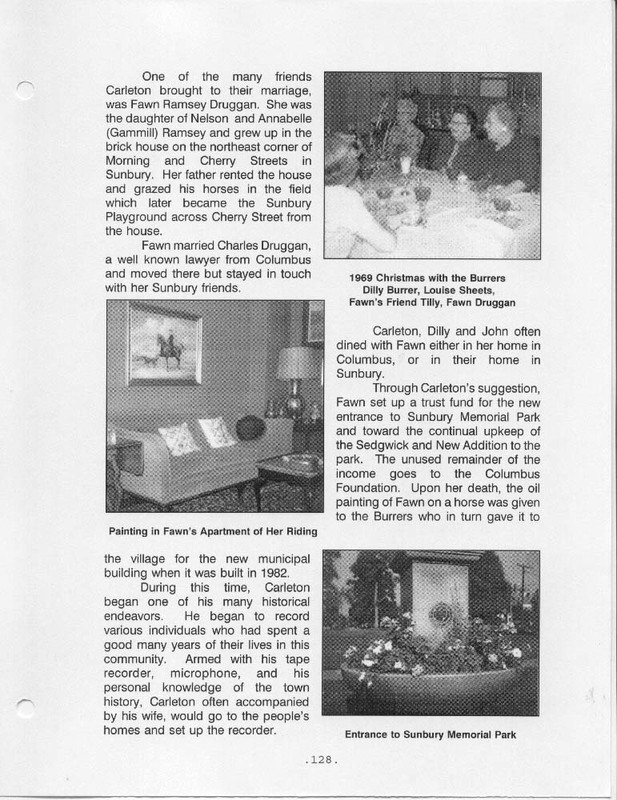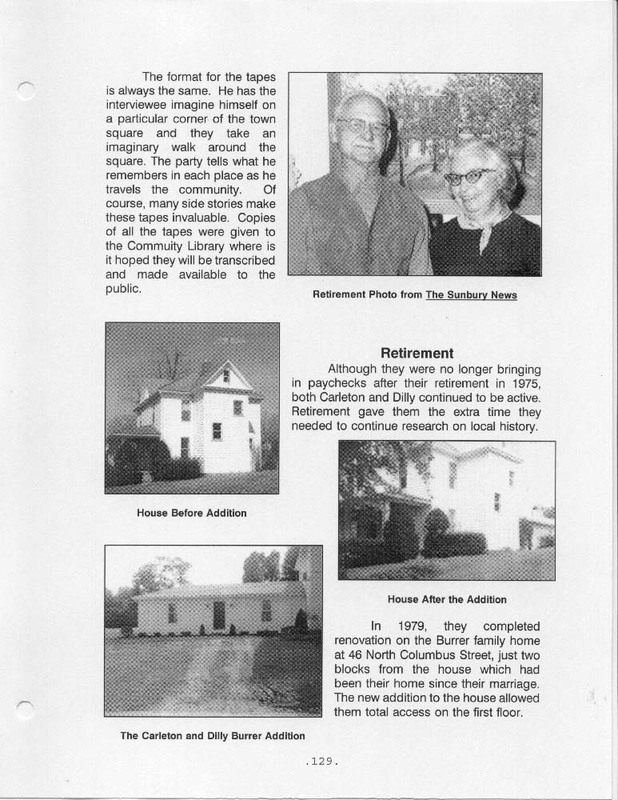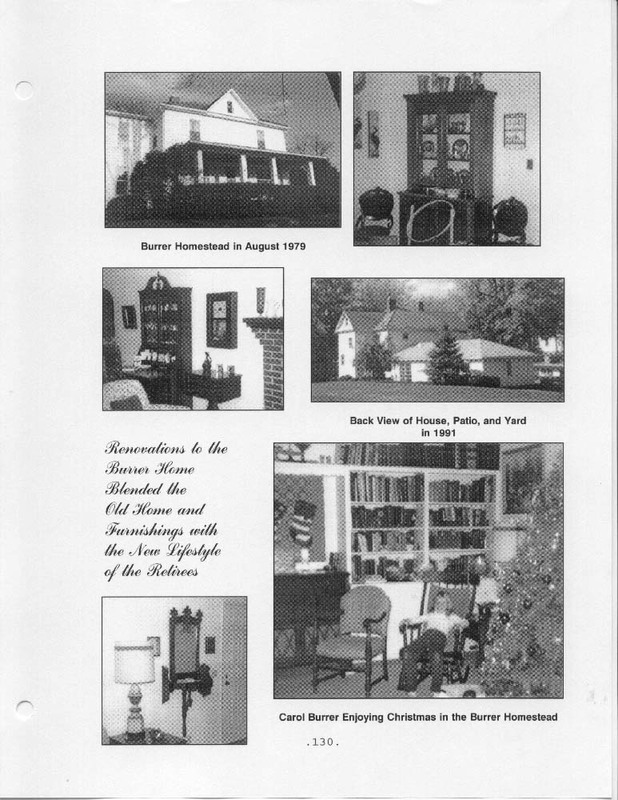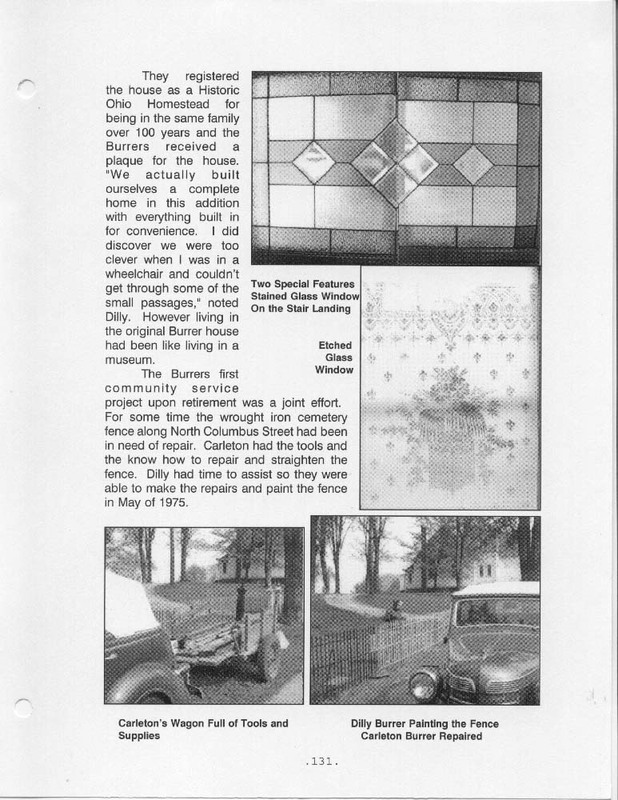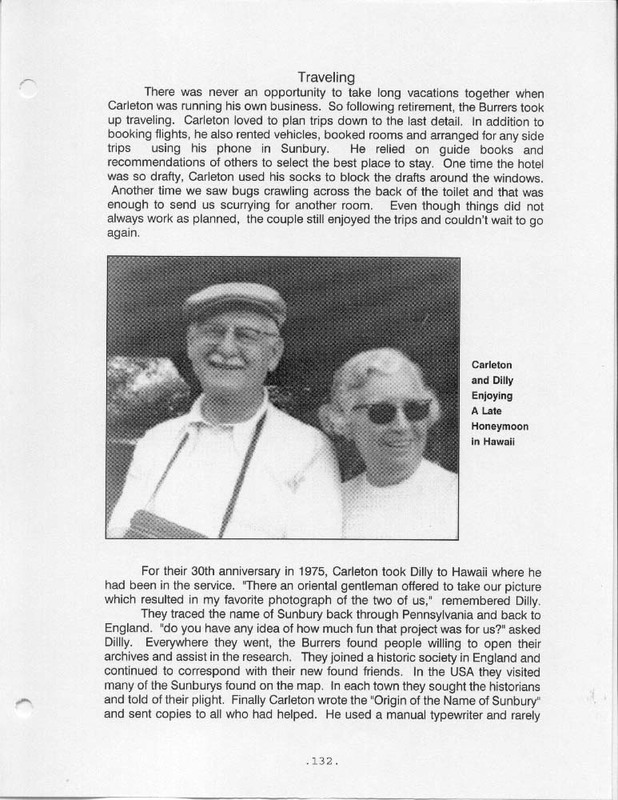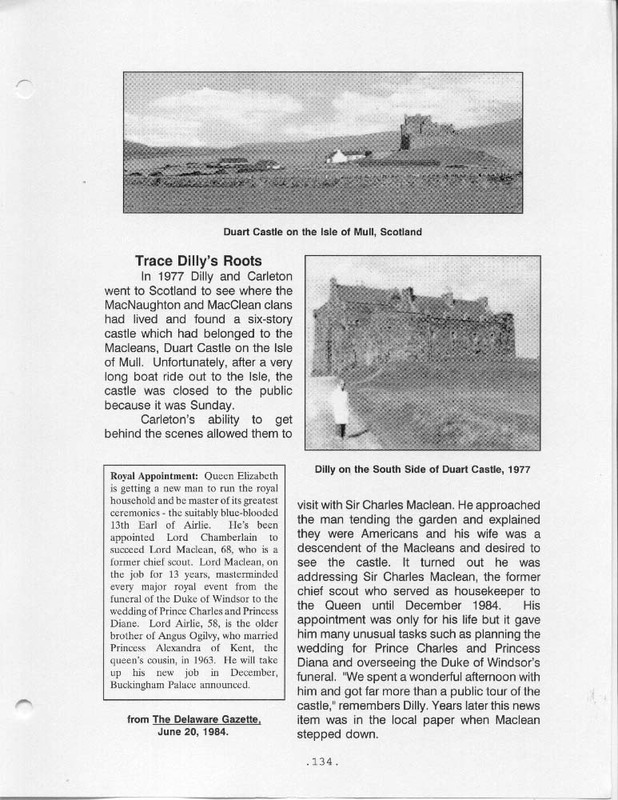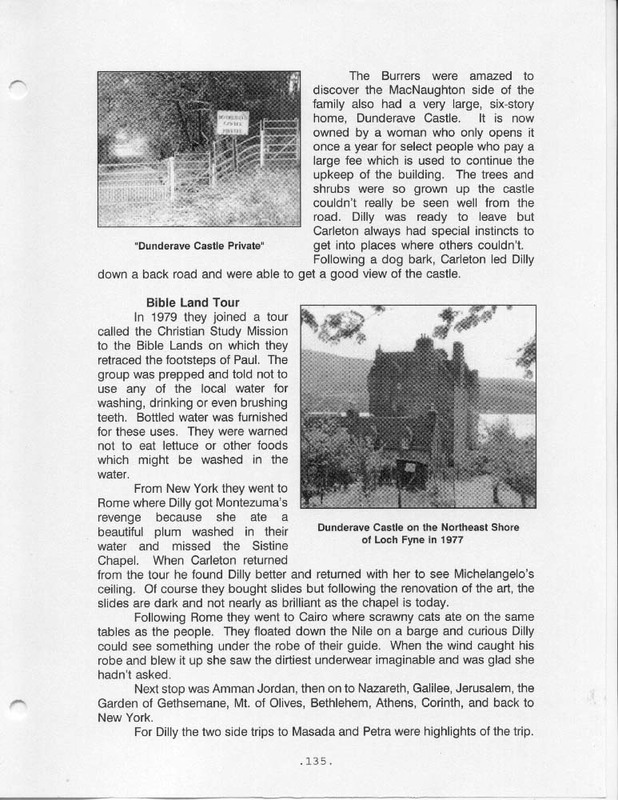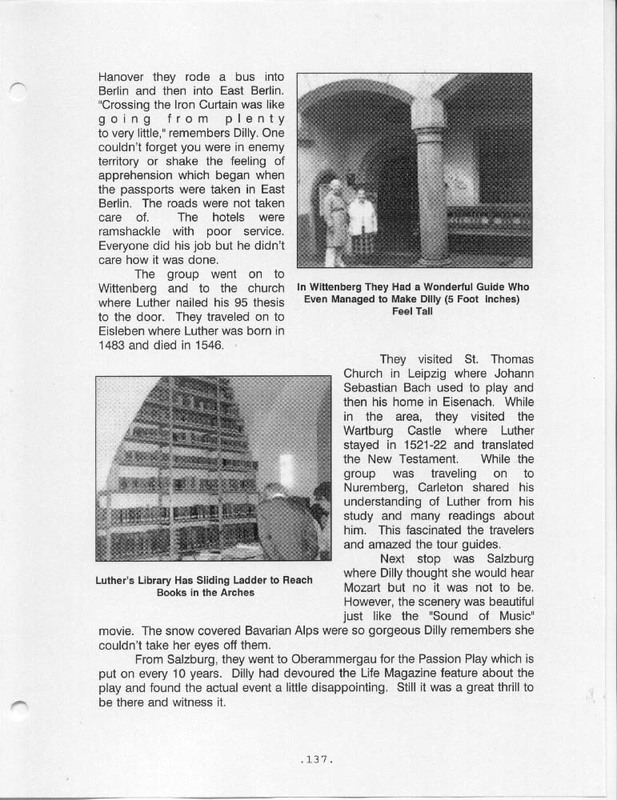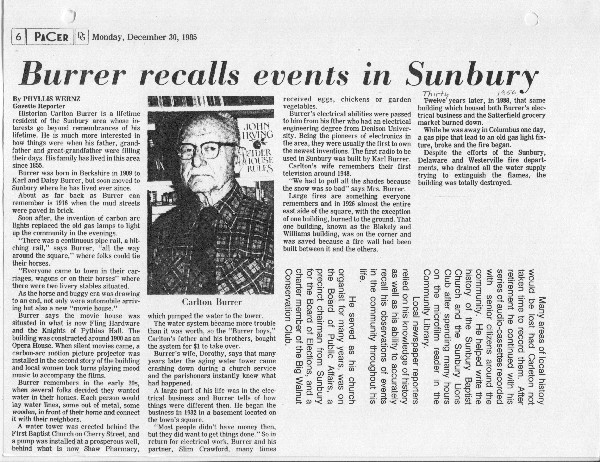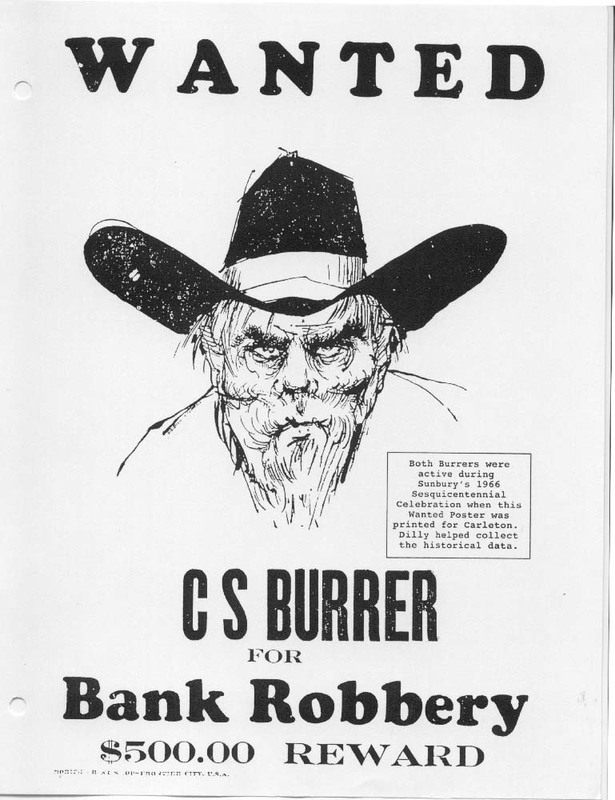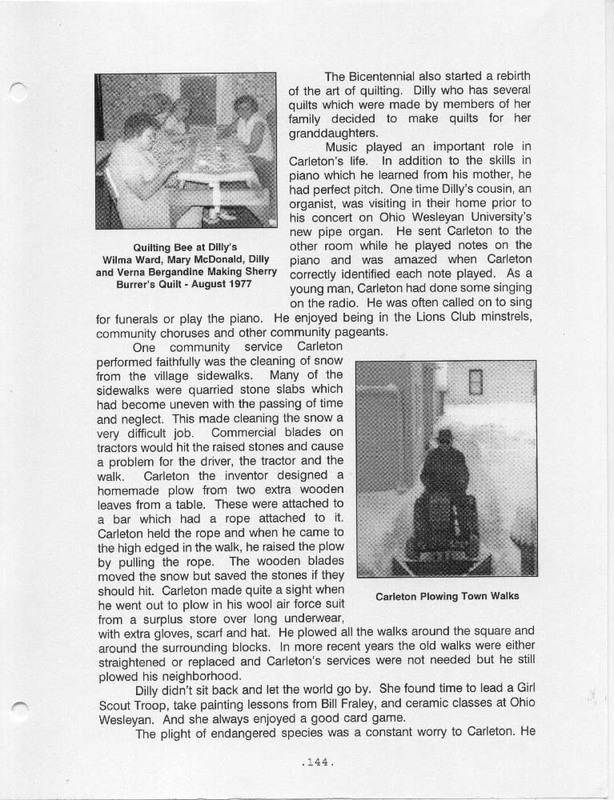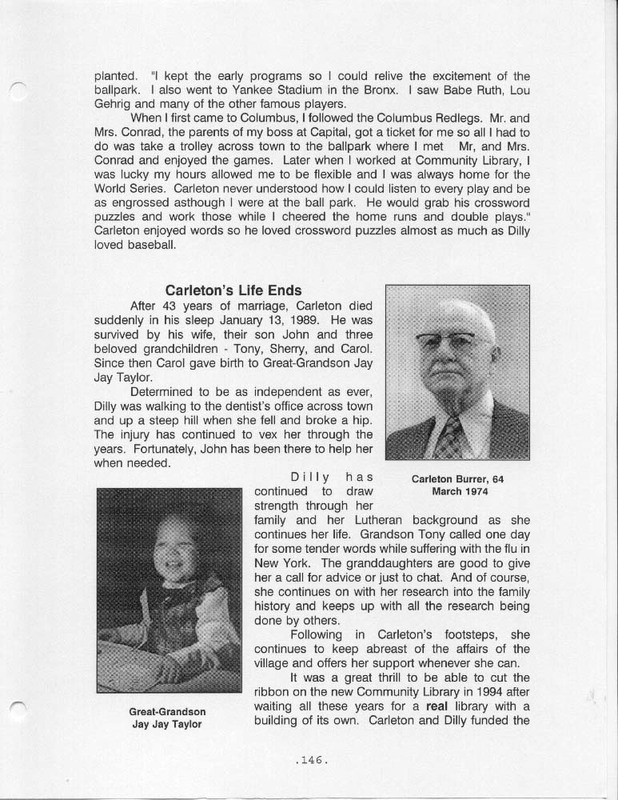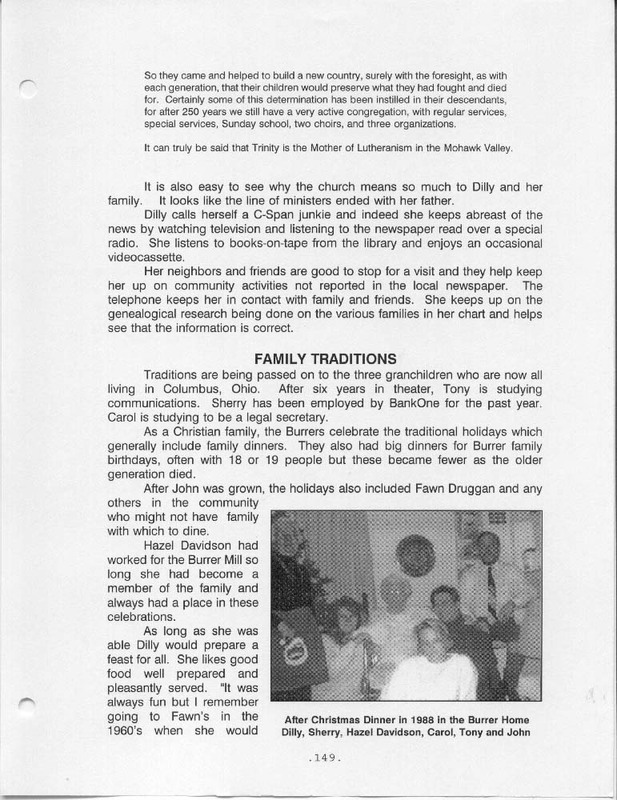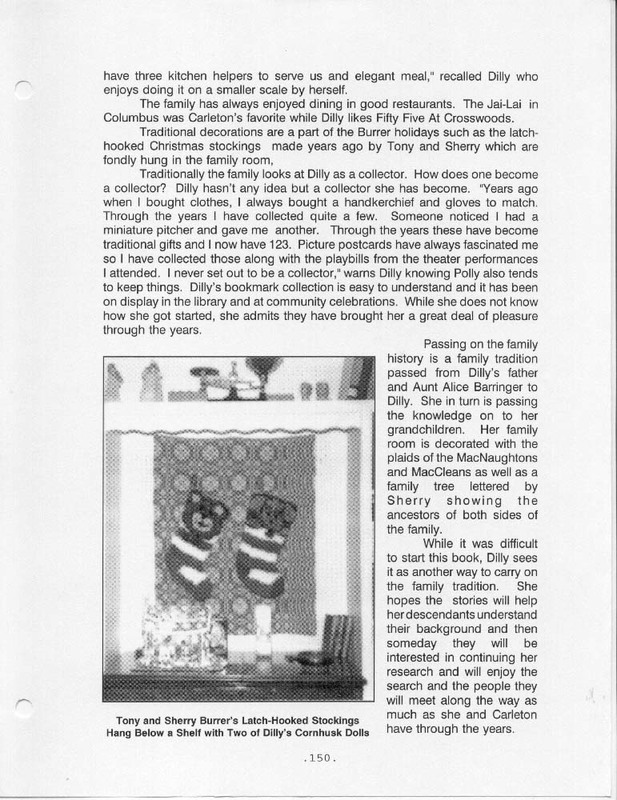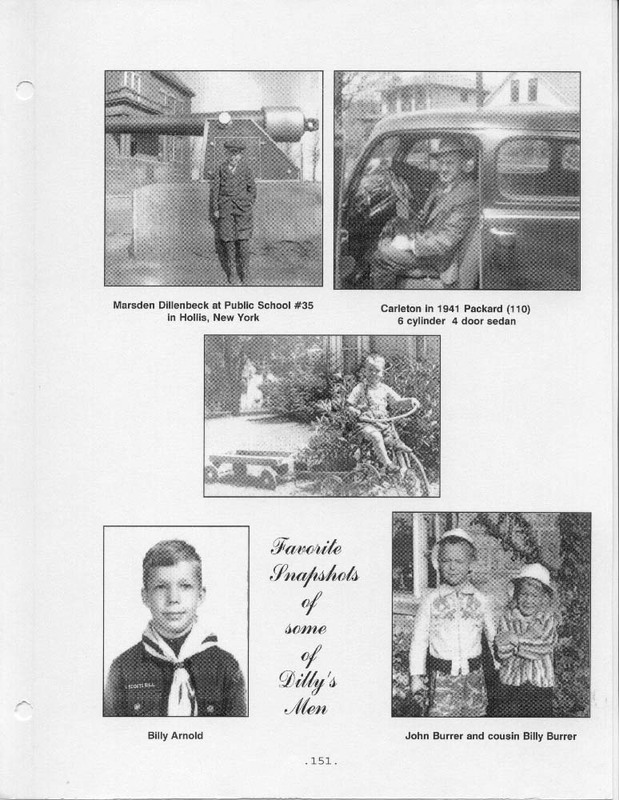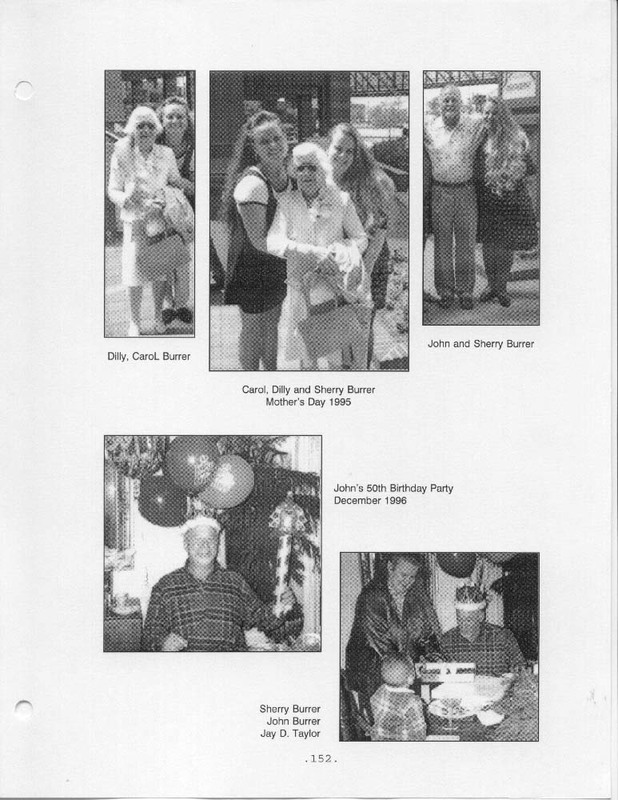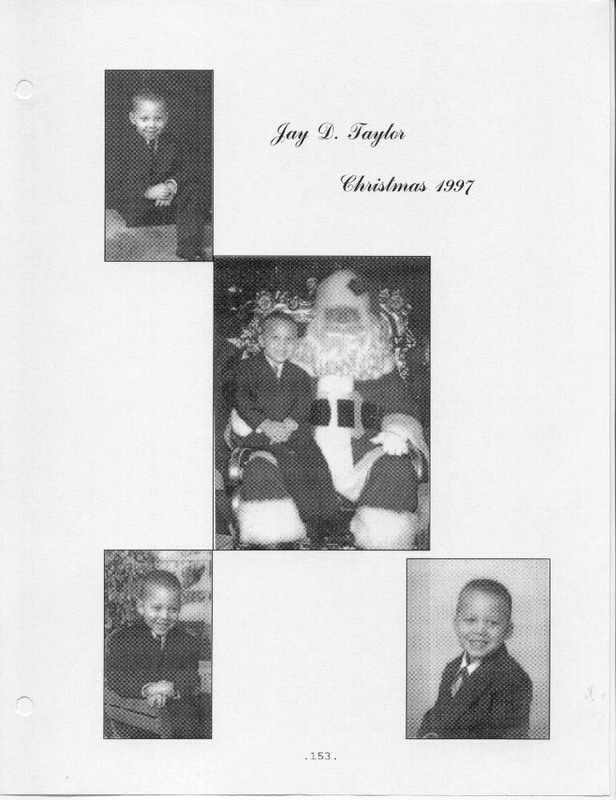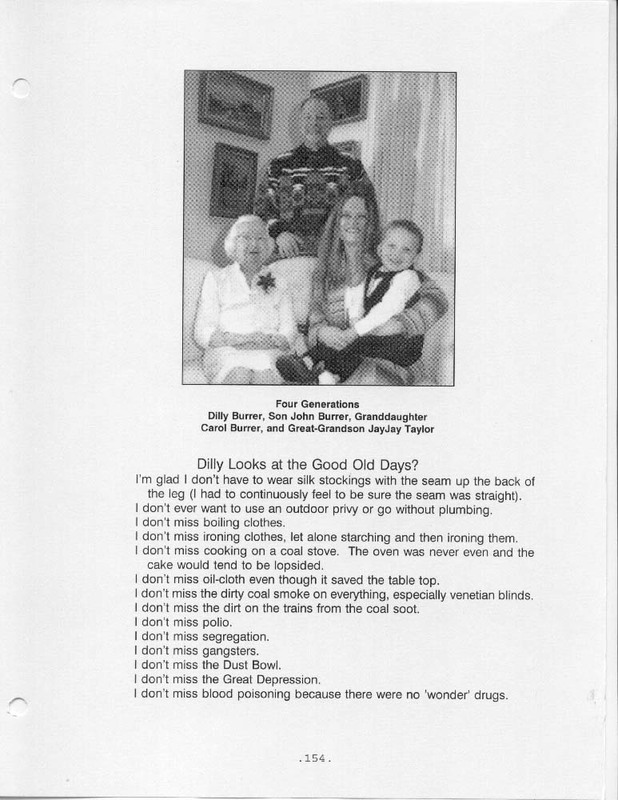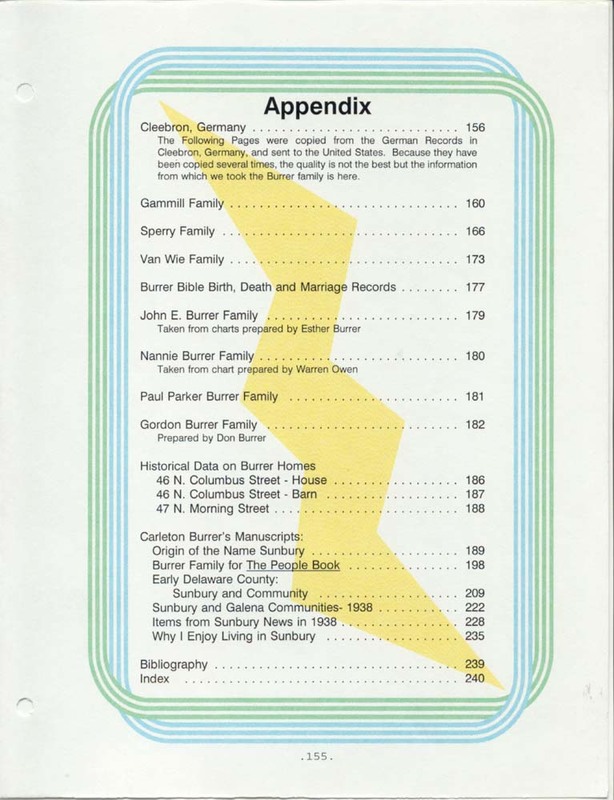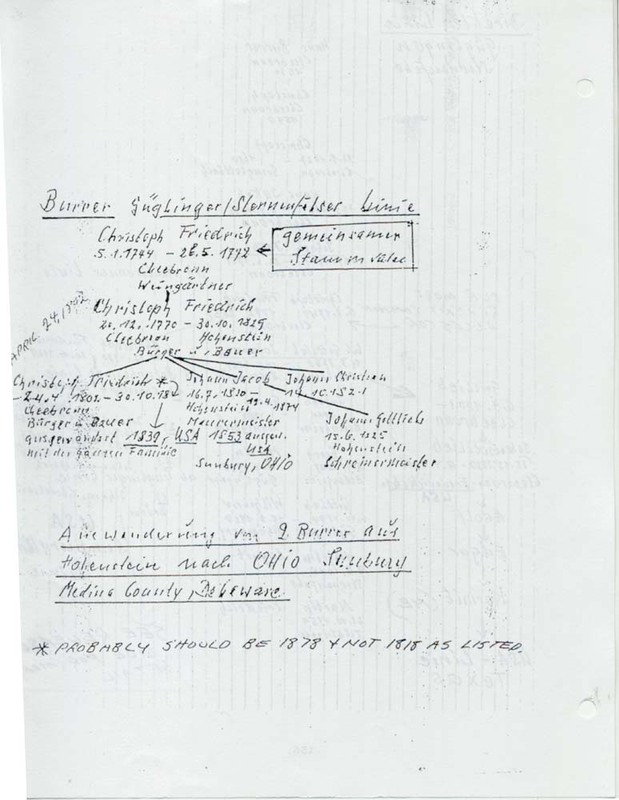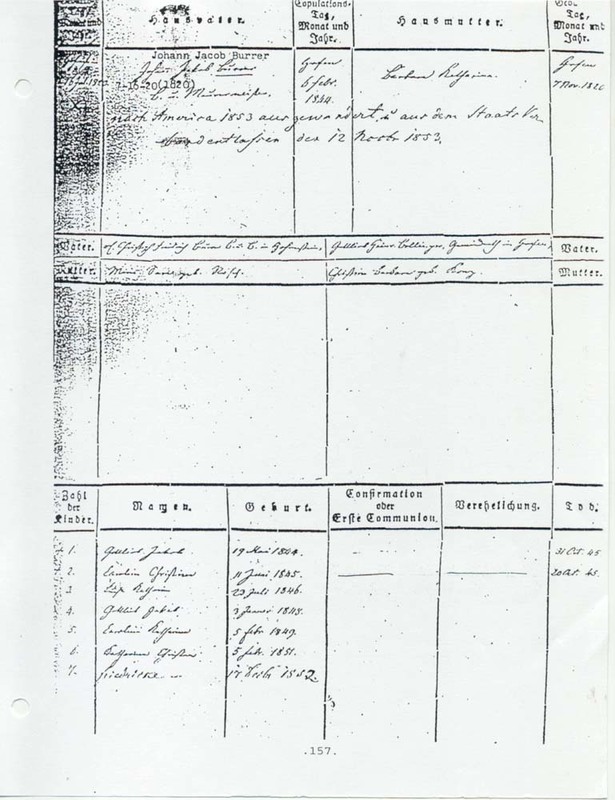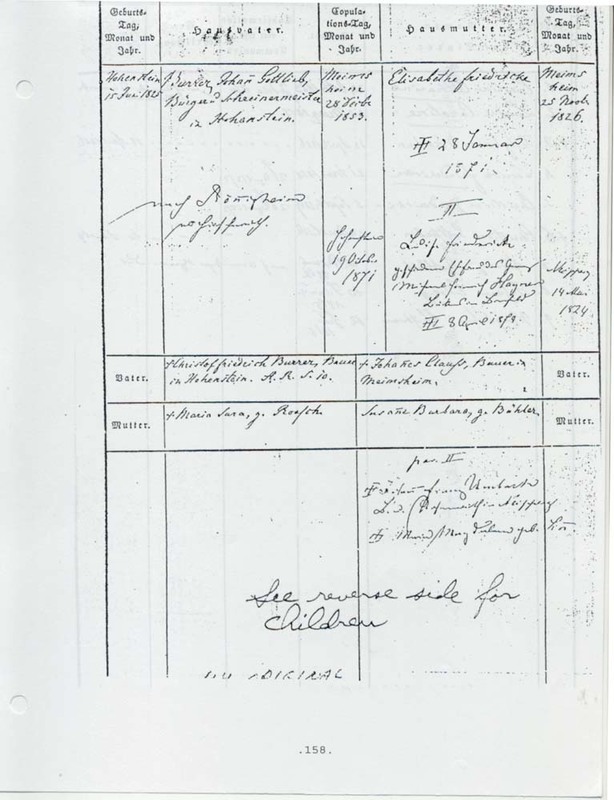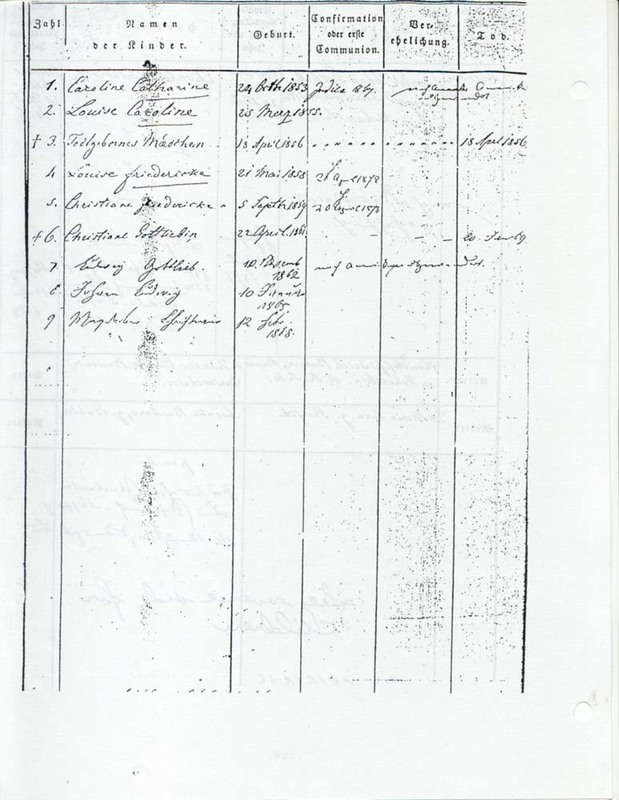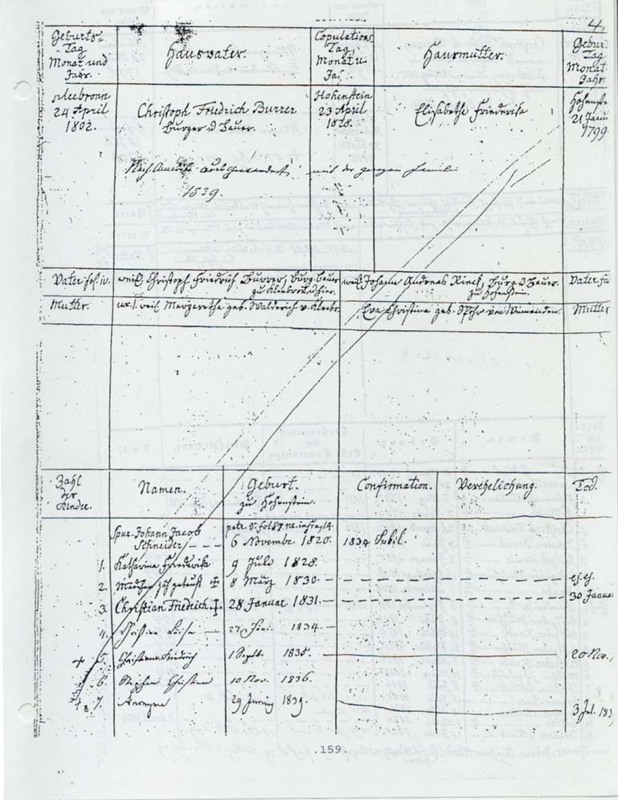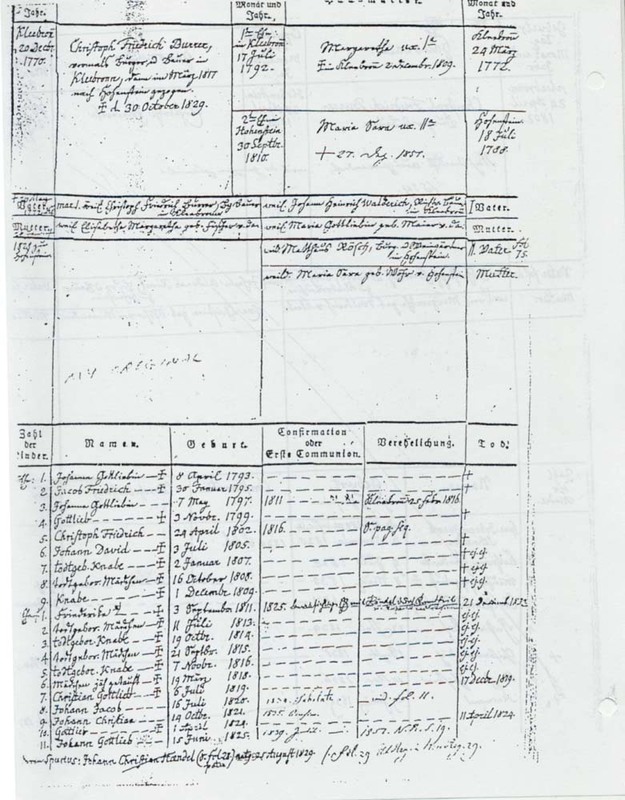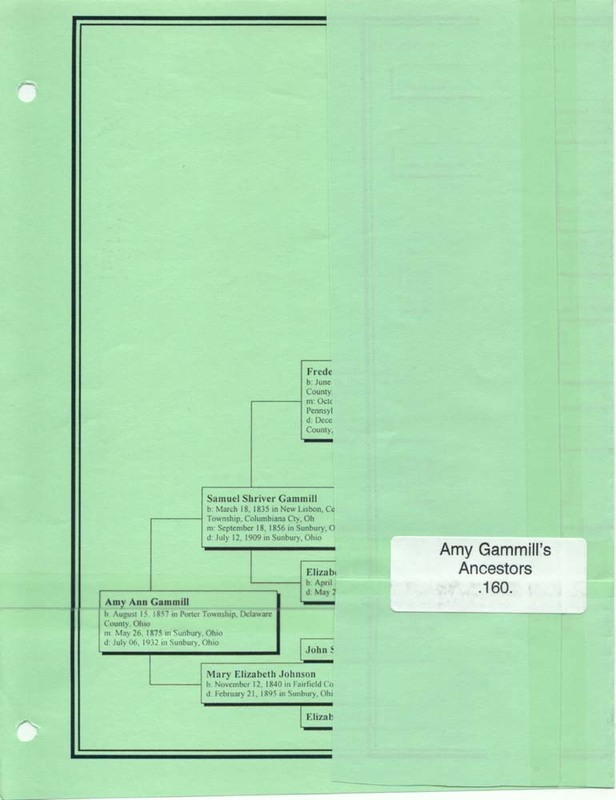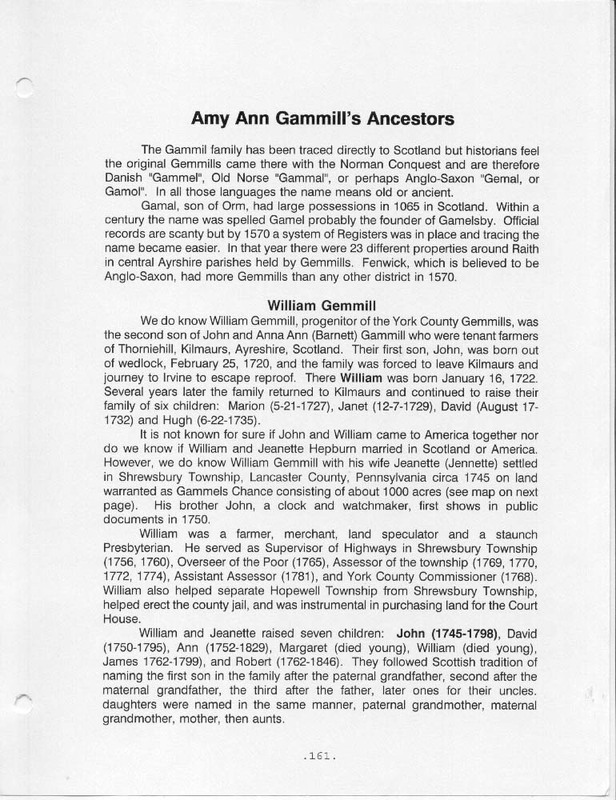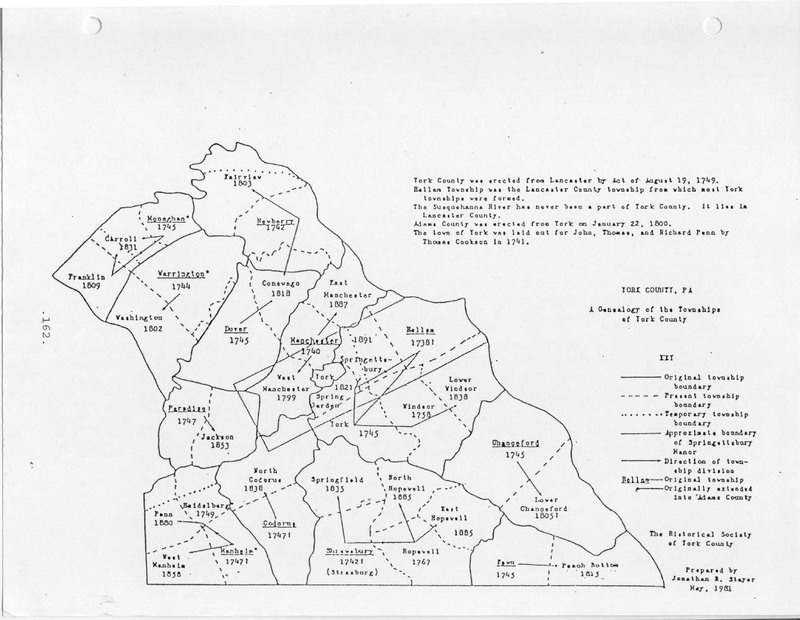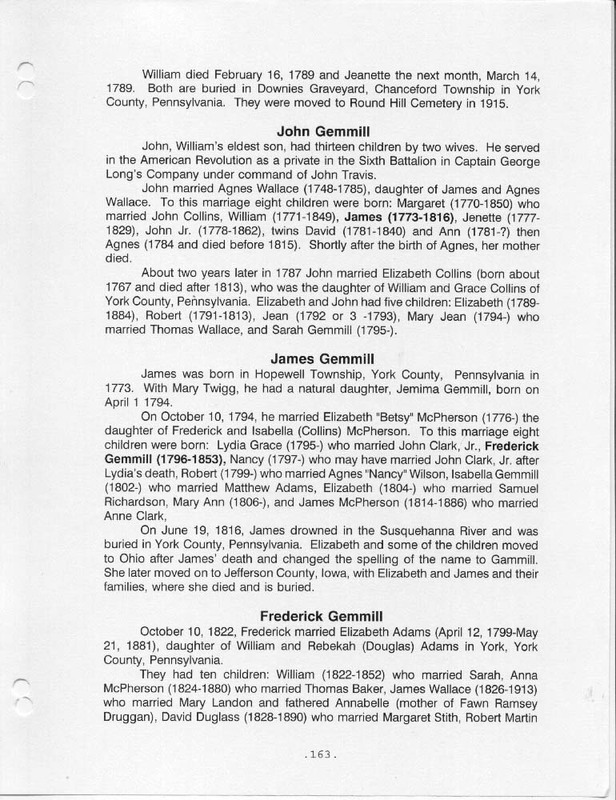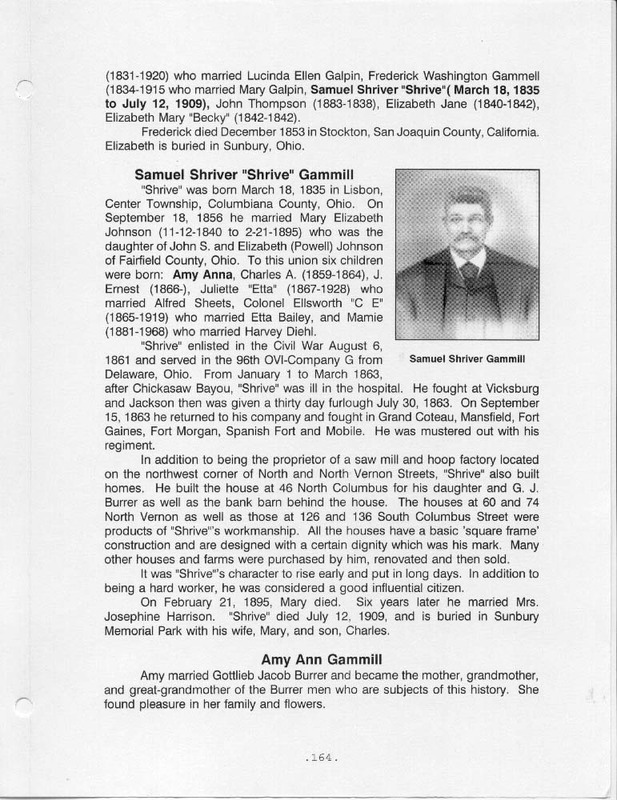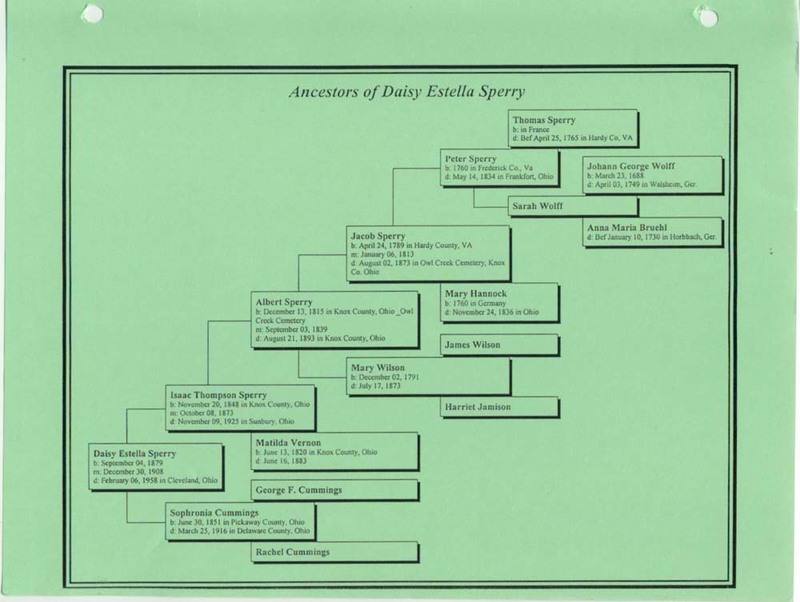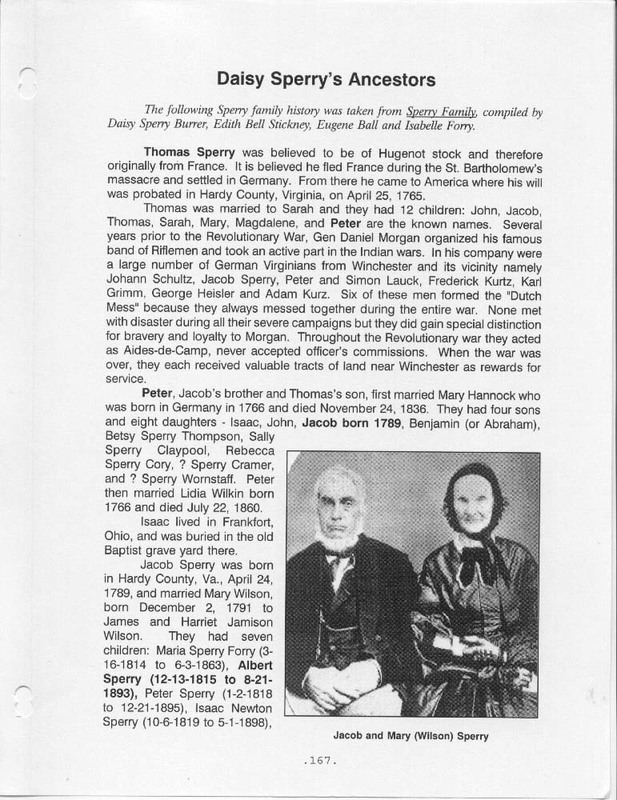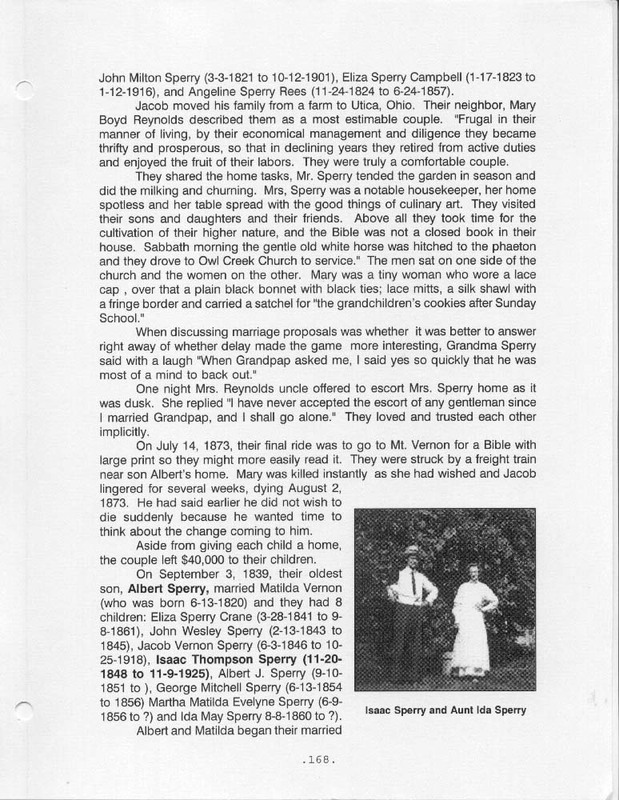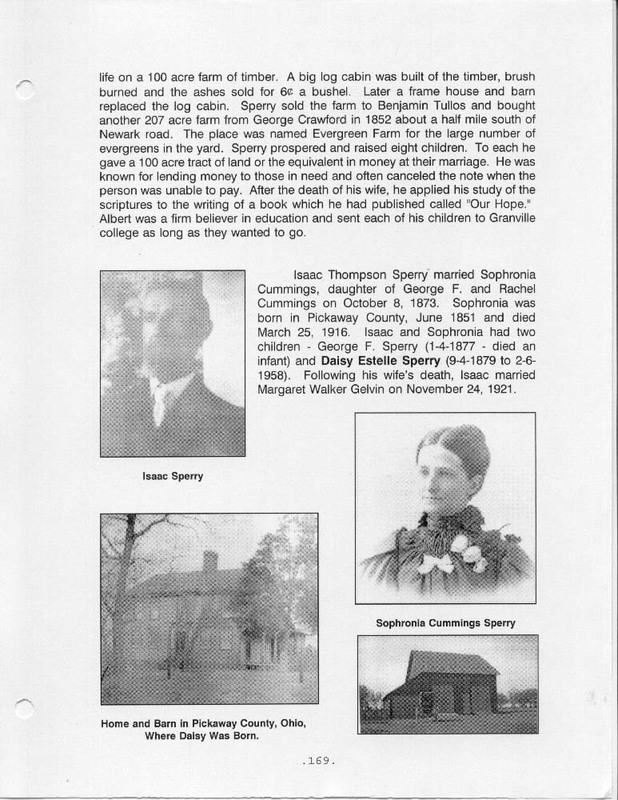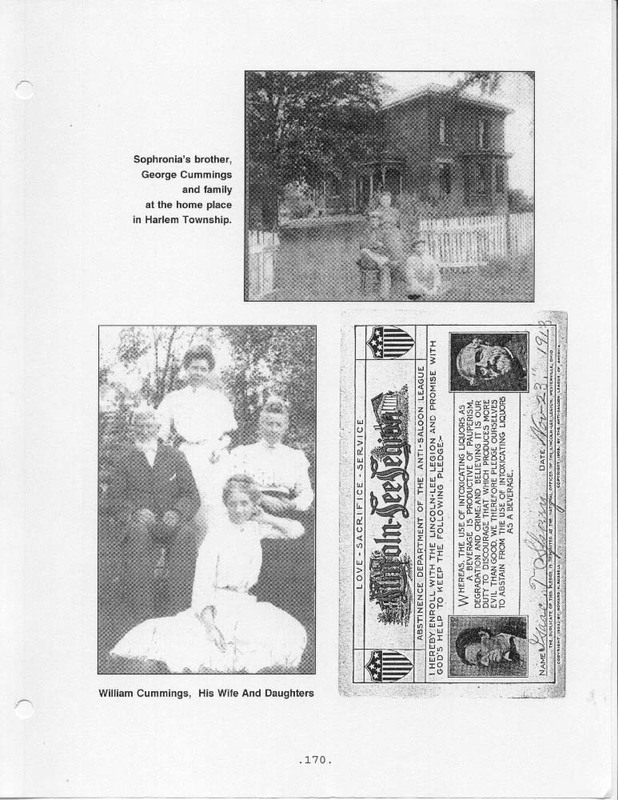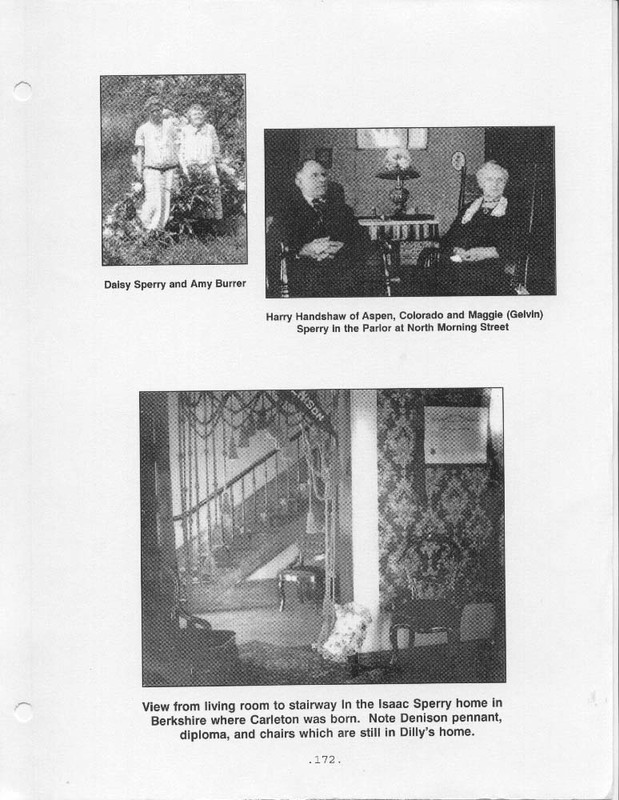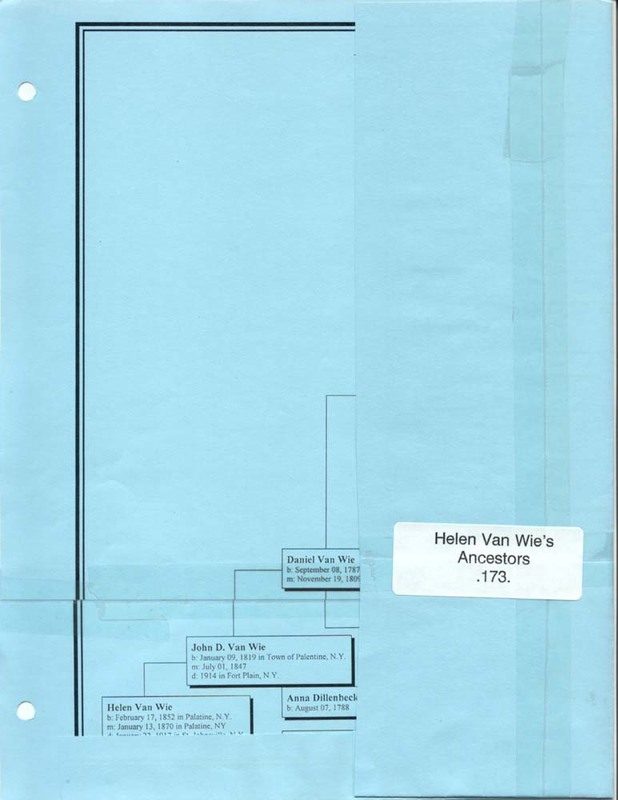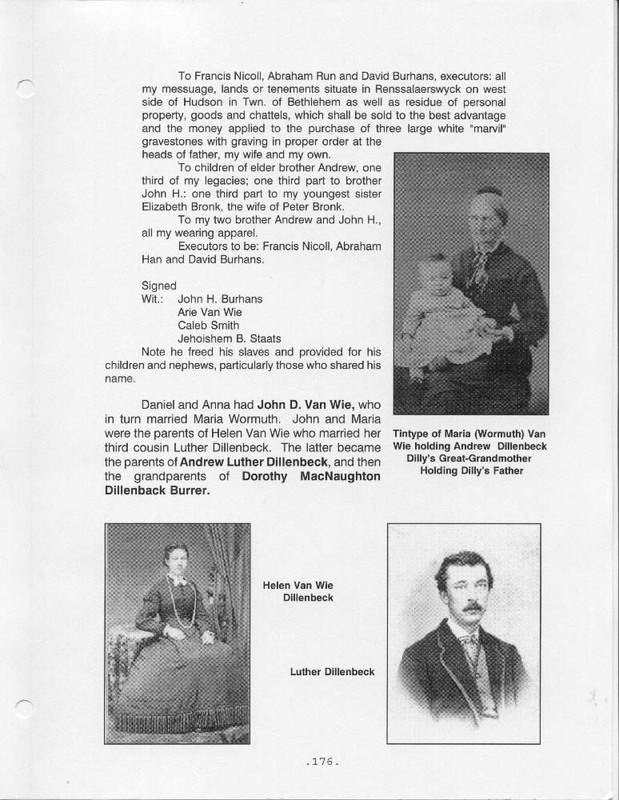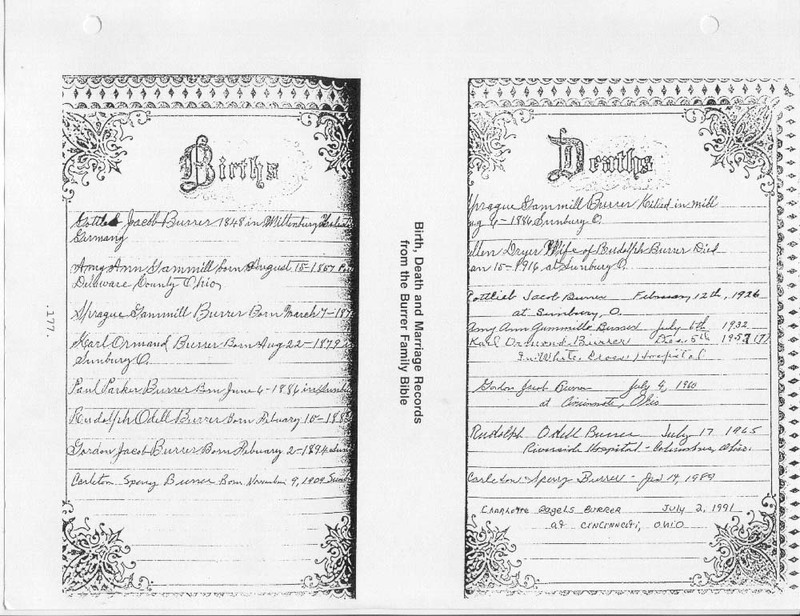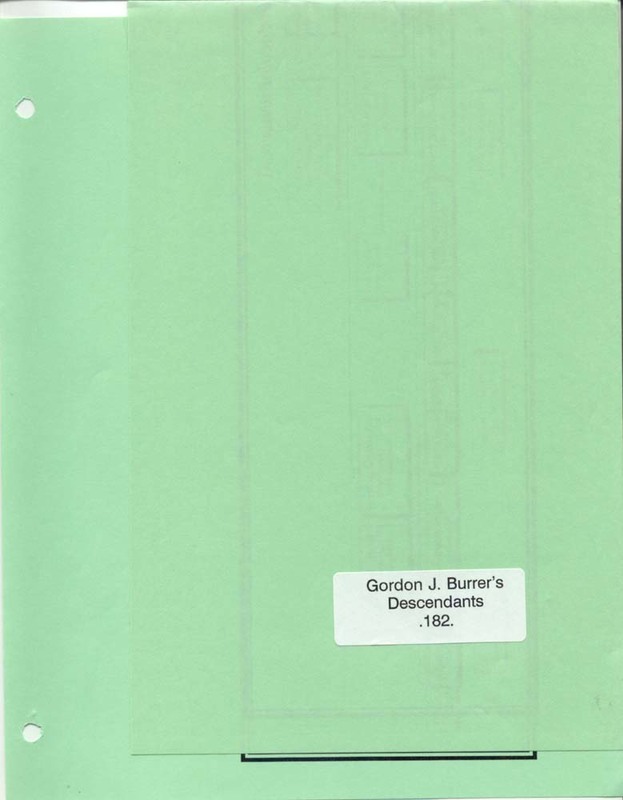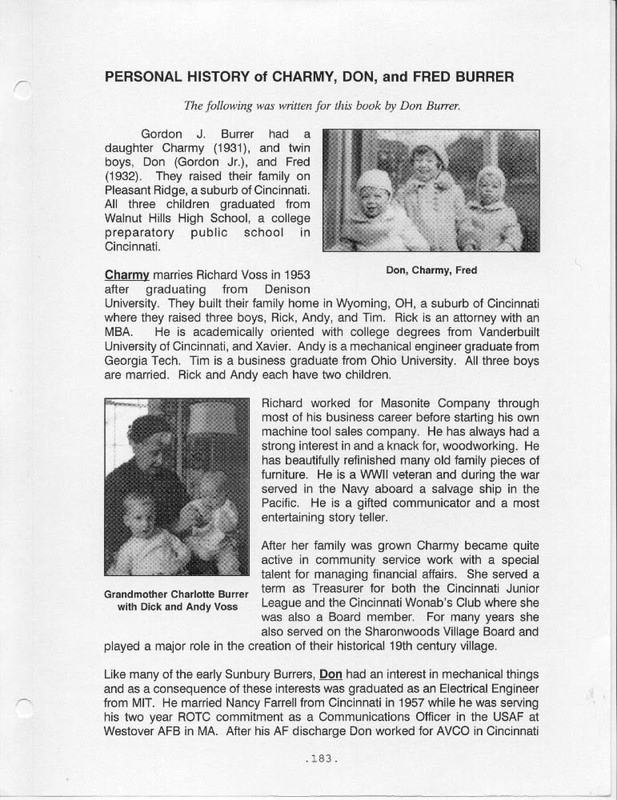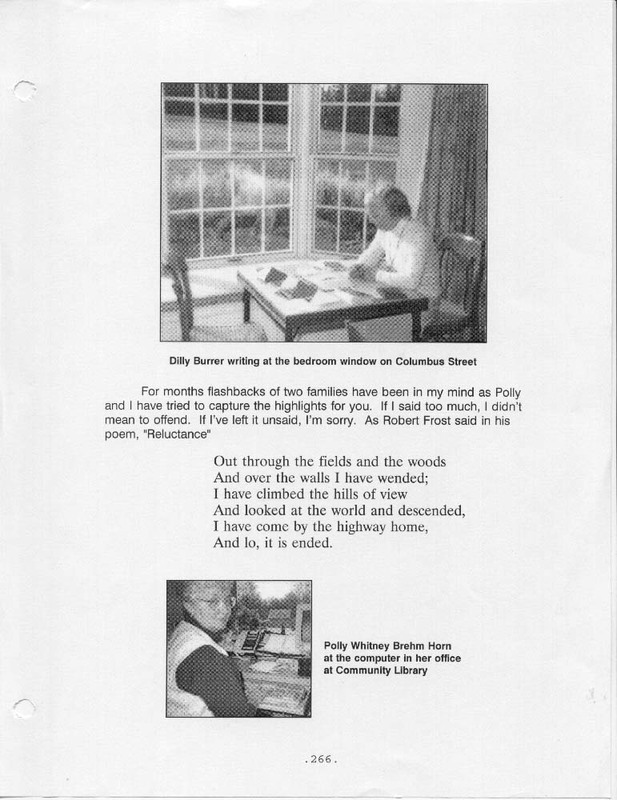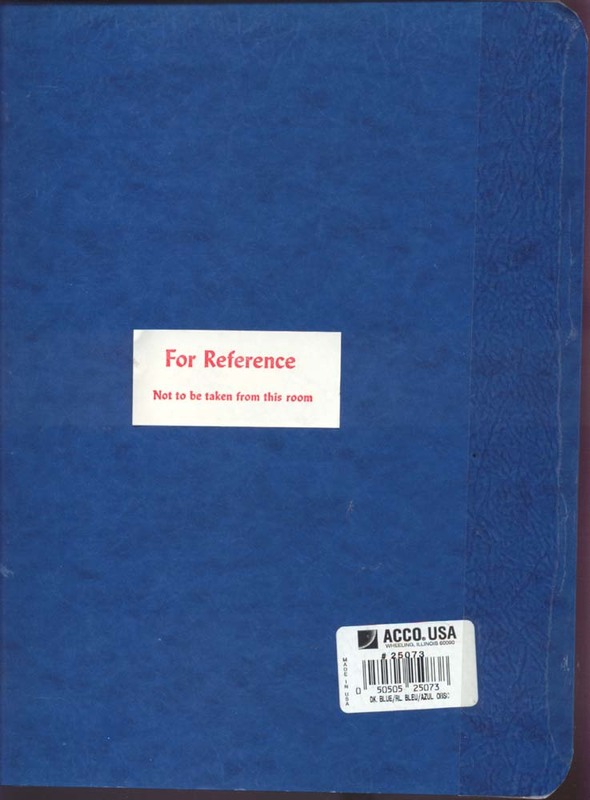Flashback: A Story of Two Families
Title
Flashback: A Story of Two Families (p. 1)
Description
[page 1]
[corresponds to front cover]
Flashback:
A Story of Two Families
by Dorothy Dillenbeck Burrer
as told to
Polly Whitney Brehm Horn
[corresponds to front cover]
Flashback:
A Story of Two Families
by Dorothy Dillenbeck Burrer
as told to
Polly Whitney Brehm Horn
Title
Flashback: A Story of Two Families (p. 2)
Description
[page 2]
[corresponds to inside front cover]
[image: Burrer coat of arms]
Community Library
Sunbury, Ohio
[corresponds to inside front cover]
[image: Burrer coat of arms]
Community Library
Sunbury, Ohio
Title
Flashback: A Story of Two Families (p. 3)
Description
[page 3]
[corresponds to front matter]
c.1-8-1997 rc 12-14-2004
Flashback:
A Story of Two Families
The Burrer Family
The Dillenbeck Family
by Dorothy Dillenbeck Burrer
as told to
Polly Whitney Brehm Horn
BUR
929.21
BURRER
c.1
Community Library
Sunbury, OH
1996
[Community Library imprint 106212]
[corresponds to front matter]
c.1-8-1997 rc 12-14-2004
Flashback:
A Story of Two Families
The Burrer Family
The Dillenbeck Family
by Dorothy Dillenbeck Burrer
as told to
Polly Whitney Brehm Horn
BUR
929.21
BURRER
c.1
Community Library
Sunbury, OH
1996
[Community Library imprint 106212]
Title
Flashback: A Story of Two Families (p. 4)
Description
[page 4]
[corresponds to page ii of Flashback: A Story of Two Families]
[photo:The Burrer Mill barn as it looks from the yard behind the Burrer home.]
NO BOOKS
Suppose there were no books!
No books to read in cozy nooks!
No books to feed the hungry mind
And teach the art of being kind.
To link today with yesterday:
No books to charm us for a while,
To bring a tear or lure a smile.
But here are books, praise God above!
If we have books and we have love
We can dispose of other things;
'Tis books, not crowns, that make men kings.
[corresponds to page ii of Flashback: A Story of Two Families]
[photo:The Burrer Mill barn as it looks from the yard behind the Burrer home.]
NO BOOKS
Suppose there were no books!
No books to read in cozy nooks!
No books to feed the hungry mind
And teach the art of being kind.
To link today with yesterday:
No books to charm us for a while,
To bring a tear or lure a smile.
But here are books, praise God above!
If we have books and we have love
We can dispose of other things;
'Tis books, not crowns, that make men kings.
Title
Flashback: A Story of Two Families (p. 5)
Description
[page 5]
[corresponds to page iii of Flashback: A Story of Two Families]
PREFACE
"There's a quiet movement taking place right now that deserves to become
a permanent tradition in this country: the purposeful creation of personal histories
that preserve our lives as we grow older, making the details of our time on earth
available to our descendants forever.
Whether written, spoken into a tape recorder, or recounted to the lens of
a video camera, your stories will be eagerly awaited by the most appreciative
audience of all-your family. And far into the future, your family will read your
words or listen to your voice and be grateful you took the time to put this gift
toegether for them." Taken from the back cover of Bob Greene's To Our Children's
Children.
This book came very close to having never been written. Due to failing eye
sight, old age, and a belief that (according to my personal credo), I could not
write about myself. My long time friend, Polly Horn, who is very competent on the
mysterious computer, said she would put my answers to her questions on the
computer. So here you have many flashbacks to the life styles of two families,
genealogy and all.
It was great luck to be born with parents who loved each other, my brother
and me.
It was great luck to meet Carleton Burrer at a dance in New York and end
up in Sunbury, Ohio, where I have been part of a loving family, had a meaningful
career, and a full life.
Although this book was begun after Carleton's death, many parts of it are
taken directly from words he had written at different times in his life. Polly and I
fondly call him our ghost writer and we are happy to be getting many of his
writings together into one book.
Since we are each a mix of genes of all the ancestors before us,
perhaps each of you-my son, my grandchildren and their heirs will learn a little
more about yourself from reading these flashbacks.
[corresponds to page iii of Flashback: A Story of Two Families]
PREFACE
"There's a quiet movement taking place right now that deserves to become
a permanent tradition in this country: the purposeful creation of personal histories
that preserve our lives as we grow older, making the details of our time on earth
available to our descendants forever.
Whether written, spoken into a tape recorder, or recounted to the lens of
a video camera, your stories will be eagerly awaited by the most appreciative
audience of all-your family. And far into the future, your family will read your
words or listen to your voice and be grateful you took the time to put this gift
toegether for them." Taken from the back cover of Bob Greene's To Our Children's
Children.
This book came very close to having never been written. Due to failing eye
sight, old age, and a belief that (according to my personal credo), I could not
write about myself. My long time friend, Polly Horn, who is very competent on the
mysterious computer, said she would put my answers to her questions on the
computer. So here you have many flashbacks to the life styles of two families,
genealogy and all.
It was great luck to be born with parents who loved each other, my brother
and me.
It was great luck to meet Carleton Burrer at a dance in New York and end
up in Sunbury, Ohio, where I have been part of a loving family, had a meaningful
career, and a full life.
Although this book was begun after Carleton's death, many parts of it are
taken directly from words he had written at different times in his life. Polly and I
fondly call him our ghost writer and we are happy to be getting many of his
writings together into one book.
Since we are each a mix of genes of all the ancestors before us,
perhaps each of you-my son, my grandchildren and their heirs will learn a little
more about yourself from reading these flashbacks.
Title
Flashback: A Story of Two Families (p. 6)
Description
[page 6]
[corresponds to page iv of Flashback: A Story of Two Families]
Table of Contents
I. The Burrers 1
A. The Ancestors 2
1. Christoph Friedrich Burrer II 2
2. John Jacob Burrer 2
a. The Old Mills 3
(1) F.B. Sprague 4
b. New Burrer Mill 5
B. Johan's Sons
1. John E. Burrer 6
2. Gottleib Jacob Burrer 6
3. Frank Burrer 8
C. Gottleib Jacob (Jakie) and Amy Ann Burrer 6
1. Electricity 11
2. Their Family 16
a. Sprague Gammill Burrer 9
b. Karl Ormand and Daisy Sperry Burrer 24
c. Paul ParkerBurrer 35
d. Rudolph Burrer 37
e. Gordon Jacob Burrer 39
D.Carleton Sperry Burrer 46
1. Sunbury Electric Shop 55
II. Dillenbecks 58
A. The Ancestors 59
1. Captain Andrew Dillenbeck and Oriskany 60
2. Rev. Lambert Swackhammer 66
B. Andrew Luther and Pearl Whitbeck Dillenbeck 75
C. Dorothy MacNaughton Dillenbeck Burrer 79
III. Carleton and Dillie Burrer 104
A. John Dillen Burrer 107
B. Community Library 110
c. Sunbury Electric Shop Burns 115
D.Farmers bank 118
E. Grandchildren 121
F. Retirement 129
IV. Appendix Index 155
A. Burrers in Germany 156
B. Gammill Family 160
C. Sperry Family 166
D. Van Wie Family 173
E. Pages from Burrer Bible 177
F. John E. Burrer Family from Esther Burrer 179
G. Nannie E. Burrer Family from Owen Warren 180
H. Paul Barker Family 181
I. Gordon Burrer Family from Don Burrer 182
J. Historical Data on Two Burrer Homes 186
The following articles were written by Carleton S. Burrer:
K. Origin of the Name of Sunbury 189
L. The Burrers from The People Book 198
M. Early Delaware County, Sunbury and Communnity 209
N. Sunbury and Galena Communities and how they
were in 1938 When Sunbury Lions Originated 222
O. Why I Enjoy Living in Sunbury, Delaware County, 235
V. Bibliography 239
VI. Index 240
[corresponds to page iv of Flashback: A Story of Two Families]
Table of Contents
I. The Burrers 1
A. The Ancestors 2
1. Christoph Friedrich Burrer II 2
2. John Jacob Burrer 2
a. The Old Mills 3
(1) F.B. Sprague 4
b. New Burrer Mill 5
B. Johan's Sons
1. John E. Burrer 6
2. Gottleib Jacob Burrer 6
3. Frank Burrer 8
C. Gottleib Jacob (Jakie) and Amy Ann Burrer 6
1. Electricity 11
2. Their Family 16
a. Sprague Gammill Burrer 9
b. Karl Ormand and Daisy Sperry Burrer 24
c. Paul ParkerBurrer 35
d. Rudolph Burrer 37
e. Gordon Jacob Burrer 39
D.Carleton Sperry Burrer 46
1. Sunbury Electric Shop 55
II. Dillenbecks 58
A. The Ancestors 59
1. Captain Andrew Dillenbeck and Oriskany 60
2. Rev. Lambert Swackhammer 66
B. Andrew Luther and Pearl Whitbeck Dillenbeck 75
C. Dorothy MacNaughton Dillenbeck Burrer 79
III. Carleton and Dillie Burrer 104
A. John Dillen Burrer 107
B. Community Library 110
c. Sunbury Electric Shop Burns 115
D.Farmers bank 118
E. Grandchildren 121
F. Retirement 129
IV. Appendix Index 155
A. Burrers in Germany 156
B. Gammill Family 160
C. Sperry Family 166
D. Van Wie Family 173
E. Pages from Burrer Bible 177
F. John E. Burrer Family from Esther Burrer 179
G. Nannie E. Burrer Family from Owen Warren 180
H. Paul Barker Family 181
I. Gordon Burrer Family from Don Burrer 182
J. Historical Data on Two Burrer Homes 186
The following articles were written by Carleton S. Burrer:
K. Origin of the Name of Sunbury 189
L. The Burrers from The People Book 198
M. Early Delaware County, Sunbury and Communnity 209
N. Sunbury and Galena Communities and how they
were in 1938 When Sunbury Lions Originated 222
O. Why I Enjoy Living in Sunbury, Delaware County, 235
V. Bibliography 239
VI. Index 240
Title
Flashback: A Story of Two Families (p. 7)
Description
[page 7]
[corresponds to unnumbered page]
FLASHBACK: EARLY BURRERS
[three images]
[corresponds to unnumbered page]
FLASHBACK: EARLY BURRERS
[three images]
Title
Flashback: A Story of Two Families (p. 8)
Description
[page 8]
[corresponds to page 1 of Flashback: A Story of Two Families]
[foldout: Carelton Burrer's Ancestors .1.]
[corresponds to page 1 of Flashback: A Story of Two Families]
[foldout: Carelton Burrer's Ancestors .1.]
Title
Flashback: A Story of Two Families (p. 9)
Description
[page 9]
[corresponds to page 2 of Flashback: A Story of Two Families]
Sunbury's Burrer family has been traced back to Hans Burrer born 1530 of
Cleebronn (spelled Kleebron in the old church records) in Germany. The name
passed through the sons as follows: Hans (1530) to Christoph (1590) to Christoph
(1628-1684) to Hans Jakob (1622-1715) to Johann Jakob (1701-1751) married to
Sabrina Cathrina Wehrer, to Christoph Friedrich (January 5, 1744-May 26, 1772).
Christoph Friedrich Burrer II
Christoph Friedrich who married Elizabetha Margaretha Fischer November
17, 1767 in Cleebronn, had at least 2 sons Gottlieb Johannes (1768-1827) and
Christoph Friedrich II (December 20, 1770-October 30, 1829).
Gottlieb married Susanna Barbara Eberlen October 30, 1792 in Botenheim,
Germany and they had 10 children: some were to stay in Germany while other
descendents immigrated to the America.
Christoph Friedrich II was born in Cleebron, Germany, December 20,
1770, and married Margaretha Walderich (born March 24, 1772) July 17, 1792
and became a farmer. To this union 9 children were born but only two of the
babies lived to be confirmed: Johanna Gottliebin (May 7, 1797) and Christoph
Friedrich III (April 24, 1802-April 4, 1884) who later settled in Elyria, Ohio. Their
mother died apparently in childbirth December 2, 1809.
Nine months later on September 30, 1810, Christoph II maried Maria Sara
Rosch (born July 18, 1788) in Hohenstein and they had eleven children. It
appears that only four babies lived to be confirmed: Friederike (1811-1832),
Johann Jacob (July 16, 1820-April 19, 1874), Johann Christian (October
14,1821-), and Johann Gottlieb (June 15, 1825-August 21, 1890). All three boys
married and immigrated to USA. It is Johann Jacob who brought his family to
Sunbury, Ohio.
Johan Jacob Burrer
Johann Jacob was born July 16, 1820, in Hohenstein, Germany, the 17th
child of Christoph II and the 8th child of Maria Sara. On February 6, 1844 he
married Barbara Catherine Bollinger of Hofen near Besigheim.
Barbara Catherine was the daughter of Gottleib Heinrich Bollinger,an
Alderman and Town Councilman in Hofen, and his wife, Christina Barbara Kontz,
Bollinger. Barbara Catherine told her children her grandfather Bollinger fought in
wars against Napoleon. At least four of her siblings also came to the USA.
Johann Jacob was a Burger (citizen) and Maurer Meister (master stone
mason) in Wurtenburg, Germany. He and Barbara Catherine had five children in
Germany: Louisa Catherine (7-23-1846), Gottleib Jacob (1-3-1848), Caroline
Catherine (2-5-1849), Catherine Christine (2-5-1851) and Fredericke (2-17-1852).
In July 1854, dropping the last 'n' in his name, Johan Jacob, his wife,
and five children left Germany in a sailing ship which arrived six weeks later in New
York. The family went by wagon to Medina County, Ohio, where his half-brother,
Christoph Friedrich, had already settled. They stayed with Johan Jacob's brother
for six months until a family fight resulted in Johan Jacob's moving his family to
Spring Street in Delaware,Ohio. Shortly after their arrival in Delaware, John
Edward was born (3-9-1855) having been carried by his mother during all the
rigors of the trip from Germany.
Apparently Johan Jacob's search for fine stone brought him to Sunbury
[corresponds to page 2 of Flashback: A Story of Two Families]
Sunbury's Burrer family has been traced back to Hans Burrer born 1530 of
Cleebronn (spelled Kleebron in the old church records) in Germany. The name
passed through the sons as follows: Hans (1530) to Christoph (1590) to Christoph
(1628-1684) to Hans Jakob (1622-1715) to Johann Jakob (1701-1751) married to
Sabrina Cathrina Wehrer, to Christoph Friedrich (January 5, 1744-May 26, 1772).
Christoph Friedrich Burrer II
Christoph Friedrich who married Elizabetha Margaretha Fischer November
17, 1767 in Cleebronn, had at least 2 sons Gottlieb Johannes (1768-1827) and
Christoph Friedrich II (December 20, 1770-October 30, 1829).
Gottlieb married Susanna Barbara Eberlen October 30, 1792 in Botenheim,
Germany and they had 10 children: some were to stay in Germany while other
descendents immigrated to the America.
Christoph Friedrich II was born in Cleebron, Germany, December 20,
1770, and married Margaretha Walderich (born March 24, 1772) July 17, 1792
and became a farmer. To this union 9 children were born but only two of the
babies lived to be confirmed: Johanna Gottliebin (May 7, 1797) and Christoph
Friedrich III (April 24, 1802-April 4, 1884) who later settled in Elyria, Ohio. Their
mother died apparently in childbirth December 2, 1809.
Nine months later on September 30, 1810, Christoph II maried Maria Sara
Rosch (born July 18, 1788) in Hohenstein and they had eleven children. It
appears that only four babies lived to be confirmed: Friederike (1811-1832),
Johann Jacob (July 16, 1820-April 19, 1874), Johann Christian (October
14,1821-), and Johann Gottlieb (June 15, 1825-August 21, 1890). All three boys
married and immigrated to USA. It is Johann Jacob who brought his family to
Sunbury, Ohio.
Johan Jacob Burrer
Johann Jacob was born July 16, 1820, in Hohenstein, Germany, the 17th
child of Christoph II and the 8th child of Maria Sara. On February 6, 1844 he
married Barbara Catherine Bollinger of Hofen near Besigheim.
Barbara Catherine was the daughter of Gottleib Heinrich Bollinger,an
Alderman and Town Councilman in Hofen, and his wife, Christina Barbara Kontz,
Bollinger. Barbara Catherine told her children her grandfather Bollinger fought in
wars against Napoleon. At least four of her siblings also came to the USA.
Johann Jacob was a Burger (citizen) and Maurer Meister (master stone
mason) in Wurtenburg, Germany. He and Barbara Catherine had five children in
Germany: Louisa Catherine (7-23-1846), Gottleib Jacob (1-3-1848), Caroline
Catherine (2-5-1849), Catherine Christine (2-5-1851) and Fredericke (2-17-1852).
In July 1854, dropping the last 'n' in his name, Johan Jacob, his wife,
and five children left Germany in a sailing ship which arrived six weeks later in New
York. The family went by wagon to Medina County, Ohio, where his half-brother,
Christoph Friedrich, had already settled. They stayed with Johan Jacob's brother
for six months until a family fight resulted in Johan Jacob's moving his family to
Spring Street in Delaware,Ohio. Shortly after their arrival in Delaware, John
Edward was born (3-9-1855) having been carried by his mother during all the
rigors of the trip from Germany.
Apparently Johan Jacob's search for fine stone brought him to Sunbury
Title
Flashback: A Story of Two Families (p. 10)
Description
[page 10]
[corresponds to page 3 of Flashback: A Story of Two Families]
where he purchased a log cabin on in-lot #19 (44 West Cherry Street) from
Andrew and Julia Heron on January 28, 1857 (Vol 59, page 224 Delaware County
Deed Records). The cabin was shingled on the outside and plastered on the
inside and became the family home until the death of Barbara Catherine in 1901.
In this home the last three children were born: Nannie E.(9/20/1857-2/4/1931),
Heinrich (1859), and Frank (1863). The home was last purchased by the Village
of Sunbury in 1995.
In August 1857, Johan Jacob purchased a plot of land along the Big
Walnut Creek from John Knox as a 'Stone Purchase' where he and his eldest son
later became partners with Henry Fleckner in the operation of the quarry. Johan
Jacob's oldest daughter, Louise Catherine, married Fleckner and they lived in the
house now standing at 10 Walnut Street at the east end of Cherry Street. (They
had two children: Charles R. (1867-1867) and Julia (1874-1881).
In 1867 Burrer bought an empty lot at 35 South Columbus Street just north
of the Myers Inn, then a hotel. On this lot he built a tavern, small store and
bakery. Under the building was a small sub-basement which was used for natural
refrigeration. People attending the periodic stock sales on the southwest corner
of the village square stopped here for refreshments and a light lunch. When the
building was torn down by Lawsons' in 1985, stone
from the building was given to Community Library, owner of the Myers' Inn. The stone was
transferred to the Big Walnut Area Historical Society with the building in 1994.
Business in the tavern, store, bakery must
have prospered for the family along with Johan
Jacob's work as a stone mason. He passed his
knowledge of the trade along to his eldest son,
Gottlieb Jacob.
Bailey Mill
To be true to history, one must leave our
story and discuss another mill. Carleton has written
the first mill in Sunbury was constructed southeast
of town on Granville Road just south of Big Walnut
Creek near the juncture with Rattlesnake Creek by
Nicholas Manville in 1810. The ownership of this mill passed to Major Strong in
1817, and then to Eleazor Gaylord in 1825 thus became known as the Gaylord
Mill. It never reported to mill white flour. Since this mill did not operate as long,
the Burrer Mill has the distinction of being the longest operating mill. Back to our story.
In 1871, Burrer and his son, Gottleib Jacob (then 23 years of age),
purchased from Henry and Sarah Boyd, the old 'Bailey'water-powered mill which
had been built in 1842 by Samuel Peck and T.P. Myers to operate as a sawmill.
Mr. Bailey bought the mill in 1848 and added machinery for making flour and
grinding 'grists'(small batches of grain) by means of stone 'Buhrs'. This mill was
located in the bottom land along Big Walnut Creek behind Fleckner's barn. The
creek had been diverted further up stream to flow into a pond and there was a
'right-of-way' included for a tail-race through John Knox's land to carry run-off
[photo: Gottleib Jacob Burrer]
[corresponds to page 3 of Flashback: A Story of Two Families]
where he purchased a log cabin on in-lot #19 (44 West Cherry Street) from
Andrew and Julia Heron on January 28, 1857 (Vol 59, page 224 Delaware County
Deed Records). The cabin was shingled on the outside and plastered on the
inside and became the family home until the death of Barbara Catherine in 1901.
In this home the last three children were born: Nannie E.(9/20/1857-2/4/1931),
Heinrich (1859), and Frank (1863). The home was last purchased by the Village
of Sunbury in 1995.
In August 1857, Johan Jacob purchased a plot of land along the Big
Walnut Creek from John Knox as a 'Stone Purchase' where he and his eldest son
later became partners with Henry Fleckner in the operation of the quarry. Johan
Jacob's oldest daughter, Louise Catherine, married Fleckner and they lived in the
house now standing at 10 Walnut Street at the east end of Cherry Street. (They
had two children: Charles R. (1867-1867) and Julia (1874-1881).
In 1867 Burrer bought an empty lot at 35 South Columbus Street just north
of the Myers Inn, then a hotel. On this lot he built a tavern, small store and
bakery. Under the building was a small sub-basement which was used for natural
refrigeration. People attending the periodic stock sales on the southwest corner
of the village square stopped here for refreshments and a light lunch. When the
building was torn down by Lawsons' in 1985, stone
from the building was given to Community Library, owner of the Myers' Inn. The stone was
transferred to the Big Walnut Area Historical Society with the building in 1994.
Business in the tavern, store, bakery must
have prospered for the family along with Johan
Jacob's work as a stone mason. He passed his
knowledge of the trade along to his eldest son,
Gottlieb Jacob.
Bailey Mill
To be true to history, one must leave our
story and discuss another mill. Carleton has written
the first mill in Sunbury was constructed southeast
of town on Granville Road just south of Big Walnut
Creek near the juncture with Rattlesnake Creek by
Nicholas Manville in 1810. The ownership of this mill passed to Major Strong in
1817, and then to Eleazor Gaylord in 1825 thus became known as the Gaylord
Mill. It never reported to mill white flour. Since this mill did not operate as long,
the Burrer Mill has the distinction of being the longest operating mill. Back to our story.
In 1871, Burrer and his son, Gottleib Jacob (then 23 years of age),
purchased from Henry and Sarah Boyd, the old 'Bailey'water-powered mill which
had been built in 1842 by Samuel Peck and T.P. Myers to operate as a sawmill.
Mr. Bailey bought the mill in 1848 and added machinery for making flour and
grinding 'grists'(small batches of grain) by means of stone 'Buhrs'. This mill was
located in the bottom land along Big Walnut Creek behind Fleckner's barn. The
creek had been diverted further up stream to flow into a pond and there was a
'right-of-way' included for a tail-race through John Knox's land to carry run-off
[photo: Gottleib Jacob Burrer]
Title
Flashback: A Story of Two Families (p. 11)
Description
[page 11]
[corresponds to page 4 of Flashback: A Story of Two Families]
from the water wheel to a point farther down stream. This mill property containing
a little over 26 acres of land (in addition to the right-of-way) was purchased for
$3500. Mr. Boyd had previously purchased the Van Sickle Mill, the first in Trenton
Township from his brother, Jacob Boyd, and had moved its machinery into the
'Bailey' Mill.
The Van Sickle Mill had been built in 1845 with a 'brush' dam across the
Big Walnut about one half mile northeast of Sunbury. The 'brush' dam was
replaced with planks. John Van Sickle sold the mill to E.M. Condit who
operated it from 1855 to 1862 and then sold it to Jacob Boyd. F.B. Sprague, a
Justice of the Peace who certified the Burrer-Boyd purchase agreement on June
16, 1871, had expertise in the milling business and bought in as a partner with the
Burrer father and son.
F.B. Sprague
This partner in the early mill was born in Delaware July 16, 1825 to Pardon
and Mary Meeker Sprague. Pardon was born in the east and migrated through
Zanesville and Granville in 1816. Mary was the daughter of Forest Meeker (born
in Pennsylvania) who came to Stratford, Ohio, in 1811. Pardon was Sheriff for two
terms before entering the State Legislature. He died in 1828 at 40 years of age.
F.B. moved his family which included C.P. to Sunbury in 1868. C.P.
worked with Kimball & Armstrong in their store, then with Wayman Perfect for a
year before studying telegraphy with his brother who kept the Railway Office in
Sunbury. On March 18, 1877, he married Ada M. Payne (daughter of N.H. Payne
of Sunbury) and August 1, 1877 he became Station Agent. Meanwhile F.B.
Sprague became Probate Judge in 1875 after being Justice of the Peace. He
soon lost interest in the milling business.
It was not long before it became obvious the creek flow was not strong
enough six months of the year to carry the business of the mill so land was
purchased at the northeast corner of North and
North Columbus Streets where a steam
powered mill would be built. The outlines of the old
mill race and some building foundations can still be
seen in the spring of the year before the underbrush
obscures the area.
Carleton Burrer has done much to
document the details
of the mill.
Johan Jacob
died on April 18, 1874,
at the age of 53 and
did not see the mill
moved from the creek
site. At the time of his
death two more
daughters were
married: Caroline
Catherine had married
[photo: Gottlieb Jacob Burrer]
[photo: Christine Burrer Rice]
[corresponds to page 4 of Flashback: A Story of Two Families]
from the water wheel to a point farther down stream. This mill property containing
a little over 26 acres of land (in addition to the right-of-way) was purchased for
$3500. Mr. Boyd had previously purchased the Van Sickle Mill, the first in Trenton
Township from his brother, Jacob Boyd, and had moved its machinery into the
'Bailey' Mill.
The Van Sickle Mill had been built in 1845 with a 'brush' dam across the
Big Walnut about one half mile northeast of Sunbury. The 'brush' dam was
replaced with planks. John Van Sickle sold the mill to E.M. Condit who
operated it from 1855 to 1862 and then sold it to Jacob Boyd. F.B. Sprague, a
Justice of the Peace who certified the Burrer-Boyd purchase agreement on June
16, 1871, had expertise in the milling business and bought in as a partner with the
Burrer father and son.
F.B. Sprague
This partner in the early mill was born in Delaware July 16, 1825 to Pardon
and Mary Meeker Sprague. Pardon was born in the east and migrated through
Zanesville and Granville in 1816. Mary was the daughter of Forest Meeker (born
in Pennsylvania) who came to Stratford, Ohio, in 1811. Pardon was Sheriff for two
terms before entering the State Legislature. He died in 1828 at 40 years of age.
F.B. moved his family which included C.P. to Sunbury in 1868. C.P.
worked with Kimball & Armstrong in their store, then with Wayman Perfect for a
year before studying telegraphy with his brother who kept the Railway Office in
Sunbury. On March 18, 1877, he married Ada M. Payne (daughter of N.H. Payne
of Sunbury) and August 1, 1877 he became Station Agent. Meanwhile F.B.
Sprague became Probate Judge in 1875 after being Justice of the Peace. He
soon lost interest in the milling business.
It was not long before it became obvious the creek flow was not strong
enough six months of the year to carry the business of the mill so land was
purchased at the northeast corner of North and
North Columbus Streets where a steam
powered mill would be built. The outlines of the old
mill race and some building foundations can still be
seen in the spring of the year before the underbrush
obscures the area.
Carleton Burrer has done much to
document the details
of the mill.
Johan Jacob
died on April 18, 1874,
at the age of 53 and
did not see the mill
moved from the creek
site. At the time of his
death two more
daughters were
married: Caroline
Catherine had married
[photo: Gottlieb Jacob Burrer]
[photo: Christine Burrer Rice]
Title
Flashback: A Story of Two Families (p. 12)
Description
[page 12]
[corresponds to page 5 of Flashback: A Story of Two Families ]
Daniel Miller of Delaware, and Catherine Christine married Charles H. Rice. His
son Heinrich died the month before his father at the age of 14. Johan Jacob was
also survived by his widow (now 54), Gottlieb Jacob (26), John E. (20), Nannie
(18), and Frank (12). Gottlieb Jacob administered his father's estate and
rearranged ownership of the properties to continue operation of the tavern (now
a bakery and a store) and the mill.
Mill Moved into Town
East of the site chosen for the new mill at the corner of North Vernon and
North Streets, Samuel Shiver Gammill was operating a saw mill and Hoop Factory
using steam power. Mr. Gammill, who was also an excellent builder, agreed to
build the new mill. Foundations were laid for a frame structure for the mill
and one of stone for the boiler and engine room. The new mill was to use the excess
end-products (slabs and saw-dust) to fire the new boiler. Accordingly, an
exceptionally large and tall smoke stack was erected to permit burning of this fuel
with safety in the quantities needed. Pictures of the old mill can be seen at 46 N.
Columbus Street.
[photo: Burrer Mill-from North Street. Man on left in big door
is Jakie Burrer. Second man from
right in same
door is Parker Burrer.]
In 1875 the machinery and equipment from the old mill were moved into
town and a steam engine was purchased in Mount Vernon to supply power. This
piece of equipment took advantage of the newest and the oldest forms of
transportation in the community. Due to the incompletion of the new railroad
trestle across Big Walnut, the engine came by railroad to the Big Walnut Creek
where it had to be unloaded at one of the quarries and brought across the creek
and into town by ox-drawn wagon to the new mill. On December 1, 1879, (Deed
[corresponds to page 5 of Flashback: A Story of Two Families ]
Daniel Miller of Delaware, and Catherine Christine married Charles H. Rice. His
son Heinrich died the month before his father at the age of 14. Johan Jacob was
also survived by his widow (now 54), Gottlieb Jacob (26), John E. (20), Nannie
(18), and Frank (12). Gottlieb Jacob administered his father's estate and
rearranged ownership of the properties to continue operation of the tavern (now
a bakery and a store) and the mill.
Mill Moved into Town
East of the site chosen for the new mill at the corner of North Vernon and
North Streets, Samuel Shiver Gammill was operating a saw mill and Hoop Factory
using steam power. Mr. Gammill, who was also an excellent builder, agreed to
build the new mill. Foundations were laid for a frame structure for the mill
and one of stone for the boiler and engine room. The new mill was to use the excess
end-products (slabs and saw-dust) to fire the new boiler. Accordingly, an
exceptionally large and tall smoke stack was erected to permit burning of this fuel
with safety in the quantities needed. Pictures of the old mill can be seen at 46 N.
Columbus Street.
[photo: Burrer Mill-from North Street. Man on left in big door
is Jakie Burrer. Second man from
right in same
door is Parker Burrer.]
In 1875 the machinery and equipment from the old mill were moved into
town and a steam engine was purchased in Mount Vernon to supply power. This
piece of equipment took advantage of the newest and the oldest forms of
transportation in the community. Due to the incompletion of the new railroad
trestle across Big Walnut, the engine came by railroad to the Big Walnut Creek
where it had to be unloaded at one of the quarries and brought across the creek
and into town by ox-drawn wagon to the new mill. On December 1, 1879, (Deed
Title
Flashback: A Story of Two Families (p. 13)
Description
[page 13]
[corresponds to page 6 of Flashback: A Story of Two Families ]
Record 74, page 380), Jakie and his wife, Amy, conveyed to Louisa C. (Mrs.
Henry) Fleckner, the Boyd (Bailey) Mill property since it was no longer needed for
the mill.
In the new mill, grain was ground between rotating grooved stones or
'buhrs' driven by steam power. Buhrs cut from local stone were too soft to retain
sharpening. The best material for making these buhrs was then obtainable only
in France and had to be cut in segments to facilitate handling in shipment. In
1996, one of these made of cut and fitted granite, held together by a wide band
of thick steel was being preserved on the patio south of the Burrer residence at
46 N. Columbus Street. The mate of the stone was in the custody of R.F.Sherfy.
Gottlieb Jacob Burrer and
Amy Ann Gammill Marry
On May 26, 1875 Jakie and Amy Ann
Gammill (whose genealogy is included in the
appendix to this volume) married in her parents'
home. Amy was born in Porter Township in 1858
and spent her life in this community. Her father
Samuel Shriver Gammill built a house for them
across from the mill on the south side of North
Street designated as 46 North Columbus Street
which has remained in the Burrer family. At the
time the streets were not paved and there was an
open ditch between the mill and the house. When
the streets were paved a large tile covered with fill
ran through this ditch to Prairie Run.
The Sunbury Mill flourished in its new
location. Farmers from miles around brought their
grain by wagon or horseback and sometimes had to
wait hours for their "turn." In 1886 the stone buhrs
were replaced by steel roller mills. Soon thereafter
"White Loaf Flour" and other milling products were being manufactured and
shipped out of the area to various markets.
Jakie's Brothers and Sisters
After the death of their father and
Sprague's becoming judge, the Burrer
Brothers operated the mill-Jakie, John E.
and 12-year-old Frank. As Jakie began to
raise his own family, his brothers began to
pursue other interests.
John E. Burrer was more active in
the bakery and the store. In 1893 at the
age of 38, he married Margaret, daughter of
Remolus Hyatt. Like John she had grown
up in a log cabin located just west of 61,
north of the intersection of State Route 3
[photo: Jakie and Amy Burrer]
[photo: Jakie and Amy Burrer's Home
46 North columbus Street
Sunbury, Ohio][corresponds to page 7 of Flashback: A Story of Two Families ]
[corresponds to page 6 of Flashback: A Story of Two Families ]
Record 74, page 380), Jakie and his wife, Amy, conveyed to Louisa C. (Mrs.
Henry) Fleckner, the Boyd (Bailey) Mill property since it was no longer needed for
the mill.
In the new mill, grain was ground between rotating grooved stones or
'buhrs' driven by steam power. Buhrs cut from local stone were too soft to retain
sharpening. The best material for making these buhrs was then obtainable only
in France and had to be cut in segments to facilitate handling in shipment. In
1996, one of these made of cut and fitted granite, held together by a wide band
of thick steel was being preserved on the patio south of the Burrer residence at
46 N. Columbus Street. The mate of the stone was in the custody of R.F.Sherfy.
Gottlieb Jacob Burrer and
Amy Ann Gammill Marry
On May 26, 1875 Jakie and Amy Ann
Gammill (whose genealogy is included in the
appendix to this volume) married in her parents'
home. Amy was born in Porter Township in 1858
and spent her life in this community. Her father
Samuel Shriver Gammill built a house for them
across from the mill on the south side of North
Street designated as 46 North Columbus Street
which has remained in the Burrer family. At the
time the streets were not paved and there was an
open ditch between the mill and the house. When
the streets were paved a large tile covered with fill
ran through this ditch to Prairie Run.
The Sunbury Mill flourished in its new
location. Farmers from miles around brought their
grain by wagon or horseback and sometimes had to
wait hours for their "turn." In 1886 the stone buhrs
were replaced by steel roller mills. Soon thereafter
"White Loaf Flour" and other milling products were being manufactured and
shipped out of the area to various markets.
Jakie's Brothers and Sisters
After the death of their father and
Sprague's becoming judge, the Burrer
Brothers operated the mill-Jakie, John E.
and 12-year-old Frank. As Jakie began to
raise his own family, his brothers began to
pursue other interests.
John E. Burrer was more active in
the bakery and the store. In 1893 at the
age of 38, he married Margaret, daughter of
Remolus Hyatt. Like John she had grown
up in a log cabin located just west of 61,
north of the intersection of State Route 3
[photo: Jakie and Amy Burrer]
[photo: Jakie and Amy Burrer's Home
46 North columbus Street
Sunbury, Ohio][corresponds to page 7 of Flashback: A Story of Two Families ]
Title
Flashback: A Story of Two Families (p. 14)
Description
[page 14]
[corresponds to page 7 of Flashback: A Story of Two Families ]
THE VILLAGE OFFICIALS
[photo: LLOYD M. BELL MAYOR]
[photo: DR. W.O.PHILLIPS COUNCILMAN]
[photo: HARVEY HUPP COUNCILMAN]
[photo: W.M. KASSON COUNCILMAN]
[photo: REV. JOS. LONG COUNCILMAN]
[photo: JOHN E. BURRER COUNCILMAN]
[photo: HARRY BELL TREASURER]
[photo: S.ROSS BEST CLERK]
[photo: LEWIS EVANS MARSHALL]
[photo: MR. DAVIDSON STREET COMMISSIONER]
1906
[corresponds to page 7 of Flashback: A Story of Two Families ]
THE VILLAGE OFFICIALS
[photo: LLOYD M. BELL MAYOR]
[photo: DR. W.O.PHILLIPS COUNCILMAN]
[photo: HARVEY HUPP COUNCILMAN]
[photo: W.M. KASSON COUNCILMAN]
[photo: REV. JOS. LONG COUNCILMAN]
[photo: JOHN E. BURRER COUNCILMAN]
[photo: HARRY BELL TREASURER]
[photo: S.ROSS BEST CLERK]
[photo: LEWIS EVANS MARSHALL]
[photo: MR. DAVIDSON STREET COMMISSIONER]
1906
Title
Flashback: A Story of Two Families (p. 15)
Description
[page 15]
[corresponds to page 8 of Flashback: A Story of Two Families ]
and 36 in Sunbury. It too has been sided and plastered so no one knew it was
a cabin. John E. and Margaret moved into rooms over the bakery and had three
children: Esther (5-28-1894), Arthur Merton (8-1-1896) and Frank (6-28-1898).
Parker Burrer often told the story of going to John's bakery and coming
home with 6 large loaves of bread for only twenty-five cents.
In 1899 this building and lot were sold to Mr. J. W. Barker who continued
to operate the business there until he sold it in 1906 to Mr. C.A. Root who came
from Pickaway County. Robert Gelston came to town and operated the business
from 1913 to 1919 and lived in the building.
In 1900 John E. purchased a flour and grist mill in Centerburg and moved
his family there. Two more children were born: George Hyatt (May 10-1902) and
Ralph Henry (10-12-1909).
Business was good for the family in Centerburg. John E. became a
councilman and prominent businessman. However the mill dust began to take its
toll on him so in 1910 he sold the mill to his brother, Jakie, and moved to
Delaware, Ohio, where he purchased a bakery on the north side of Winter Street
on the corner of the first alley west of Bun's Restaurant and Bakery. They bought
a home on West William Street. Unfortunately, the bakery in Delaware did not
prove to be profitable and John E. became an engineer in a mill in Prospect,
Ohio. His health again made him leave the mill profession, so he opened a
delicatessen in Delaware which also failed to succeed. He moved his family to
Westerville and set his youngest son, Ralph, up in the shoe business. At the age
of 77, he passed away on December 24, 1932, and is buried in Sunbury
Cemetery. His son, Ralph Henry, moved his shoe store to Delaware where it was
very successful. He raised a family of four children (another died at birth) and
passed away at age 66 in 1975.
John's eldest child, Esther, retired from a lifetime as a school librarian, lived
in Delaware. She told Carleton Burrer the family had a total of 75 cents to
get started when they moved to Centerburg so many years before.
Fredericka Burrer married Charles Crawford. They had no children.
Nannie E. Burrer married
Thomas R. Payne, son of
Harrison and Adaline (Goodrich)
Payne on June 21, 1879.
Thomas was a hardware
merchant in Sunbury. (See the
Appendix of this book for more
about this family.)
Frank Burrer never married but continued to live
with his mother and help with
the operations in the mill.
However, when his mother died
August 29, 1901, he moved to Westerville, built a mill there and
operated it until his death in December 27, 1942. The log-
cabin home in Sunbury was
[photo: Boys in the Burrer Living Room]
[corresponds to page 8 of Flashback: A Story of Two Families ]
and 36 in Sunbury. It too has been sided and plastered so no one knew it was
a cabin. John E. and Margaret moved into rooms over the bakery and had three
children: Esther (5-28-1894), Arthur Merton (8-1-1896) and Frank (6-28-1898).
Parker Burrer often told the story of going to John's bakery and coming
home with 6 large loaves of bread for only twenty-five cents.
In 1899 this building and lot were sold to Mr. J. W. Barker who continued
to operate the business there until he sold it in 1906 to Mr. C.A. Root who came
from Pickaway County. Robert Gelston came to town and operated the business
from 1913 to 1919 and lived in the building.
In 1900 John E. purchased a flour and grist mill in Centerburg and moved
his family there. Two more children were born: George Hyatt (May 10-1902) and
Ralph Henry (10-12-1909).
Business was good for the family in Centerburg. John E. became a
councilman and prominent businessman. However the mill dust began to take its
toll on him so in 1910 he sold the mill to his brother, Jakie, and moved to
Delaware, Ohio, where he purchased a bakery on the north side of Winter Street
on the corner of the first alley west of Bun's Restaurant and Bakery. They bought
a home on West William Street. Unfortunately, the bakery in Delaware did not
prove to be profitable and John E. became an engineer in a mill in Prospect,
Ohio. His health again made him leave the mill profession, so he opened a
delicatessen in Delaware which also failed to succeed. He moved his family to
Westerville and set his youngest son, Ralph, up in the shoe business. At the age
of 77, he passed away on December 24, 1932, and is buried in Sunbury
Cemetery. His son, Ralph Henry, moved his shoe store to Delaware where it was
very successful. He raised a family of four children (another died at birth) and
passed away at age 66 in 1975.
John's eldest child, Esther, retired from a lifetime as a school librarian, lived
in Delaware. She told Carleton Burrer the family had a total of 75 cents to
get started when they moved to Centerburg so many years before.
Fredericka Burrer married Charles Crawford. They had no children.
Nannie E. Burrer married
Thomas R. Payne, son of
Harrison and Adaline (Goodrich)
Payne on June 21, 1879.
Thomas was a hardware
merchant in Sunbury. (See the
Appendix of this book for more
about this family.)
Frank Burrer never married but continued to live
with his mother and help with
the operations in the mill.
However, when his mother died
August 29, 1901, he moved to Westerville, built a mill there and
operated it until his death in December 27, 1942. The log-
cabin home in Sunbury was
[photo: Boys in the Burrer Living Room]
Title
Flashback: A Story of Two Families (p. 16)
Description
[page 16]
[corresponds to page 9 of Flashback: A Story of Two Families ]
deeded to A.D. Gammill on September 25. 1901.
(Deed Record Vol. 116, page 106.)
Jakie and Amy's Family
Five boys were born to Gottlieb Jacob and Amy Burrer:
Sprague Gammill
(3-7-1876), Karl Ormand (8-22-1879), Paul Parker (June 6, 1886),
Rudolph Odell
(2-15-1888) and Gordon Jacob Burrer (2-2-1894).
"At least no two were in diapers
at the same time." commented Dilly.
Sprague Gammill Burrer
Sprague, the first born was named after the
partner and then Probate Judge, F. B. Sprague.
He was killed while playing in the mill.
The following has been preserved in the
Townley-Ports Scrapbook in the historical files
at the Community Library.
HORRIBLE ACCIDENT
Caught on a Revolving Shaft and Thrashed to Death.
Last Friday morning about 1 o'clock the
terrible news flashed from mouth to mouth that
Sprague Burrer, the 10 year old son of G.J.
Burrer had been killed by machinery in his
father's mill.
We immediately went to
the house and there in the
mangled form of that child
beheld the most horrible and
sickening sight it has ever
been out lot to witness.
It seems that he with his brother, still younger, and two
of S.S. Gammill's little boys
were playing in the basement of the mill; and had put a string
around the end of a shaft
to see it wind up. When trying to get the string off, the shaft
caught in his loose waist and
wound it up in such a manner as to bring the shaft under his left arm,
and there he
whirled at the rate from 150 to 200 revolutions per minute,
his feet striking four times
every revolution, first against a sill overhead, then an upright beam,
then the floor, and last
against the corner of a rack suspended from the ceiling,
breaking and tearing them off
almost piece by piece and throwing a circle of blood
and pieces of flesh on everything
near.
His father and uncle, John Burrer, were in the mill
just above and hearing him striking
against the floor thought some of the machinery had broken
and both hurried down to
see what it was, and not until they saw him in that
horrible position did the awful truth
dawn upon their minds with almost a paralyzing shock.
The father rushed back to throw
the belt from the pulley, and the other to the engine to stop it,
then back again just as he
[photo: Sprague Burrer]
[corresponds to page 9 of Flashback: A Story of Two Families ]
deeded to A.D. Gammill on September 25. 1901.
(Deed Record Vol. 116, page 106.)
Jakie and Amy's Family
Five boys were born to Gottlieb Jacob and Amy Burrer:
Sprague Gammill
(3-7-1876), Karl Ormand (8-22-1879), Paul Parker (June 6, 1886),
Rudolph Odell
(2-15-1888) and Gordon Jacob Burrer (2-2-1894).
"At least no two were in diapers
at the same time." commented Dilly.
Sprague Gammill Burrer
Sprague, the first born was named after the
partner and then Probate Judge, F. B. Sprague.
He was killed while playing in the mill.
The following has been preserved in the
Townley-Ports Scrapbook in the historical files
at the Community Library.
HORRIBLE ACCIDENT
Caught on a Revolving Shaft and Thrashed to Death.
Last Friday morning about 1 o'clock the
terrible news flashed from mouth to mouth that
Sprague Burrer, the 10 year old son of G.J.
Burrer had been killed by machinery in his
father's mill.
We immediately went to
the house and there in the
mangled form of that child
beheld the most horrible and
sickening sight it has ever
been out lot to witness.
It seems that he with his brother, still younger, and two
of S.S. Gammill's little boys
were playing in the basement of the mill; and had put a string
around the end of a shaft
to see it wind up. When trying to get the string off, the shaft
caught in his loose waist and
wound it up in such a manner as to bring the shaft under his left arm,
and there he
whirled at the rate from 150 to 200 revolutions per minute,
his feet striking four times
every revolution, first against a sill overhead, then an upright beam,
then the floor, and last
against the corner of a rack suspended from the ceiling,
breaking and tearing them off
almost piece by piece and throwing a circle of blood
and pieces of flesh on everything
near.
His father and uncle, John Burrer, were in the mill
just above and hearing him striking
against the floor thought some of the machinery had broken
and both hurried down to
see what it was, and not until they saw him in that
horrible position did the awful truth
dawn upon their minds with almost a paralyzing shock.
The father rushed back to throw
the belt from the pulley, and the other to the engine to stop it,
then back again just as he
[photo: Sprague Burrer]
Title
Flashback: A Story of Two Families (p. 17)
Description
[page 17]
[corresponds to page 10 of Flashback: A Story of Two Families]
was going around the last time. He tried to pull him off the shaft
but could not until he
turned him back three or four times to unwind his clothing.
As he was being carried
across the road he put his arms around his uncle and spoke
for the first time sayin, "Oh,
Uncle John!" and from that time on till he died, about five hours
later he knew all that was
being done. Drs. WIlliams and Mosher were immediately summoned
and did everything
in their power to relieve his suffering. On examination they found
that both feet were torn
off at the ankles, and were just hanging by a little flesh,
the ribs on the left side were
crushed in and some of them broken in several pieces.
Stimulants were constantly given him but he did not rally
and continued to grow
weaker until about half past two o'clock when his spirit left the body
and returned to God
who gave it.
All the assistance that could be rendered by
sympathizing friends was kindly given the
bereaved parents. The funeral was held at half past two o'clock
at the M.E. Church
Sunday afternoon, Rev. Jas. Matlock officiating. The church was crowded
with the many
friends who had assembled to pay their last tribute of respect,
and almost as many
remained outside the church."
This incident must have truly scared Amy but she continued to
allow the
other boys to spend time in and around the mill throughout their
childhood and
teen years. Knowing the perils of childhood around such a mass of unprotected
drive belts, pulleys, sprockets, gears, clutches, engines fly-wheels,
rotating, shaking
and reciprocating machinery, it is indeed a miracle that all of the other boys were
not injured.
Community Activities
Early in their married life, G.J. and Amy became interested
in the Baptist
Church and took an active part in it. Their names appear in the
church records
for the building of a parsonage
(still used in 1996) and again in
the replacement of the old
church building with the new
brick structure in 1907. Indeed,
one young man from the
community received enough
encouragement from them to
continue his studies for the
ministry and became prominent
in the field. G.J. and Amy saw
to it that all their boys attended
Sunday School and Church
regularly.
Although Amy wasn't a
great cook, her husband would
send the farmers waiting for
their grain to the house for a
bite. Amy probably fed them
pancakes from the mill's own
pancake flour.
Amy was known for
beans! When her life was too
[photo: Amy and Gordon Burrer]
[corresponds to page 10 of Flashback: A Story of Two Families]
was going around the last time. He tried to pull him off the shaft
but could not until he
turned him back three or four times to unwind his clothing.
As he was being carried
across the road he put his arms around his uncle and spoke
for the first time sayin, "Oh,
Uncle John!" and from that time on till he died, about five hours
later he knew all that was
being done. Drs. WIlliams and Mosher were immediately summoned
and did everything
in their power to relieve his suffering. On examination they found
that both feet were torn
off at the ankles, and were just hanging by a little flesh,
the ribs on the left side were
crushed in and some of them broken in several pieces.
Stimulants were constantly given him but he did not rally
and continued to grow
weaker until about half past two o'clock when his spirit left the body
and returned to God
who gave it.
All the assistance that could be rendered by
sympathizing friends was kindly given the
bereaved parents. The funeral was held at half past two o'clock
at the M.E. Church
Sunday afternoon, Rev. Jas. Matlock officiating. The church was crowded
with the many
friends who had assembled to pay their last tribute of respect,
and almost as many
remained outside the church."
This incident must have truly scared Amy but she continued to
allow the
other boys to spend time in and around the mill throughout their
childhood and
teen years. Knowing the perils of childhood around such a mass of unprotected
drive belts, pulleys, sprockets, gears, clutches, engines fly-wheels,
rotating, shaking
and reciprocating machinery, it is indeed a miracle that all of the other boys were
not injured.
Community Activities
Early in their married life, G.J. and Amy became interested
in the Baptist
Church and took an active part in it. Their names appear in the
church records
for the building of a parsonage
(still used in 1996) and again in
the replacement of the old
church building with the new
brick structure in 1907. Indeed,
one young man from the
community received enough
encouragement from them to
continue his studies for the
ministry and became prominent
in the field. G.J. and Amy saw
to it that all their boys attended
Sunday School and Church
regularly.
Although Amy wasn't a
great cook, her husband would
send the farmers waiting for
their grain to the house for a
bite. Amy probably fed them
pancakes from the mill's own
pancake flour.
Amy was known for
beans! When her life was too
[photo: Amy and Gordon Burrer]
Title
Flashback: A Story of Two Families (p. 18)
Description
[page 18]
[corresponds to page 11 of Flashback: A Story of Two Families]
busy to cook-such as washday-she cooked beans. When she was busy calling
on the new folks in town with her friend, Pearle Whitney, she cooked beans.
Like many people from her generation, Amy was very frugal. Her
philosophy was to waste nothing. Most people who burned coal had it delivered
to the house where it slid down a coal chute, through a basement window, into
the coal cellar. If Amy was out walking after the coal deliveries and saw coal lying
on the ground, she would pick it up, put it in her purse, and add it to her
household supply when she got home.
Louise Sheets used to come spend a week with her Aunt Amy each
summer. Since Amy only had boys, she treated Louise like royalty. Each visit
they went shopping and Louise got a store-bought dress, a real treat since her
mother made her clothes. Later Louise Sheetes owned her own clothing store,
The Litte Shoppe, facing the east side of Sunbury Square.
Jakie did not approve of Amy's two fun loving brothers, who managed to
get into trouble. One time one brother, who had a wooden leg, drove his buggy
into some wires after drinking and had to have his leg replaced.
Someone stole something from the other brother and he found out who did
it. He took matters into his own hands and went to the party's house where he
broke in and stole his things back. Unfortunately, he got caught and had to serve
a sentence. Jakie decided the uncles were a bad influence on his boys and
refused to allow them to be associated with his brothers-in-law.
[photo: Flouring Mill and Home of G.J. Burrer in 1909]
Electricity Comes to Sunbury
Carleton Burrer wrote the following account for Sunbury's Sesquicentennial book
of the coming of electricity to Sunbury.
Soon after 1900, electricity was becoming popular and useful in cities
and the Burrer boys (Karl, Parker, Rudolph and Gordon and their father
Jakie) recognized the advantages and convenience this new energy could
provide if made available in the village. Steam pressure built up in the
boilers to operate the mill during the day, could not be utilized and therefor
wasted after the mill shut down in the evening. Realizing that this power
was already available, they purchased and installed a belt driven 'Dynamo'
[corresponds to page 11 of Flashback: A Story of Two Families]
busy to cook-such as washday-she cooked beans. When she was busy calling
on the new folks in town with her friend, Pearle Whitney, she cooked beans.
Like many people from her generation, Amy was very frugal. Her
philosophy was to waste nothing. Most people who burned coal had it delivered
to the house where it slid down a coal chute, through a basement window, into
the coal cellar. If Amy was out walking after the coal deliveries and saw coal lying
on the ground, she would pick it up, put it in her purse, and add it to her
household supply when she got home.
Louise Sheets used to come spend a week with her Aunt Amy each
summer. Since Amy only had boys, she treated Louise like royalty. Each visit
they went shopping and Louise got a store-bought dress, a real treat since her
mother made her clothes. Later Louise Sheetes owned her own clothing store,
The Litte Shoppe, facing the east side of Sunbury Square.
Jakie did not approve of Amy's two fun loving brothers, who managed to
get into trouble. One time one brother, who had a wooden leg, drove his buggy
into some wires after drinking and had to have his leg replaced.
Someone stole something from the other brother and he found out who did
it. He took matters into his own hands and went to the party's house where he
broke in and stole his things back. Unfortunately, he got caught and had to serve
a sentence. Jakie decided the uncles were a bad influence on his boys and
refused to allow them to be associated with his brothers-in-law.
[photo: Flouring Mill and Home of G.J. Burrer in 1909]
Electricity Comes to Sunbury
Carleton Burrer wrote the following account for Sunbury's Sesquicentennial book
of the coming of electricity to Sunbury.
Soon after 1900, electricity was becoming popular and useful in cities
and the Burrer boys (Karl, Parker, Rudolph and Gordon and their father
Jakie) recognized the advantages and convenience this new energy could
provide if made available in the village. Steam pressure built up in the
boilers to operate the mill during the day, could not be utilized and therefor
wasted after the mill shut down in the evening. Realizing that this power
was already available, they purchased and installed a belt driven 'Dynamo'
Title
Flashback: A Story of Two Families (p. 19)
Description
[page 19]
[corresponds to page 12 of Flashback: A Story of Two Families]
to make electricity for use in the mill and to distribute throughout the
village. A few lights were strung around the engine room and in the mill.
Wires were run to the house and across the street to the Methodist Church
(then located across North Columbus Street from the mill) which was one
of the first customers. Then as fast as the boys could recruit
'knowledgeable' help, lines were extended to other nearby buildings and
houses. Wires were extended along the streets and across back lots as
more and more citizens determined that electricity was practical and 'here
to stay' and therefore they should have it.
"The Blakely-Williams Store at the corner of Vernon and Cherry Streets
was the first mercantile building to have the new lights. Mrs. Kimball, the
banker's wife, already having the finest gas light fixtures then available
had the electricity installed just to run her water pump. In the beginning and
for sometime thereafter, service was provided from dusk until midnight, and
if something went wrong, there would be no electricity at all."
Dilly told how Jakie determined when it was
time to turn off the electricity. Each night he would
take a page from an old Bible which was coming
unbound and head to the mill. When he finished
reading the page, Jakie would turn off the electricity
for the town.
One night, Joe Landon had a hot appendix
which needed to be removed. The electricity had
already been cut off for the night when the doctor
knocked on Jakie's door and asked to have it turned
on so he could operate. Jakie fired the mill and the
entire town was bathed in light while the doctor
operated on Joe on the Landon's kitchen table at 52
Otis Street. Joe gave Jakie the credit for saving his
life.
"Soon the first street lights were installed,
one on each corner of the square and one at
the mill. These were of the carbon-arc type and
produce a very brilliant, although flickering light.
Gas street lights were previously used and Charlie Gaylord, who
lived just south of the Baptist Church, had the job to light them each
night. He had a long pole with a taper and a key on the end to
open the valve and ignite the gas. Turning them off required
another trip around the square for Charlie.
"It wasn't long before the need for longer hours of elecrtic
service and enlargement of the generating facilities became
necessary. The wood fueled boilers were no longer capable of
supplying the demand. To correct the situation, provide for future
increases and more flexible operation, the steam power was
abandoned and two stationery, internal combustion engines were
installed. They were natural-gas fueled and water-cooled. One was
a 2-cylinder with 25-horsepower and the other 3-cylinder with 35 hp.
Both were manufactured by Reeves and were joined together with
[photo: G.J. 'Jakie' Burrer]
[corresponds to page 12 of Flashback: A Story of Two Families]
to make electricity for use in the mill and to distribute throughout the
village. A few lights were strung around the engine room and in the mill.
Wires were run to the house and across the street to the Methodist Church
(then located across North Columbus Street from the mill) which was one
of the first customers. Then as fast as the boys could recruit
'knowledgeable' help, lines were extended to other nearby buildings and
houses. Wires were extended along the streets and across back lots as
more and more citizens determined that electricity was practical and 'here
to stay' and therefore they should have it.
"The Blakely-Williams Store at the corner of Vernon and Cherry Streets
was the first mercantile building to have the new lights. Mrs. Kimball, the
banker's wife, already having the finest gas light fixtures then available
had the electricity installed just to run her water pump. In the beginning and
for sometime thereafter, service was provided from dusk until midnight, and
if something went wrong, there would be no electricity at all."
Dilly told how Jakie determined when it was
time to turn off the electricity. Each night he would
take a page from an old Bible which was coming
unbound and head to the mill. When he finished
reading the page, Jakie would turn off the electricity
for the town.
One night, Joe Landon had a hot appendix
which needed to be removed. The electricity had
already been cut off for the night when the doctor
knocked on Jakie's door and asked to have it turned
on so he could operate. Jakie fired the mill and the
entire town was bathed in light while the doctor
operated on Joe on the Landon's kitchen table at 52
Otis Street. Joe gave Jakie the credit for saving his
life.
"Soon the first street lights were installed,
one on each corner of the square and one at
the mill. These were of the carbon-arc type and
produce a very brilliant, although flickering light.
Gas street lights were previously used and Charlie Gaylord, who
lived just south of the Baptist Church, had the job to light them each
night. He had a long pole with a taper and a key on the end to
open the valve and ignite the gas. Turning them off required
another trip around the square for Charlie.
"It wasn't long before the need for longer hours of elecrtic
service and enlargement of the generating facilities became
necessary. The wood fueled boilers were no longer capable of
supplying the demand. To correct the situation, provide for future
increases and more flexible operation, the steam power was
abandoned and two stationery, internal combustion engines were
installed. They were natural-gas fueled and water-cooled. One was
a 2-cylinder with 25-horsepower and the other 3-cylinder with 35 hp.
Both were manufactured by Reeves and were joined together with
[photo: G.J. 'Jakie' Burrer]
Title
Flashback: A Story of Two Families (p. 20)
Description
[page 20]
[corresponds to page 13 of Flashback: A Story of Two Families]
a system of line-shafting, belts, and clutches so that either or both engines
could be used to drive the mill machinery and/or the generator as desired.
One of the first 'two-phased' generators to be used in this area was
secured and installed by the Erner & Hopkins Electric Company of
Columbus. The installation was supervised by M.A. (Milt) Pixley of Ohio
State football fame, this being his first such undertaking as an Electrical
Engineer.
[photo: Employees of the Mill outside the south door: Charles Draper, Marion Parks
Jesse Doane and K.O.Burrer]
"The engine room was enlarged and covered with a poured-concrete
and steel roof. Arches to support the roof were made from structural
members obtained from a steel bridge then being replaced along the
Croton Road (Hartford Road).
"Large pressure tanks were installed for the storage of compressed air,
necessary for use in starting the engines. A concrete 'pool' or open tank,
was constructed in the outside area at the rear of the buildings and the
necessary piping installed to circulate water for cooling the engines.
"This new system was very satisfactory for a few years until the electrical
'load' again called for more capacity. A 6-hp, 2-cylinder Westinghouse
engine and an additional belt-driven generator were installed and the
earlier equipment was retained for stand-by and peak load assistance....
"The final modernization of the electric plant at the mill was
accomplished with the installation of a still larger generator and exciter.
This was direct-connected to a 90hp Anderson Oil Engine and its output
fed into a new and larger switchboard. This engine was of a new and
improved type, utilizing the "Diesel' method of fuel injection and
combustion. No spark plugs or ignition system was needed, but to start
the engine one had to use a blow-torch to heat special firing pins red hot,
before applying the compressed air to 'turn it over.' If the plugs cooled too
[corresponds to page 13 of Flashback: A Story of Two Families]
a system of line-shafting, belts, and clutches so that either or both engines
could be used to drive the mill machinery and/or the generator as desired.
One of the first 'two-phased' generators to be used in this area was
secured and installed by the Erner & Hopkins Electric Company of
Columbus. The installation was supervised by M.A. (Milt) Pixley of Ohio
State football fame, this being his first such undertaking as an Electrical
Engineer.
[photo: Employees of the Mill outside the south door: Charles Draper, Marion Parks
Jesse Doane and K.O.Burrer]
"The engine room was enlarged and covered with a poured-concrete
and steel roof. Arches to support the roof were made from structural
members obtained from a steel bridge then being replaced along the
Croton Road (Hartford Road).
"Large pressure tanks were installed for the storage of compressed air,
necessary for use in starting the engines. A concrete 'pool' or open tank,
was constructed in the outside area at the rear of the buildings and the
necessary piping installed to circulate water for cooling the engines.
"This new system was very satisfactory for a few years until the electrical
'load' again called for more capacity. A 6-hp, 2-cylinder Westinghouse
engine and an additional belt-driven generator were installed and the
earlier equipment was retained for stand-by and peak load assistance....
"The final modernization of the electric plant at the mill was
accomplished with the installation of a still larger generator and exciter.
This was direct-connected to a 90hp Anderson Oil Engine and its output
fed into a new and larger switchboard. This engine was of a new and
improved type, utilizing the "Diesel' method of fuel injection and
combustion. No spark plugs or ignition system was needed, but to start
the engine one had to use a blow-torch to heat special firing pins red hot,
before applying the compressed air to 'turn it over.' If the plugs cooled too
Title
Flashback: A Story of Two Families (p. 21)
Description
[page 21]
[corresponds to page 14 of Flashback: A Story of Two Families]
much before the air could be applied, the injected oil spray would fail to
ignite and the engine would not start. It would then be necessary to reheat
the plugs and start over again. Once started, however, the plugs would
stay hot and although the engine had only two cylinders, the flywheels
were very large and heavy thus enabling it to provide exceptionally smooth
and efficient power with no noticeable flickering of lights. With the old
system it was a common occurrence for the lights to dim down and
frequently go completely out. Whenever that happened one would hear
the expression - "Jakie's belt's slippin." It was rumored that 'certain small
boys' of the day, found ways to make a belt 'fly-off' at the most
inopportune times. This not only caused Jakie considerable consternation
and exasperation but was a great inconvenience to the citizenry to have to
sit in the dark during some community gathering while he or one of the
boys put the belt back on the pulleys and got things going again. The
patrons and operator of the early movie theatre would be especially
unhappy about it. One can imagine how unreliable electric clocks would
have been had they been available."
"Just prior to the early 1920's, demand for electrical energy began to
develop in the rural areas and small, individual light plants were becoming
popular. The names "Delco-Light" and Lalley-Light" appeared in the farm
journals and electrical 'trade' papers. Recognizing an opportunity to
expand in an allied business, the mill operators formed the Ohio Lalley
Light Co., and established sales offices on North Sandusky Street in
Delaware and on the North High Street viaduct in Columbus. Their
franchise encompassed the central Ohio area and installations were made
and services provided as far away as Marysville and Bellefountaine. The
'plants' and batteries were purchased in carload lots and business
flourished for a few years. ...
"Electrical equipment manufacturers developed 32 volt, direct-current
appliances and motors for use on these systems and such items as fans,
vacuum sweepers, toasters and irons as well as water pumps and washing
machines became available. Due to the fact that very heavy wires were
required to 'carry' the current for more than very short distances, it was
impractical to attempt to use more than just a few lights in outlying
buildings.
"The small light plants and the batteries themselves were also incapable
of supplying current for very heavy loads, except for short periods of time.
The lady-of-the house, therefore had to be sure that on ironing day, too
much current would not be needed for other purposes and that the storage
batteries were in good condition and well charged.
"Westinghouse and Delco (and perhaps others) later produced instant-
start systems which generated 110 volts. Whenever a light was turned on
or a motor connected, the generator would start and keep running until
current was no longer needed. This seemed like a good idea but was
short lived because at about the time of the introduction of these systems,
power companies were beginning to offer contracts for service and to
extend their lines into the more thickly populated rural areas where
[corresponds to page 14 of Flashback: A Story of Two Families]
much before the air could be applied, the injected oil spray would fail to
ignite and the engine would not start. It would then be necessary to reheat
the plugs and start over again. Once started, however, the plugs would
stay hot and although the engine had only two cylinders, the flywheels
were very large and heavy thus enabling it to provide exceptionally smooth
and efficient power with no noticeable flickering of lights. With the old
system it was a common occurrence for the lights to dim down and
frequently go completely out. Whenever that happened one would hear
the expression - "Jakie's belt's slippin." It was rumored that 'certain small
boys' of the day, found ways to make a belt 'fly-off' at the most
inopportune times. This not only caused Jakie considerable consternation
and exasperation but was a great inconvenience to the citizenry to have to
sit in the dark during some community gathering while he or one of the
boys put the belt back on the pulleys and got things going again. The
patrons and operator of the early movie theatre would be especially
unhappy about it. One can imagine how unreliable electric clocks would
have been had they been available."
"Just prior to the early 1920's, demand for electrical energy began to
develop in the rural areas and small, individual light plants were becoming
popular. The names "Delco-Light" and Lalley-Light" appeared in the farm
journals and electrical 'trade' papers. Recognizing an opportunity to
expand in an allied business, the mill operators formed the Ohio Lalley
Light Co., and established sales offices on North Sandusky Street in
Delaware and on the North High Street viaduct in Columbus. Their
franchise encompassed the central Ohio area and installations were made
and services provided as far away as Marysville and Bellefountaine. The
'plants' and batteries were purchased in carload lots and business
flourished for a few years. ...
"Electrical equipment manufacturers developed 32 volt, direct-current
appliances and motors for use on these systems and such items as fans,
vacuum sweepers, toasters and irons as well as water pumps and washing
machines became available. Due to the fact that very heavy wires were
required to 'carry' the current for more than very short distances, it was
impractical to attempt to use more than just a few lights in outlying
buildings.
"The small light plants and the batteries themselves were also incapable
of supplying current for very heavy loads, except for short periods of time.
The lady-of-the house, therefore had to be sure that on ironing day, too
much current would not be needed for other purposes and that the storage
batteries were in good condition and well charged.
"Westinghouse and Delco (and perhaps others) later produced instant-
start systems which generated 110 volts. Whenever a light was turned on
or a motor connected, the generator would start and keep running until
current was no longer needed. This seemed like a good idea but was
short lived because at about the time of the introduction of these systems,
power companies were beginning to offer contracts for service and to
extend their lines into the more thickly populated rural areas where
Title
Flashback: A Story of Two Families (p. 22)
Description
[page 22]
[corresponds to page 15 of Flashback: A Story of Two Families]
farmsteads were close enough together to justify the cost of the
extensions. Connections to these lines could be purchased on the basis
of a construction cost of about $2400.00 per mile of line. This cost was
divided by the number of customers per mile. Of course, those most
anxious to get the service usually divided up the cost per mile and
authorized construction, by passing those along the way who could not or
would not share the cost. Contracts were usually drawn, however, so that
after a specified time, additional connections could be purchased at a
reduced rate and after an additional length of time, taps could be obtained
free. Even though initial contracts were expensive, the former light plant
owners were glad to subscribe because their existing wiring could be used
with, usually, no revision and inconvenience and cost of maintaining the
private system was forever eliminated.
"Expansion of these power companies quickly eliminated the market for
its products and services and The Ohio Lalley Light Co., was forced to
liquidate its stock of plants, parts and equipment.
"In 1925-6, the Suburban Power Company with headquarters in Utica,
Ohio, offered to purchase the generating equipment at the mill and the
distribution and metering facilities from the mill owners and made
arrangements to secure current for resale from the Columbus Railway
Power and Light Co., whose recently constructed transmission line crossed
the Granville Road near the Big Walnut Creek. Their line was then serving
Westerville, Centerburg and Croton. The generating equipment and two
of the engines at the mill, being no longer needed, were then dismantled
and sold for use in other areas, leaving only the two Reeves gas engines
to operate the mill. The Suburban Company then opened an operating
headquarters and an appliance store in the glazed tile business building,
later designated as 17 E. Granville Street (and torn down in 1982 for the
parking lot at the Municipal Building). Sales people, line construction
engineers, and construction men operating from there extended the
distribution system very rapidly and appliance sales were promoted."
"Carleton recalled the first electric ironer (a Thor) was purchased by
Phoebe (Mrs. Henry S.) Cook. She was then operating a rooming house
at her residence on the west side of the square and wanted to iron her
linen. In that same year, Rudolph Burrer purchased the first household
refrigerator, a Kelvinator with a wood-frame cabinet. The installation was
made for his mother at their home on North Columbus Street. At that time
it was considered advisable to install motor and compressor in the
basement to avoid the operating noise and improve efficiency. An
engineer came over from Utica to do the work. The refrigerant used was
sulphur dioxide and any gas leak which developed would evacuate the
household in short order."
Let's leave Carleton's account of Sunbury's electrical progress and see how
this impacted the family. With the Burrer family on the cutting edge of the new
technologies, they were able to bring a new way of life to the community.
Individual members of the family were looked upon to serve on various civic and
educational committees.
[corresponds to page 15 of Flashback: A Story of Two Families]
farmsteads were close enough together to justify the cost of the
extensions. Connections to these lines could be purchased on the basis
of a construction cost of about $2400.00 per mile of line. This cost was
divided by the number of customers per mile. Of course, those most
anxious to get the service usually divided up the cost per mile and
authorized construction, by passing those along the way who could not or
would not share the cost. Contracts were usually drawn, however, so that
after a specified time, additional connections could be purchased at a
reduced rate and after an additional length of time, taps could be obtained
free. Even though initial contracts were expensive, the former light plant
owners were glad to subscribe because their existing wiring could be used
with, usually, no revision and inconvenience and cost of maintaining the
private system was forever eliminated.
"Expansion of these power companies quickly eliminated the market for
its products and services and The Ohio Lalley Light Co., was forced to
liquidate its stock of plants, parts and equipment.
"In 1925-6, the Suburban Power Company with headquarters in Utica,
Ohio, offered to purchase the generating equipment at the mill and the
distribution and metering facilities from the mill owners and made
arrangements to secure current for resale from the Columbus Railway
Power and Light Co., whose recently constructed transmission line crossed
the Granville Road near the Big Walnut Creek. Their line was then serving
Westerville, Centerburg and Croton. The generating equipment and two
of the engines at the mill, being no longer needed, were then dismantled
and sold for use in other areas, leaving only the two Reeves gas engines
to operate the mill. The Suburban Company then opened an operating
headquarters and an appliance store in the glazed tile business building,
later designated as 17 E. Granville Street (and torn down in 1982 for the
parking lot at the Municipal Building). Sales people, line construction
engineers, and construction men operating from there extended the
distribution system very rapidly and appliance sales were promoted."
"Carleton recalled the first electric ironer (a Thor) was purchased by
Phoebe (Mrs. Henry S.) Cook. She was then operating a rooming house
at her residence on the west side of the square and wanted to iron her
linen. In that same year, Rudolph Burrer purchased the first household
refrigerator, a Kelvinator with a wood-frame cabinet. The installation was
made for his mother at their home on North Columbus Street. At that time
it was considered advisable to install motor and compressor in the
basement to avoid the operating noise and improve efficiency. An
engineer came over from Utica to do the work. The refrigerant used was
sulphur dioxide and any gas leak which developed would evacuate the
household in short order."
Let's leave Carleton's account of Sunbury's electrical progress and see how
this impacted the family. With the Burrer family on the cutting edge of the new
technologies, they were able to bring a new way of life to the community.
Individual members of the family were looked upon to serve on various civic and
educational committees.
Title
Flashback: A Story of Two Families (p. 23)
Description
[page 23]
[corresponds to page 16 of Flashback: A Story of Two Families]
Clifton, a community resort about a mile north of town on the Big Walnut Creek.
[photo: The Burrers at Camp Clifton July 1909
Mr. and Mrs G. J, Burrer, Mr. and Mrs. Parker Burrer,
Mr. and Mrs. K.O. Burrer, Rudolph Burrer, Gordon Burrer]
[photo: Swimming at
Camp Clifton's
Fern Bank
Mr. Cockrell
unknown,
Mrs. Cockrell,
Dr. Gerhardt,
Mrs. Sedgwick,
Mrs, Marshall
Smith,
Mrs. Amy Burrer]
[photo: Camp Picture on
July 30, 1911
K.O. is the second man
from the left in back.
Daisy is 4th seated lady
from left. Carleton is on
her lap.
[corresponds to page 16 of Flashback: A Story of Two Families]
Clifton, a community resort about a mile north of town on the Big Walnut Creek.
[photo: The Burrers at Camp Clifton July 1909
Mr. and Mrs G. J, Burrer, Mr. and Mrs. Parker Burrer,
Mr. and Mrs. K.O. Burrer, Rudolph Burrer, Gordon Burrer]
[photo: Swimming at
Camp Clifton's
Fern Bank
Mr. Cockrell
unknown,
Mrs. Cockrell,
Dr. Gerhardt,
Mrs. Sedgwick,
Mrs, Marshall
Smith,
Mrs. Amy Burrer]
[photo: Camp Picture on
July 30, 1911
K.O. is the second man
from the left in back.
Daisy is 4th seated lady
from left. Carleton is on
her lap.
Title
Flashback: A Story of Two Families (p. 24)
Description
[page 24]
[corresponds to page 17 of Flashback: A Story of Two Families]
As the young men grew into adults, the family flourished. Although the rigors
of a family owned and operated business left them little free time, the family did
actively take part in church activities and spent time each summer at camp.
Camp Clifton flourished from the turn of the century until the 1920's.
Consisting of cabins, community kitchen with cooks, a dining room, and of course
a swimming hole, the camp made a perfect get-away from summer heat for those
who could afford the luxury. When it was no longer an exclusive resort, it
continued to be used for civic events such as Sunday School picnics, and a cook-
out spot for hikers. The Burrer family made good use of these facilities as shown
in these photographs.
Mr. and Mrs. G. J.
Burrer
Celebrate Fiftieth
Wedding
Anniversary
On May the twenty sixth eighteen
hundred and seventy five a group of
friends assembled at the home of Mr.
and Mrs. S. Gammill to witness the
wedding of their daughter Amy Ann
Gammill and Gottleib Burrer and on
Tuesday evening may twenty-five, five
of the original wedding party with sixty
relatives and friends were entertained
by the bride and groom of fifty years
ago, at their home in Columbus street
in honor of their Golden Wedding
Anniversary.
Mrs. Burrer was born in Porter
Townshp in 1858 and has spent her life
in the community. Mr. Burrer was born
in Wittenberg, Germany in August 1848
and came to this country with his
parents, when five years old. Located
at Sunbury in 1872, he entered the
milling business and has been a very
successful miller, giving all his personal
attention to this work, retiring only a
few years ago.
Their sons, K. O. Burrer and P.
P. Burrer continuing in the business so
well established by their father. R. O.
Burrer, assistant cashier of Farmer's
Bank of Sunbury, Gordon J, Burrer of
Huntington, W. Va., of two grandsons,
Carleton Sperry Burrer and Gerald
Jacob Burrer, one grand daughter,
Barbara Burrer, are the members of the
immediate family.
Mr. and Mrs. Burrer and their
entire family are members of the
Sunbury Baptist Church and the
Masonic organizations of the city.
Yellow candles and draperies
decorated the dining room, the same
color scheme being carried out in the
refreshments, most appropriate for the
Golden anniversary.
Mr. and Mrs. D. H. Davis sang two
numbers that were greatly appreciated.
Several beautiful and useful
remembrances were presented the host
and hostess, which will bring back
memories of a happy occasion for many
years to come.
Mr. and Mrs. J. Rowe, Mrs. A. R.
Sheets and Mrs. Aloia Barber, who
were present at the wedding fifty years
ago, and the following guests registered
in a yellow guest book. Dr. and Mrs.
H. J. Powell of Bowling Green,
Marshall Smith, Mr. Harold Smith,
Mrs. L. R. Smith. Mrs. Wendell Miller,
Mr, and Mrs. Charles Druggan, Mr.
and Mrs. James Cockrell, and Mr. and
Mrs. William Moore of Columbus, Mr.
and Mrs. Arch Gammill, Westerville,
Mr. and Mrs. P. W. Gage, Mr. and Mrs.
H. H. Snider, Delaware, Mr. and Mrs.
P. P. Burrer, Gerald Burrer and
Barbara Burrer, Mr. and Mrs. Clyde
Gammill of Centerburg, Mr. and Mrs.
H. s. Cook, Mr. and Mrs. O. A.
Kimball, Mr. and Mrs. A. C. Williams,
Mr. and Mrs. C. M. Wheaton, Miss
Myrtle Mosher, Mr. and Mrs. K. O.
Burrer, Mrs. Anna Blakeley, Mr. and
Mrs. D. H Davis, Dr. and Mrs. J. H.
Gerhardt, Miss Louise Sheets, George
sheets, Mrs. Louise Sedgwick, Mr. and
Mrs. I. T. sperry, Mrs. A. Barber, Mr.
and Mrs. W. T. Kuhlman, Mrs. Etta
Davidson, Mrs. Adelaide Lott, Mr.
John Gammill of Centerburg, Mrs.
Hazel Davidson, Mrs. Ersel Farris, and
Mr. and Mrs. O. W. Whitney.
Amy and Gottlieb Jacob celebrated fifty years of marriage on the 26th of May,
1925. He was to die before the next anniversary.
Jakie Burrer Dies
In 1926, Jakie was attacked with influenza which was followed by sleeping
sickness which resulted in a peaceful sleep from which there was not awakening.
Jakie's obituary in The Sunbury News of February 18, 1926, says "he was a
man who attended strictly to his own business thus building a large
acquaintanceship, and a wide circle of friends." He is "leaving the business which
daily manufactured a product which shall stand as a monument to the life of a
[corresponds to page 17 of Flashback: A Story of Two Families]
As the young men grew into adults, the family flourished. Although the rigors
of a family owned and operated business left them little free time, the family did
actively take part in church activities and spent time each summer at camp.
Camp Clifton flourished from the turn of the century until the 1920's.
Consisting of cabins, community kitchen with cooks, a dining room, and of course
a swimming hole, the camp made a perfect get-away from summer heat for those
who could afford the luxury. When it was no longer an exclusive resort, it
continued to be used for civic events such as Sunday School picnics, and a cook-
out spot for hikers. The Burrer family made good use of these facilities as shown
in these photographs.
Mr. and Mrs. G. J.
Burrer
Celebrate Fiftieth
Wedding
Anniversary
On May the twenty sixth eighteen
hundred and seventy five a group of
friends assembled at the home of Mr.
and Mrs. S. Gammill to witness the
wedding of their daughter Amy Ann
Gammill and Gottleib Burrer and on
Tuesday evening may twenty-five, five
of the original wedding party with sixty
relatives and friends were entertained
by the bride and groom of fifty years
ago, at their home in Columbus street
in honor of their Golden Wedding
Anniversary.
Mrs. Burrer was born in Porter
Townshp in 1858 and has spent her life
in the community. Mr. Burrer was born
in Wittenberg, Germany in August 1848
and came to this country with his
parents, when five years old. Located
at Sunbury in 1872, he entered the
milling business and has been a very
successful miller, giving all his personal
attention to this work, retiring only a
few years ago.
Their sons, K. O. Burrer and P.
P. Burrer continuing in the business so
well established by their father. R. O.
Burrer, assistant cashier of Farmer's
Bank of Sunbury, Gordon J, Burrer of
Huntington, W. Va., of two grandsons,
Carleton Sperry Burrer and Gerald
Jacob Burrer, one grand daughter,
Barbara Burrer, are the members of the
immediate family.
Mr. and Mrs. Burrer and their
entire family are members of the
Sunbury Baptist Church and the
Masonic organizations of the city.
Yellow candles and draperies
decorated the dining room, the same
color scheme being carried out in the
refreshments, most appropriate for the
Golden anniversary.
Mr. and Mrs. D. H. Davis sang two
numbers that were greatly appreciated.
Several beautiful and useful
remembrances were presented the host
and hostess, which will bring back
memories of a happy occasion for many
years to come.
Mr. and Mrs. J. Rowe, Mrs. A. R.
Sheets and Mrs. Aloia Barber, who
were present at the wedding fifty years
ago, and the following guests registered
in a yellow guest book. Dr. and Mrs.
H. J. Powell of Bowling Green,
Marshall Smith, Mr. Harold Smith,
Mrs. L. R. Smith. Mrs. Wendell Miller,
Mr, and Mrs. Charles Druggan, Mr.
and Mrs. James Cockrell, and Mr. and
Mrs. William Moore of Columbus, Mr.
and Mrs. Arch Gammill, Westerville,
Mr. and Mrs. P. W. Gage, Mr. and Mrs.
H. H. Snider, Delaware, Mr. and Mrs.
P. P. Burrer, Gerald Burrer and
Barbara Burrer, Mr. and Mrs. Clyde
Gammill of Centerburg, Mr. and Mrs.
H. s. Cook, Mr. and Mrs. O. A.
Kimball, Mr. and Mrs. A. C. Williams,
Mr. and Mrs. C. M. Wheaton, Miss
Myrtle Mosher, Mr. and Mrs. K. O.
Burrer, Mrs. Anna Blakeley, Mr. and
Mrs. D. H Davis, Dr. and Mrs. J. H.
Gerhardt, Miss Louise Sheets, George
sheets, Mrs. Louise Sedgwick, Mr. and
Mrs. I. T. sperry, Mrs. A. Barber, Mr.
and Mrs. W. T. Kuhlman, Mrs. Etta
Davidson, Mrs. Adelaide Lott, Mr.
John Gammill of Centerburg, Mrs.
Hazel Davidson, Mrs. Ersel Farris, and
Mr. and Mrs. O. W. Whitney.
Amy and Gottlieb Jacob celebrated fifty years of marriage on the 26th of May,
1925. He was to die before the next anniversary.
Jakie Burrer Dies
In 1926, Jakie was attacked with influenza which was followed by sleeping
sickness which resulted in a peaceful sleep from which there was not awakening.
Jakie's obituary in The Sunbury News of February 18, 1926, says "he was a
man who attended strictly to his own business thus building a large
acquaintanceship, and a wide circle of friends." He is "leaving the business which
daily manufactured a product which shall stand as a monument to the life of a
Title
Flashback: A Story of Two Families (p. 25)
Description
[page 25]
[corresponds to page 18 of Flashback: A Story of Two Families]
man who built for Sunbury and community."
Aside from his business and the church, G.J. always found time to lend
assistance to the welfare of the town. He served as village councilman, was
elected to the Board of Education several times, and took an active role on all
proposed movements to make the town a better place for its inhabitants.
At his death, G. J. was one of the oldest members of Sparrow Lodge No. 400
F. & A. M., a member of the Masonic Veterans Association, and Charter member
of Columbis Chapter No. 33, O.E.S. He was director and vice-president of the
Farmers Bank of Sunbury at the time of his death. He left a void in the family
which had relied on him for guidance and looked up to him as a role model.
Grandson Carleton never forgot the suit Jakie bought for him.
Electric Story Continues
Before we look at each of the sons, let's continue on with Carleton's electric
story.
"Rudolph and Gordon and left the mill by the time their father died
leaving the business in the hands of Karl and Parker."
Many older residents told Carleton of the humming of the machinery
and the chugging of the gas engines exhausted into the tall smokestack.
They recalled the operations continuing, night and day, for weeks on end,
during World War I when flour and other food products were urgently
needed for the war effort."
Early in world War I, during
the Belgian Relief Program
under the direction of Herbert
Hoover, much White Loaf Flour
was sent by G. J. Burrer &
Sons to Europe in sturdy linen
bags."
The story goes that in Belgium
many were jobless, including the
embroidery workers who had no
orders and no material on which to
work. The Gugenheim warehouse in
Charleroi was full of embroidery
thread. Alice Aron Gugenmeim (1872-
1955) conceived the idea of using the
flour sacks. There was no bleach
available to remove the printing so the
needle-factory workers, school-girls,
and even ladies of high social rank
covered it with exquisite stitchery.
These sacks were then used to cover
lampshades, waste baskets, tea-
cozies, make school smocks, pillow
covers, et., The items were sold in a
shop on a prominent street in Brussels
[photo: Flour Sack with Embroidery]
[corresponds to page 18 of Flashback: A Story of Two Families]
man who built for Sunbury and community."
Aside from his business and the church, G.J. always found time to lend
assistance to the welfare of the town. He served as village councilman, was
elected to the Board of Education several times, and took an active role on all
proposed movements to make the town a better place for its inhabitants.
At his death, G. J. was one of the oldest members of Sparrow Lodge No. 400
F. & A. M., a member of the Masonic Veterans Association, and Charter member
of Columbis Chapter No. 33, O.E.S. He was director and vice-president of the
Farmers Bank of Sunbury at the time of his death. He left a void in the family
which had relied on him for guidance and looked up to him as a role model.
Grandson Carleton never forgot the suit Jakie bought for him.
Electric Story Continues
Before we look at each of the sons, let's continue on with Carleton's electric
story.
"Rudolph and Gordon and left the mill by the time their father died
leaving the business in the hands of Karl and Parker."
Many older residents told Carleton of the humming of the machinery
and the chugging of the gas engines exhausted into the tall smokestack.
They recalled the operations continuing, night and day, for weeks on end,
during World War I when flour and other food products were urgently
needed for the war effort."
Early in world War I, during
the Belgian Relief Program
under the direction of Herbert
Hoover, much White Loaf Flour
was sent by G. J. Burrer &
Sons to Europe in sturdy linen
bags."
The story goes that in Belgium
many were jobless, including the
embroidery workers who had no
orders and no material on which to
work. The Gugenheim warehouse in
Charleroi was full of embroidery
thread. Alice Aron Gugenmeim (1872-
1955) conceived the idea of using the
flour sacks. There was no bleach
available to remove the printing so the
needle-factory workers, school-girls,
and even ladies of high social rank
covered it with exquisite stitchery.
These sacks were then used to cover
lampshades, waste baskets, tea-
cozies, make school smocks, pillow
covers, et., The items were sold in a
shop on a prominent street in Brussels
[photo: Flour Sack with Embroidery]
Title
Flashback: A Story of Two Families (p. 26)
Description
[page 26]
[corresponds to page 19 of Flashback: A Story of Two Families]
5 LBS. NET WEIGHT
[image: Sunbury Mills
The
Famous
White
Loaf
Flour
Since 1872 Bleached
MANUFACTURED BY
G. J. BURRER CO.
SUNBURY-CONDIT-CENTERBURG
MT. LIBERTY, OHIO.]
[corresponds to page 19 of Flashback: A Story of Two Families]
5 LBS. NET WEIGHT
[image: Sunbury Mills
The
Famous
White
Loaf
Flour
Since 1872 Bleached
MANUFACTURED BY
G. J. BURRER CO.
SUNBURY-CONDIT-CENTERBURG
MT. LIBERTY, OHIO.]
Title
Flashback: A Story of Two Families (p. 27)
Description
[page 27]
[corresponds to page 20 of Flashback: A Story of Two Families]
and yielded tens of thousands of gold-standard francs to the Belgium Relief.
Carleton tells that, "In appreciation, some of the Belgium women and
children embroidered, and therefore colorfully decorated five hundred
of these bags from various manufacturers and sent them to Mr. Hoover.
A number of them, including one of the most colorful ones from the old
mill in Sunbury, are on permanent display at the Hoover Institution on
War, Revolution and Peace (The Hoover Peace Tower), Stanford
University, Palo Alto, California. Some of the sacks are also at the
Herbert Hoover Presidential Library, West Branch, Iowa. Later Charlotte
Burrer in Cincinnatti made a replica for the Burrer family of the flour
sack which is now in the Community Library archives. Thus a small
town industry took part in an important world humanitarian undertaking.
[image: A needle used to sew the flour sacks at the mill. It is shown actual size.]
"During the depression,
1929 through the early 1930's,
a local Farmers' Co-Operative
organization was formed and
the Condit (which burned in
January 1996), and Sunbury
Elevators were constructed and
operated by them. After a
short time it was determined
that the interests of the
community could best be
served by combining the
various facilities operating in
the area. A stock company,
The G.J. Burrer Mill & Elevator
Co., was formed.
"In addition to the two new
elevators, the Sunbury and
Centerburg mills and the property in Mt. Liberty were acquired and
operated Farmers' Co-Operative. Headquarters were set up in office space
newly prepared at the Sunbury elevator and the mill office closed except
as needed for a branch operation.
"As the years passed the market for locally produced flour and allied
milling products rapidly diminished. As communications and transportation
[photo: The Sunbury Elevator on South Vernon
Street. Company known as G.J. Burrer Mill
& Elevator Co. Photo circa. 1940]
[corresponds to page 20 of Flashback: A Story of Two Families]
and yielded tens of thousands of gold-standard francs to the Belgium Relief.
Carleton tells that, "In appreciation, some of the Belgium women and
children embroidered, and therefore colorfully decorated five hundred
of these bags from various manufacturers and sent them to Mr. Hoover.
A number of them, including one of the most colorful ones from the old
mill in Sunbury, are on permanent display at the Hoover Institution on
War, Revolution and Peace (The Hoover Peace Tower), Stanford
University, Palo Alto, California. Some of the sacks are also at the
Herbert Hoover Presidential Library, West Branch, Iowa. Later Charlotte
Burrer in Cincinnatti made a replica for the Burrer family of the flour
sack which is now in the Community Library archives. Thus a small
town industry took part in an important world humanitarian undertaking.
[image: A needle used to sew the flour sacks at the mill. It is shown actual size.]
"During the depression,
1929 through the early 1930's,
a local Farmers' Co-Operative
organization was formed and
the Condit (which burned in
January 1996), and Sunbury
Elevators were constructed and
operated by them. After a
short time it was determined
that the interests of the
community could best be
served by combining the
various facilities operating in
the area. A stock company,
The G.J. Burrer Mill & Elevator
Co., was formed.
"In addition to the two new
elevators, the Sunbury and
Centerburg mills and the property in Mt. Liberty were acquired and
operated Farmers' Co-Operative. Headquarters were set up in office space
newly prepared at the Sunbury elevator and the mill office closed except
as needed for a branch operation.
"As the years passed the market for locally produced flour and allied
milling products rapidly diminished. As communications and transportation
[photo: The Sunbury Elevator on South Vernon
Street. Company known as G.J. Burrer Mill
& Elevator Co. Photo circa. 1940]
Title
Flashback: A Story of Two Families (p. 28)
Description
[page 28]
[corresponds to page 21 of Flashback: A Story of Two Families]
improved the large midwestern mills began to advertise their products and
quickly took the place of the small producers. Farmers no longer brought
their grists to be ground or traded for flour and meal, but shipped their
grain to Chicago, Toledo and other large midwestern markets for cash and
then purchased specialized cooking and baking needs at the stores.
Commercially baked bread and biscuits, for which White Loaf and Tip-Top
Flour became locally famous as ingredients, disappeared from the scene.
"Electric motors replaced natural-gas engines. These motors could be
started and stopped more conveniently and required practically no
maintenance. A motor driven commercial feed grinder was installed,
together with mixing machinery and equipment and an addition built on the
mill to house it. Formulas were developed, mixing ingredients procured
and a line of commercially prepared feeds was manufactures and sold
under the trade name of 'Burco.' Small mixing and automatic packaging
was installed and a new product called Red-A-Mix Pancake flour marketed
in the areas. This was a good idea and the product gained considerable
acceptance until the larger processors entered the field.
"The milling machinery was kept in tack although seldom used except
for procession of small specialized orders. The building area which had
been used for storage of milling products was now holding commercial
feeds, and the heavy-walled bins which had stored wheat, oats, rye, and
barley for milling purposes were being used to collect and store grain for
shipment to market.
[photo: Burrer Mill Barn on North Street]
"In about 1944,
Karl Burrer, President
of the Corporation
and Manager of the
operations of various
properties, was
injured in an accident
at the elevator in
Sunbury. In
consideration of the
possibility that he
might not be able to
continue with active
participation in the
business, the
stockholders decided
to dispose of the
assets and in 1945 transferred ownership of the properties to the then recently
organized Delaware County Farm Bureau. In the dissolution of the corporation,
Parker Burrer retained the facility in Centerburg. Milling of flour was, of course,
discontinued there as in Sunbury, many years ago.
"The new owners, unable to foresee any future need for the mill
property, offered it for sale. The machinery and engines were dismantled
and disposed of, the old stone walled and concrete-roofed engine room
[corresponds to page 21 of Flashback: A Story of Two Families]
improved the large midwestern mills began to advertise their products and
quickly took the place of the small producers. Farmers no longer brought
their grists to be ground or traded for flour and meal, but shipped their
grain to Chicago, Toledo and other large midwestern markets for cash and
then purchased specialized cooking and baking needs at the stores.
Commercially baked bread and biscuits, for which White Loaf and Tip-Top
Flour became locally famous as ingredients, disappeared from the scene.
"Electric motors replaced natural-gas engines. These motors could be
started and stopped more conveniently and required practically no
maintenance. A motor driven commercial feed grinder was installed,
together with mixing machinery and equipment and an addition built on the
mill to house it. Formulas were developed, mixing ingredients procured
and a line of commercially prepared feeds was manufactures and sold
under the trade name of 'Burco.' Small mixing and automatic packaging
was installed and a new product called Red-A-Mix Pancake flour marketed
in the areas. This was a good idea and the product gained considerable
acceptance until the larger processors entered the field.
"The milling machinery was kept in tack although seldom used except
for procession of small specialized orders. The building area which had
been used for storage of milling products was now holding commercial
feeds, and the heavy-walled bins which had stored wheat, oats, rye, and
barley for milling purposes were being used to collect and store grain for
shipment to market.
[photo: Burrer Mill Barn on North Street]
"In about 1944,
Karl Burrer, President
of the Corporation
and Manager of the
operations of various
properties, was
injured in an accident
at the elevator in
Sunbury. In
consideration of the
possibility that he
might not be able to
continue with active
participation in the
business, the
stockholders decided
to dispose of the
assets and in 1945 transferred ownership of the properties to the then recently
organized Delaware County Farm Bureau. In the dissolution of the corporation,
Parker Burrer retained the facility in Centerburg. Milling of flour was, of course,
discontinued there as in Sunbury, many years ago.
"The new owners, unable to foresee any future need for the mill
property, offered it for sale. The machinery and engines were dismantled
and disposed of, the old stone walled and concrete-roofed engine room
Title
Flashback: A Story of Two Families (p. 29)
Description
[page 29]
[corresponds to page 22 of Flashback: A Story of Two Families]
was torn down and
the tall, brick
smokestack felled
and demolished.
The heavy timbered
frame building and
storage bins were
razed and the
property passed into
other hands. In 1966
fragments of the
walls of the 'pool'
and the frame
building at the rear of
46 North Columbus
Street were all that
remained of the old
mill."
[photo: The Barn in 1991]
This frame building (known as the Burrer barn) once housed the horses and
wagons used for transportation and later converted into garage space for the
chain-driven, solid-tired Republic truck. The top floor of this building was
subsequently used as a loft for storing hay for the horses and later provided
storage for commercial feeds. In 1917 the Republic was exchanged for a 4-
cylinder, flat-bed Packard truck, also with solid tires but without the chain-drive to
the rear wheels. It was purchased with a cowl and dash only, and a special
weathertight cab with sliding doors was manufactured for it and installed in
Columbus."
[photo: Burrer Mill 2 1/2 ton, 4 cylinder Packard Truck with solid
rubber wheels and sliding cab doors was made in
Columbus, Ohio. Mill workers are Karl Burrer,
Charles Draper, Jesse Doane, and Marion Parks.]
[corresponds to page 22 of Flashback: A Story of Two Families]
was torn down and
the tall, brick
smokestack felled
and demolished.
The heavy timbered
frame building and
storage bins were
razed and the
property passed into
other hands. In 1966
fragments of the
walls of the 'pool'
and the frame
building at the rear of
46 North Columbus
Street were all that
remained of the old
mill."
[photo: The Barn in 1991]
This frame building (known as the Burrer barn) once housed the horses and
wagons used for transportation and later converted into garage space for the
chain-driven, solid-tired Republic truck. The top floor of this building was
subsequently used as a loft for storing hay for the horses and later provided
storage for commercial feeds. In 1917 the Republic was exchanged for a 4-
cylinder, flat-bed Packard truck, also with solid tires but without the chain-drive to
the rear wheels. It was purchased with a cowl and dash only, and a special
weathertight cab with sliding doors was manufactured for it and installed in
Columbus."
[photo: Burrer Mill 2 1/2 ton, 4 cylinder Packard Truck with solid
rubber wheels and sliding cab doors was made in
Columbus, Ohio. Mill workers are Karl Burrer,
Charles Draper, Jesse Doane, and Marion Parks.]
Title
Flashback: A Story of Two Families (p. 30)
Description
[page 30]
[corresponds to page 23 of Flashback: A Story of Two Families]
[photo: JAKIE'S SURVIVING SONS
Gordon Jacob Burrer
Rudolph Odell Burrer
Paul Parker Burrer
Karl Ormand Burrer]
[photo: Amy Gammil Burrer surrounded by her sons:
Parker, Gordon, Karl, Rudolph]
[photo: Karl Burrer
with Horse "Bashful"
Rudy Burrer at the car
in front of Jakie's Barn
July 1909.
[corresponds to page 23 of Flashback: A Story of Two Families]
[photo: JAKIE'S SURVIVING SONS
Gordon Jacob Burrer
Rudolph Odell Burrer
Paul Parker Burrer
Karl Ormand Burrer]
[photo: Amy Gammil Burrer surrounded by her sons:
Parker, Gordon, Karl, Rudolph]
[photo: Karl Burrer
with Horse "Bashful"
Rudy Burrer at the car
in front of Jakie's Barn
July 1909.
Title
Flashback: A Story of Two Families (p. 31)
Description
[page 31]
[corresponds to page 24 of Flashback: A Story of Two Families]
[photo: Karl Ormand Burrer]
Karl Ormand Burrer
Karl, the oldest of the surviving boys,
attained the highest degree of formal
education. Following graduation from
Sunbury High School, he went to Denison
University in Granville, Ohio.
During one of his winter vacations
home from college, his brothers, Parker and
Rudy, were looking for fun at their brother's
expense and they convinced Karl to sit on a
sled at the top of the hill behind the house.
The boys had greased the runners under the
sled so when they pushed it, the sled went
so fast it could not be controlled thus the
sled and Karl went through the back of a
shed at the foot of the hill.
While he was still in college, he took a
year off to help with installation and initial
wiring for the first electricity in Sunbury. He
then returned to Granville to complete his
education. He and other students undertook,
and completed a project of wiring a new science building and laboratory then
being constructed at the university. In the early 1960's one of Sunbury's local
contractors, doing some remodeling at Denison, removed a partition and found
a copy of The Sunbury News lodged in the partition. It had been sent to Karl by
his father while Karl was a student and apparently it was accidently left behind
during the construction of the building.
Karl graduated from Denison University Class
of 1902-3 and taught there for a period.
Soon after 1900, the family installed a
'Dynamo' to make electricity for use in the mill and
to distribute throughout the village. Karl was
persuaded to remain home and supervise the
operations. Thus the beginning of the end of his
teaching career. Karl had dated a doctor's
daughter from Galena for many years and everyone
thought they would marry. The girl's mother let it be
known her daughter had a bad back and would be
unable to scrub clothes over a washboard. Amy
heard this and proceeded to stop the romance. She
wanted her sons to marry healthy women, preferably
with money.
At the Sunbury Baptist Church, Karl met
Daisy Sperry who accompanied her family to church
each Sunday in a horse and buggy. Daisy was the
only daughter of Isaac T. and Sophronia (Cummins)
[photo: K.O. Burrer]
[corresponds to page 24 of Flashback: A Story of Two Families]
[photo: Karl Ormand Burrer]
Karl Ormand Burrer
Karl, the oldest of the surviving boys,
attained the highest degree of formal
education. Following graduation from
Sunbury High School, he went to Denison
University in Granville, Ohio.
During one of his winter vacations
home from college, his brothers, Parker and
Rudy, were looking for fun at their brother's
expense and they convinced Karl to sit on a
sled at the top of the hill behind the house.
The boys had greased the runners under the
sled so when they pushed it, the sled went
so fast it could not be controlled thus the
sled and Karl went through the back of a
shed at the foot of the hill.
While he was still in college, he took a
year off to help with installation and initial
wiring for the first electricity in Sunbury. He
then returned to Granville to complete his
education. He and other students undertook,
and completed a project of wiring a new science building and laboratory then
being constructed at the university. In the early 1960's one of Sunbury's local
contractors, doing some remodeling at Denison, removed a partition and found
a copy of The Sunbury News lodged in the partition. It had been sent to Karl by
his father while Karl was a student and apparently it was accidently left behind
during the construction of the building.
Karl graduated from Denison University Class
of 1902-3 and taught there for a period.
Soon after 1900, the family installed a
'Dynamo' to make electricity for use in the mill and
to distribute throughout the village. Karl was
persuaded to remain home and supervise the
operations. Thus the beginning of the end of his
teaching career. Karl had dated a doctor's
daughter from Galena for many years and everyone
thought they would marry. The girl's mother let it be
known her daughter had a bad back and would be
unable to scrub clothes over a washboard. Amy
heard this and proceeded to stop the romance. She
wanted her sons to marry healthy women, preferably
with money.
At the Sunbury Baptist Church, Karl met
Daisy Sperry who accompanied her family to church
each Sunday in a horse and buggy. Daisy was the
only daughter of Isaac T. and Sophronia (Cummins)
[photo: K.O. Burrer]
Title
Flashback: A Story of Two Families (p. 32)
Description
[page 32]
[corresponds to page 25 of Flashback: A Story of Two Families]
[photo: Physic and Chemistry Lab at Denision University in Granville Ohio, early 1900's.
The Instructor, Professor K.O. Burrer, is the second from the left.]
[photo: Professors and students wiring the Science Building at Denison University for
electricity. Professors Chamberlain and K.O. Burrer are at the far right.
[corresponds to page 25 of Flashback: A Story of Two Families]
[photo: Physic and Chemistry Lab at Denision University in Granville Ohio, early 1900's.
The Instructor, Professor K.O. Burrer, is the second from the left.]
[photo: Professors and students wiring the Science Building at Denison University for
electricity. Professors Chamberlain and K.O. Burrer are at the far right.
Title
Flashback: A Story of Two Families (p. 33)
Description
[page 33]
[corresponds to page 26 of Flashback: A Story of Two Families]
Sperry who operated a farm
south of Berkshire, near Rome
Corners. Isaac was the son of
Albert and Matilda Vernon
Sperry, and grandson of Jacob
and Mary Wilson Sperry, a well-
to-do- farmer in Utica. Jacob
and Mary gave each of their
children a home and $40,000.
The couple were returning from
Mt. Vernon where they went to
buy a large print Bible when
their buggy was struck by a
train. Mary died instantly and
Jacob a couple of weeks later.
More on this family is in the
appendix.
[photo: Daisy Sperry teaching piano to Bertha Church
who became Mrs. Leroy Gill]
Albert Sperry was also thrifty and provided well for his family. He bought
each of his four sons a 100 acre farm. Isaac sold his farm and moved to Rome
Corners, south of Berkshire Later he purchased a second farm on the same
road. Times were good and he bought a third farm north of Berkshire Corners.
[photo: Old Berkshire M. E. Church and School
Daisy Sperry attended.]
Daisy had
gone to Rome
School, Sunbury
High School, the
Ohio Wesleyan
University in
Delaware. She
also had post
graduate work in
music at Denison.
She met Amy's
daugher-in-law
requirements.
Karl and
Daisy married
December 30,
1908, in her parents home, a large brick house just north of the Corners in
Berkshire. The couple lived there with her parents. On November 9, 1909, their
son, Carleton Sperry Burrer, was born.
When he could be spared from the family business, Karl moved his family
to the University of Wisconsin at Madison where he completed a Masters Degree
in Electrical Engineering and did some part-time teaching.
[corresponds to page 26 of Flashback: A Story of Two Families]
Sperry who operated a farm
south of Berkshire, near Rome
Corners. Isaac was the son of
Albert and Matilda Vernon
Sperry, and grandson of Jacob
and Mary Wilson Sperry, a well-
to-do- farmer in Utica. Jacob
and Mary gave each of their
children a home and $40,000.
The couple were returning from
Mt. Vernon where they went to
buy a large print Bible when
their buggy was struck by a
train. Mary died instantly and
Jacob a couple of weeks later.
More on this family is in the
appendix.
[photo: Daisy Sperry teaching piano to Bertha Church
who became Mrs. Leroy Gill]
Albert Sperry was also thrifty and provided well for his family. He bought
each of his four sons a 100 acre farm. Isaac sold his farm and moved to Rome
Corners, south of Berkshire Later he purchased a second farm on the same
road. Times were good and he bought a third farm north of Berkshire Corners.
[photo: Old Berkshire M. E. Church and School
Daisy Sperry attended.]
Daisy had
gone to Rome
School, Sunbury
High School, the
Ohio Wesleyan
University in
Delaware. She
also had post
graduate work in
music at Denison.
She met Amy's
daugher-in-law
requirements.
Karl and
Daisy married
December 30,
1908, in her parents home, a large brick house just north of the Corners in
Berkshire. The couple lived there with her parents. On November 9, 1909, their
son, Carleton Sperry Burrer, was born.
When he could be spared from the family business, Karl moved his family
to the University of Wisconsin at Madison where he completed a Masters Degree
in Electrical Engineering and did some part-time teaching.
Title
Flashback: A Story of Two Families (p. 34)
Description
[page 34]
[corresponds to page 27 of Flashback: A Story of Two Families]
Beautiful Home Wedding.
Miss Daisy Sperry Becomes The
Bride of Mr. Karl O. Burrer.
On the thirtieth of December, as the
old year 1908 was beginning to wane,
one of the prettiest weddings of the
holiday season was solemnized when
the only daughter of Mr and Mrs Isaac
T. Sperry became the wife of Mr Karl
O. Burrer, a promising young instructor
in Wisconsin State University.
The large and spacious home of the
bride was artistically decorated green
and white being the predominating
color. An improvised alter was ar-
ranged in the front parlor where, from
a group of potted plants arose a prettily
constructed arch made of cedar from
which was suspended a white wedding
ball. Promplty at 2:30 o'clock, when
the guests numbering about seventy
were assembled, Miss Lucile Campbell
of Mt Vernon, a cousin of the bride,
play Mendelssohn's wedding march,
accompanied on the cornet by Prof Ed.
Wing, also a cousin of the bride, Then
Miss Edith Bell of Mt Vernon sang
very sweetly and impressively the
hymn, "Oh, Love Divine" As the
strains of the wedding march were re-
resumed, the Bridal party descended
the stairs, advanced through the long
hall, and entered the parlor through
the rear door. First in order came the
ushers, Mr. Harold Bell of Mt. Vernon
and Mr. Albert Lindsay of Barb [illegible]
Then came Miss Nora Wing of Mt Ver-
non, the maid of honor, followed by
Miss Mary Palmerton of Granville, the
bride's maid. The bride then appeared
on the arm of her father, and was
at the alter by the room; accompanied
by his best man, Mr. Randolph [illegible]
brother of the groom. T [illegible]
was performed by Rev. G [illegible]
Granville O, a former college [illegible]
the [illegible] and pastor for a [illegible]
of both bride and groom, at the Baptist
Church of Sunbury, having officiated at
the baptismal service of the groom.
[photo: Karl Ormand and Daisy Sperry Burrer
Wedding, December 30, 1908]
The bride was beautifully gowned in
white embroidered net over cream satin,
with lace trimmings and carried a
cluster of bride's roses. Miss Nora
Wing wore white net over white silk,
and carried a boquet of white carna-
tions. Miss Mary Palmerton wore white
silk, and carried a shower of maiden
hair fern.
Immediately after the ceremony a
wedding luncheon was served. The
back parlor and adjoining room across
the large ball were transformed into a
large dining hall; the tables were
graced with carnations, narcissus and
ferns. At two large tables were seated
the bridal party numbering ten and
immediate members of the bride and
groom's family together with the of-
ficiating clergy and his wife.
The bride is a graduate of Ohio Wes-
leyan University class of '02 and was
also a student in music at Denison Uni-
versity for a short time. Since her
graduation, she has been a successful
teacher of music in this vicinity and
was highly esteemed by all who knew
her The groom, the eldsest son of G
J. Burrer, proprietor of Sunbury flour
ing mill, is a graduate of Denison Uni-
versity, Granville, O., of the class of
'02; was prominent in college circles,
being an instructor in the college after
his graduation for three years and a
member of the Phi Gamma Delta fra-
ternity. In 1908 he went to Madison
Wisconsin, and has since been a stu
dent of Electrical Engineering in the
State University, and is at present em
ployed as instructor in that department.
Mr and Mrs Burrer left Wednesday
evening for a short wedding trip
through parts of interest in Michigan
and on Jan. 5th Prof. Burrer will re-
sume his duties in the University in
Madison. After Feb 20th, Mr and
Mrs Burrer will be at home to their
friends at 228 Longdon St., Madison,
Wis. and the best wishes of all for a
bright and happy future will be with
them in their future home.
The out of town guests were as fol-
lows:_H. E. Bell, Edith C. Bell, Mrs
Annie Bell, Mr and Mrs Will Wing,
Miss Nora and Mr Ed. Wing. Mr. Ed.
Campbell, Mr and Mrs Hugh Campbell,
Miss Lucile Campbell from Mt Vernon;
Mr. and Mrs B. P. Benton, Mr and Mrs
D. D. Crawford of Delaware; Mr and
Mrs E Smith, Mrs Elvira Smith, Mr
and Mrs M. Cummings, Mr and Mrs M
Smith, Mr and Mrs C. Druggan of Co
lumbus; Mr and Mrs Watterman of
Chicago; Mr and Mrs G. R. Dye and
Miss Mary Palmerton of Granville; Mr
and Mrs Geo Smith, Mr and Mrs E H.
Lindsey of Mansfield; Mr Albert Lind-
[illegible] Mr [illegible] R Sperry,
Mrs Ella Wornstaff of Ashley; Mrs
Martha Ball of Newark
[corresponds to page 27 of Flashback: A Story of Two Families]
Beautiful Home Wedding.
Miss Daisy Sperry Becomes The
Bride of Mr. Karl O. Burrer.
On the thirtieth of December, as the
old year 1908 was beginning to wane,
one of the prettiest weddings of the
holiday season was solemnized when
the only daughter of Mr and Mrs Isaac
T. Sperry became the wife of Mr Karl
O. Burrer, a promising young instructor
in Wisconsin State University.
The large and spacious home of the
bride was artistically decorated green
and white being the predominating
color. An improvised alter was ar-
ranged in the front parlor where, from
a group of potted plants arose a prettily
constructed arch made of cedar from
which was suspended a white wedding
ball. Promplty at 2:30 o'clock, when
the guests numbering about seventy
were assembled, Miss Lucile Campbell
of Mt Vernon, a cousin of the bride,
play Mendelssohn's wedding march,
accompanied on the cornet by Prof Ed.
Wing, also a cousin of the bride, Then
Miss Edith Bell of Mt Vernon sang
very sweetly and impressively the
hymn, "Oh, Love Divine" As the
strains of the wedding march were re-
resumed, the Bridal party descended
the stairs, advanced through the long
hall, and entered the parlor through
the rear door. First in order came the
ushers, Mr. Harold Bell of Mt. Vernon
and Mr. Albert Lindsay of Barb [illegible]
Then came Miss Nora Wing of Mt Ver-
non, the maid of honor, followed by
Miss Mary Palmerton of Granville, the
bride's maid. The bride then appeared
on the arm of her father, and was
at the alter by the room; accompanied
by his best man, Mr. Randolph [illegible]
brother of the groom. T [illegible]
was performed by Rev. G [illegible]
Granville O, a former college [illegible]
the [illegible] and pastor for a [illegible]
of both bride and groom, at the Baptist
Church of Sunbury, having officiated at
the baptismal service of the groom.
[photo: Karl Ormand and Daisy Sperry Burrer
Wedding, December 30, 1908]
The bride was beautifully gowned in
white embroidered net over cream satin,
with lace trimmings and carried a
cluster of bride's roses. Miss Nora
Wing wore white net over white silk,
and carried a boquet of white carna-
tions. Miss Mary Palmerton wore white
silk, and carried a shower of maiden
hair fern.
Immediately after the ceremony a
wedding luncheon was served. The
back parlor and adjoining room across
the large ball were transformed into a
large dining hall; the tables were
graced with carnations, narcissus and
ferns. At two large tables were seated
the bridal party numbering ten and
immediate members of the bride and
groom's family together with the of-
ficiating clergy and his wife.
The bride is a graduate of Ohio Wes-
leyan University class of '02 and was
also a student in music at Denison Uni-
versity for a short time. Since her
graduation, she has been a successful
teacher of music in this vicinity and
was highly esteemed by all who knew
her The groom, the eldsest son of G
J. Burrer, proprietor of Sunbury flour
ing mill, is a graduate of Denison Uni-
versity, Granville, O., of the class of
'02; was prominent in college circles,
being an instructor in the college after
his graduation for three years and a
member of the Phi Gamma Delta fra-
ternity. In 1908 he went to Madison
Wisconsin, and has since been a stu
dent of Electrical Engineering in the
State University, and is at present em
ployed as instructor in that department.
Mr and Mrs Burrer left Wednesday
evening for a short wedding trip
through parts of interest in Michigan
and on Jan. 5th Prof. Burrer will re-
sume his duties in the University in
Madison. After Feb 20th, Mr and
Mrs Burrer will be at home to their
friends at 228 Longdon St., Madison,
Wis. and the best wishes of all for a
bright and happy future will be with
them in their future home.
The out of town guests were as fol-
lows:_H. E. Bell, Edith C. Bell, Mrs
Annie Bell, Mr and Mrs Will Wing,
Miss Nora and Mr Ed. Wing. Mr. Ed.
Campbell, Mr and Mrs Hugh Campbell,
Miss Lucile Campbell from Mt Vernon;
Mr. and Mrs B. P. Benton, Mr and Mrs
D. D. Crawford of Delaware; Mr and
Mrs E Smith, Mrs Elvira Smith, Mr
and Mrs M. Cummings, Mr and Mrs M
Smith, Mr and Mrs C. Druggan of Co
lumbus; Mr and Mrs Watterman of
Chicago; Mr and Mrs G. R. Dye and
Miss Mary Palmerton of Granville; Mr
and Mrs Geo Smith, Mr and Mrs E H.
Lindsey of Mansfield; Mr Albert Lind-
[illegible] Mr [illegible] R Sperry,
Mrs Ella Wornstaff of Ashley; Mrs
Martha Ball of Newark
Title
Flashback: A Story of Two Families (p. 35)
Description
[page 35]
[corresponds to page 28 of Flashback: A Story of Two Families]
RECEIVED MANY PRESENTS.
Following is the list of presents received at
the Sperry-Burrer wedding at Berkshire, an
account of which appeared in our issue of
Tuesday:
Mr. and Mrs. G.J. Burrer, Sunbury, O.-
1 set of silver forks, 1 set of silver knives, 1 set
of sterling silver spoons, Rogers Bros. make.
Mr. and Mrs. Hults and daughter, Sunbury
- 1 set of sterling silver tea spoons.
Wm. Wing and wife, Nora, Ed., Mt.
Vernon, O.- set of sterling silver spoons.
Mr. and Mrs. Chesley Wornstaff, Ashley,
O.- set of sterling silver teaspons.
Mr. and Mrs. Al Sheets and daughter
Louise, Delaware - set of bouillon spoons.
Mr. and Mrs. S.S. Gamil, Sunbury- set of
silver Table spoons.
Mr. and Mrs. Parker Burrer, Sunbury -
silver sugar shell.
Mrs. Sarah Pettibone, Columbus - sterling
silver tea spoons.
Mr. and Mrs. Harry Finch - silver meat
fork.
Clement L. Waldron - silver meat fork.
Mr. and Mrs. Elmore Lindsey and J. V.
Sperry and Albert Lindsey of Mansfield, O.-
silver vegetable dish.
Mrs. O. K. Armstrong, Sunbury - pair
silver napkin rings.
Mr. and Mrs. E.R. Sperry, Ashley - silver
celery dish.
Mr. and Mrs. Charles Sperry, Ashley - cut
glass deep dish.
Mr. and Mrs. E.J. Smith, Columbus - cut
glass deep dish.
Mr. and Mrs. Ed Campbell, Mt. Vernon,
O.- cut glass sugar and creamer.
Mr. and Mrs. I. T. Sperry, father and
mother of the bride - set of silver knives and
forks, Roger Bros.
Mr. and Mrs. Hugh Campbell and Lucille,
Mt. Vernon - cut glass water pitcher.
Mrs. Edwin Bell and family, Mt. Vernon -
cut glass tumblers.
Mrs. Alvira Thrall Smith, Columbus - cut
glass vase.
Mrs. Geo. Smith, Mansfield - cut glass
syrup dish.
Miss Marie Roof, Sunbury - cut glass olive
dish.
Mr. and Mrs. Watterman, Chicago, Ill. -
set etched glasses.
Mr. and Mrs. Sumner Druggan, Columbus
- doz. etched glasses.
Mr. and Mrs. Burton Benton, Delaware -
gold embossed jelly stand.
Mr. and Mrs. Marsh Smith, Columbus -
gold embossed candelabrum.
Mr. Chas. L. Herrick, Chicago, Ill. - silver
paper knife.
Mr. W.E. Forsythe, Madison, Wis. - set of
elk horn carving knives.
Mr. and Mrs. Harry Fleckner, Sunbury -
china hand-painted tea pot, sugar and
creamer.
Aunt Christian Crawford, Delaware -
china hand-painted and embossed salad bowl.
Dr. and Mrs. Gerhardt, Sunbury - hand-
painted china vase.
Mr. and Mrs. C. E. Gamel, Pauline - linen
drawn work center piece.
Mr. and Mrs. Sam'l Barr, Canton, O. -
Battenburg dresser scarf.
Mr. and Mrs. M.D. Cummings, Columbus
- 1 embroidered linen lunch cloth.
Aunt Fred and Uncle Charley Rice,
Westerville - drawn linen lunch cloth.
Mrs. Watson Sperry Campbell,
Philadelphia -pair linen towels.
Mattie Hall, Newark - book, white
binding. title What Is Worth While.
Mr. and Mrs. E. R.Smith, Columbus -
hand-painted picture.
Mr. and Mrs. Alonzo Knox, Sunbury -
Photos.
Mr. and Mrs. S. R. Walker, Sunbury - pair
of hand-painted salts.
Rev. and Mrs. G. R. Dye, Granville -
ornament from Bethlehem.
Miss Mary Palmerton, Granville - hand-
painted panel picture
Prof. Chamberlain, Vassar College,
Chicago, picture Happy Valley Road by.
Frank V. Cummings, Columbus - Five
dollars.
Mr. and Mrs. Geo. Rineheardt, Seattle,
Wash. - Pearl Handled silver butter knife.
Father and mother of the bride - one
hundred dollars.
Mr. Ernest Gamel. Sunbury - hand
painted olive dishes, rose and gold decorated.
Rev. and Mrs. W. N. Ferris, Howel, Mich.
- Photos.
[corresponds to page 28 of Flashback: A Story of Two Families]
RECEIVED MANY PRESENTS.
Following is the list of presents received at
the Sperry-Burrer wedding at Berkshire, an
account of which appeared in our issue of
Tuesday:
Mr. and Mrs. G.J. Burrer, Sunbury, O.-
1 set of silver forks, 1 set of silver knives, 1 set
of sterling silver spoons, Rogers Bros. make.
Mr. and Mrs. Hults and daughter, Sunbury
- 1 set of sterling silver tea spoons.
Wm. Wing and wife, Nora, Ed., Mt.
Vernon, O.- set of sterling silver spoons.
Mr. and Mrs. Chesley Wornstaff, Ashley,
O.- set of sterling silver teaspons.
Mr. and Mrs. Al Sheets and daughter
Louise, Delaware - set of bouillon spoons.
Mr. and Mrs. S.S. Gamil, Sunbury- set of
silver Table spoons.
Mr. and Mrs. Parker Burrer, Sunbury -
silver sugar shell.
Mrs. Sarah Pettibone, Columbus - sterling
silver tea spoons.
Mr. and Mrs. Harry Finch - silver meat
fork.
Clement L. Waldron - silver meat fork.
Mr. and Mrs. Elmore Lindsey and J. V.
Sperry and Albert Lindsey of Mansfield, O.-
silver vegetable dish.
Mrs. O. K. Armstrong, Sunbury - pair
silver napkin rings.
Mr. and Mrs. E.R. Sperry, Ashley - silver
celery dish.
Mr. and Mrs. Charles Sperry, Ashley - cut
glass deep dish.
Mr. and Mrs. E.J. Smith, Columbus - cut
glass deep dish.
Mr. and Mrs. Ed Campbell, Mt. Vernon,
O.- cut glass sugar and creamer.
Mr. and Mrs. I. T. Sperry, father and
mother of the bride - set of silver knives and
forks, Roger Bros.
Mr. and Mrs. Hugh Campbell and Lucille,
Mt. Vernon - cut glass water pitcher.
Mrs. Edwin Bell and family, Mt. Vernon -
cut glass tumblers.
Mrs. Alvira Thrall Smith, Columbus - cut
glass vase.
Mrs. Geo. Smith, Mansfield - cut glass
syrup dish.
Miss Marie Roof, Sunbury - cut glass olive
dish.
Mr. and Mrs. Watterman, Chicago, Ill. -
set etched glasses.
Mr. and Mrs. Sumner Druggan, Columbus
- doz. etched glasses.
Mr. and Mrs. Burton Benton, Delaware -
gold embossed jelly stand.
Mr. and Mrs. Marsh Smith, Columbus -
gold embossed candelabrum.
Mr. Chas. L. Herrick, Chicago, Ill. - silver
paper knife.
Mr. W.E. Forsythe, Madison, Wis. - set of
elk horn carving knives.
Mr. and Mrs. Harry Fleckner, Sunbury -
china hand-painted tea pot, sugar and
creamer.
Aunt Christian Crawford, Delaware -
china hand-painted and embossed salad bowl.
Dr. and Mrs. Gerhardt, Sunbury - hand-
painted china vase.
Mr. and Mrs. C. E. Gamel, Pauline - linen
drawn work center piece.
Mr. and Mrs. Sam'l Barr, Canton, O. -
Battenburg dresser scarf.
Mr. and Mrs. M.D. Cummings, Columbus
- 1 embroidered linen lunch cloth.
Aunt Fred and Uncle Charley Rice,
Westerville - drawn linen lunch cloth.
Mrs. Watson Sperry Campbell,
Philadelphia -pair linen towels.
Mattie Hall, Newark - book, white
binding. title What Is Worth While.
Mr. and Mrs. E. R.Smith, Columbus -
hand-painted picture.
Mr. and Mrs. Alonzo Knox, Sunbury -
Photos.
Mr. and Mrs. S. R. Walker, Sunbury - pair
of hand-painted salts.
Rev. and Mrs. G. R. Dye, Granville -
ornament from Bethlehem.
Miss Mary Palmerton, Granville - hand-
painted panel picture
Prof. Chamberlain, Vassar College,
Chicago, picture Happy Valley Road by.
Frank V. Cummings, Columbus - Five
dollars.
Mr. and Mrs. Geo. Rineheardt, Seattle,
Wash. - Pearl Handled silver butter knife.
Father and mother of the bride - one
hundred dollars.
Mr. Ernest Gamel. Sunbury - hand
painted olive dishes, rose and gold decorated.
Rev. and Mrs. W. N. Ferris, Howel, Mich.
- Photos.
Title
Flashback: A Story of Two Families (p. 36)
Description
[page 36]
[corresponds to page 29 of Flashback: A Story of Two Families]
[photo: Burrers Lived in the Langdon House]
[photo: The Parlor]
Karl Burrers
in Madison,
Wisconsin
[photo: Bedroom]
[photo: Karl and Daisy]
[photo: Carleton Sat Still 8 Seconds for this Picture!]
[corresponds to page 29 of Flashback: A Story of Two Families]
[photo: Burrers Lived in the Langdon House]
[photo: The Parlor]
Karl Burrers
in Madison,
Wisconsin
[photo: Bedroom]
[photo: Karl and Daisy]
[photo: Carleton Sat Still 8 Seconds for this Picture!]
Title
Flashback: A Story of Two Families (p. 37)
Description
[page 37]
[corresponds to page 30 of Flashback: A Story of Two Families]
[photo: Carleton Sperry Burrer with his Stuffed Dogs
January 7th, 1912 in Madison Wisconsin]
Following graduation, Karl moved on to a Professorship at Vassar
College in Poughkeepsie, New york. Throughout these years, Karl returned to
Sunbury during his summer vacations to help at the mill. Daisy loved the social
life and prestige of being a professor's wife and the family flourished in Wisconsin
and New York.
Daisy's mother, Sophronia, died in 1916 after being thrown from a horse
and her father married Margaret Walker Gelvin. Like his father and grandfather,
Isaac and his new wife were also thrifty. (A family story tells that once Mr. Sperry
sent Mrs. Sperry to the grocery store for a penny's worth of pepper.) Farming
became too much for the couple and they bought the house at 47 North Morning
Street in Sunbury.
After a short period at Vassar, affairs at home dictated the advisability of
returning to Sunbury permanently. As the
family Electrical Engineer, Karl had the
knowledge necessary for the expansion
into the electric service business.
They purchased a home at 153
North Columbus Street known as the
Bailey Mead property. (In later years
Carleton's classmate and friend Hoyt
Whitney raised his family in this same
house).
Daisy taught piano lessons, one of
her pupils being the daughter of the late
Senator Frank B. Willis. She was a
member and officer of the Progress Club,
and in the Columbia Chapter, O. E. S., in
Sunbury.
Dilly remembers her mother-in-law
[photo: 153 N. Columbus Street in Sunbury
Built by Brooks and Emsorler in 1909.
Purchased Isaac Sperry in Nov. 1909.
K.O. Burrers moved into it in 1910.
[corresponds to page 30 of Flashback: A Story of Two Families]
[photo: Carleton Sperry Burrer with his Stuffed Dogs
January 7th, 1912 in Madison Wisconsin]
Following graduation, Karl moved on to a Professorship at Vassar
College in Poughkeepsie, New york. Throughout these years, Karl returned to
Sunbury during his summer vacations to help at the mill. Daisy loved the social
life and prestige of being a professor's wife and the family flourished in Wisconsin
and New York.
Daisy's mother, Sophronia, died in 1916 after being thrown from a horse
and her father married Margaret Walker Gelvin. Like his father and grandfather,
Isaac and his new wife were also thrifty. (A family story tells that once Mr. Sperry
sent Mrs. Sperry to the grocery store for a penny's worth of pepper.) Farming
became too much for the couple and they bought the house at 47 North Morning
Street in Sunbury.
After a short period at Vassar, affairs at home dictated the advisability of
returning to Sunbury permanently. As the
family Electrical Engineer, Karl had the
knowledge necessary for the expansion
into the electric service business.
They purchased a home at 153
North Columbus Street known as the
Bailey Mead property. (In later years
Carleton's classmate and friend Hoyt
Whitney raised his family in this same
house).
Daisy taught piano lessons, one of
her pupils being the daughter of the late
Senator Frank B. Willis. She was a
member and officer of the Progress Club,
and in the Columbia Chapter, O. E. S., in
Sunbury.
Dilly remembers her mother-in-law
[photo: 153 N. Columbus Street in Sunbury
Built by Brooks and Emsorler in 1909.
Purchased Isaac Sperry in Nov. 1909.
K.O. Burrers moved into it in 1910.
Title
Flashback: A Story of Two Families (p. 38)
Description
[page 38]
[corresponds to page 31 of Flashback: A Story of Two Families]
[photo: Daisy and her Studebaker]
using Reader's Digest to help
plan the programs for her club.
Daisy spent much of her
lifetime in the work of the
Baptist Church and its
statewide associations. She
was Vice President of the Ohio
Baptist Missionary Society. In
1955 she was presented a gold
watch for serving as organist of
the church for 53 years. She
said she began playing the old
pump organ in the church.
When it quit she played the piano. She began playing
the organ again when the church purchased an electric
organ. Her son, Carleton, Miss Lillie Kempton and Mrs.
George Stout rotated the duties of church organist
following Daisy's retirement.
Unfortunately, Daisy was never really happy with
life in a small town and longed for the social life of a
college campus. Their marriage ended in divorce in the
late 1920's.
Daisy helped her son Carleton with the electrical
contracting and merchandising business in Sunbury
from its inception in 1932.
[photo: Daisy Burrer in Morning St. Home]
Upon retiring from farming, Daisy's father and
stepmother bought the Andrews house on Lot #1 on
the southwest corner of North and Morning Streets
known as 47 North Morning Street. After her step-
mother died, Daisy and
Carleton moved in with
her father so she could take of him. She
continued to provide care for her widowed father
until his death at the age of 90.
When her son was serving his country during
WWII, Daisy continued to run the electrical business
with the faithful help of Walter Gross, Harry Snow,
Leta Barnhard, and Lily Kempton. Monday was her
usual day to shop for the appliances her customers
wanted.
[photo: Daisy Sperry Burrer]
In 1955, Daisy married J. J. VanHorn, a
former classmate at Ohio Wesleyan, and moved to
Cleveland, Ohio, where she passed away February
6, 1958, and was buried in Sunbury Cemetery. At
[corresponds to page 31 of Flashback: A Story of Two Families]
[photo: Daisy and her Studebaker]
using Reader's Digest to help
plan the programs for her club.
Daisy spent much of her
lifetime in the work of the
Baptist Church and its
statewide associations. She
was Vice President of the Ohio
Baptist Missionary Society. In
1955 she was presented a gold
watch for serving as organist of
the church for 53 years. She
said she began playing the old
pump organ in the church.
When it quit she played the piano. She began playing
the organ again when the church purchased an electric
organ. Her son, Carleton, Miss Lillie Kempton and Mrs.
George Stout rotated the duties of church organist
following Daisy's retirement.
Unfortunately, Daisy was never really happy with
life in a small town and longed for the social life of a
college campus. Their marriage ended in divorce in the
late 1920's.
Daisy helped her son Carleton with the electrical
contracting and merchandising business in Sunbury
from its inception in 1932.
[photo: Daisy Burrer in Morning St. Home]
Upon retiring from farming, Daisy's father and
stepmother bought the Andrews house on Lot #1 on
the southwest corner of North and Morning Streets
known as 47 North Morning Street. After her step-
mother died, Daisy and
Carleton moved in with
her father so she could take of him. She
continued to provide care for her widowed father
until his death at the age of 90.
When her son was serving his country during
WWII, Daisy continued to run the electrical business
with the faithful help of Walter Gross, Harry Snow,
Leta Barnhard, and Lily Kempton. Monday was her
usual day to shop for the appliances her customers
wanted.
[photo: Daisy Sperry Burrer]
In 1955, Daisy married J. J. VanHorn, a
former classmate at Ohio Wesleyan, and moved to
Cleveland, Ohio, where she passed away February
6, 1958, and was buried in Sunbury Cemetery. At
Title
Flashback: A Story of Two Families (p. 39)
Description
[page 39]
[corresponds to page 32 of Flashback: A Story of Two Families]
[photo: Daisy (Sperry Burrer) and Jesse Van Horn
Following Their Wedding at Mar-Jon's in Berkshire,
October15, 1955
the time of her marriage she
put a $1000 in the Sunbury
Savings and Loan to bury her
when the time came. However
this caused a ruckus after her
husband discovered she had
no social security after the
years she had worked in the
Sunbury Electric Shop.
Daisy is buried in the
Sunbury Memorial park.
[photo: Sunbury Baptist Church, 1850-1907
Sunbury Waterworks Tank Behind House]
[photo: New Baptist Church Which the Burrers Attended]
[corresponds to page 32 of Flashback: A Story of Two Families]
[photo: Daisy (Sperry Burrer) and Jesse Van Horn
Following Their Wedding at Mar-Jon's in Berkshire,
October15, 1955
the time of her marriage she
put a $1000 in the Sunbury
Savings and Loan to bury her
when the time came. However
this caused a ruckus after her
husband discovered she had
no social security after the
years she had worked in the
Sunbury Electric Shop.
Daisy is buried in the
Sunbury Memorial park.
[photo: Sunbury Baptist Church, 1850-1907
Sunbury Waterworks Tank Behind House]
[photo: New Baptist Church Which the Burrers Attended]
Title
Flashback: A Story of Two Families (p. 40)
Description
[page 40]
[corresponds to page 33 of Flashback: A Story of Two Families]
[photo: Proud Father K. O. Burrer and Carleton Burrer
At Their Summer Address]
Karl's many
activities in the mill and
its evolution and
extensions in electrical
generation and
distribution in the village,
include the formation
and operation of The
Lalley-Burrer Electric
Offices in Delaware and
Columbus for the
distribution of Farm
Lighting systems and
their installations, the
development and
marketing of Burco
Feeds of various types,
and the formulation and
distribution of 'Red-a-
Mix' pancake flour.
Karl was very
active in civic and social
affairs in the community.
He served 12 years on
the local board of
education during the
consolidation of schools
into Big Walnut, and
then served on the
Delaware County Board.
[photo: K.O. Burrer in 1929 as
Past Master of Masons.]
[photo: K.O. Burrer Working in the Elevator
1944]
[corresponds to page 33 of Flashback: A Story of Two Families]
[photo: Proud Father K. O. Burrer and Carleton Burrer
At Their Summer Address]
Karl's many
activities in the mill and
its evolution and
extensions in electrical
generation and
distribution in the village,
include the formation
and operation of The
Lalley-Burrer Electric
Offices in Delaware and
Columbus for the
distribution of Farm
Lighting systems and
their installations, the
development and
marketing of Burco
Feeds of various types,
and the formulation and
distribution of 'Red-a-
Mix' pancake flour.
Karl was very
active in civic and social
affairs in the community.
He served 12 years on
the local board of
education during the
consolidation of schools
into Big Walnut, and
then served on the
Delaware County Board.
[photo: K.O. Burrer in 1929 as
Past Master of Masons.]
[photo: K.O. Burrer Working in the Elevator
1944]
Title
Flashback: A Story of Two Families (p. 41)
Description
[page 41]
[corresponds to page 34 of Flashback: A Story of Two Families]
He served on the Community Library Board of Trustees.
He was a charter member of the Sunbury Lions Club and as its president
worked hard to develop the sunbury Playground. He was a proficient athlete in
high school and college and continued his interest by promotion of such activities
locally. His name appears on a tablet in the Deeds Field House at Denision [sic Denison]
University, recognizing his support toward its erection.
Karl was a member of Phi Gamma Delta Fraternity, a fifty year member and
Past Master of Sparrow Lodge No. 400, F. & A. M. in Sunbury, a member and
past officer in the Council and Chapter Masonic bodies in Westerville, Ohio.
In later life Karl married Mary Schwin, of Waukarusa, Indiana. Mary was a
large woman who was self-conscious of her appearance. Her father was a sheriff
in Texas. Her Aunt Mary owned a newspaper so Mary had learned to use a
linotype. Mary was a simple, kind gentle Gran-Mary to grandson, John Burrer.
Never fully recovering from the accident in the Elevator, Karl died in White
Cross Hospital in Columbus, December 5, 1957 and was buried in Sunbury
Cemetery. Mary was also buried there when she died in 1962.
[photo: K.O. and Mary Burrer in Their Yard
at 80 Letts Avenue, Sunbury, Ohio.]
[corresponds to page 34 of Flashback: A Story of Two Families]
He served on the Community Library Board of Trustees.
He was a charter member of the Sunbury Lions Club and as its president
worked hard to develop the sunbury Playground. He was a proficient athlete in
high school and college and continued his interest by promotion of such activities
locally. His name appears on a tablet in the Deeds Field House at Denision [sic Denison]
University, recognizing his support toward its erection.
Karl was a member of Phi Gamma Delta Fraternity, a fifty year member and
Past Master of Sparrow Lodge No. 400, F. & A. M. in Sunbury, a member and
past officer in the Council and Chapter Masonic bodies in Westerville, Ohio.
In later life Karl married Mary Schwin, of Waukarusa, Indiana. Mary was a
large woman who was self-conscious of her appearance. Her father was a sheriff
in Texas. Her Aunt Mary owned a newspaper so Mary had learned to use a
linotype. Mary was a simple, kind gentle Gran-Mary to grandson, John Burrer.
Never fully recovering from the accident in the Elevator, Karl died in White
Cross Hospital in Columbus, December 5, 1957 and was buried in Sunbury
Cemetery. Mary was also buried there when she died in 1962.
[photo: K.O. and Mary Burrer in Their Yard
at 80 Letts Avenue, Sunbury, Ohio.]
Title
Flashback: A Story of Two Families (p. 42)
Description
[page 42]
[corresponds to page 35 of Flashback: A Story of Two Families]
Paul Parker Burrer
Paul Parker was the second surviving son of Gottlieb and Amy Ann. He
grew up in the mill and remembered his first job there paid 25 cents a day.
Parker graduated from sunbury School. After a very short time at Denison
University, he worked in the mill.
On October 7, 1908, he marrried Sarah Minerva Hess and to them were
born a son, Gerald Jacob, on January 23, 1910, and a daughter, Barbara, on April
18, 1918.
Sarah Minerva was a strong willed woman who tended to get things done
her way. She was in her glory doing cooking demonstrations at the fairs and was
very competent.
Working with his father and brothers in G. J. Burrer & Sons mill, Parker
became known as a qualified "Master Miller" and implemented his skills as a
natural mechanic with a proficient knowledge of electricity, and by constant
exposure to the vagaries of steam and internal combustion engines. To keep the
Light Plant and the Mill running on schedule, and faced with the constant
breakdowns experienced with the early autos and trucks, mechanical ability was
essential to survival.
In addition to producing and processing flour, feed, and allied grain
products, Parker helped wire the family home and the mill for lighting and power
in days when little was known about it. He installed electricity in public buildings
and houses, old and new, as requested. He installed poles along the streets and
backyards where necessary, together with the associated overhead primary and
secondary wiring, transformers and metering equipment. Street lights were
installed (carbon-arc type) at important intersections and at the mill. Water pumps
and systems were installed and household appliances furnished as they became
available.
[photo: Parker Burrer Playing the Organ in
Carleton Burrer's Home in 1971]
Parker sold, installed and kept running
many of the early "Lalley" (32 volt D.C.) farm
lighting plants and systems in the years
before rural electric lines were extended into
the country.
In addition, Parker found time to teach
Sunday School in the Baptist Church, sing in
his deep baritone voice in the church choir,
play the piano for services, and was very
active in church affairs.
He played an E-Flat Horn in the Knox
Band throughout the county as well as the
Shrine Bank in Columbus. Parker also
enjoyed taking part in group performances
and even played the organ.
At the turn of the century, Parker and
his brother, Rudolph, purchased the lines,
water tank near the Baptist Church, and
equipment of the original Sunbury Waterworks, then practically 'defunct' for the
sum of $1.00 and managed to keep it working for a time. However, before long
time spent looking for leaks and digging them up to fix them made the operation
[corresponds to page 35 of Flashback: A Story of Two Families]
Paul Parker Burrer
Paul Parker was the second surviving son of Gottlieb and Amy Ann. He
grew up in the mill and remembered his first job there paid 25 cents a day.
Parker graduated from sunbury School. After a very short time at Denison
University, he worked in the mill.
On October 7, 1908, he marrried Sarah Minerva Hess and to them were
born a son, Gerald Jacob, on January 23, 1910, and a daughter, Barbara, on April
18, 1918.
Sarah Minerva was a strong willed woman who tended to get things done
her way. She was in her glory doing cooking demonstrations at the fairs and was
very competent.
Working with his father and brothers in G. J. Burrer & Sons mill, Parker
became known as a qualified "Master Miller" and implemented his skills as a
natural mechanic with a proficient knowledge of electricity, and by constant
exposure to the vagaries of steam and internal combustion engines. To keep the
Light Plant and the Mill running on schedule, and faced with the constant
breakdowns experienced with the early autos and trucks, mechanical ability was
essential to survival.
In addition to producing and processing flour, feed, and allied grain
products, Parker helped wire the family home and the mill for lighting and power
in days when little was known about it. He installed electricity in public buildings
and houses, old and new, as requested. He installed poles along the streets and
backyards where necessary, together with the associated overhead primary and
secondary wiring, transformers and metering equipment. Street lights were
installed (carbon-arc type) at important intersections and at the mill. Water pumps
and systems were installed and household appliances furnished as they became
available.
[photo: Parker Burrer Playing the Organ in
Carleton Burrer's Home in 1971]
Parker sold, installed and kept running
many of the early "Lalley" (32 volt D.C.) farm
lighting plants and systems in the years
before rural electric lines were extended into
the country.
In addition, Parker found time to teach
Sunday School in the Baptist Church, sing in
his deep baritone voice in the church choir,
play the piano for services, and was very
active in church affairs.
He played an E-Flat Horn in the Knox
Band throughout the county as well as the
Shrine Bank in Columbus. Parker also
enjoyed taking part in group performances
and even played the organ.
At the turn of the century, Parker and
his brother, Rudolph, purchased the lines,
water tank near the Baptist Church, and
equipment of the original Sunbury Waterworks, then practically 'defunct' for the
sum of $1.00 and managed to keep it working for a time. However, before long
time spent looking for leaks and digging them up to fix them made the operation
Title
Flashback: A Story of Two Families (p. 43)
Description
[page 43]
[corresponds to page 36 of Flashback: A Story of Two Families]
more and more unprofitable. One Sunday morning during church services the
water tank fell down with a loud crash and that put them out of business.
Following the war in 1918, Parker took over the operation of the mill in
Centerburg to make "Light Sponge" and "Tip Top Flour' and the operation of the
Mt. Liberty business, commuting back and forth by auto or train. In a retirement
article in the Centerburg paper (June 7, 1973), Parker reminisced about traveling
by train. In those days people met the trains just to have something to do so
there was often a crowd at the station when the train was due. During one of his
commuting trips to Sunbury, Parker and a traveling partner decided to ride the
cowcatcher from the Condit stop to Sunbury. "It was a wild ride for the two daring
young men clinging to the swaying front of the engine. And to top it off when
they arrived at the depot in Sunbury there was the usual crowd gathered to 'meet
the train' and the cowcatcher passengers received a warm hilarious welcome.
Parker didn't say what the conductor or engineer of the train had to say about the
incident."
Finally in 1923, he moved his family to Centerburg.
In 1937, after taking their daughter to college, Parker and Minerva were in
an automobile accident. While trying to protect the dog on her lap, Minerva was
thrown into the windshield and died shortly after in the hospital. Parker was also
badly injured and had to spend time in the hospital.
Five years later, in 1942, Parker married Mrs. Minnie McLeod of Columbus.
She was a very fun loving woman who brought happiness to Parker.
Dan Clancy, a writer for the Columbus Dispatch, wrote a feature about
Parker and his recollections of the mill. He recalled in 1903 wheat brought $1 a
bushel and corn 50 cents. But he says, "In the Depression, wheat went down to
36 cents and corn to 10 cents. I can
remember when I didn't even want corn at 10
cents a bushel."
[photo: Paul Parker Burrer
1886-1976
Master Mason Photo]
A workaholic, Parker noted, "When I'm
awake, my mind is working." Stories around
Centerburg tell of Burrer phoning people at 2
or 3 a.m. to ask business questions while he
was working on his books.
In 1965, Parker noted the demise of
mills across the state. In 1927 there were
1376 mills in Ohio, 260 in 1939 and only 20
in 1965.
At the age of 80 in 1966, Parker sold
his mill to Harold C. "Butch" Cordle and semi-
retired, continued to operate the fertilizer
sales portion of the business until his health
necessitated almost complete curtailment of
business activities around 1975.
For more than fifty years, he was an
active member and a Past Master of
Sunbury's Sparrow Lodge No. 400, F. & A.
M. In 1973 he received his 65th service
award. In 1976 he was honored as the
[corresponds to page 36 of Flashback: A Story of Two Families]
more and more unprofitable. One Sunday morning during church services the
water tank fell down with a loud crash and that put them out of business.
Following the war in 1918, Parker took over the operation of the mill in
Centerburg to make "Light Sponge" and "Tip Top Flour' and the operation of the
Mt. Liberty business, commuting back and forth by auto or train. In a retirement
article in the Centerburg paper (June 7, 1973), Parker reminisced about traveling
by train. In those days people met the trains just to have something to do so
there was often a crowd at the station when the train was due. During one of his
commuting trips to Sunbury, Parker and a traveling partner decided to ride the
cowcatcher from the Condit stop to Sunbury. "It was a wild ride for the two daring
young men clinging to the swaying front of the engine. And to top it off when
they arrived at the depot in Sunbury there was the usual crowd gathered to 'meet
the train' and the cowcatcher passengers received a warm hilarious welcome.
Parker didn't say what the conductor or engineer of the train had to say about the
incident."
Finally in 1923, he moved his family to Centerburg.
In 1937, after taking their daughter to college, Parker and Minerva were in
an automobile accident. While trying to protect the dog on her lap, Minerva was
thrown into the windshield and died shortly after in the hospital. Parker was also
badly injured and had to spend time in the hospital.
Five years later, in 1942, Parker married Mrs. Minnie McLeod of Columbus.
She was a very fun loving woman who brought happiness to Parker.
Dan Clancy, a writer for the Columbus Dispatch, wrote a feature about
Parker and his recollections of the mill. He recalled in 1903 wheat brought $1 a
bushel and corn 50 cents. But he says, "In the Depression, wheat went down to
36 cents and corn to 10 cents. I can
remember when I didn't even want corn at 10
cents a bushel."
[photo: Paul Parker Burrer
1886-1976
Master Mason Photo]
A workaholic, Parker noted, "When I'm
awake, my mind is working." Stories around
Centerburg tell of Burrer phoning people at 2
or 3 a.m. to ask business questions while he
was working on his books.
In 1965, Parker noted the demise of
mills across the state. In 1927 there were
1376 mills in Ohio, 260 in 1939 and only 20
in 1965.
At the age of 80 in 1966, Parker sold
his mill to Harold C. "Butch" Cordle and semi-
retired, continued to operate the fertilizer
sales portion of the business until his health
necessitated almost complete curtailment of
business activities around 1975.
For more than fifty years, he was an
active member and a Past Master of
Sunbury's Sparrow Lodge No. 400, F. & A.
M. In 1973 he received his 65th service
award. In 1976 he was honored as the
Title
Flashback: A Story of Two Families (p. 44)
Description
[page 44]
[corresponds to page 37 of Flashback: A Story of Two Families]
oldest living Past Master. He was also a member of Clinton Commandry, Knights
Templer and a charter member of Centerburg Lions.
Distinguished as the longest living Burrer, Parker died in Martin Memorial
Hospital in Mt. Vernon, Ohio, September 1, 1976 at the age of 90. He left his
wife, his children, Gerald Jacob of Monroe Michigan, and Barbara of Romulus,
Michigan, three grandchildren and three great grandchildren.
Gerald Jacob, cast in the Burrer mold, loves mechanical challenges. He
bought an old car and
totally rebuilt it to mint
condition. He built his
own home on Lake Erie
using pegs instead of
nails.
[photo: Paul Parker Burrer and the Burrer Women
Louise Griffiths Burrer (Mrs. R.O.),
Minnie McLeod Burrer (Mrs. P.P.) and
Charlotte Pagels Burrer (Mrs. G.J.)
Barbara, who has
made her living as a very
successful accountant,
also has a flair for
mechanical things. Her
very practical view of
things has allowed her to
design and oversee the
building of her home.
See the Appendix
for Parker's family line.
Rudolph Odell Burrer
Like his brothers, Rudolph worked in the mill
through graduation from Sunbury High School then
went to Denison. He had beautiful red curls and
was popular with the girls. However, in class he sat
back and did not recite but still got the best grade
on his exam. The Professor said he could not have
an 'A' because he had not participated in class
discussions. When he went home at Christmas,
Rudy refused to return to college. His parents were
very upset and went to see the Professor. Rudy was
given a second test which he also passed with flying
colors but he still refused to go back to school.
Since his parents had already paid the non-
refundable tuition, they sent Parker to use the
remaining funds. Parker took music lessons on the
E-Flat horn, piano and voice lessons for his deep
baritone voice. After using the remaining Denison
funds, he went to London for business school.
[photo: Tintype of Rudy Burrer on the
left in the big hat.]
Rudolph became assistant cashier in the
Farmer's Bank in Sunbury where his father was Vice-President when he died in
1926. Rudy worked his way up to the President of the same Bank. He was very
[corresponds to page 37 of Flashback: A Story of Two Families]
oldest living Past Master. He was also a member of Clinton Commandry, Knights
Templer and a charter member of Centerburg Lions.
Distinguished as the longest living Burrer, Parker died in Martin Memorial
Hospital in Mt. Vernon, Ohio, September 1, 1976 at the age of 90. He left his
wife, his children, Gerald Jacob of Monroe Michigan, and Barbara of Romulus,
Michigan, three grandchildren and three great grandchildren.
Gerald Jacob, cast in the Burrer mold, loves mechanical challenges. He
bought an old car and
totally rebuilt it to mint
condition. He built his
own home on Lake Erie
using pegs instead of
nails.
[photo: Paul Parker Burrer and the Burrer Women
Louise Griffiths Burrer (Mrs. R.O.),
Minnie McLeod Burrer (Mrs. P.P.) and
Charlotte Pagels Burrer (Mrs. G.J.)
Barbara, who has
made her living as a very
successful accountant,
also has a flair for
mechanical things. Her
very practical view of
things has allowed her to
design and oversee the
building of her home.
See the Appendix
for Parker's family line.
Rudolph Odell Burrer
Like his brothers, Rudolph worked in the mill
through graduation from Sunbury High School then
went to Denison. He had beautiful red curls and
was popular with the girls. However, in class he sat
back and did not recite but still got the best grade
on his exam. The Professor said he could not have
an 'A' because he had not participated in class
discussions. When he went home at Christmas,
Rudy refused to return to college. His parents were
very upset and went to see the Professor. Rudy was
given a second test which he also passed with flying
colors but he still refused to go back to school.
Since his parents had already paid the non-
refundable tuition, they sent Parker to use the
remaining funds. Parker took music lessons on the
E-Flat horn, piano and voice lessons for his deep
baritone voice. After using the remaining Denison
funds, he went to London for business school.
[photo: Tintype of Rudy Burrer on the
left in the big hat.]
Rudolph became assistant cashier in the
Farmer's Bank in Sunbury where his father was Vice-President when he died in
1926. Rudy worked his way up to the President of the same Bank. He was very
Title
Flashback: A Story of Two Families (p. 45)
Description
[page 45]
[corresponds to page 38 of Flashback: A Story of Two Families]
conservative and never loaned more than the bank assets so the bank survived
when many others failed during the Depression. He always gave customers
conservative uses for their money so none would lose their savings.
Many people hired Rudy to build buildings for them because he knew what
needed to be done.
On October 31, 1915, Rudy married Helen Campbell Dryer of Delaware who
opened a millinery shop in Sunbury. The marriage was short lived when she
passed away the following January 15 with pneumonia. Rudy wasn't interested
in girls after that.
Rudy served in the army for a period during WWI and then returned to the
Farmer's Bank.
[photo: Rudy and Louise Griffiths Burrer
May 4, 1932]
One day, Louise Sheets told Rudy she
would find him a wife if he found her a husband. Louise held up her part of the
agreement and introduced him to a friend.
So seventeen years after the death of his
wife, Rudy married Martha Louise Griffiths,
daughter of Mr. and Mrs. P. J.
Griffiths of Delaware. Rudy never did find a
husband for Louise Sheets.
As a young girl, Louise Burrer had a
beautiful operatic voice and went to New
York to be in musical comedies. Although
she loved the music, the city life in New York
was not for her and she returned to Delaware
and became deputy clerk in the Delaware
County Probate Court where her beautiful
penmanship still shows on the records. The
Sunbury News article telling of their wedding
noted until just a few months before their
wedding, Rudy was a woman hater. Louise
changed his mind.
[photo: R. O. Burrer
Master Mason 1912-13]
Louise fit right in with the community. She
joined in the art classes taught by Mr. Fraley even
though she wasn't very artistic. She had a sweet
personality which endeared her to her peers.
For twenty years, Rudy was Treasurer of the
village of Sunbury, and member of the Board of
Public Affairs. He was very involved during the
difficult time the village was installing the waterworks
system.
He was member of the Masonic Order for
over 50 years and a member of the Knights Templar
of the Order. Rudy was a life-long member of the
First Baptist Church. He served as President of
Sunbury Manufacturing Company during its period
of operation in this community.
Following the death of his mother in 1932, he
[corresponds to page 38 of Flashback: A Story of Two Families]
conservative and never loaned more than the bank assets so the bank survived
when many others failed during the Depression. He always gave customers
conservative uses for their money so none would lose their savings.
Many people hired Rudy to build buildings for them because he knew what
needed to be done.
On October 31, 1915, Rudy married Helen Campbell Dryer of Delaware who
opened a millinery shop in Sunbury. The marriage was short lived when she
passed away the following January 15 with pneumonia. Rudy wasn't interested
in girls after that.
Rudy served in the army for a period during WWI and then returned to the
Farmer's Bank.
[photo: Rudy and Louise Griffiths Burrer
May 4, 1932]
One day, Louise Sheets told Rudy she
would find him a wife if he found her a husband. Louise held up her part of the
agreement and introduced him to a friend.
So seventeen years after the death of his
wife, Rudy married Martha Louise Griffiths,
daughter of Mr. and Mrs. P. J.
Griffiths of Delaware. Rudy never did find a
husband for Louise Sheets.
As a young girl, Louise Burrer had a
beautiful operatic voice and went to New
York to be in musical comedies. Although
she loved the music, the city life in New York
was not for her and she returned to Delaware
and became deputy clerk in the Delaware
County Probate Court where her beautiful
penmanship still shows on the records. The
Sunbury News article telling of their wedding
noted until just a few months before their
wedding, Rudy was a woman hater. Louise
changed his mind.
[photo: R. O. Burrer
Master Mason 1912-13]
Louise fit right in with the community. She
joined in the art classes taught by Mr. Fraley even
though she wasn't very artistic. She had a sweet
personality which endeared her to her peers.
For twenty years, Rudy was Treasurer of the
village of Sunbury, and member of the Board of
Public Affairs. He was very involved during the
difficult time the village was installing the waterworks
system.
He was member of the Masonic Order for
over 50 years and a member of the Knights Templar
of the Order. Rudy was a life-long member of the
First Baptist Church. He served as President of
Sunbury Manufacturing Company during its period
of operation in this community.
Following the death of his mother in 1932, he
Title
Flashback: A Story of Two Families (p. 46)
Description
[page 46]
[corresponds to page 39 of Flashback: A Story of Two Families]
purchased the family
home at 46 North
Columbus Street and
resided there the rest of
his life. One day he
went to see his nephew
Carleton and asked,
"Since you are the only
Burrer in Sunbury, would
you live in the house if I
leave it to you?"
Carleton agreed.
[photo: Rudolph Odell Burrer in front of The Farmers Bank, 1960]
In 1965, Rudy
retired from the Farmer's
Bank as President and
Chairman of the board of
Directors with sixty years
of service to the bank.
In later years
Rudy suffered with
emphysema and could
not maneuver the stairs
so a lift was constructed
and positioned in the
front room of the house.
He died July 17, 1965, in
Riverside Hospital in
Columbus.
Louise continued
to live in the homestead
as long as she was able then went to live with her
sister in Franklin County. She died May 15, 1982.
Rudy and both wives are buried in the Sunbury
cemetery.
[photo: G.J. Burrer, Master Mason]
Gordon Jacob Burrer
Gordon also graduated from Sunbury High
School. The one time his family went to California
to visit their cousins, the Bollingers, Gordon was up
town watching a fire and got very cold resulting in
pneumonia. The family got the word when they
arrived at the Bollingers and had to turn right around
and return to Sunbury.
Like Karl, he graduated from Denison
University. He entered the Infantry during WWI as a
commissioned officer and obtained the position of
Captain by the end of his enlistment.
[corresponds to page 39 of Flashback: A Story of Two Families]
purchased the family
home at 46 North
Columbus Street and
resided there the rest of
his life. One day he
went to see his nephew
Carleton and asked,
"Since you are the only
Burrer in Sunbury, would
you live in the house if I
leave it to you?"
Carleton agreed.
[photo: Rudolph Odell Burrer in front of The Farmers Bank, 1960]
In 1965, Rudy
retired from the Farmer's
Bank as President and
Chairman of the board of
Directors with sixty years
of service to the bank.
In later years
Rudy suffered with
emphysema and could
not maneuver the stairs
so a lift was constructed
and positioned in the
front room of the house.
He died July 17, 1965, in
Riverside Hospital in
Columbus.
Louise continued
to live in the homestead
as long as she was able then went to live with her
sister in Franklin County. She died May 15, 1982.
Rudy and both wives are buried in the Sunbury
cemetery.
[photo: G.J. Burrer, Master Mason]
Gordon Jacob Burrer
Gordon also graduated from Sunbury High
School. The one time his family went to California
to visit their cousins, the Bollingers, Gordon was up
town watching a fire and got very cold resulting in
pneumonia. The family got the word when they
arrived at the Bollingers and had to turn right around
and return to Sunbury.
Like Karl, he graduated from Denison
University. He entered the Infantry during WWI as a
commissioned officer and obtained the position of
Captain by the end of his enlistment.
Title
Flashback: A Story of Two Families (p. 47)
Description
[page 47]
[corresponds to page 40 of Flashback: A Story of Two Families]
[photo: Jakie Burrer, second from left, and Amy, far right,
visiting the Bollingers in California.]
Gordon became
associated with the Travelers
Insurance Company in its Fire
Division. At his retirement he
was a manager of its Dayton
and Cincinnati offices.
October 3, 1929, Gordon
married the beautiful, poised
Charlotte Grace Pagels of
Cincinnati. Charlotte's family
came from Germany and
owned several buildings,
including a tall warehouse. The
Pagels family lived over their
business and saw to it that
Charlotte had all the education
and charm of a lady. To
Gordon and Charlotte three
children were born - Charlotte Amy, and the twins, Fred Pagels and Gordon
Jacob (the third in the family
so he was called Don). Don
inherited the Burrer
mechanical aptitude and, as
a child, made his own
television. While he was in
school he rowed in the
Regatta on the Thames
River. "When we were in
Boston, his wife, Nancy
toured us around and it was
wonderful," recalled Dilly.
All three
children have
grown into
beautiful, well-
educated
adults.
[photo: Gordon Passing Mechanical Skills on to His Son, Don]
[photo: Charlotte Burrer, age 92]
[photo: Don's '28 Ford Deluxe]
G. J.
served as the
Director and a
stockholder in the Farmers Bank of Sunbury and
was active in its operation and in the planning of its new building.
He died suddenly at his home in Cincinnati on July 4, 1960. Charlotte lived
to be 96.
Don has updated information on his siblings in the Appendix of this book.
[corresponds to page 40 of Flashback: A Story of Two Families]
[photo: Jakie Burrer, second from left, and Amy, far right,
visiting the Bollingers in California.]
Gordon became
associated with the Travelers
Insurance Company in its Fire
Division. At his retirement he
was a manager of its Dayton
and Cincinnati offices.
October 3, 1929, Gordon
married the beautiful, poised
Charlotte Grace Pagels of
Cincinnati. Charlotte's family
came from Germany and
owned several buildings,
including a tall warehouse. The
Pagels family lived over their
business and saw to it that
Charlotte had all the education
and charm of a lady. To
Gordon and Charlotte three
children were born - Charlotte Amy, and the twins, Fred Pagels and Gordon
Jacob (the third in the family
so he was called Don). Don
inherited the Burrer
mechanical aptitude and, as
a child, made his own
television. While he was in
school he rowed in the
Regatta on the Thames
River. "When we were in
Boston, his wife, Nancy
toured us around and it was
wonderful," recalled Dilly.
All three
children have
grown into
beautiful, well-
educated
adults.
[photo: Gordon Passing Mechanical Skills on to His Son, Don]
[photo: Charlotte Burrer, age 92]
[photo: Don's '28 Ford Deluxe]
G. J.
served as the
Director and a
stockholder in the Farmers Bank of Sunbury and
was active in its operation and in the planning of its new building.
He died suddenly at his home in Cincinnati on July 4, 1960. Charlotte lived
to be 96.
Don has updated information on his siblings in the Appendix of this book.
Title
Flashback: A Story of Two Families (p. 48)
Description
[page 48]
[corresponds to page 41 of Flashback: A Story of Two Families]
[photo: Mrs. Davidson and Her Daughter, Hazel, Louise Burrer,
Mary Burrer, Dorothy Dillenbeck,
Parker Burrer, Karl Burrer, and Rudolph Burrer in the
Living Room of 80 Letts Avenue]
Dilly's Recollections of the Burrer Men
Not being raised in a mechanical family, Dilly remembers being intimidated
by the talk of the Burrer men. She recalled the first time she sat at a family
gathering and heard the boys all talking. They were all mechanical and loved to
figure out how to make things work. As a result they all spoke a language
unfamiliar to her. "To contribute to the conversation, I would try to figure out what
they were talking about but I never could," noted Dilly.
"They were an amazing family. The genes were mixed so well that no two
men were exactly the same. While they all understood the basics of the trade,
some excelled in bookkeeping, some in electricity, and some in mechanics. Each
thought his field the most important and often did not understand why his brothers
did not feel the same way. While they would disagree among themselves, they
were always a loyal family, willing to help each other for the good of the family.
"The distinguished Roman nose dominated the faces of many of the Burrers
and carried through generations of the Burrer family. Note the pictures of Rudy,
Carleton and Gottlieb Jacob, pointed out Dilly. "However, their personalities were
all so different. Karl and Gordon were the closest."
"They were a wonderful bunch of men and I am glad I had the pleasure of
knowing them. After my background in a Lutheran minister's family, they brought
a totally new exciting dimension to my life."
[corresponds to page 41 of Flashback: A Story of Two Families]
[photo: Mrs. Davidson and Her Daughter, Hazel, Louise Burrer,
Mary Burrer, Dorothy Dillenbeck,
Parker Burrer, Karl Burrer, and Rudolph Burrer in the
Living Room of 80 Letts Avenue]
Dilly's Recollections of the Burrer Men
Not being raised in a mechanical family, Dilly remembers being intimidated
by the talk of the Burrer men. She recalled the first time she sat at a family
gathering and heard the boys all talking. They were all mechanical and loved to
figure out how to make things work. As a result they all spoke a language
unfamiliar to her. "To contribute to the conversation, I would try to figure out what
they were talking about but I never could," noted Dilly.
"They were an amazing family. The genes were mixed so well that no two
men were exactly the same. While they all understood the basics of the trade,
some excelled in bookkeeping, some in electricity, and some in mechanics. Each
thought his field the most important and often did not understand why his brothers
did not feel the same way. While they would disagree among themselves, they
were always a loyal family, willing to help each other for the good of the family.
"The distinguished Roman nose dominated the faces of many of the Burrers
and carried through generations of the Burrer family. Note the pictures of Rudy,
Carleton and Gottlieb Jacob, pointed out Dilly. "However, their personalities were
all so different. Karl and Gordon were the closest."
"They were a wonderful bunch of men and I am glad I had the pleasure of
knowing them. After my background in a Lutheran minister's family, they brought
a totally new exciting dimension to my life."
Title
Flashback: A Story of Two Families (p. 49)
Description
[page 49]
[corresponds to page 42 of Flashback: A Story of Two Families]
[photo: Burrer Market on Haupstrasse near Center of
Heidelberg, Germany]
[photo: Burrer Barn near Elyria]
Tracing Roots
Carleton and Dilly have
spent many hours trailing the
paths of their ancestors.
Sometimes they found kin and
other times they were left with
more questions. Sometimes
driving through the countryside
they would spot a barn roof or
perhaps a store with the Burrer
name displayed and that would
lead to more questions.
Trekking through cemeteries,
became a part of their trips.
Occasionally trips weren't
too fruitful, such as the trip to
Sperryville, Virginia. It was a
disappointment to discover no
Sperrys in the phone book so
Dilly took Carleton's picture at
the post office as the only
Sperry in Sperryville.
Along the way many
new-found friends and distant
relatives filled in gaps. Corwin
Burrer was very helpful on the
Elyria-Medina branch of the family.
This branch is from Johann
Jacob's half brother, Christoph
Friedrich III who originally settled
there.
Kermit Burrer has traced the
Texas branch and has been in
communication with the relatives
still in Germany. There Wilhelm
Burrer and Richard Burrer have
been working on the Burrer family
tree.
Through the years Carleton
and Dilly recorded their findings
and granddaughter, Sherry Burrer,
recorded them on a large family
[photo: Carleton Sperry Burrer in Sperryville, Virginia
September 22, 1965]
[corresponds to page 42 of Flashback: A Story of Two Families]
[photo: Burrer Market on Haupstrasse near Center of
Heidelberg, Germany]
[photo: Burrer Barn near Elyria]
Tracing Roots
Carleton and Dilly have
spent many hours trailing the
paths of their ancestors.
Sometimes they found kin and
other times they were left with
more questions. Sometimes
driving through the countryside
they would spot a barn roof or
perhaps a store with the Burrer
name displayed and that would
lead to more questions.
Trekking through cemeteries,
became a part of their trips.
Occasionally trips weren't
too fruitful, such as the trip to
Sperryville, Virginia. It was a
disappointment to discover no
Sperrys in the phone book so
Dilly took Carleton's picture at
the post office as the only
Sperry in Sperryville.
Along the way many
new-found friends and distant
relatives filled in gaps. Corwin
Burrer was very helpful on the
Elyria-Medina branch of the family.
This branch is from Johann
Jacob's half brother, Christoph
Friedrich III who originally settled
there.
Kermit Burrer has traced the
Texas branch and has been in
communication with the relatives
still in Germany. There Wilhelm
Burrer and Richard Burrer have
been working on the Burrer family
tree.
Through the years Carleton
and Dilly recorded their findings
and granddaughter, Sherry Burrer,
recorded them on a large family
[photo: Carleton Sperry Burrer in Sperryville, Virginia
September 22, 1965]
Title
Flashback: A Story of Two Families (p. 50)
Description
[page 50]
[corresponds to page 43 of Flashback: A Story of Two Families]
[photo: Corwin and Earl Burrer of Elyria, Ohio, in 1983]
tree which hangs in their
home.
Parts of the family
were written up and
printed in The People
Book, a local community
Bicentennial project
which was indexed by
Carleton and Dilly. Later
Dilly paid to have the
book published after
Carleton's death.
For this account,
we have tried to put all
of their research
together. Copies of the
old German documents
are in the Appendix.
[photo: Dilly Burrer at Christian S. Burrer's
(1844-1920) Marker in Elyria, Ohio
[corresponds to page 43 of Flashback: A Story of Two Families]
[photo: Corwin and Earl Burrer of Elyria, Ohio, in 1983]
tree which hangs in their
home.
Parts of the family
were written up and
printed in The People
Book, a local community
Bicentennial project
which was indexed by
Carleton and Dilly. Later
Dilly paid to have the
book published after
Carleton's death.
For this account,
we have tried to put all
of their research
together. Copies of the
old German documents
are in the Appendix.
[photo: Dilly Burrer at Christian S. Burrer's
(1844-1920) Marker in Elyria, Ohio
Title
Flashback: A Story of Two Families (p. 51)
Description
[page 51]
[corresponds to page 44 of Flashback: A Story of Two Families]
American Burrers Go
to Germany to
Celebrate Heritage
On September 5, 1995,
the village of Botenheim, in
Germany, celebated its 1200
year. The Burrer family which
still lives there organized a
family reunion. Three of C.F.
Burrer's boys, who immigrated
to America, had descendents
attending the festivities and
meeting 150 Burrers from
around the world.
[photo: Kermit and Elsie Burrer of Texas riding
horses in Botenheim's 1200 Year Parade]
[photo]
[photo: Tom and Louise Burrer]
[photo: Nancy Burrer, Dick and Charmy Voss]
Kermit and
Elsie are from the
line of Johann
Gottlieb who went
to Texas.
Tom and
Louise descend
from Christoph
Friedrich Burrer
of Elyia, Ohio.
Don, Nancy,
Charmy and Dick
are from Johan
Jakob (as are the
Sunbury Burrers).
[corresponds to page 44 of Flashback: A Story of Two Families]
American Burrers Go
to Germany to
Celebrate Heritage
On September 5, 1995,
the village of Botenheim, in
Germany, celebated its 1200
year. The Burrer family which
still lives there organized a
family reunion. Three of C.F.
Burrer's boys, who immigrated
to America, had descendents
attending the festivities and
meeting 150 Burrers from
around the world.
[photo: Kermit and Elsie Burrer of Texas riding
horses in Botenheim's 1200 Year Parade]
[photo]
[photo: Tom and Louise Burrer]
[photo: Nancy Burrer, Dick and Charmy Voss]
Kermit and
Elsie are from the
line of Johann
Gottlieb who went
to Texas.
Tom and
Louise descend
from Christoph
Friedrich Burrer
of Elyia, Ohio.
Don, Nancy,
Charmy and Dick
are from Johan
Jakob (as are the
Sunbury Burrers).
Title
Flashback: A Story of Two Families (p. 52)
Description
[page 52]
[corresponds to page 45 of Flashback: A Story of Two Families]
[photo: Botenheim, Germany]
[image: map]
The German Burrers
The arrow goes to Botenheim as shown in the aerial taken in
1993. Cleebron is the next village south, Hofenstein and
Besigheim are all in the immediate area, north of Stuttgart,
south of Heidelberg. -Photos from Don and Nancy Burrer
[photo: Wilhelm Burrer]
[photo: Richard Burrer]
[photo: Parade before Richard Burrer's House]
[corresponds to page 45 of Flashback: A Story of Two Families]
[photo: Botenheim, Germany]
[image: map]
The German Burrers
The arrow goes to Botenheim as shown in the aerial taken in
1993. Cleebron is the next village south, Hofenstein and
Besigheim are all in the immediate area, north of Stuttgart,
south of Heidelberg. -Photos from Don and Nancy Burrer
[photo: Wilhelm Burrer]
[photo: Richard Burrer]
[photo: Parade before Richard Burrer's House]
Title
Flashback: A Story of Two Families (p. 53)
Description
[page 53]
[corresponds to unnumbered page]
FLASKBACK:
THE BURRER
FAMILY
[photo: three male members of family]
[corresponds to unnumbered page]
FLASKBACK:
THE BURRER
FAMILY
[photo: three male members of family]
Title
Flashback: A Story of Two Families (p. 54)
Description
[page 54]
[corresponds to page 47 of Flashback: A Story of Two Families]
[photo: Carleton Burrer, 4 years, 26 days]
On November 9, 1909, Carleton
was born to Karl and Daisy (Sperry)
Burrer. Carleton was very much like
his father. He was a good mechanic
but also very intelligent and treasured
books. He loved Sunbury and as a
good historian he and his wife traced
the origin of the name of Sunbury
across the country then across the
ocean. It is enclosed in the Appendix
of this book.
His family moved to Wisconsin
when he was a toddler. Then while he
was still small, the family moved into a
house at 153 North Columbus Street
and Carleton attended Sunbury School
for the first five grades. He told Joan
Fuller he remembered clearly accepting
Jesus during one of the special meetings
in the Baptist Church when he was six or
seven years old.
[photo: Carleton, 4, with "Krib", the family's
first car which had wooden wheels,
at 153 North columbus Street, 1913]
[photo: "Carleton trying hard to
smile while his picture was
taken on the porch at
Berkshire. I was real proud
of that little gray coat and
hat trimmed in blue velvet I
had just finished for him,"
wrote Daisy. 1914]
[corresponds to page 47 of Flashback: A Story of Two Families]
[photo: Carleton Burrer, 4 years, 26 days]
On November 9, 1909, Carleton
was born to Karl and Daisy (Sperry)
Burrer. Carleton was very much like
his father. He was a good mechanic
but also very intelligent and treasured
books. He loved Sunbury and as a
good historian he and his wife traced
the origin of the name of Sunbury
across the country then across the
ocean. It is enclosed in the Appendix
of this book.
His family moved to Wisconsin
when he was a toddler. Then while he
was still small, the family moved into a
house at 153 North Columbus Street
and Carleton attended Sunbury School
for the first five grades. He told Joan
Fuller he remembered clearly accepting
Jesus during one of the special meetings
in the Baptist Church when he was six or
seven years old.
[photo: Carleton, 4, with "Krib", the family's
first car which had wooden wheels,
at 153 North columbus Street, 1913]
[photo: "Carleton trying hard to
smile while his picture was
taken on the porch at
Berkshire. I was real proud
of that little gray coat and
hat trimmed in blue velvet I
had just finished for him,"
wrote Daisy. 1914]
Title
Flashback: A Story of Two Families (p. 55)
Description
[page 55]
[corresponds to page 48 of Flashback: A Story of Two Families]
Glimpses into Carleton's Childhood
[photo: Carleton in two-wheel cart]
[photo: Karl, Daisy, Carleton, 6 months]
[photo: Daisy and Carleton at the Hudson River
Railroad Bridge in February 1912.
The neighbor is pulling Carleton.]
[photo: "Carleton enjoyed riding in his carriage so much,
we would go down town early in the morning,
dressed as he is here, with our market basket tied
on behind. He has on his fur outfit, pair of black
shoes with white tassels on front and white
buttons," wrote Daisy in his scrapbook.]
[photo: Karl, Daisy, and Carleton
20 months, at Camp Clifton]
[corresponds to page 48 of Flashback: A Story of Two Families]
Glimpses into Carleton's Childhood
[photo: Carleton in two-wheel cart]
[photo: Karl, Daisy, Carleton, 6 months]
[photo: Daisy and Carleton at the Hudson River
Railroad Bridge in February 1912.
The neighbor is pulling Carleton.]
[photo: "Carleton enjoyed riding in his carriage so much,
we would go down town early in the morning,
dressed as he is here, with our market basket tied
on behind. He has on his fur outfit, pair of black
shoes with white tassels on front and white
buttons," wrote Daisy in his scrapbook.]
[photo: Karl, Daisy, and Carleton
20 months, at Camp Clifton]
Title
Flashback: A Story of Two Families (p. 56)
Description
[page 56]
[corresponds to page 49 of Flashback: A Story of Two Families]
[photo: Brick home north of
Berkshire Corners with
12" thick walls, 12'
ceilings on the first floor
and 9' ceilings on the
second floor. Heat was
supplied by a pipeless
furnace. Lalley light plant
(32 volt DC) installed in
early 1920's. Photo 1910.]
[photo: Carleton on
pony, Karl,
Maurice in
cart, sister
Katherine
Van Horn
next to
Daisy,
Mrs. Van
Horn in Car
with Isaac
Sperry.
1916 or 17.]
Life in Berkshire Corners
The family moved
back to Berkshire and
Carleton went to a one
room school for grades
6-8. He frequently rode
his pony, walked, or
drove his pony cart the 3
plus miles to school as
was a common practice
then.
After Carleton's
eighth grade, the family
moved into town to 47
North Morning Street
which was to become
Carleton's home until
1979.
[photo: Carleton and son of
Harry and Grace Finch]
[photo: Carleton and pet rabbit
which died of pneumonia]
[corresponds to page 49 of Flashback: A Story of Two Families]
[photo: Brick home north of
Berkshire Corners with
12" thick walls, 12'
ceilings on the first floor
and 9' ceilings on the
second floor. Heat was
supplied by a pipeless
furnace. Lalley light plant
(32 volt DC) installed in
early 1920's. Photo 1910.]
[photo: Carleton on
pony, Karl,
Maurice in
cart, sister
Katherine
Van Horn
next to
Daisy,
Mrs. Van
Horn in Car
with Isaac
Sperry.
1916 or 17.]
Life in Berkshire Corners
The family moved
back to Berkshire and
Carleton went to a one
room school for grades
6-8. He frequently rode
his pony, walked, or
drove his pony cart the 3
plus miles to school as
was a common practice
then.
After Carleton's
eighth grade, the family
moved into town to 47
North Morning Street
which was to become
Carleton's home until
1979.
[photo: Carleton and son of
Harry and Grace Finch]
[photo: Carleton and pet rabbit
which died of pneumonia]
Title
Flashback: A Story of Two Families (p. 57)
Description
[page 57]
[corresponds to page 50 of Flashback: A Story of Two Families]
[image: Report of Carleton Burrer 1917-1918]
[image: Sunbury Public Schools 1889-1890
Record of Carl Burrer]
[photo: Carleton
and his father
shared much more
than letters in a
name. Note how
similar the grades
were on these
report cards.
Carleton
also enjoyed sleds
as did his father
uncles.
[corresponds to page 50 of Flashback: A Story of Two Families]
[image: Report of Carleton Burrer 1917-1918]
[image: Sunbury Public Schools 1889-1890
Record of Carl Burrer]
[photo: Carleton
and his father
shared much more
than letters in a
name. Note how
similar the grades
were on these
report cards.
Carleton
also enjoyed sleds
as did his father
uncles.
Title
Flashback: A Story of Two Families (p. 58)
Description
[page 58]
[corresponds to page 51 of Flashback: A Story of Two Families]
Like his
father and
uncles before
him, Carleton
played in and
around the mill
and the Burrer
homestead.
This note was
found on the
back of the
privy doors in
later years
when Carleton
was an adult.
Note the men
who worked in
the mill also
signed the
back of this old
mill statement.
Education
During
his Sunbury
High School
years, Carleton
took pleasure
in his friends
and in his
church. Many
of his
classmates
became his life-
long friends.
Carleton
graduated from
sunbury High
School in 1927.
With only 5
boys (including
Hi Morris and
Hoyt Whitney) in his class, Carleton played football, basketball and baseball. He
served as Captain of the first Sunbury football team. Sports were expected of all
the boys, but Carleton never really enjoyed them. Years later he couldn't
understand how his wife could listen to a Reds' baseball
[image: On Back of Door
of Burrer Privy.
John Edwards
Truck Drver
2/20/28
[illegible]-1925
14 years old
Sunbury, Ohio
Box 352
[illegible]
[illegible] 1925
15 yrs
illegible]
must be small to
write his name on
this s-h wall
Pres
S-H Cleavers Union
J.P. Doane started
to work for G.J. Burrer
on Sept 15-1921
P-ON
Jesse
P. Doane
[illegible] cross
Truck Division
Sunbury Ohio
APR 20, 1919
Has Just S-T]
[corresponds to page 51 of Flashback: A Story of Two Families]
Like his
father and
uncles before
him, Carleton
played in and
around the mill
and the Burrer
homestead.
This note was
found on the
back of the
privy doors in
later years
when Carleton
was an adult.
Note the men
who worked in
the mill also
signed the
back of this old
mill statement.
Education
During
his Sunbury
High School
years, Carleton
took pleasure
in his friends
and in his
church. Many
of his
classmates
became his life-
long friends.
Carleton
graduated from
sunbury High
School in 1927.
With only 5
boys (including
Hi Morris and
Hoyt Whitney) in his class, Carleton played football, basketball and baseball. He
served as Captain of the first Sunbury football team. Sports were expected of all
the boys, but Carleton never really enjoyed them. Years later he couldn't
understand how his wife could listen to a Reds' baseball
[image: On Back of Door
of Burrer Privy.
John Edwards
Truck Drver
2/20/28
[illegible]-1925
14 years old
Sunbury, Ohio
Box 352
[illegible]
[illegible] 1925
15 yrs
illegible]
must be small to
write his name on
this s-h wall
Pres
S-H Cleavers Union
J.P. Doane started
to work for G.J. Burrer
on Sept 15-1921
P-ON
Jesse
P. Doane
[illegible] cross
Truck Division
Sunbury Ohio
APR 20, 1919
Has Just S-T]
Title
Flashback: A Story of Two Families (p. 59)
Description
[page 59]
[corresponds to back of page 51]
Statement
THE G.J. BURRER MILL & ELEVATOR CO.
WHITE LOAF FLOUR--BURCO FEEDS
SUNBURY, OHIO.
ACCOUNT OF
ACCOUNTS DUE 15TH OF MONTH FOLLOWING PURCHASE. 7% INTEREST AFTER DUE
[corresponds to back of page 51]
Statement
THE G.J. BURRER MILL & ELEVATOR CO.
WHITE LOAF FLOUR--BURCO FEEDS
SUNBURY, OHIO.
ACCOUNT OF
ACCOUNTS DUE 15TH OF MONTH FOLLOWING PURCHASE. 7% INTEREST AFTER DUE
Title
Flashback: A Story of Two Families (p. 60)
Description
[page 60]
[corresponds to page 52 of Flashback: A Story of Two Families]
[photo: Sunbury High School 1927
Top Row: Eleanore Huston, Princ., G.E. McFarland, Supt.
2nd Row: Carleton Burrer, Pres., Berniece Brookens, Tres.,
Evelyn Patrick, Sec., Freda Linnabary,
V.P., Henry Beaver
3rd Row: Emma Fox, Fac., Nellie Gunnette, Gerald Knoderer,
William Lee, Olive Mathews,
H. R. Fisher, Fac.
4th Row: Mae Miller, Kerfoot Morris, Ruth McCluer, Hoyt Whitney,
Frances Stelzer.
game on the radio and hang on every play.
As Daisy became more and more disenchanted with her life, the family's home
life deteriorated whle Carleton was growing up. Throughout his adolescent years,
Carleton stayed away from the home turmoil whenever he could. His parents
misunderstood his behavior and thought he was into mischief. He turned to a friend,
Frank Stelzer, who helped many confused youths in the community.
[corresponds to page 52 of Flashback: A Story of Two Families]
[photo: Sunbury High School 1927
Top Row: Eleanore Huston, Princ., G.E. McFarland, Supt.
2nd Row: Carleton Burrer, Pres., Berniece Brookens, Tres.,
Evelyn Patrick, Sec., Freda Linnabary,
V.P., Henry Beaver
3rd Row: Emma Fox, Fac., Nellie Gunnette, Gerald Knoderer,
William Lee, Olive Mathews,
H. R. Fisher, Fac.
4th Row: Mae Miller, Kerfoot Morris, Ruth McCluer, Hoyt Whitney,
Frances Stelzer.
game on the radio and hang on every play.
As Daisy became more and more disenchanted with her life, the family's home
life deteriorated whle Carleton was growing up. Throughout his adolescent years,
Carleton stayed away from the home turmoil whenever he could. His parents
misunderstood his behavior and thought he was into mischief. He turned to a friend,
Frank Stelzer, who helped many confused youths in the community.
Title
Flashback: A Story of Two Families (p. 61)
Description
[page 61]
[corresponds to page 53 of Flashback: A Story of Two Families]
[photo: Mrs. Davison, Hazel Davidson, Daisy Burrer,
Carleton Burrer, K.O. Burrer]
Once Carleton and some
friends wanted a car for a date
but his father refused so
Carleton turned to the
Superintendent of the Sunday
School. He let the boys borrow
his car but later claimed they
stole a lap-rug from it. Much
later a 'friend' admitted to the
mischief but not before Carleton
was humiliated.
By the time he
graduated, his parents were
dissolving their marriage and
Carleton was floundering trying
to decide where his allegiance
should lie. He went to see an
old family friend, Fawn Druggan, and she wisely told him to not take sides but
accept each as individuals. This advice was sound and Carleton became a
neutral force in family matters.
After high school, his first job was setting poles for the Central Utilities
Company when they installed the power line from Cheshire to Sunbury. Little did
he know at that time how much this experience would help in his future.
When he should have been sent to college, his parents were so caught up
in their own bitterness, they did not consider his needs. Karl wanted him to go
to military school and receive some discipline. Daisy knew that was wrong and
so they settled on technical school.
Westinghouse was looking for bright young men with scientific and
mechanical minds. A teacher told Carleton about the school, he applied and was
accepted. He moved to Pittsburgh for his training. There he worked in
Westinghouse in the day and attended classes in the evening for about a year.
The classes were free and they received enough pay to be able to afford the
apartment if they pooled their funds.
A group of five boys lived together in an apartment, did their own cooking
and went to school. While Carleton was in the trade school, he met and roomed
with Seward Arnold. They both knew they wanted an education and were a cut
above some of their other roommates. One time Daisy went to see her son and
called to let him know she was there but a female answered the phone.
Apparently she had been living with one of Carleton's roommates but she scooted
before Daisy got to the house. No one ever told Dilly who the woman was visiting
but she knew it wasn't Carleton. Another time a policeman came to see one of
the fellows who hid in a closet. The others did not want to get into trouble so
they dragged the man out to talk with the policemen. Carleton and Seward got
more education than they had bargained for.
Meets Dilly
At this time Dilly was attending Elmira College in New York. Her little sister
[corresponds to page 53 of Flashback: A Story of Two Families]
[photo: Mrs. Davison, Hazel Davidson, Daisy Burrer,
Carleton Burrer, K.O. Burrer]
Once Carleton and some
friends wanted a car for a date
but his father refused so
Carleton turned to the
Superintendent of the Sunday
School. He let the boys borrow
his car but later claimed they
stole a lap-rug from it. Much
later a 'friend' admitted to the
mischief but not before Carleton
was humiliated.
By the time he
graduated, his parents were
dissolving their marriage and
Carleton was floundering trying
to decide where his allegiance
should lie. He went to see an
old family friend, Fawn Druggan, and she wisely told him to not take sides but
accept each as individuals. This advice was sound and Carleton became a
neutral force in family matters.
After high school, his first job was setting poles for the Central Utilities
Company when they installed the power line from Cheshire to Sunbury. Little did
he know at that time how much this experience would help in his future.
When he should have been sent to college, his parents were so caught up
in their own bitterness, they did not consider his needs. Karl wanted him to go
to military school and receive some discipline. Daisy knew that was wrong and
so they settled on technical school.
Westinghouse was looking for bright young men with scientific and
mechanical minds. A teacher told Carleton about the school, he applied and was
accepted. He moved to Pittsburgh for his training. There he worked in
Westinghouse in the day and attended classes in the evening for about a year.
The classes were free and they received enough pay to be able to afford the
apartment if they pooled their funds.
A group of five boys lived together in an apartment, did their own cooking
and went to school. While Carleton was in the trade school, he met and roomed
with Seward Arnold. They both knew they wanted an education and were a cut
above some of their other roommates. One time Daisy went to see her son and
called to let him know she was there but a female answered the phone.
Apparently she had been living with one of Carleton's roommates but she scooted
before Daisy got to the house. No one ever told Dilly who the woman was visiting
but she knew it wasn't Carleton. Another time a policeman came to see one of
the fellows who hid in a closet. The others did not want to get into trouble so
they dragged the man out to talk with the policemen. Carleton and Seward got
more education than they had bargained for.
Meets Dilly
At this time Dilly was attending Elmira College in New York. Her little sister
Title
Flashback: A Story of Two Families (p. 62)
Description
[page 62]
[corresponds to page 54 of Flashback: A Story of Two Families]
[photo: Carleton and Dilly During Prom
Weekend at Elmira College]
at college had a friend who was interested in
taking Dilly to the prom. She was all dressed
in a prom dress of tulle over taffeta and felt
very special as she went to the dance.
Unfortunatley the date was not a winner. In
addition to the flask in his pocket, he couldn't
dance, made an improper advance and lastly
got her to the dorm 15 minutes late which
caused Dilly to be grounded for two solid
weeks.
Dilly wanted nothing more to do with
that young man so she now was facing the
senior prom without a date. Her friend
Margie, who was engaged to one of
Carleton's roommates, knew of some guys in
Pittsburgh who were interested in going to
the prom. Dilly said, "Count me in," but faced
it with reservations. All the girls had spent
time learning to dance and she was afraid
she would be disappointed, again. However,
this time the two short people, Dilly and
Carleton, were paired off. "Carleton danced
like a dream," remembers Dilly. "We hit it off
right away."
There was some sort of a problem and
Westinghouse closed the program. Carleton
and Seward bought a sporty convertible automobile with a rumble seat and went
to Toledo where they heard there were jobs. Their funds were very limited so they
lived at the YMCA. Carleton found a job selling appliances on commission.
Unfortunately, it was the Depression, money was tight, and not many bought
appliances. Seward couldn't find a job.
Carleton made
enough money to pay
the room for both of
them and by so doing
paid off Seward's half of
the car and became the
sole owner of it.
As a natural
leader, Carleton became
president of the YMCA
while in Toledo.
Meanwhile,
Carleton and Dilly's
relationship blossomed
through the mails.
Although they both
[photo: Mr. Saunders, Seward Arnold and Carleton with THE CAR
in which they took a trip to the east coast. May 1929]
[corresponds to page 54 of Flashback: A Story of Two Families]
[photo: Carleton and Dilly During Prom
Weekend at Elmira College]
at college had a friend who was interested in
taking Dilly to the prom. She was all dressed
in a prom dress of tulle over taffeta and felt
very special as she went to the dance.
Unfortunatley the date was not a winner. In
addition to the flask in his pocket, he couldn't
dance, made an improper advance and lastly
got her to the dorm 15 minutes late which
caused Dilly to be grounded for two solid
weeks.
Dilly wanted nothing more to do with
that young man so she now was facing the
senior prom without a date. Her friend
Margie, who was engaged to one of
Carleton's roommates, knew of some guys in
Pittsburgh who were interested in going to
the prom. Dilly said, "Count me in," but faced
it with reservations. All the girls had spent
time learning to dance and she was afraid
she would be disappointed, again. However,
this time the two short people, Dilly and
Carleton, were paired off. "Carleton danced
like a dream," remembers Dilly. "We hit it off
right away."
There was some sort of a problem and
Westinghouse closed the program. Carleton
and Seward bought a sporty convertible automobile with a rumble seat and went
to Toledo where they heard there were jobs. Their funds were very limited so they
lived at the YMCA. Carleton found a job selling appliances on commission.
Unfortunately, it was the Depression, money was tight, and not many bought
appliances. Seward couldn't find a job.
Carleton made
enough money to pay
the room for both of
them and by so doing
paid off Seward's half of
the car and became the
sole owner of it.
As a natural
leader, Carleton became
president of the YMCA
while in Toledo.
Meanwhile,
Carleton and Dilly's
relationship blossomed
through the mails.
Although they both
[photo: Mr. Saunders, Seward Arnold and Carleton with THE CAR
in which they took a trip to the east coast. May 1929]
Title
Flashback: A Story of Two Families (p. 63)
Description
[page 63]
[corresponds to page 55 of Flashback: A Story of Two Families]
dated other people, Carleton drove to New York whenever he could - one time
taking only 12 hours for the trip. Another time Dilly came to Ohio to visit Carleton.
He drove her to Cleveland and put her on an overnight boat to Buffalo. "I didn't
get much sleep but the idea was good," noted Dilly.
Sunbury Electric Shop
Business was very slow in Toledo so Carleton decided to return to
Sunbury. There in the height of the Depression, Carleton, as the electrician, and
Wayne "Slim" Crawford opened an electric store in the basement of the old post
office building (Blue Door Antiques in 1996) on East Cherry Street. "If we sold a
box of fuses or some light bulbs, we figured we'd had a pretty good day in those
times," Carleton told The Sunbury News editor, John Whitney, when the latter
wrote the Burrer's retirement story in 1975.
Carleton gave Dilly an engagement ring for Christmas in 1934. At the time
she was teaching school and working for the WPA as a librarian in Stratford, NY.,
a small mountain town in the lower Adirondacks.
In 1933 or 34, Carleton bought Crawford's share of the business and then
in 1937, moved it to the east side of the square (where Glenn Evans Insurance
Agency is located in 1996.) Sunbury Electric Shop collected payments for electric
bills due to Columbus and Southern Ohio Electric. The shop handled electrical
appliances and Carleton did electrical contracting.
Following in the footsteps of his father and uncles, in 1938, Carleton,
wearing a new tuxedo his father purchased for the occasion, was installed as the
Master of Sparrow Lodge No 400 F.& A.M. in Sunbury. The next year Carleton
was the youngest Past Master of the lodges in Ohio.
In 1939 Sunbury Electric Shop moved next door to Blakely-Williams in a
large frame building at the southeast corner of Vernon and Cherry Streets.
Military Service in World War II
[photo: Carleton April 5, 1943]
The war
began and the
papers were all
asking for
anyone with a
knowledge of
electricity.
Carleton
enlisted as a
Corporal and
was sent to
Lexington for
training in the
special
electrical
forces.
[photo: Cpl Carleton burrer of the Army
Signal Corps is stationed at Gover-
nor's Island, N. Y.
awaiting orders.
Carleton has been
studying and in-
structing in radio
at an Army
school in Lexing-
ton, Ky. He re-
ceived his lieu-
tenant commiss-
ion two weeks
ago and stopped
off here enroute to New York. Lt.
Burrer owns the Sunbury Electric
Shop which is being operated by
his mother since his enlistment.
[corresponds to page 55 of Flashback: A Story of Two Families]
dated other people, Carleton drove to New York whenever he could - one time
taking only 12 hours for the trip. Another time Dilly came to Ohio to visit Carleton.
He drove her to Cleveland and put her on an overnight boat to Buffalo. "I didn't
get much sleep but the idea was good," noted Dilly.
Sunbury Electric Shop
Business was very slow in Toledo so Carleton decided to return to
Sunbury. There in the height of the Depression, Carleton, as the electrician, and
Wayne "Slim" Crawford opened an electric store in the basement of the old post
office building (Blue Door Antiques in 1996) on East Cherry Street. "If we sold a
box of fuses or some light bulbs, we figured we'd had a pretty good day in those
times," Carleton told The Sunbury News editor, John Whitney, when the latter
wrote the Burrer's retirement story in 1975.
Carleton gave Dilly an engagement ring for Christmas in 1934. At the time
she was teaching school and working for the WPA as a librarian in Stratford, NY.,
a small mountain town in the lower Adirondacks.
In 1933 or 34, Carleton bought Crawford's share of the business and then
in 1937, moved it to the east side of the square (where Glenn Evans Insurance
Agency is located in 1996.) Sunbury Electric Shop collected payments for electric
bills due to Columbus and Southern Ohio Electric. The shop handled electrical
appliances and Carleton did electrical contracting.
Following in the footsteps of his father and uncles, in 1938, Carleton,
wearing a new tuxedo his father purchased for the occasion, was installed as the
Master of Sparrow Lodge No 400 F.& A.M. in Sunbury. The next year Carleton
was the youngest Past Master of the lodges in Ohio.
In 1939 Sunbury Electric Shop moved next door to Blakely-Williams in a
large frame building at the southeast corner of Vernon and Cherry Streets.
Military Service in World War II
[photo: Carleton April 5, 1943]
The war
began and the
papers were all
asking for
anyone with a
knowledge of
electricity.
Carleton
enlisted as a
Corporal and
was sent to
Lexington for
training in the
special
electrical
forces.
[photo: Cpl Carleton burrer of the Army
Signal Corps is stationed at Gover-
nor's Island, N. Y.
awaiting orders.
Carleton has been
studying and in-
structing in radio
at an Army
school in Lexing-
ton, Ky. He re-
ceived his lieu-
tenant commiss-
ion two weeks
ago and stopped
off here enroute to New York. Lt.
Burrer owns the Sunbury Electric
Shop which is being operated by
his mother since his enlistment.
Title
Flashback: A Story of Two Families (p. 64)
Description
[page 64]
[corresponds to page 56 of Flashback: A Story of Two Families]
[image: Government Request For Transportation
MEMORANDUM]
Following his
training he was sent to
England in 1942 for nine
months. while he was
there he was notified that
his unit, Army Specialists
Corps, had been
dissolved and he was no
longer in the military.
The men in his unit
made a coffin and buried
the A.S.C. In 1943,
Carleton returned home.
About a month
later he was again
notified that Uncle Sam
needed his services.
This time Carleton went as a civilian in charge of the Signal Corps to hang
telephone lines in Hawaii.
[photo: End of the Army Specialists Corps.]
[corresponds to page 56 of Flashback: A Story of Two Families]
[image: Government Request For Transportation
MEMORANDUM]
Following his
training he was sent to
England in 1942 for nine
months. while he was
there he was notified that
his unit, Army Specialists
Corps, had been
dissolved and he was no
longer in the military.
The men in his unit
made a coffin and buried
the A.S.C. In 1943,
Carleton returned home.
About a month
later he was again
notified that Uncle Sam
needed his services.
This time Carleton went as a civilian in charge of the Signal Corps to hang
telephone lines in Hawaii.
[photo: End of the Army Specialists Corps.]
Title
Flashback: A Story of Two Families (p. 65)
Description
[page 65]
[corresponds to page 57 of Flashback: A Story of Two Families]
[photo: Civilian Carleton in Hawaii, 1943-44]
[photo: Carleton, top, on pole stringing lines in Hawaii.]
While he was
gone his mother, Daisy
Sperry Burrer, Walter M.
Gross, Leta (Speer)
Barnhard, Harry W.
Snow and Lily Kempton
continued on with the
business.
During his war years, he continued to
correspond with Dilly. In
the meantime, she had
graduated from
Columbia with a Masters
in Library Science and
become the Assistant
Librarian at Capital
University in Columbus
in 1941.
[photo: Interior of sunbury Electric Shop in the Blakely-Williams
building during a WW II christmas. Note no appliance
available. Walt Gross, Daisy Burrer and Minneta Hoover
Ritchie are running the business.
[corresponds to page 57 of Flashback: A Story of Two Families]
[photo: Civilian Carleton in Hawaii, 1943-44]
[photo: Carleton, top, on pole stringing lines in Hawaii.]
While he was
gone his mother, Daisy
Sperry Burrer, Walter M.
Gross, Leta (Speer)
Barnhard, Harry W.
Snow and Lily Kempton
continued on with the
business.
During his war years, he continued to
correspond with Dilly. In
the meantime, she had
graduated from
Columbia with a Masters
in Library Science and
become the Assistant
Librarian at Capital
University in Columbus
in 1941.
[photo: Interior of sunbury Electric Shop in the Blakely-Williams
building during a WW II christmas. Note no appliance
available. Walt Gross, Daisy Burrer and Minneta Hoover
Ritchie are running the business.
Title
Flashback: A Story of Two Families (p. 66)
Description
[page 66]
[corresponds to unnumbered page of Flashback: A Story of Two Families]
FLASKBACK:
DILLENBECK
FAMILY
[photo: 3 photos]
[corresponds to unnumbered page of Flashback: A Story of Two Families]
FLASKBACK:
DILLENBECK
FAMILY
[photo: 3 photos]
Title
Flashback: A Story of Two Families (p. 67)
Description
[page 67]
[correspnds to page 58 of
[foldout: Dilly Burrer's Ancestor's]
[correspnds to page 58 of
[foldout: Dilly Burrer's Ancestor's]
Title
Flashback: A Story of Two Families (p. 68)
Description
[page 68]
[corresponds to page 59 of Flashback: A Story of Two Families]
[photo: Dorothy Dillenbech
2 years, 9 months]
Dorothy MacNaughton Dillenbeck was
born January 6, 1907, to Andrew Luther and
Stella Pearl (Whitbeck) Dillenbeck while he
was studying in Hartwick Theological
Seminary in Hartwick Seminary, New York.
Dorothy was not given a middle name at the
time of her birth because Dorothy Dillenbeck
was a long enough name for a little girl.
Wishing for a middle name, all through her
youth she made up her own. Finally when
she was going away to school she decided
she needed a middle name and her father
helped her settle on MacNaughton, her great-
grandfather's surname. "A MacClain girl had
married a MacNaughton man which was
better than a MacNaughton girl marrying a
MacClain man!" - so the family saying goes.
All through school she was called
Dorothy, her father was Dil and her brother
was Dil. One day the three of them were
sitting on the porch and someone went by
and called "Hi, Dilly." "We weren't sure who they were talking to but the name
stuck and I became Dilly with a 'y although many spell it with 'ie.'" With the new
nickname she fit in when her friend whose name was Fitch was always called
Fitchie.
The Dillenbach family has been traced to Switzerland where two forms of
the name are in common usage - Dallenbach and Tallenbach. Indeed the two
names are so often interchanged the telephone directory in Bern, Switzerland, (in
1969) showed cross references between the two spellings. The family legend
says the family is descended from Wilhelm Tell (Tallen) whose family lived by the
brooks (bach) thus Tallenbach. Those who remained on the hillside or mountain
(bergs) slopes are called Tallenbergs. Time flattened the sound of the T to D thus
Dallenbach. Quite probably William Tell was a relative.
Although the family is found in Switzerland, both the name and the family
are German noted Andrew Dillenbeck and Karl Dallenbeck who co-edited the
family genealogy, The Dallenbachs in America.
Jorg Martin Dillenbach
Jorg Martin (Martin as he was known) was born about 1690 to Nicholas
and Anna Barbara Dallenbach of Lauperswil, a small Swiss village in the Alps a
few miles northeast of Bern. In 1710, Martin, his wife Sarah Catherine
(Baumann?), and his widowed mother were among the second migration of
Palatines from the Rhine Valley to New York. Historians have decided Sarah
probably died giving birth to Anna Margretha August 1, 1712, and the baby died
soon after. Six months later Martin married Anna Elizabeth (Castlemann) and they
lived in Neu Castle across the Hudson from Germantown, N.Y.
[corresponds to page 59 of Flashback: A Story of Two Families]
[photo: Dorothy Dillenbech
2 years, 9 months]
Dorothy MacNaughton Dillenbeck was
born January 6, 1907, to Andrew Luther and
Stella Pearl (Whitbeck) Dillenbeck while he
was studying in Hartwick Theological
Seminary in Hartwick Seminary, New York.
Dorothy was not given a middle name at the
time of her birth because Dorothy Dillenbeck
was a long enough name for a little girl.
Wishing for a middle name, all through her
youth she made up her own. Finally when
she was going away to school she decided
she needed a middle name and her father
helped her settle on MacNaughton, her great-
grandfather's surname. "A MacClain girl had
married a MacNaughton man which was
better than a MacNaughton girl marrying a
MacClain man!" - so the family saying goes.
All through school she was called
Dorothy, her father was Dil and her brother
was Dil. One day the three of them were
sitting on the porch and someone went by
and called "Hi, Dilly." "We weren't sure who they were talking to but the name
stuck and I became Dilly with a 'y although many spell it with 'ie.'" With the new
nickname she fit in when her friend whose name was Fitch was always called
Fitchie.
The Dillenbach family has been traced to Switzerland where two forms of
the name are in common usage - Dallenbach and Tallenbach. Indeed the two
names are so often interchanged the telephone directory in Bern, Switzerland, (in
1969) showed cross references between the two spellings. The family legend
says the family is descended from Wilhelm Tell (Tallen) whose family lived by the
brooks (bach) thus Tallenbach. Those who remained on the hillside or mountain
(bergs) slopes are called Tallenbergs. Time flattened the sound of the T to D thus
Dallenbach. Quite probably William Tell was a relative.
Although the family is found in Switzerland, both the name and the family
are German noted Andrew Dillenbeck and Karl Dallenbeck who co-edited the
family genealogy, The Dallenbachs in America.
Jorg Martin Dillenbach
Jorg Martin (Martin as he was known) was born about 1690 to Nicholas
and Anna Barbara Dallenbach of Lauperswil, a small Swiss village in the Alps a
few miles northeast of Bern. In 1710, Martin, his wife Sarah Catherine
(Baumann?), and his widowed mother were among the second migration of
Palatines from the Rhine Valley to New York. Historians have decided Sarah
probably died giving birth to Anna Margretha August 1, 1712, and the baby died
soon after. Six months later Martin married Anna Elizabeth (Castlemann) and they
lived in Neu Castle across the Hudson from Germantown, N.Y.
Title
Flashback: A Story of Two Families (p. 69)
Description
[page 69]
[corresponds to page 60 of Flashback: A Story of Two Families]
Martin served under Col. Nicholson in 1711 in Queen Anne's War thus
becoming the first in the family to bear arms on American soil.
It is unknown when Martin moved to the Mohawk Valley but most of his
children were born there and he is probably buried on the old homestead which
is still in the family in 1996.
He founded Stone Arabia Church in a log cabin in 1728 on land secured
from the government known as the Stone Arabia Patent. Since its founding, the
church has never been closed although fire destroyed the log structure and it was
rebuilt. Dilly and her father have always maintained membership in this church.
Ten children were born to this union: Johannes (1714), Henrich (1716),
Christian (1718), Anna Maria (1720), Wilhelm (1722), Elisabeth (1725), Martinus
(1729), John Dietrich (1731), John Baltasar (1733), and John David (1735).
Henrich Dillenbach
Our family follows through Henrich (1716-1795) who married Anna
Margretha (Wagner) March 19, 1735. Anna was born April 15, 1712 to John Peter
and Maria Margretha (Loucks) Wagner in New Paltz. To this union nine children
were born: Anna Margretha (12-22-1735), Andrew (12-29-1736), Anna Maria (12-7-
1738), Elizabeth (4-4-1740). Henrich (3-29-1741), Catherine (12-26-1743),
Johannes (1-13-1747), Magdalena (10-5-1749), and Barbara Elizabeth (6-22-1752).
All were members of the Lutheran church but it is not known if they are buried in
the old church cemetery or at the homestead.
Andrew A. Dillenbach
Andrew (12-29-1736 to 8-6-1977) married Catharina Finck on November 27,
1764. Catharina was the daughter of Andreas and Margaret Finck and had grown
up with Andrew. They had 6 children: Anna Margretha (3-26-1766), Catherine (3-
3-1768), Maria (4-11-1770), Andrew A. (4-26-1775) and Magdalena (4-24-1778).
His last daughter was born months after her father's death.
When Sir William Johnson called for troops to march on Ft. William Henry,
March 20, 1757, twenty-one year old Andrew was in Capt. Soffrines Deychert's
Company. The Company disbanded nine days later. Again on July 24, 1763,
when the alarm went out that German Flatts was in danger of attack, Andrew
responded.
In 1768, Andrew signed a petition to Sir William to compel him to issue a
new deed when the Lutheran congregation of Stone Arabia had lost its deed to
their property.
Andrew was active in events leading up to the American Revolution. He
served as a Lieutenant in the Palatine Militia. Then in 1776, he and Capt. John
Zielley and others, were made a Committee of Vigilance to procure arms and
equipment for the Militia. In 1777, he marched on Oriskany as Lieutenant in Capt.
Severines Cook's Company, Col. Klock's New York Regiment under General
Herkimer.
On August 4, 1777, General Nicholas Herkimer gathered together 800
militiamen at Ft. Dayton (now Herkimer, N.Y.) for the relief of Ft. Schuyler (Rome,
N.Y.) which was besieged by British under Col. Berry St. Leger and Indians led
[corresponds to page 60 of Flashback: A Story of Two Families]
Martin served under Col. Nicholson in 1711 in Queen Anne's War thus
becoming the first in the family to bear arms on American soil.
It is unknown when Martin moved to the Mohawk Valley but most of his
children were born there and he is probably buried on the old homestead which
is still in the family in 1996.
He founded Stone Arabia Church in a log cabin in 1728 on land secured
from the government known as the Stone Arabia Patent. Since its founding, the
church has never been closed although fire destroyed the log structure and it was
rebuilt. Dilly and her father have always maintained membership in this church.
Ten children were born to this union: Johannes (1714), Henrich (1716),
Christian (1718), Anna Maria (1720), Wilhelm (1722), Elisabeth (1725), Martinus
(1729), John Dietrich (1731), John Baltasar (1733), and John David (1735).
Henrich Dillenbach
Our family follows through Henrich (1716-1795) who married Anna
Margretha (Wagner) March 19, 1735. Anna was born April 15, 1712 to John Peter
and Maria Margretha (Loucks) Wagner in New Paltz. To this union nine children
were born: Anna Margretha (12-22-1735), Andrew (12-29-1736), Anna Maria (12-7-
1738), Elizabeth (4-4-1740). Henrich (3-29-1741), Catherine (12-26-1743),
Johannes (1-13-1747), Magdalena (10-5-1749), and Barbara Elizabeth (6-22-1752).
All were members of the Lutheran church but it is not known if they are buried in
the old church cemetery or at the homestead.
Andrew A. Dillenbach
Andrew (12-29-1736 to 8-6-1977) married Catharina Finck on November 27,
1764. Catharina was the daughter of Andreas and Margaret Finck and had grown
up with Andrew. They had 6 children: Anna Margretha (3-26-1766), Catherine (3-
3-1768), Maria (4-11-1770), Andrew A. (4-26-1775) and Magdalena (4-24-1778).
His last daughter was born months after her father's death.
When Sir William Johnson called for troops to march on Ft. William Henry,
March 20, 1757, twenty-one year old Andrew was in Capt. Soffrines Deychert's
Company. The Company disbanded nine days later. Again on July 24, 1763,
when the alarm went out that German Flatts was in danger of attack, Andrew
responded.
In 1768, Andrew signed a petition to Sir William to compel him to issue a
new deed when the Lutheran congregation of Stone Arabia had lost its deed to
their property.
Andrew was active in events leading up to the American Revolution. He
served as a Lieutenant in the Palatine Militia. Then in 1776, he and Capt. John
Zielley and others, were made a Committee of Vigilance to procure arms and
equipment for the Militia. In 1777, he marched on Oriskany as Lieutenant in Capt.
Severines Cook's Company, Col. Klock's New York Regiment under General
Herkimer.
On August 4, 1777, General Nicholas Herkimer gathered together 800
militiamen at Ft. Dayton (now Herkimer, N.Y.) for the relief of Ft. Schuyler (Rome,
N.Y.) which was besieged by British under Col. Berry St. Leger and Indians led
Title
Flashback: A Story of Two Families (p. 70)
Description
[page 70]
[corresponds to page 61 of Flashback: A Story of Two Families]
by Joseph Brant a Mohawk Indian. On the 6th, General Herkimer's troops were
ambushed by the British under Sir John Johnson and Indians under Brant in a
ravine 2 miles west of Oriskany, a village in Oneida County, N.Y. The rear portion
of Herkimer's troops escaped the trap, but were pursued by the Indians, and
many of them were overtaken and killed. Between the remainder, the British and
the Indians, there was a desperate hand-to-hand conflict, interrupted by a violent
thunderstorm, with no quarter shown by either side.
Soldiers were dropping right and left, so Lieutenant Dillenbach was made
Captain on the battlefield.
Captain Andrew Dillenbach, knowing how Indians treated prisoners, told
George Walter (to whom we are indebted for his eye witness account of the
following events) he would not be taken alive. "Three of Johnson's Greens set
upon him. One of his assailants seized the Captain's gun, but he suddenly
wrenched it from him and felled him with the musket butt. He shot the second
dead, and thrust the bayonet through a third. But in the moment of triumph a ball
laid him low." He was shot through the head and died instantly. A tradition in the
family says that the gun that killed the Captain was fired by a Tory neighbor living
on the farm adjoining the Old Homestead and one with whom Captain Andrew
had grown up and into whose family his oldest daughter was to marry. Following
the Captain's previous instructions to his comrades, his silver buckles were
removed from his shoes and knees and put with his pocketbook to later be taken
to his wife. There was no time to bury the victims, so the Captain's body was put
in a field of tall wheat to hide it from the Indians and prevent scalping.
Hearing the firing near Ft. Schuyler, the British finally withdrew but not
before 200 Americans had been killed and as many more taken prisoners. The
British losses were equally as heavy. General Herkimer, though his leg had been
taken by a shot at the beginning of the action, continued to direct the fighting on
the American side. Herkimer died August 16 as a result of the clumsy amputation
of his leg. The battle was not decisive but it did prevent St. Leger's troops from
joining up with General Burgoyne. Story of the Battle is taken from Encyclopedia
Britannica.
Since the dead were never buried, it is said that for months after the battle,
travelers detoured the field to avoid the stench of decaying flesh.
Members of the family know the exact spot where Andrew was killed. In
1877, one hundred years after his death, Dilly's grandfather, Luther, and others
visited the spot and found a sign nailed to a tree which read "Here Captain
Andrew Dillenbeck was killed." In 1930, Dilly's father and brother also visited the
battlefield. A tall obelisk monument marks the place today.
Catharina was left pregnant and with five chilren, the oldest only eleven.
In 1780, she married Capt. John Zielley, a friend, neighbor and co-militiaman of
Andrew's, and guardians were appointed for the children. To this union more
children were born and family tradition says they received preference over captain
Andrew's children.
Andrew A. Dillenbach II
Andrew A.(4-26-1775 to 12-20-1868) was only 2 when his father, Captain
Andrew, died at the Battle of Oriskany and only 5 when Johnson's raid burned the
[corresponds to page 61 of Flashback: A Story of Two Families]
by Joseph Brant a Mohawk Indian. On the 6th, General Herkimer's troops were
ambushed by the British under Sir John Johnson and Indians under Brant in a
ravine 2 miles west of Oriskany, a village in Oneida County, N.Y. The rear portion
of Herkimer's troops escaped the trap, but were pursued by the Indians, and
many of them were overtaken and killed. Between the remainder, the British and
the Indians, there was a desperate hand-to-hand conflict, interrupted by a violent
thunderstorm, with no quarter shown by either side.
Soldiers were dropping right and left, so Lieutenant Dillenbach was made
Captain on the battlefield.
Captain Andrew Dillenbach, knowing how Indians treated prisoners, told
George Walter (to whom we are indebted for his eye witness account of the
following events) he would not be taken alive. "Three of Johnson's Greens set
upon him. One of his assailants seized the Captain's gun, but he suddenly
wrenched it from him and felled him with the musket butt. He shot the second
dead, and thrust the bayonet through a third. But in the moment of triumph a ball
laid him low." He was shot through the head and died instantly. A tradition in the
family says that the gun that killed the Captain was fired by a Tory neighbor living
on the farm adjoining the Old Homestead and one with whom Captain Andrew
had grown up and into whose family his oldest daughter was to marry. Following
the Captain's previous instructions to his comrades, his silver buckles were
removed from his shoes and knees and put with his pocketbook to later be taken
to his wife. There was no time to bury the victims, so the Captain's body was put
in a field of tall wheat to hide it from the Indians and prevent scalping.
Hearing the firing near Ft. Schuyler, the British finally withdrew but not
before 200 Americans had been killed and as many more taken prisoners. The
British losses were equally as heavy. General Herkimer, though his leg had been
taken by a shot at the beginning of the action, continued to direct the fighting on
the American side. Herkimer died August 16 as a result of the clumsy amputation
of his leg. The battle was not decisive but it did prevent St. Leger's troops from
joining up with General Burgoyne. Story of the Battle is taken from Encyclopedia
Britannica.
Since the dead were never buried, it is said that for months after the battle,
travelers detoured the field to avoid the stench of decaying flesh.
Members of the family know the exact spot where Andrew was killed. In
1877, one hundred years after his death, Dilly's grandfather, Luther, and others
visited the spot and found a sign nailed to a tree which read "Here Captain
Andrew Dillenbeck was killed." In 1930, Dilly's father and brother also visited the
battlefield. A tall obelisk monument marks the place today.
Catharina was left pregnant and with five chilren, the oldest only eleven.
In 1780, she married Capt. John Zielley, a friend, neighbor and co-militiaman of
Andrew's, and guardians were appointed for the children. To this union more
children were born and family tradition says they received preference over captain
Andrew's children.
Andrew A. Dillenbach II
Andrew A.(4-26-1775 to 12-20-1868) was only 2 when his father, Captain
Andrew, died at the Battle of Oriskany and only 5 when Johnson's raid burned the
Title
Flashback: A Story of Two Families (p. 71)
Description
[page 71]
[corresponds to page 62 of Flashback: A Story of Two Families]
churches and buildings in Stone Arabia in 1780.
However, the vivid sight of the burning buildings and
crops became a lasting memory for him.
It is possible Andrew was raised by
grandparents after his mother remarried when he
was five years old. Documents show his
grandfather Finck saved his Dillenbach inheritance
for him after a guardian was appointed for Captain
Andrew's children. So at 17, Andrew took charge of
the family farm.
Andrew A.
married Margaret
Woolever (Wohleben)
March 11, 1777.
Margaret's family had
come to America with
the first Martin
Dallenbach. She was
born May 1777 in German Flatts or Manheim.
Andrew and Margaret had six children:
Magdalena (7-14-1798), Andrew A. (9-18-1800).
Eva, Engel (6-22-1804 who died an infant), John A.
(5-25-1807) and Catharine (6-22-1812)
In 1807 Andrew purchased a 16 year old
Negro slave named Sam from the Pastor Philip
Grotz because the pastor was afraid he would be
forced to beat the boy if he kept him. Sam was "an
imp of mischief" who had tried the pastor. It is not
known if Andrew had other slaves.
He served as Orderly Sergeant under Capt. John I. Cook (his uncle) in the
War of 1812 and spent 3 months stationed at Sacketts Harbor. Margaret died
February 21, 1863, and Andrew December 20, 1868. They are the first interred in
the family plot at the Old Homestead.
Andrew A. Dillenbach III
Andrew A. was born on the Old Homestead September 18, 1800. Named
after his father and grandfather, it was intended that he would one day inherit the
homestead. Unfortunately difficulties arose after his marriage when he and his
wife attempted to live at home, so his father purchased a farm for him about 2
miles east where he and his wife lived, died and are buried.
This Andrew was known as "Little Andrew" because he was small in stature.
He married Margaret (Neahr) and they had eight children: Eliza (1824 to 1904
who never married), Margaret (1828-1912), Julianna, Charles A. (1834-1903),
David (1837-1908), Luther (7-4-1843 to 6-19-1894), and Hannah (1847-1933).
Margaret died December 14, 1874, and Andrew died January 6, 1881.
[photo: Andrew A. Dillenbeck,
Dilly's Great-Great
Grandfather]
[photo: Margaret (Woolever)
Dillenbeck, Dilly's
Great-Great Grandmother]
[corresponds to page 62 of Flashback: A Story of Two Families]
churches and buildings in Stone Arabia in 1780.
However, the vivid sight of the burning buildings and
crops became a lasting memory for him.
It is possible Andrew was raised by
grandparents after his mother remarried when he
was five years old. Documents show his
grandfather Finck saved his Dillenbach inheritance
for him after a guardian was appointed for Captain
Andrew's children. So at 17, Andrew took charge of
the family farm.
Andrew A.
married Margaret
Woolever (Wohleben)
March 11, 1777.
Margaret's family had
come to America with
the first Martin
Dallenbach. She was
born May 1777 in German Flatts or Manheim.
Andrew and Margaret had six children:
Magdalena (7-14-1798), Andrew A. (9-18-1800).
Eva, Engel (6-22-1804 who died an infant), John A.
(5-25-1807) and Catharine (6-22-1812)
In 1807 Andrew purchased a 16 year old
Negro slave named Sam from the Pastor Philip
Grotz because the pastor was afraid he would be
forced to beat the boy if he kept him. Sam was "an
imp of mischief" who had tried the pastor. It is not
known if Andrew had other slaves.
He served as Orderly Sergeant under Capt. John I. Cook (his uncle) in the
War of 1812 and spent 3 months stationed at Sacketts Harbor. Margaret died
February 21, 1863, and Andrew December 20, 1868. They are the first interred in
the family plot at the Old Homestead.
Andrew A. Dillenbach III
Andrew A. was born on the Old Homestead September 18, 1800. Named
after his father and grandfather, it was intended that he would one day inherit the
homestead. Unfortunately difficulties arose after his marriage when he and his
wife attempted to live at home, so his father purchased a farm for him about 2
miles east where he and his wife lived, died and are buried.
This Andrew was known as "Little Andrew" because he was small in stature.
He married Margaret (Neahr) and they had eight children: Eliza (1824 to 1904
who never married), Margaret (1828-1912), Julianna, Charles A. (1834-1903),
David (1837-1908), Luther (7-4-1843 to 6-19-1894), and Hannah (1847-1933).
Margaret died December 14, 1874, and Andrew died January 6, 1881.
[photo: Andrew A. Dillenbeck,
Dilly's Great-Great
Grandfather]
[photo: Margaret (Woolever)
Dillenbeck, Dilly's
Great-Great Grandmother]
Title
Flashback: A Story of Two Families (p. 72)
Description
[page 72]
[corresponds to page 63 of Flashback: A Story of Two Families]
[photo: Andrew A. and Margaret
(Neahr) Dillenbeck
Dilly's Great
Grandparents]
[2 photos: Luther and Helen
(Van Wie)
Dillenbeck
Dilly's Grandparents
Photos
are from
tintypes]
Luther Dillenbeck
Luther was born July 4 1843, in Stone Arabia. His family lived in a huge
house on one side of the Erie Canal and Van Wies lived in a hugh house on
the other side of the canal. Both families were very prosperous.
As a young man, Luther began to drink beer which caused some mixed
feelings in the family. Then to make matters worse be [sic he] married his third cousin,
Helen (Van Wie) January 13, 1870, and they stayed with the Dillenbecks for a
short time. Helen was the daughter of John and Helen (Wormuth) Van Wie. John
was the son of Daniel and Anna (Dillenbach) Van Wie. Anna was the daughter of
Johannes and Maria (Sprecher) Dillenbach. Johannes was Captain Andrew's
brother.
[corresponds to page 63 of Flashback: A Story of Two Families]
[photo: Andrew A. and Margaret
(Neahr) Dillenbeck
Dilly's Great
Grandparents]
[2 photos: Luther and Helen
(Van Wie)
Dillenbeck
Dilly's Grandparents
Photos
are from
tintypes]
Luther Dillenbeck
Luther was born July 4 1843, in Stone Arabia. His family lived in a huge
house on one side of the Erie Canal and Van Wies lived in a hugh house on
the other side of the canal. Both families were very prosperous.
As a young man, Luther began to drink beer which caused some mixed
feelings in the family. Then to make matters worse be [sic he] married his third cousin,
Helen (Van Wie) January 13, 1870, and they stayed with the Dillenbecks for a
short time. Helen was the daughter of John and Helen (Wormuth) Van Wie. John
was the son of Daniel and Anna (Dillenbach) Van Wie. Anna was the daughter of
Johannes and Maria (Sprecher) Dillenbach. Johannes was Captain Andrew's
brother.
Title
Flashback: A Story of Two Families (p. 73)
Description
[page 73]
[corresponds to page 64 of Flashback: A Story of Two Families]
Soon Luther and Helen were on
their own farm raising hops just a mile
east of his sister Julianna and his
brother Charles. They had four
children: John L. (1871-1872), Andrew
L. (1878-1963), Marie (1882), and
John W. (1887). Farming is always a
gamble and when it is mixed with
excessive drinking the odds begin to
stack against the farmer. Luther
began to put everything into hops and
after a few bad seasons, he lost all the
money which was to pay the
mortgage.
[photo: Dilly's Great-Grandfather John D. Van Wie
Helen Dillenbeck's Father]
[photo: Helen Van Wie Dillenbeck]
Due to the drinking Luther's health failed
so they sold the farm and moved to a little house
near Stone Arabia schoolhouse.
While Luther was drinking he was the life
of the party but he could also be nasty and in
one of the nasty times he kicked the family dog
which resulted in its death.
When Luther wouldn't return
home, his son Andrew was sent
after him although Andrew was
only a small boy.
Luther died June 19,
1894, when Andrew was only 9
years old. This period in
Andrew's life was to have a
lasting impression on him. He
became a teetotaller for life.
[photo: Helen Van Wie Dillenbeck
Dilly's Grandmother]
The Dillenbeck and Van
Wie families would not help
widow Helen so she began
cleaning houses and hired out
[corresponds to page 64 of Flashback: A Story of Two Families]
Soon Luther and Helen were on
their own farm raising hops just a mile
east of his sister Julianna and his
brother Charles. They had four
children: John L. (1871-1872), Andrew
L. (1878-1963), Marie (1882), and
John W. (1887). Farming is always a
gamble and when it is mixed with
excessive drinking the odds begin to
stack against the farmer. Luther
began to put everything into hops and
after a few bad seasons, he lost all the
money which was to pay the
mortgage.
[photo: Dilly's Great-Grandfather John D. Van Wie
Helen Dillenbeck's Father]
[photo: Helen Van Wie Dillenbeck]
Due to the drinking Luther's health failed
so they sold the farm and moved to a little house
near Stone Arabia schoolhouse.
While Luther was drinking he was the life
of the party but he could also be nasty and in
one of the nasty times he kicked the family dog
which resulted in its death.
When Luther wouldn't return
home, his son Andrew was sent
after him although Andrew was
only a small boy.
Luther died June 19,
1894, when Andrew was only 9
years old. This period in
Andrew's life was to have a
lasting impression on him. He
became a teetotaller for life.
[photo: Helen Van Wie Dillenbeck
Dilly's Grandmother]
The Dillenbeck and Van
Wie families would not help
widow Helen so she began
cleaning houses and hired out
Title
Flashback: A Story of Two Families (p. 74)
Description
[page 74]
[corresponds to page 65 of Flashback: A Story of Two Families]
[photo: Andrew L. Dillenbeck
11 months]
to help in kitchens when the harvesters needed to
be fed. Thus she provided for her family. She and
the children moved to St. Johnsville where she
died January 22, 1917.
[photo: Dillenbeck Home
Where Andrew Luther Grew Up]
[Photo: Pearl Whitbeck]
Andrew Luther Dillenbeck
Andrew was born in Palatine,
N.Y. November 11, 1878. He attended
High school at Canajoharie and
Hartwick Seminary and taught school
for four years. He worked his way
through college working in the dorms
and leading tours on the battlefields of
Gettysburg and became a scholar
about the war. He graduated from
Gettysburg College in 1905. In June
7, 1905, he married Stella Pearl
Whitbeck of Hartwick Seminary.
Pearl's Swackhammer and Whitbeck
Ancestors
Pearl was born December 16, 1877, to Charles and Catherine Margaret
(Swackhammer) Whitbeck.
The Swackhammers came from Scotland about 1776. Samuel
Schwackhammer, born 1700 in Germany, came in 1731 to the American
wilderness, married three times and fathered 25 children, 73 grandchildren, and
[corresponds to page 65 of Flashback: A Story of Two Families]
[photo: Andrew L. Dillenbeck
11 months]
to help in kitchens when the harvesters needed to
be fed. Thus she provided for her family. She and
the children moved to St. Johnsville where she
died January 22, 1917.
[photo: Dillenbeck Home
Where Andrew Luther Grew Up]
[Photo: Pearl Whitbeck]
Andrew Luther Dillenbeck
Andrew was born in Palatine,
N.Y. November 11, 1878. He attended
High school at Canajoharie and
Hartwick Seminary and taught school
for four years. He worked his way
through college working in the dorms
and leading tours on the battlefields of
Gettysburg and became a scholar
about the war. He graduated from
Gettysburg College in 1905. In June
7, 1905, he married Stella Pearl
Whitbeck of Hartwick Seminary.
Pearl's Swackhammer and Whitbeck
Ancestors
Pearl was born December 16, 1877, to Charles and Catherine Margaret
(Swackhammer) Whitbeck.
The Swackhammers came from Scotland about 1776. Samuel
Schwackhammer, born 1700 in Germany, came in 1731 to the American
wilderness, married three times and fathered 25 children, 73 grandchildren, and
Title
Flashback: A Story of Two Families (p. 75)
Description
[page 75]
[corresponds to page 66 of Flashback: A Story of Two Families]
25 great grandchildren (according to his funeral notice in the old- church book).
He leased a tract of 600 acres. Samuel died February 3, 1782. His will dated
February 1, 1780, and probated March 8 (Trenton Lib. 23, fol. 247) names his wife
Elizabeth, son-in-law Daniel Samis (maybe Lamis), brother in-law Fred Miller, and
thirteen children. It was witnessed by Joseph Snider, Charles Hildebrand, and
Sarah Clymer. The fourth listed child was Stephen Swackhammer who married
Jane Bowman, the daughter of Lambert Bowman. Their children were Rev.
Lambert Swackhammer, Susan who married a Dewey, David, Eliza, and one
other.
Dilly has a quilt made by her family from Jane Bowman Swackhammer's
dresses after her death in 1853.
[photo: Jennet MacHaughton
Swackhammer
Dilly's Great-Grandmother]
Rev. Lambert Swackhammer and Jennet
MacNaughton Swackhammer married June 14, 1828
in Clay, N.Y.
Rev. Swackhammer (b.1805-d. 11-2-1857)
served many Lutheran churches across the
countryside from the middle of New York state to
New Jersey where he actually started to build a
church in Middle Valley which he never finished but
the ruins remain. (Articles about his church are on
the following pages.) Between services he taught in
schools along his circuit, perhaps
supervising lesson plans for the young
teachers. He became an abolitionist
which was not popular. More black
than white people attended his
services. One of his sermons has
been saved at Rutgers University.
[photo: Four Generations
Dilly's Aunt Alice (Whitbeck) Barringer,
Great-Grandmother Jennet (MacNaughton)
Swackhammer holding Alice's son Harry,
and Catharine Margaret (Swackhammer)
Whitbeck]
Catherine Margaret
Swackhammer was born January 11,
1838 in Manheim, New York. She
became the wife of Charles Edward
Whitbeck and mother of Stella Pearl
Whitbeck. She, too, taught school.
[corresponds to page 66 of Flashback: A Story of Two Families]
25 great grandchildren (according to his funeral notice in the old- church book).
He leased a tract of 600 acres. Samuel died February 3, 1782. His will dated
February 1, 1780, and probated March 8 (Trenton Lib. 23, fol. 247) names his wife
Elizabeth, son-in-law Daniel Samis (maybe Lamis), brother in-law Fred Miller, and
thirteen children. It was witnessed by Joseph Snider, Charles Hildebrand, and
Sarah Clymer. The fourth listed child was Stephen Swackhammer who married
Jane Bowman, the daughter of Lambert Bowman. Their children were Rev.
Lambert Swackhammer, Susan who married a Dewey, David, Eliza, and one
other.
Dilly has a quilt made by her family from Jane Bowman Swackhammer's
dresses after her death in 1853.
[photo: Jennet MacHaughton
Swackhammer
Dilly's Great-Grandmother]
Rev. Lambert Swackhammer and Jennet
MacNaughton Swackhammer married June 14, 1828
in Clay, N.Y.
Rev. Swackhammer (b.1805-d. 11-2-1857)
served many Lutheran churches across the
countryside from the middle of New York state to
New Jersey where he actually started to build a
church in Middle Valley which he never finished but
the ruins remain. (Articles about his church are on
the following pages.) Between services he taught in
schools along his circuit, perhaps
supervising lesson plans for the young
teachers. He became an abolitionist
which was not popular. More black
than white people attended his
services. One of his sermons has
been saved at Rutgers University.
[photo: Four Generations
Dilly's Aunt Alice (Whitbeck) Barringer,
Great-Grandmother Jennet (MacNaughton)
Swackhammer holding Alice's son Harry,
and Catharine Margaret (Swackhammer)
Whitbeck]
Catherine Margaret
Swackhammer was born January 11,
1838 in Manheim, New York. She
became the wife of Charles Edward
Whitbeck and mother of Stella Pearl
Whitbeck. She, too, taught school.
Title
Flashback: A Story of Two Families (p. 76)
Description
[page 76]
[corresponds to page 67 of Flashback: A Story of Two Families]
[foldout: Rev. Swackhammer's
Church]
[corresponds to page 67 of Flashback: A Story of Two Families]
[foldout: Rev. Swackhammer's
Church]
Title
Flashback: A Story of Two Families (p. 77)
Description
[page 77]
[corresponds to page 68 of Flashback: A Story of Two Families]
[foldout: Rev. Swackhammer's
Church]
[corresponds to page 68 of Flashback: A Story of Two Families]
[foldout: Rev. Swackhammer's
Church]
Title
Flashback: A Story of Two Families (p. 78)
Description
[page 78]
[corresponds to page 69 of Flashback: A Story of Two Families]
Rev. Swackhammer continued to travel a set route and would stay in each
community for services, baptisms, weddings, etc. On one of his travels among
his parishes, he got the chills and developed TB from which he died at the age
of 51. At that time he was making his home with the family of his daughter,
Catherine Margaret Swackhammer Whitbeck.
[photo: Charles E. Whitbeck]
[photo: Catherine Margaret
Swackhammer Whitbeck
Both Photos are Tintypes]
A descendent of
Dutch forbearers who
settled in Albany County,
N.Y., Pearl's father, Charles
Edward Whitbeck, came
from a family of weavers.
A woven coverlet handed
down through the family
is in the Burrer Room at
Community Library.
[photo: Charles E. Whitbeck
Dilly's Grandfather]
A letter (copied on
the following page) was
written to Johnathan
Whitbeck by his father
giving the son business
advice. The letter was
folded, addressed on the back and delivered to
Johnathan who must have cherished it for it to be in
Dilly's possession today.
Charles Whitbeck was a house painter in the
summer but the job was seasonal. His wife Catherine
was the laundress for
table linens at Hartwick
Seminary. This was a never ending task and
the irons were always
ready for anyone to
take a turn.
[photo: Donald McKenzie, Alice May
Whitbeck and Pearl Whitbeck]
Pearl was one
of seven children; two ministers, two teachers, a
firefighter and a farmer. Her first two brothers,
Lambert and Clarence ate Queen Anne's Lace
and died very young. Her older sister Alice, who
was like a mother to her younger sister Pearl,
became a teacher. George became a minister
and the father of three but due to a family fallout
they were not well known by Dilly. Harry was a
farmer with a wonderful sense of humor and a
favorite of Dilly's. "Harry's wife was missing a
front upper tooth which showed whenever she
[corresponds to page 69 of Flashback: A Story of Two Families]
Rev. Swackhammer continued to travel a set route and would stay in each
community for services, baptisms, weddings, etc. On one of his travels among
his parishes, he got the chills and developed TB from which he died at the age
of 51. At that time he was making his home with the family of his daughter,
Catherine Margaret Swackhammer Whitbeck.
[photo: Charles E. Whitbeck]
[photo: Catherine Margaret
Swackhammer Whitbeck
Both Photos are Tintypes]
A descendent of
Dutch forbearers who
settled in Albany County,
N.Y., Pearl's father, Charles
Edward Whitbeck, came
from a family of weavers.
A woven coverlet handed
down through the family
is in the Burrer Room at
Community Library.
[photo: Charles E. Whitbeck
Dilly's Grandfather]
A letter (copied on
the following page) was
written to Johnathan
Whitbeck by his father
giving the son business
advice. The letter was
folded, addressed on the back and delivered to
Johnathan who must have cherished it for it to be in
Dilly's possession today.
Charles Whitbeck was a house painter in the
summer but the job was seasonal. His wife Catherine
was the laundress for
table linens at Hartwick
Seminary. This was a never ending task and
the irons were always
ready for anyone to
take a turn.
[photo: Donald McKenzie, Alice May
Whitbeck and Pearl Whitbeck]
Pearl was one
of seven children; two ministers, two teachers, a
firefighter and a farmer. Her first two brothers,
Lambert and Clarence ate Queen Anne's Lace
and died very young. Her older sister Alice, who
was like a mother to her younger sister Pearl,
became a teacher. George became a minister
and the father of three but due to a family fallout
they were not well known by Dilly. Harry was a
farmer with a wonderful sense of humor and a
favorite of Dilly's. "Harry's wife was missing a
front upper tooth which showed whenever she
Title
Flashback: A Story of Two Families (p. 79)
Description
[page 79]
[corresponds to unnumbered page of Flashback: A Story of Two Families]
This pale blue paper was
folded so the part at the right was
on the outside. There is no
stamp but it is addressed as
though it were mailed so perhaps
it was hand delivered.
[image: Jonathan Whitbeck]
[image:Johnathan Whitbeck I leave a few lines for
you if you think best you may help Wm
[illegible] get in corn and [illegible] his or the hay
[illegible] is in the Barn if he will pay you
for your trouble, you can ask him if
he wants you to help him and make
your own bargain but I want you to
be particular and Keep the account of
the number of Bails of Hay and See
by what [illegible] they are shiped and
Say Nothing to any one but Mrs. W [illegible]
dont let any one know you are Keeping
the account of Hay and weight you
May Have all he will pay you only I
want you to take good care of the
family, if I have time I will tell Mrs
Richards to let you have a pair of
Boots as you may order a pair made
for you]
[corresponds to unnumbered page of Flashback: A Story of Two Families]
This pale blue paper was
folded so the part at the right was
on the outside. There is no
stamp but it is addressed as
though it were mailed so perhaps
it was hand delivered.
[image: Jonathan Whitbeck]
[image:Johnathan Whitbeck I leave a few lines for
you if you think best you may help Wm
[illegible] get in corn and [illegible] his or the hay
[illegible] is in the Barn if he will pay you
for your trouble, you can ask him if
he wants you to help him and make
your own bargain but I want you to
be particular and Keep the account of
the number of Bails of Hay and See
by what [illegible] they are shiped and
Say Nothing to any one but Mrs. W [illegible]
dont let any one know you are Keeping
the account of Hay and weight you
May Have all he will pay you only I
want you to take good care of the
family, if I have time I will tell Mrs
Richards to let you have a pair of
Boots as you may order a pair made
for you]
Title
Flashback: A Story of Two Families (p. 80)
Description
[page 80]
[corresponds to page 71 of Flashback: A Story of Two Families]
[photos: Lambert and Clarence Whitbeck,
Who Died as Small Boys
After Eating Queen Anne's Lace in 1878]
opened her mouth. Since
she was always talking or
laughing, the hole was very
visible," remembers Dilly.
Edward was a firefighter.
At last, Pearl joined the
family.
Aunt Alice managed
to keep all the brothers
and sisters in touch
through the years.
Charles died August
31, 1912, and Catherine
Margaret on January 6, 1926.
[photo: The Charles Whitbeck Homestead in Hartwick Seminary
Uncle George Whitbeck has the big ears on the left,
Grandma Jennet (MacNaughton)
Swackhammer, Pearl Whitbeck is small girl, and Aunt Alice
(Whitbeck) Barringer.
The house was built as a tavern and post office in 1790.
About 1854, it was owned and
enlarged by Rev. Levi Stemberg, the principal of Hartwick Seminary.
[corresponds to page 71 of Flashback: A Story of Two Families]
[photos: Lambert and Clarence Whitbeck,
Who Died as Small Boys
After Eating Queen Anne's Lace in 1878]
opened her mouth. Since
she was always talking or
laughing, the hole was very
visible," remembers Dilly.
Edward was a firefighter.
At last, Pearl joined the
family.
Aunt Alice managed
to keep all the brothers
and sisters in touch
through the years.
Charles died August
31, 1912, and Catherine
Margaret on January 6, 1926.
[photo: The Charles Whitbeck Homestead in Hartwick Seminary
Uncle George Whitbeck has the big ears on the left,
Grandma Jennet (MacNaughton)
Swackhammer, Pearl Whitbeck is small girl, and Aunt Alice
(Whitbeck) Barringer.
The house was built as a tavern and post office in 1790.
About 1854, it was owned and
enlarged by Rev. Levi Stemberg, the principal of Hartwick Seminary.
Title
Flashback: A Story of Two Families (p. 81)
Description
[page 81]
[corresponds to page 72 of Flashback: A Story of Two Families]
[photo: The whitbeck Homestead in Hartwick Seminary, New York
Following extensive remodeling in 1927-28
by Rev. Russell and Mrs. Alice (Whitbeck) Barringer.
[photo: Ivona Whitbeck
Showing talent as a singer
and dancer which
she later became.]
[photo: At Uncle John's
Levina ?, Martha Dillenbeck, Albert Dillenbeck,
Marie Dillenbeck, Pearl Whitbeck,
Uncle John Dillenbeck, man unknown in front]
[corresponds to page 72 of Flashback: A Story of Two Families]
[photo: The whitbeck Homestead in Hartwick Seminary, New York
Following extensive remodeling in 1927-28
by Rev. Russell and Mrs. Alice (Whitbeck) Barringer.
[photo: Ivona Whitbeck
Showing talent as a singer
and dancer which
she later became.]
[photo: At Uncle John's
Levina ?, Martha Dillenbeck, Albert Dillenbeck,
Marie Dillenbeck, Pearl Whitbeck,
Uncle John Dillenbeck, man unknown in front]
Title
Flashback: A Story of Two Families (p. 82)
Description
[page 82]
[corresponds to page 73 of Flashback: A Story of Two Families]
[photo: Charles Edward Whitbeck Family
Back Row: Donald McKenzie, Dilly's Uncle Harry Nelson Whitbeck,
Grandpa Charles Whitbeck, Aunt Alice (Whitbeck) Barringer,
Grandma Catherine Margaret (Swackhammer) Whitbeck.
Seated: Uncle Russell Barringer, Great Grandma (MacNaughton) Swackhammer,
Stella Pearl Whitbeck, Uncle George Grant Whitbeck
On the Floor: Uncle Ed Whitbeck
[photo: Catherine Margaret
Whitbeck age 75,
January 11, 1913
Dilly's Grandmother,]
[photo: Charles Edward
Whitbeck, age 80,
March 1, 1911
Dilly's Grandfather,]
[corresponds to page 73 of Flashback: A Story of Two Families]
[photo: Charles Edward Whitbeck Family
Back Row: Donald McKenzie, Dilly's Uncle Harry Nelson Whitbeck,
Grandpa Charles Whitbeck, Aunt Alice (Whitbeck) Barringer,
Grandma Catherine Margaret (Swackhammer) Whitbeck.
Seated: Uncle Russell Barringer, Great Grandma (MacNaughton) Swackhammer,
Stella Pearl Whitbeck, Uncle George Grant Whitbeck
On the Floor: Uncle Ed Whitbeck
[photo: Catherine Margaret
Whitbeck age 75,
January 11, 1913
Dilly's Grandmother,]
[photo: Charles Edward
Whitbeck, age 80,
March 1, 1911
Dilly's Grandfather,]
Title
Flashback: A Story of Two Families (p. 83)
Description
[page 83]
[corresponds to page 74 of Flashback: A Story of Two Families]
[photo: Paul Whitbeck, 4 years old]
[photo: Rev. George Grant Whitbeck Family in 1907
G. Paul, Earl C. George, and Myrthl Fatima Whitbeck]
[photo: Earl Whitbeck]
[photo: Paul Whitbeck]
[corresponds to page 74 of Flashback: A Story of Two Families]
[photo: Paul Whitbeck, 4 years old]
[photo: Rev. George Grant Whitbeck Family in 1907
G. Paul, Earl C. George, and Myrthl Fatima Whitbeck]
[photo: Earl Whitbeck]
[photo: Paul Whitbeck]
Title
Flashback: A Story of Two Families (p. 84)
Description
[page 84]
[corresponds to page 75 of Flashback: A Story of Two Families]
[photo: Fort Hunter School Where Pearl taught]
[photo: Mrs. Russell Barringer
Alice May Whitbeck. 1891]
Stella Pearl Whitbeck
Pearl graduated from Hartwick Seminary in
1895 and taught school for thirteen years. From the
age of eighteen, Pearl suffered with bronchial
asthma. To get to her school the short way, she had
to walk straight up a hill which brought on asthma
attacks, If she walked the long way around the hill,
the slope was more gradual and she would feel
better.
[photo: Pearl Whitbeck]
[photo: Clarence Whitbeck]
Pearl had
mastered the
English language
and always knew
the right word for
each occasion.
She drilled it into
her children and
students, "Use the
right word in the
right place."
Andrew also loved
words but if he
didn't if he
couldn't think of
the right word, he
would make one
up. "Guess that is why I've always enjoyed making
up words," chuckled Dilly.
[photo: Pearl Whitbeck]
Pearl also loved to paint. she took lessons
for which her sister Alice paid and developed a
knack for it. several of her paintings are hanging in
Dilly's home.
[corresponds to page 75 of Flashback: A Story of Two Families]
[photo: Fort Hunter School Where Pearl taught]
[photo: Mrs. Russell Barringer
Alice May Whitbeck. 1891]
Stella Pearl Whitbeck
Pearl graduated from Hartwick Seminary in
1895 and taught school for thirteen years. From the
age of eighteen, Pearl suffered with bronchial
asthma. To get to her school the short way, she had
to walk straight up a hill which brought on asthma
attacks, If she walked the long way around the hill,
the slope was more gradual and she would feel
better.
[photo: Pearl Whitbeck]
[photo: Clarence Whitbeck]
Pearl had
mastered the
English language
and always knew
the right word for
each occasion.
She drilled it into
her children and
students, "Use the
right word in the
right place."
Andrew also loved
words but if he
didn't if he
couldn't think of
the right word, he
would make one
up. "Guess that is why I've always enjoyed making
up words," chuckled Dilly.
[photo: Pearl Whitbeck]
Pearl also loved to paint. she took lessons
for which her sister Alice paid and developed a
knack for it. several of her paintings are hanging in
Dilly's home.
Title
Flashback: A Story of Two Families (p. 85)
Description
[page 85]
[corresponds to page 76 of Flashback: A Story of Two Families]
[4 images: Samples
of the many
Cards and
Programs
Pearl Had
Printed for
Her Pupils]
Souvenir
Hartwick Sem'y
Public School,
District No. 1,
Hartwick Twp.,
Otsego Co., A. D.
1901-1902,
PRESENTED BY
STELLA P. WHITBECK,
Teacher.
Names of Pupils
Hattie Root Greta Whitbeck
Jennie Estes
Mabel Mercer Mabel smith
Elva Smith
Zoe Wikoff Lottie Smith
Vera Acker
Elsa Weeks Luella Petrie
Myrtle Van Court
Claude Whitbeck Paul Weeks
Clarence Whitbeck
George Mercer Willie Mercer
Rufus Wikoff
Carter Burnett Ora Murdock
George Beatty
Dorr Augur Harry Murphy
Lewis Mercer
Clyde Hayne Floyd Smith
Truman Smith
Pupils
Mabel I. Beckley
Lilith Record
Blanche Record
Marion A. Augur
Carrie Salisbury
Alice Salisbury
Grace C. Lattin
May S. Fogarty
Anna S. Fogarty
Luena Blanchard
Florence Cook
Maude Cook
Amos Cook
Merton Beckley
Howard Record
W. Bassett Koch
Harry C. Sergent
Souvenir
School District No. 12
Hinman Hollow
Otsego County, N. Y.
1896-1897.
PRESENTED BY
S. Pearl Whitbeck,
Teacher
John Cross Trustee
[corresponds to page 76 of Flashback: A Story of Two Families]
[4 images: Samples
of the many
Cards and
Programs
Pearl Had
Printed for
Her Pupils]
Souvenir
Hartwick Sem'y
Public School,
District No. 1,
Hartwick Twp.,
Otsego Co., A. D.
1901-1902,
PRESENTED BY
STELLA P. WHITBECK,
Teacher.
Names of Pupils
Hattie Root Greta Whitbeck
Jennie Estes
Mabel Mercer Mabel smith
Elva Smith
Zoe Wikoff Lottie Smith
Vera Acker
Elsa Weeks Luella Petrie
Myrtle Van Court
Claude Whitbeck Paul Weeks
Clarence Whitbeck
George Mercer Willie Mercer
Rufus Wikoff
Carter Burnett Ora Murdock
George Beatty
Dorr Augur Harry Murphy
Lewis Mercer
Clyde Hayne Floyd Smith
Truman Smith
Pupils
Mabel I. Beckley
Lilith Record
Blanche Record
Marion A. Augur
Carrie Salisbury
Alice Salisbury
Grace C. Lattin
May S. Fogarty
Anna S. Fogarty
Luena Blanchard
Florence Cook
Maude Cook
Amos Cook
Merton Beckley
Howard Record
W. Bassett Koch
Harry C. Sergent
Souvenir
School District No. 12
Hinman Hollow
Otsego County, N. Y.
1896-1897.
PRESENTED BY
S. Pearl Whitbeck,
Teacher
John Cross Trustee
Title
Flashback: A Story of Two Families (p. 86)
Description
[page 86]
[corresponds to page 77 of Flashback: A Story of Two Families]
Andrew always said Pearl was
'a born teacher' and never had any
discipline problems because she had
a way of making the children want to
learn all she could teach them. Years
later when Dilly applied for a job at
Canajoharie the superintendent said to
hire her if she was Pearl Whitbeck's
daughter!
[photo: Teacher Pearl at Her Desk]
[photo: Andrew L, Dillenbach in His Dorm at
Hartwick Theological Seminary]
Pearl encouraged Andrew to
complete his theological studies because
if he wanted to be a minister she wanted
him to be a good one and not the
popular stand-up minister found in many
of the churches.
Hartwick Theological Seminary
was an excellent theological seminary
and Pearl was teaching when they
married. So he received training and
preparation for the ministry and was ordained at West Sand Lake June 19, 1907.
[photo: Favorite Pastime was the Parlor Band
Andrew is in the back left, Pearl front right.]
[photo: Andrew Dillenbeck sitting at the
Teacher's Desk used by Pearl]
[corresponds to page 77 of Flashback: A Story of Two Families]
Andrew always said Pearl was
'a born teacher' and never had any
discipline problems because she had
a way of making the children want to
learn all she could teach them. Years
later when Dilly applied for a job at
Canajoharie the superintendent said to
hire her if she was Pearl Whitbeck's
daughter!
[photo: Teacher Pearl at Her Desk]
[photo: Andrew L, Dillenbach in His Dorm at
Hartwick Theological Seminary]
Pearl encouraged Andrew to
complete his theological studies because
if he wanted to be a minister she wanted
him to be a good one and not the
popular stand-up minister found in many
of the churches.
Hartwick Theological Seminary
was an excellent theological seminary
and Pearl was teaching when they
married. So he received training and
preparation for the ministry and was ordained at West Sand Lake June 19, 1907.
[photo: Favorite Pastime was the Parlor Band
Andrew is in the back left, Pearl front right.]
[photo: Andrew Dillenbeck sitting at the
Teacher's Desk used by Pearl]
Title
Flashback: A Story of Two Families (p. 87)
Description
[page 87]
[corresponds to unnumbered page of Flashback: A Story of Two Families]
. Y., WEDNES
[illegible]
MATRIMONIAL
[illegible] 7, 1905
DILLENBECK-WHITBECK.
The union of two young lives in
holy wedlock, and the consequent
bringing together of two families
hitherto unrelated and unknown to
each other, is an event to stir any
neighborhood to unusual activity.
Several years ago Mr. Andrew L.
Dillenbeck of St. Johnsville came
hither to pursue in the Seminary
a course of studies leading to the
ministry of the Lutheran Church.
While in school he was attracted to
one of Hartwick's fair maidens,
Miss Stella Pearl Whitbeck, then a
teacher in the public school, and
earlier a graduate of the Seminary.
. . . . . . . . Here we have a blank
into which our readers can fill the
"old, old story."
Mr. Dillenbeck entered Gettys-
burg College in 1902, and this year is
graduated therefrom with dis-
tinguished, honors, including a prize
of $30.00. Miss Whitbeck for two
years has been a teacher in the High
School at Fort Hunter.
[photo]
On the 7th of June, '05, in the
Seminary Church, these joined their
earthly fortunes in holy marriage,
saying their vows to Rev. Alfred
Hiller, D. D., pastor of the Lutheran
Church. At 8 p. m. Prof. C. S.
Derrick, presiding at the Organ,
played the wedding march, and the
bridal party approached a bower of
beauty in white and green. Rev.
Geo. G. Whitbeck of Valatio gave
his sister in marriage unto the
husband of her choice.
The immediate party fronting the
officiating clergyman were, the bride
and groom, accompanied by Stanley
Haverly as best man, and Greta
May Whitbeck, a niece, as maid of
honor. Flanking these were the
ushers, Mr. Hinkle, College class-
mate, Dallas Dillenbeck, Elton Dil-
lenbeck, cousins, and John Dillenbeck,
brother, and bride's maids, Misses
Flora and Elsie Murdock.
The rain which had been pouring
during the afternoon considerately
ceased to allow the guests, who nearly
filled the church, to go to the
ceremony, and to return to the resi-
dence of Mr. and Mrs. Charles E.
Whitbeck, the bride's parents. Being
"only a man" we shall not attempt
to describe the bride's trosseau, nor
to describe the bride's trosseau, nor
the gowns of the various sweet and
pretty attendants. Suffice it to
say they were all in keeping with
the occasion. To our thinking the
refined and intellectual bearing was
superior to any amount of "clothes"
which might be enumerated.
So, also, when we attempt to describe
the brilliancy of the reception which
immediately followed the ceremony
our pen threatens to revolt. The
home of Mr. and Mrs. Whitbeck, in-
cluding the apartments of Mr. and
Mrs. Harry N. Whitbeck, just thronged
with merry guests, while white
robe maidens flitted here, there and
yon, dispensing refreshments, many
or most of which were the product of
the bride's own deft hand.
Shall we enumerate the gifts? No,
that would be about impossible, and
surely might subject some one to a
feeling of envy. We desire, however,
to note those of the guests who
journeyed hither from other com-
munities, omitting those who dwell
within our gates.
Mrs. Dillenbeck, mother, Marie
Dillenbeck, sister, and John Dillen-
beck, brother of the groom, St.
Johnsville; Mrs. Kate Dillenbeck,
Miss Nan Dillenbeck, Elton Dillen-
beck and Dallas Dillenbeck and two
lady friends, Canajoharie; Mrs. E.
L. Tucker, Syracuse; Rev. and Mrs.
Geo. G. Whitbeck, Valatie; Mrs.
Rev. r. Barringer, Orleans 4 corners;
Mrs. Ed. Whitbeck, Schenectady;
Miss Edna Traver. West Camp; Mrs.
James Dolan, Rensselaer; Mr. and
Mrs. John McCullough, Albany; Mrs.
Burgess and Myrtle Burgess, Richfield
springs; Mrs. Wm. Hatch, O.
Columbia; Mr. and Mrs. Wm
Blencoe, Davenport; Mrs. Clark
Coventry, Norton Hill; Mr. and
Mrs. E. J. Bailey, Cooperstown;
Mrs. Carlton Fields, Toddsville;
Mr. and Mrs. Charles Bauder, Stone
Arabia; Mr. and Mrs. Albert Dillen-
beck, and Miss Bertha VanWie, Mc-
Kinley; Arthur Morse, Esp., and
Mrs. Morse, New Berlin.
At a late hour Mr. and Mrs. Dillen-
beck left for Milford, and thence, Thurs-
day morning, they started for Gettys-
burg, Pa., accompanied by Miss Bertha
VanWie and Miss Flora Murdock. Af-
ter Mr. Dillenbeck's graduation at
Gettysburg, this week, the party will
proceed to Washington, D. C., and
other points of interest.--[Hartwick
Seminary Correspondent.
[corresponds to unnumbered page of Flashback: A Story of Two Families]
. Y., WEDNES
[illegible]
MATRIMONIAL
[illegible] 7, 1905
DILLENBECK-WHITBECK.
The union of two young lives in
holy wedlock, and the consequent
bringing together of two families
hitherto unrelated and unknown to
each other, is an event to stir any
neighborhood to unusual activity.
Several years ago Mr. Andrew L.
Dillenbeck of St. Johnsville came
hither to pursue in the Seminary
a course of studies leading to the
ministry of the Lutheran Church.
While in school he was attracted to
one of Hartwick's fair maidens,
Miss Stella Pearl Whitbeck, then a
teacher in the public school, and
earlier a graduate of the Seminary.
. . . . . . . . Here we have a blank
into which our readers can fill the
"old, old story."
Mr. Dillenbeck entered Gettys-
burg College in 1902, and this year is
graduated therefrom with dis-
tinguished, honors, including a prize
of $30.00. Miss Whitbeck for two
years has been a teacher in the High
School at Fort Hunter.
[photo]
On the 7th of June, '05, in the
Seminary Church, these joined their
earthly fortunes in holy marriage,
saying their vows to Rev. Alfred
Hiller, D. D., pastor of the Lutheran
Church. At 8 p. m. Prof. C. S.
Derrick, presiding at the Organ,
played the wedding march, and the
bridal party approached a bower of
beauty in white and green. Rev.
Geo. G. Whitbeck of Valatio gave
his sister in marriage unto the
husband of her choice.
The immediate party fronting the
officiating clergyman were, the bride
and groom, accompanied by Stanley
Haverly as best man, and Greta
May Whitbeck, a niece, as maid of
honor. Flanking these were the
ushers, Mr. Hinkle, College class-
mate, Dallas Dillenbeck, Elton Dil-
lenbeck, cousins, and John Dillenbeck,
brother, and bride's maids, Misses
Flora and Elsie Murdock.
The rain which had been pouring
during the afternoon considerately
ceased to allow the guests, who nearly
filled the church, to go to the
ceremony, and to return to the resi-
dence of Mr. and Mrs. Charles E.
Whitbeck, the bride's parents. Being
"only a man" we shall not attempt
to describe the bride's trosseau, nor
to describe the bride's trosseau, nor
the gowns of the various sweet and
pretty attendants. Suffice it to
say they were all in keeping with
the occasion. To our thinking the
refined and intellectual bearing was
superior to any amount of "clothes"
which might be enumerated.
So, also, when we attempt to describe
the brilliancy of the reception which
immediately followed the ceremony
our pen threatens to revolt. The
home of Mr. and Mrs. Whitbeck, in-
cluding the apartments of Mr. and
Mrs. Harry N. Whitbeck, just thronged
with merry guests, while white
robe maidens flitted here, there and
yon, dispensing refreshments, many
or most of which were the product of
the bride's own deft hand.
Shall we enumerate the gifts? No,
that would be about impossible, and
surely might subject some one to a
feeling of envy. We desire, however,
to note those of the guests who
journeyed hither from other com-
munities, omitting those who dwell
within our gates.
Mrs. Dillenbeck, mother, Marie
Dillenbeck, sister, and John Dillen-
beck, brother of the groom, St.
Johnsville; Mrs. Kate Dillenbeck,
Miss Nan Dillenbeck, Elton Dillen-
beck and Dallas Dillenbeck and two
lady friends, Canajoharie; Mrs. E.
L. Tucker, Syracuse; Rev. and Mrs.
Geo. G. Whitbeck, Valatie; Mrs.
Rev. r. Barringer, Orleans 4 corners;
Mrs. Ed. Whitbeck, Schenectady;
Miss Edna Traver. West Camp; Mrs.
James Dolan, Rensselaer; Mr. and
Mrs. John McCullough, Albany; Mrs.
Burgess and Myrtle Burgess, Richfield
springs; Mrs. Wm. Hatch, O.
Columbia; Mr. and Mrs. Wm
Blencoe, Davenport; Mrs. Clark
Coventry, Norton Hill; Mr. and
Mrs. E. J. Bailey, Cooperstown;
Mrs. Carlton Fields, Toddsville;
Mr. and Mrs. Charles Bauder, Stone
Arabia; Mr. and Mrs. Albert Dillen-
beck, and Miss Bertha VanWie, Mc-
Kinley; Arthur Morse, Esp., and
Mrs. Morse, New Berlin.
At a late hour Mr. and Mrs. Dillen-
beck left for Milford, and thence, Thurs-
day morning, they started for Gettys-
burg, Pa., accompanied by Miss Bertha
VanWie and Miss Flora Murdock. Af-
ter Mr. Dillenbeck's graduation at
Gettysburg, this week, the party will
proceed to Washington, D. C., and
other points of interest.--[Hartwick
Seminary Correspondent.
Title
Flashback: A Story of Two Families (p. 88)
Description
[page 88]
[corresponds to page 79 of Flashback: A Story of Two Families]
Both Andrew and
Pearl enjoyed music and
the company of many
friends throughout these
early years. Without
television, cars, and easy
access to all the
entertainments of today,
they found it easy to entertain themselves.
Groups of faculty and
students from the
college would get
together for charades,
skits or evenings
devoted to music. Their
scrapbook made during
this period is full of
pictures of friends
getting together in the parlor many in full costumes for the characters they were
portraying.
[photo: Pearl and Andrew Dillenbeck in the Parlor of Their Home]
Dilly's Youth
Dilly was born across the road from the Whitbeck homestead located on
the creek side of the Susquehanna River, in Hartwick Seminary. Later she and
her husband would be found tracing the origin of Sunbury, Ohio, along the same
river in Pennsylvania.
According to her babybook, her mother recorded that Dilly didn't talk until
her brother Marsden did and when she once started she never stopped. Once
Dilly was asked what God said to Adam and Eve in the Garden of Eden. She
replied. "Get out of this joint."
There was never a void of topics for discussion. Andrew always took The
New York Times when it was available. Often, the family would discuss items
from the paper at the dinner table. Of course he never bought The Times on
Sunday but rather made arrangements for the paper to be held until Monday
when it would be purchased and both papers read.
One of the many topics discussed at the table, was Mary Baker Eddy and
her movement away from doctors. When a neighbor got TB and wouldn't have
a doctor, Pearl took it upon herself to call a doctor. The woman refused to talk
with him and soon died.
Pearl never cooked on Sundays. She spent all day Saturday cooking and
then she would scrub the kitchen floor. "She never let me scrub the floor because
she disliked doing it so much and she never would ask anyone to do something
she didn't like doing," commented Dilly.
As a girl, Dilly remembers wearing layers of clothing and still being cold.
She wore black knit stockings, high buttoned shoes, long johns with a back door,
2 pair of bloomers (one brown serge and the other light brown serge, sweaters,
[corresponds to page 79 of Flashback: A Story of Two Families]
Both Andrew and
Pearl enjoyed music and
the company of many
friends throughout these
early years. Without
television, cars, and easy
access to all the
entertainments of today,
they found it easy to entertain themselves.
Groups of faculty and
students from the
college would get
together for charades,
skits or evenings
devoted to music. Their
scrapbook made during
this period is full of
pictures of friends
getting together in the parlor many in full costumes for the characters they were
portraying.
[photo: Pearl and Andrew Dillenbeck in the Parlor of Their Home]
Dilly's Youth
Dilly was born across the road from the Whitbeck homestead located on
the creek side of the Susquehanna River, in Hartwick Seminary. Later she and
her husband would be found tracing the origin of Sunbury, Ohio, along the same
river in Pennsylvania.
According to her babybook, her mother recorded that Dilly didn't talk until
her brother Marsden did and when she once started she never stopped. Once
Dilly was asked what God said to Adam and Eve in the Garden of Eden. She
replied. "Get out of this joint."
There was never a void of topics for discussion. Andrew always took The
New York Times when it was available. Often, the family would discuss items
from the paper at the dinner table. Of course he never bought The Times on
Sunday but rather made arrangements for the paper to be held until Monday
when it would be purchased and both papers read.
One of the many topics discussed at the table, was Mary Baker Eddy and
her movement away from doctors. When a neighbor got TB and wouldn't have
a doctor, Pearl took it upon herself to call a doctor. The woman refused to talk
with him and soon died.
Pearl never cooked on Sundays. She spent all day Saturday cooking and
then she would scrub the kitchen floor. "She never let me scrub the floor because
she disliked doing it so much and she never would ask anyone to do something
she didn't like doing," commented Dilly.
As a girl, Dilly remembers wearing layers of clothing and still being cold.
She wore black knit stockings, high buttoned shoes, long johns with a back door,
2 pair of bloomers (one brown serge and the other light brown serge, sweaters,
Title
Flashback: A Story of Two Families (p. 89)
Description
[page 89]
[corresponds to page 80 of Flashback: A Story of Two Families]
[photo: Pearl and Andrew
Walking. Note Pearl's
Small Waist Under Her
Winter Coat]
scarves and mittens. When she was older and
complained about having to wear so many layers, Pearl
told her of the time a friend was walking by the horse
stall near the church at Hartwick Seminary and a man
pulled her into a stall and attempted to rape her. As he
pulled off each layer of her clothes she would scream
and it took him so long to get through all the layers she
was able to get away. Perhaps all the layers weren't so
bad!
Inside whenever it was possible, Dilly got near a
stove to keep warm. There was one in the middle of
the living room and a large cook stove in the kitchen.
Of course the upstairs was unheated.
Going to Grandmother Whitbeck's was always an
adventure. Dilly remembers the goose down comforter
or feather tick which was so soft and warm on her
grandmother's bed. Although she begged to sleep
there it was usually not to be. Dilly slept in a flannel
nightgown under heavy comforters to keep warm. In
her bedroom was a pitcher of cold water to be poured
into a basin to wash her hands and face. Then the water was dumped into the
slop jar and covered. Next she brushed her teeth with more water from the
pitcher and dumped the used water into the slop jar. If needed, and in the winter
it was better than the outhouse, one used the chamber pot and dumped it in the
slop pot. "Guess who got to dump the slop pot?" asked Dilly with a twinkle in her
eye. Her mother did it since it was another undesirable task.
Perhaps the slop pot experience was to set the stage for later travels. Dilly
remembers the worst outhouse she ever saw was in Lebanon but when nature
calls one has to go filth and all. It beat France where people in the country just
straddled a ditch. Once while traveling in England, Carleton hurried into a stall
and then noticed a ladies' legs under the partition and realized he was in the
wrong restroom. Another time they left a motel in New York Finger Lakes before
bedtime when they saw bugs crawling across the top of the toilet. Hurray for
modern plumbing!
Dilly remembers the Aladdin gas lights with the fragile white mantels which
burned so much brighter than kerosene and wick lanterns. One had to be so
careful while cleaning them.
The iceman came by on a wagon pulled by horse. He would check the
sign in the window which told how much ice was wanted, then he chipped off that
size chunk, lifted it with ice-tongs and carried it into the house and put it in the
icebox. Of course all the kids ran to get the large chips that fell in the road and
put them in their mouths.
Occassionally, Dilly got spanked with the back of a hairbrush by her father
but not often. She, in turn, spanked her son, John with a wooden serving dish.
One time she broke the handle on it while spanking him and he shouted,
"Mommy, see what you did?" The handle was glued back on and the family still
uses the dish.
[corresponds to page 80 of Flashback: A Story of Two Families]
[photo: Pearl and Andrew
Walking. Note Pearl's
Small Waist Under Her
Winter Coat]
scarves and mittens. When she was older and
complained about having to wear so many layers, Pearl
told her of the time a friend was walking by the horse
stall near the church at Hartwick Seminary and a man
pulled her into a stall and attempted to rape her. As he
pulled off each layer of her clothes she would scream
and it took him so long to get through all the layers she
was able to get away. Perhaps all the layers weren't so
bad!
Inside whenever it was possible, Dilly got near a
stove to keep warm. There was one in the middle of
the living room and a large cook stove in the kitchen.
Of course the upstairs was unheated.
Going to Grandmother Whitbeck's was always an
adventure. Dilly remembers the goose down comforter
or feather tick which was so soft and warm on her
grandmother's bed. Although she begged to sleep
there it was usually not to be. Dilly slept in a flannel
nightgown under heavy comforters to keep warm. In
her bedroom was a pitcher of cold water to be poured
into a basin to wash her hands and face. Then the water was dumped into the
slop jar and covered. Next she brushed her teeth with more water from the
pitcher and dumped the used water into the slop jar. If needed, and in the winter
it was better than the outhouse, one used the chamber pot and dumped it in the
slop pot. "Guess who got to dump the slop pot?" asked Dilly with a twinkle in her
eye. Her mother did it since it was another undesirable task.
Perhaps the slop pot experience was to set the stage for later travels. Dilly
remembers the worst outhouse she ever saw was in Lebanon but when nature
calls one has to go filth and all. It beat France where people in the country just
straddled a ditch. Once while traveling in England, Carleton hurried into a stall
and then noticed a ladies' legs under the partition and realized he was in the
wrong restroom. Another time they left a motel in New York Finger Lakes before
bedtime when they saw bugs crawling across the top of the toilet. Hurray for
modern plumbing!
Dilly remembers the Aladdin gas lights with the fragile white mantels which
burned so much brighter than kerosene and wick lanterns. One had to be so
careful while cleaning them.
The iceman came by on a wagon pulled by horse. He would check the
sign in the window which told how much ice was wanted, then he chipped off that
size chunk, lifted it with ice-tongs and carried it into the house and put it in the
icebox. Of course all the kids ran to get the large chips that fell in the road and
put them in their mouths.
Occassionally, Dilly got spanked with the back of a hairbrush by her father
but not often. She, in turn, spanked her son, John with a wooden serving dish.
One time she broke the handle on it while spanking him and he shouted,
"Mommy, see what you did?" The handle was glued back on and the family still
uses the dish.
Title
Flashback: A Story of Two Families (p. 90)
Description
[page 90]
[corresponds to page 81 of Flashback: A Story of Two Families]
Ghent, New York
From 1907 to 1908 the family lived in
Ghent where her father was a pastor.
Marsden Van Wie was born in Ghent. Dilly
was too young to remember anything about
this town. She does recall the family later
telling her about sitting in her rocker in the
chancel singing about 'My Dolly' in the
Christmas program.
During her childhood, Dilly's family
moved at least every 6 years because her
father thought that was long enough for a
minister to be in one spot. After six years,
he might loose the spontaneity and the
parishioners would not get as much from his
sermons.
[photo: Dorothy, 2 1/2 Years Old, and Marsden
Van Wie Dillenbeck, 10 Months]
Central Bridge, New York
From 1908 to 1914, the family lived in
the little village of Central Bridge. Dilly was
small and sickly so the family did not send
her to school as she would have had to
cross the mainline of the New York Central
Railroad to walk to school. Marsden would be going in two years and it was
decided she could wait and go with him. Meanwhile since her mother was a
teacher, she used this time to give her children a wonderful head start on their
education by playing games devised to have them ready to learn to read, etc.
She would cut the numbers off a calendar and use them for the children to learn
to count and do simple math.
[photo: Visiting the Barringers in Minden, New York
Marsden on Andrew's lap,
Uncle Russell Barringer Driving the Buggy,
Aunt Alice Barringer, Dorothy and Pearl]
Holding Dilly back also met
there would be a financial crunch
when both were in College at the
same time so French Bonds were
purchased and put away for the
college education.
One day Dilly and a friend
were walking down the sidewalk
toward the parsonage when Mr.
Carmichael pulled his automobile
up next to them and ask if they
would like a ride. "Every time we
heard the chug of an automobile,
we ran to see it," remembered
Dilly. She had never been in a car
before and was thrilled with the
long slow ride up and down the
[corresponds to page 81 of Flashback: A Story of Two Families]
Ghent, New York
From 1907 to 1908 the family lived in
Ghent where her father was a pastor.
Marsden Van Wie was born in Ghent. Dilly
was too young to remember anything about
this town. She does recall the family later
telling her about sitting in her rocker in the
chancel singing about 'My Dolly' in the
Christmas program.
During her childhood, Dilly's family
moved at least every 6 years because her
father thought that was long enough for a
minister to be in one spot. After six years,
he might loose the spontaneity and the
parishioners would not get as much from his
sermons.
[photo: Dorothy, 2 1/2 Years Old, and Marsden
Van Wie Dillenbeck, 10 Months]
Central Bridge, New York
From 1908 to 1914, the family lived in
the little village of Central Bridge. Dilly was
small and sickly so the family did not send
her to school as she would have had to
cross the mainline of the New York Central
Railroad to walk to school. Marsden would be going in two years and it was
decided she could wait and go with him. Meanwhile since her mother was a
teacher, she used this time to give her children a wonderful head start on their
education by playing games devised to have them ready to learn to read, etc.
She would cut the numbers off a calendar and use them for the children to learn
to count and do simple math.
[photo: Visiting the Barringers in Minden, New York
Marsden on Andrew's lap,
Uncle Russell Barringer Driving the Buggy,
Aunt Alice Barringer, Dorothy and Pearl]
Holding Dilly back also met
there would be a financial crunch
when both were in College at the
same time so French Bonds were
purchased and put away for the
college education.
One day Dilly and a friend
were walking down the sidewalk
toward the parsonage when Mr.
Carmichael pulled his automobile
up next to them and ask if they
would like a ride. "Every time we
heard the chug of an automobile,
we ran to see it," remembered
Dilly. She had never been in a car
before and was thrilled with the
long slow ride up and down the
Title
Flashback: A Story of Two Families (p. 91)
Description
[page 91]
[corresponds to page 82 of Flashback: A Story of Two Families]
hills of the town but as they returned to the parsonage both of her parents were
waiting in front of the house and she got a strong lesson - "You don't go riding
in automobiles!" To this day she isn't sure whether they were most upset because
she went without asking, went with Mr. Carmichael, or rode in an automobile.
While they were in Central Bridge, Dilly remembers her two grandmothers
coming to visit and making comforters for them. They cut the squares of scrap
fabric left from clothes, pieced them into a pattern, backed them over a lining, and
finally tied lots of knots to hold the layers of fabric together. "How we loved our
comforters! My grandchildren got to use the same comforters!"
Ministers' families usually lived in parsonages provided by the church.
Unfortunately they are not usually kept in good repair, so each move Pearl had
to learn to cook on a stove which may or may not heat to the proper
temperature. However in Central Bridge, the church built them a new parsonage
with a new stove. Dilly and Marsden put their hand prints in the concrete of the
poured sidewalk to leave a lasting memento of their life there. Fifty years later
when she went back to look, the sidewalk had been replace - the prints were
gone. So much for immortality.
While at Central Bridge, Dilly visited her first flour mill. Years later this event
gave her something to talk about on her blind date with Carleton.
Mt. Carmel, Pennsylvania
From 1914 to 1917, the family moved to Mt. Carmel, Pennsylvania, a coal
mining city located 50 miles east of Sunbury, Pennsylvania, and the Susquehanna
River. This coal was soft so all the streams and rivers were black. Nothing grew
or was green so it was depressing. Pearl hated it and Dorothy was glad when
they left although she has special memories of the coal town built on rolling hills.
Front porches on the houses were built up high to allow for the slope
of the land. Miners returning home would take off their shoes and sit on their
porches. If a child looked carefully at eye level, he or she could see white feet
below the black legs of the people sitting on the porches and that sight always
brought giggles.
Being a minister's family, they were often invited to Sunday dinner in a
parishioner's house. The dinner was usually fried chicken. One Sunday the
family was invited to Sam Clemens' house for dinner. His wife invited them to sit
in the parlor while she hurried back and forth from the kitchen. On one trip
through the kitchen door she let the door open far enough that Dilly and Marsden
saw Sam taking a bath in the kitchen. Imagine what fun two children had with the
memory of that sight!
Dilly and Marsden started school in Mt. Carmel. They were kept in the
same classroom, much to Dilly's disgust. Neither child had any trouble with
schoolwork since their mother had prepared them so well. From the time they
were very little, they had the twenty volume set of Book Of Knowledge in their
house which she and Marsden devoured. Many years later, Dilly's son John loved
a newer version of the same set of books.
In school they read books for grades and Dilly always read every word,
cover-to-cover but Marsden discovered he could read the first and last chapter
and prepare a report on just those and get the same grade. Father admitted it
[corresponds to page 82 of Flashback: A Story of Two Families]
hills of the town but as they returned to the parsonage both of her parents were
waiting in front of the house and she got a strong lesson - "You don't go riding
in automobiles!" To this day she isn't sure whether they were most upset because
she went without asking, went with Mr. Carmichael, or rode in an automobile.
While they were in Central Bridge, Dilly remembers her two grandmothers
coming to visit and making comforters for them. They cut the squares of scrap
fabric left from clothes, pieced them into a pattern, backed them over a lining, and
finally tied lots of knots to hold the layers of fabric together. "How we loved our
comforters! My grandchildren got to use the same comforters!"
Ministers' families usually lived in parsonages provided by the church.
Unfortunately they are not usually kept in good repair, so each move Pearl had
to learn to cook on a stove which may or may not heat to the proper
temperature. However in Central Bridge, the church built them a new parsonage
with a new stove. Dilly and Marsden put their hand prints in the concrete of the
poured sidewalk to leave a lasting memento of their life there. Fifty years later
when she went back to look, the sidewalk had been replace - the prints were
gone. So much for immortality.
While at Central Bridge, Dilly visited her first flour mill. Years later this event
gave her something to talk about on her blind date with Carleton.
Mt. Carmel, Pennsylvania
From 1914 to 1917, the family moved to Mt. Carmel, Pennsylvania, a coal
mining city located 50 miles east of Sunbury, Pennsylvania, and the Susquehanna
River. This coal was soft so all the streams and rivers were black. Nothing grew
or was green so it was depressing. Pearl hated it and Dorothy was glad when
they left although she has special memories of the coal town built on rolling hills.
Front porches on the houses were built up high to allow for the slope
of the land. Miners returning home would take off their shoes and sit on their
porches. If a child looked carefully at eye level, he or she could see white feet
below the black legs of the people sitting on the porches and that sight always
brought giggles.
Being a minister's family, they were often invited to Sunday dinner in a
parishioner's house. The dinner was usually fried chicken. One Sunday the
family was invited to Sam Clemens' house for dinner. His wife invited them to sit
in the parlor while she hurried back and forth from the kitchen. On one trip
through the kitchen door she let the door open far enough that Dilly and Marsden
saw Sam taking a bath in the kitchen. Imagine what fun two children had with the
memory of that sight!
Dilly and Marsden started school in Mt. Carmel. They were kept in the
same classroom, much to Dilly's disgust. Neither child had any trouble with
schoolwork since their mother had prepared them so well. From the time they
were very little, they had the twenty volume set of Book Of Knowledge in their
house which she and Marsden devoured. Many years later, Dilly's son John loved
a newer version of the same set of books.
In school they read books for grades and Dilly always read every word,
cover-to-cover but Marsden discovered he could read the first and last chapter
and prepare a report on just those and get the same grade. Father admitted it
Title
Flashback: A Story of Two Families (p. 92)
Description
[page 92]
[corresponds to page 83 of Flashback: A Story of Two Families]
wasn't right but didn't know what he could do about it.
Dilly remembers having the family picture taken and her mother wearing a
new dress she had made, "It was light blue with bright orange trim and I couldn't
stand the clashing colors" commented Dilly. Already she was beginning to take
after her father while her brother resembled his mother.
[photo: The Dillenbecks in 1914 in Mt. Carmel]
The houses in Mt. Carmel were built so close together, there was barely
room to get a wheelbarrow between them. One night the family was awakened
by the neighbor banging on the wall and they looked outside to see the
neighor's house on fire just beyond Dilly's room. Mother called to wake up the
children and told them to get dressed. Marsden was so much asleep he never
really woke up to get dressed and ended up with his legs in the armholes, etc.
This frustrated and annoyed Dilly who called for help and dragged him to their
parent's room. Mother took over dressing Marsden and told Dilly to go get her
clothes and bring them back. Terrified Dilly had to leave the safety of her
mother's room and walk towards the fire blazing outside her room, get her
clothes and return to her mother's room. When she got back to her mother's
room, Dilly discovered she had dropped a black stocking and therefore had to
return to her room and brave the fire again to retrieve it. When she was dressed
and they got her brother dressed, her father carried her brother and her mother
collected their 'valuables' in a comforter and the family went to safety across the
street. The fire department was able to put out the chimney fire without damage
[corresponds to page 83 of Flashback: A Story of Two Families]
wasn't right but didn't know what he could do about it.
Dilly remembers having the family picture taken and her mother wearing a
new dress she had made, "It was light blue with bright orange trim and I couldn't
stand the clashing colors" commented Dilly. Already she was beginning to take
after her father while her brother resembled his mother.
[photo: The Dillenbecks in 1914 in Mt. Carmel]
The houses in Mt. Carmel were built so close together, there was barely
room to get a wheelbarrow between them. One night the family was awakened
by the neighbor banging on the wall and they looked outside to see the
neighor's house on fire just beyond Dilly's room. Mother called to wake up the
children and told them to get dressed. Marsden was so much asleep he never
really woke up to get dressed and ended up with his legs in the armholes, etc.
This frustrated and annoyed Dilly who called for help and dragged him to their
parent's room. Mother took over dressing Marsden and told Dilly to go get her
clothes and bring them back. Terrified Dilly had to leave the safety of her
mother's room and walk towards the fire blazing outside her room, get her
clothes and return to her mother's room. When she got back to her mother's
room, Dilly discovered she had dropped a black stocking and therefore had to
return to her room and brave the fire again to retrieve it. When she was dressed
and they got her brother dressed, her father carried her brother and her mother
collected their 'valuables' in a comforter and the family went to safety across the
street. The fire department was able to put out the chimney fire without damage
Title
Flashback: A Story of Two Families (p. 93)
Description
[page 93]
[corresponds to page 84 of Flashback: A Story of Two Families]
to the parsonage but the stress of the scare caused eight year old Dilly's hair to
fall out.
Being minister's children, Dilly and Marsden were always expected to do
the right thing. This is a very difficult standard for children. One day some boys
began poking at Marsden because they knew he would not fight back. Naturally,
Marsden came out on the short end of the fight and went home the worse for
wear. His father took him aside and told him that although fighting was not right,
he would have to stick up for himself.
The mountains in Mt. Carmel, inspired Andrew, who loved hiking. He
convinced two of his parishioners to join him on a hike across the height of
Pennsylvania. This love of mountain hiking left an impression on Dilly.
Hollis, New York
From 1917 to 1921, the family lived in Hollis in the Borough of Queens in
New York City. Dilly went to School #35 where many famous people, such as Art
Buckwald, have been educated. It was a big brick school which housed grades
one through eight. It was education at its best. To Dilly's delight, the school
officials allowed her to skip the fourth grade which put her in different classes than
Marsden.
Her parents were both active in the war effort. Andrew was in charge of a
warehouse which stored the food, blankets, clothing and other items collected by
the Lutheran churches across the United States for the Belgium War Relief. He
organized them and got items shipped to Belgium. Pearl worked in the
warehouse office and helped Andrew. This necessitated hiring someone to cook
and look after Dilly and Marsden so a cousin was employed to take care of them
Her cooking was awful! Her cookies tasted so bad that the children devised
many ways to hide them until they were away from the
table and could get rid of them.
Dilly always wished she had inherited the family
ability to speak in front of a group. Her father was a
wonderful speaker. When her brother graduated from
Hamilton he got all the prizes for public speaking. Dilly
gets tongue tied and can not think in front of a group.
Once in the fourth grade she was asked to do math
mentally but when she stood up in front of the class, she
drew a blank. When she sat down, the answers came
easily. Later she was to be in a Thanksgiving play and
had learned all her lines, but when she tried to say them
she couldn't so she was removed from the cast.
[photo: Dilly and Violet Van
Houten in 1919 at Far
Rockaway Beach in
Their Swimming Suits]
Home economics was an important part of the
school curriculum. Dilly began to sew in the sixth grade.
Her first big project was a slip with shoulder straps which
she made entirely by hand. Her mother realized Dilly had
a knack for the art of sewing. For years she had made
crude doll clothes making up the patterns as she went.
Now she applied her new skills and began to make very
[corresponds to page 84 of Flashback: A Story of Two Families]
to the parsonage but the stress of the scare caused eight year old Dilly's hair to
fall out.
Being minister's children, Dilly and Marsden were always expected to do
the right thing. This is a very difficult standard for children. One day some boys
began poking at Marsden because they knew he would not fight back. Naturally,
Marsden came out on the short end of the fight and went home the worse for
wear. His father took him aside and told him that although fighting was not right,
he would have to stick up for himself.
The mountains in Mt. Carmel, inspired Andrew, who loved hiking. He
convinced two of his parishioners to join him on a hike across the height of
Pennsylvania. This love of mountain hiking left an impression on Dilly.
Hollis, New York
From 1917 to 1921, the family lived in Hollis in the Borough of Queens in
New York City. Dilly went to School #35 where many famous people, such as Art
Buckwald, have been educated. It was a big brick school which housed grades
one through eight. It was education at its best. To Dilly's delight, the school
officials allowed her to skip the fourth grade which put her in different classes than
Marsden.
Her parents were both active in the war effort. Andrew was in charge of a
warehouse which stored the food, blankets, clothing and other items collected by
the Lutheran churches across the United States for the Belgium War Relief. He
organized them and got items shipped to Belgium. Pearl worked in the
warehouse office and helped Andrew. This necessitated hiring someone to cook
and look after Dilly and Marsden so a cousin was employed to take care of them
Her cooking was awful! Her cookies tasted so bad that the children devised
many ways to hide them until they were away from the
table and could get rid of them.
Dilly always wished she had inherited the family
ability to speak in front of a group. Her father was a
wonderful speaker. When her brother graduated from
Hamilton he got all the prizes for public speaking. Dilly
gets tongue tied and can not think in front of a group.
Once in the fourth grade she was asked to do math
mentally but when she stood up in front of the class, she
drew a blank. When she sat down, the answers came
easily. Later she was to be in a Thanksgiving play and
had learned all her lines, but when she tried to say them
she couldn't so she was removed from the cast.
[photo: Dilly and Violet Van
Houten in 1919 at Far
Rockaway Beach in
Their Swimming Suits]
Home economics was an important part of the
school curriculum. Dilly began to sew in the sixth grade.
Her first big project was a slip with shoulder straps which
she made entirely by hand. Her mother realized Dilly had
a knack for the art of sewing. For years she had made
crude doll clothes making up the patterns as she went.
Now she applied her new skills and began to make very
Title
Flashback: A Story of Two Families (p. 94)
Description
[page 94]
[corresponds to page 85 of Flashback: A Story of Two Families]
fashionable doll clothes. Her father hired a carpenter to make a dresser to
house all the doll clothes.
In the eight grade, Dilly made her first dress entirely by hand. Because of
her short stature, store bought clothes always needed altering from a 14 to an 8.
Often the sleeves had to be removed and the shoulder decreased. Always the
cuffs were too big. Sometimes mother had dressmaker come in and alter
clothes for Dilly. Now she could do some of this for herself. She even designed
some of her own clothes. To this day she still enjoys hemming by hand. Cooking
was also part of the home economics course but Dilly doesn't remember much
about it.
Later Dilly hemmed a skirt above her knees which really upset Pearl. As
usually happened in the family, Andrew was brought in to mediate between the
two. He decided Dilly should lower the skirt half between the two disputed
lengths. Since she had plenty of hem, she was able to do so.
Aunt Alice, Pearl's sister', taught Dilly to crochet and knit. Once Dilly knit
a coat but she never liked it after she got it finished.
[photo: Dilly and Marsden with Uncle John
Dillenbeck, a Soldier at Camp Slocam]
In 1918, a flu epidemic swept
through the Army Camp on Long
Island and through Hollis. Uncle John
who was stationed at the Army Camp,
Pearl, Dilly, Marsden and even the
cousin, Martha, who was hired to cook
came down with the flu. This left
Andrew to take care of all of them.
Not only was he not a good cook,
Andrew was all thumbs in the kitchen
and this made Pearl nervous. One
day she couldn't stand it any longer
and got out of bed to help prepare
food. At the same time she got up a
wagon full of caskets went by the
house on its way to the Army Camp
and Andrew ordered her back to bed
or she would be the next one in a
casket. "I don't remember what he fed
us but we knew not to complain,"
remembered Dilly.
The family finally got its first
phonograph, a Pathe, which was not
the most expensive but a very good player. Of course one had to use Pathe
records on it. The family enjoyed the Red Seal records which were operas and
good music.
Dilly was in the eighth grade on Armistice Day, November 11, 1918. She
remembers the headlines on the paper kept getting bigger and bigger as the war
progressed. On Armistice Day the entire student body was marched outside and
stood in lines near the cannon on the front lawn while they sang the Star
Spangled Banner and other patriotic songs. It was a moving experience.
[corresponds to page 85 of Flashback: A Story of Two Families]
fashionable doll clothes. Her father hired a carpenter to make a dresser to
house all the doll clothes.
In the eight grade, Dilly made her first dress entirely by hand. Because of
her short stature, store bought clothes always needed altering from a 14 to an 8.
Often the sleeves had to be removed and the shoulder decreased. Always the
cuffs were too big. Sometimes mother had dressmaker come in and alter
clothes for Dilly. Now she could do some of this for herself. She even designed
some of her own clothes. To this day she still enjoys hemming by hand. Cooking
was also part of the home economics course but Dilly doesn't remember much
about it.
Later Dilly hemmed a skirt above her knees which really upset Pearl. As
usually happened in the family, Andrew was brought in to mediate between the
two. He decided Dilly should lower the skirt half between the two disputed
lengths. Since she had plenty of hem, she was able to do so.
Aunt Alice, Pearl's sister', taught Dilly to crochet and knit. Once Dilly knit
a coat but she never liked it after she got it finished.
[photo: Dilly and Marsden with Uncle John
Dillenbeck, a Soldier at Camp Slocam]
In 1918, a flu epidemic swept
through the Army Camp on Long
Island and through Hollis. Uncle John
who was stationed at the Army Camp,
Pearl, Dilly, Marsden and even the
cousin, Martha, who was hired to cook
came down with the flu. This left
Andrew to take care of all of them.
Not only was he not a good cook,
Andrew was all thumbs in the kitchen
and this made Pearl nervous. One
day she couldn't stand it any longer
and got out of bed to help prepare
food. At the same time she got up a
wagon full of caskets went by the
house on its way to the Army Camp
and Andrew ordered her back to bed
or she would be the next one in a
casket. "I don't remember what he fed
us but we knew not to complain,"
remembered Dilly.
The family finally got its first
phonograph, a Pathe, which was not
the most expensive but a very good player. Of course one had to use Pathe
records on it. The family enjoyed the Red Seal records which were operas and
good music.
Dilly was in the eighth grade on Armistice Day, November 11, 1918. She
remembers the headlines on the paper kept getting bigger and bigger as the war
progressed. On Armistice Day the entire student body was marched outside and
stood in lines near the cannon on the front lawn while they sang the Star
Spangled Banner and other patriotic songs. It was a moving experience.
Title
Flashback: A Story of Two Families (p. 95)
Description
[page 95]
[corresponds to page 86 of Flashback: A Story of Two Families]
In the eighth grade Dilly had
a crush on Lowell Crosby whose
initials were L C. So Dilly adopted
the middle name of Elsie.
Also that year, the school
saw fit for Marsden to skip the
seventh grade so he and Dilly were
back in the same classroom.
Being in a minister's family
is like always living in a fishbowl.
Someone is continually watching,
waiting for you to do something
inappropriate. On Sundays we
were allowed to read the Bible but
nothing else. If we played Finch,
we had to pull the shades
"One member of our parish
was Mr. Few. He had a daughter
my age and a son who was
Marsden's age. We used to chant,
'Mr. Few has two Few children!"
recalled Dilly. Well, one day Mr.
Few was talking about another member of the community not keeping the
Sabbath and then he said to my father, "If I ever see you playing croquet on
Sunday, I'll quit the church." Father didn't like that one bit.
Pearl had been brought up in Hartwick Seminary and was used to this
stringent code. The only card game she played was Finch. However she enjoyed
parlor charades and music.
While living in Hollis, Dilly was asked to wash the silverware after a church
dinner. When she entered, the women were talking about her mother because
they did not like a stand she had made on an issue. Dilly remembers that the
comments hurt when she knew they were talking about her mother. She grew up
thinking congregations as a whole are a pain in the neck to the minister's children.
Another time the family had gotten a new dark mahogany chair with a
beautiful green plush seat. This chair was by far their nicest. One day a family
came to call and brought their daughter who was rather backward. The girl sat
on the beautiful chair. All children were suppose to sit quietly while the grownups
visited. The girl did a good deal of squirming but remained in the chair. When
the family left, Pearl was horrified to discover the girl had wet the chair. She
scrubbed to remove the stain and smell and of course that ruined the plush seat.
They continued to use the seat and Dilly had to continue to treat the girl like
everyone else even though she knew the girl should have asked to go out.
In Hollis, Dilly developed her love of the theater. Both of her parents loved
the theater, her mother operas and her father musicals. In the town of Jamaica
two miles away they had 6 acts of vaudeville. However father loved to hike and
insisted they hike the two miles to the theater. He always gave in after the play
and they took the trolley home.
[corresponds to page 86 of Flashback: A Story of Two Families]
In the eighth grade Dilly had
a crush on Lowell Crosby whose
initials were L C. So Dilly adopted
the middle name of Elsie.
Also that year, the school
saw fit for Marsden to skip the
seventh grade so he and Dilly were
back in the same classroom.
Being in a minister's family
is like always living in a fishbowl.
Someone is continually watching,
waiting for you to do something
inappropriate. On Sundays we
were allowed to read the Bible but
nothing else. If we played Finch,
we had to pull the shades
"One member of our parish
was Mr. Few. He had a daughter
my age and a son who was
Marsden's age. We used to chant,
'Mr. Few has two Few children!"
recalled Dilly. Well, one day Mr.
Few was talking about another member of the community not keeping the
Sabbath and then he said to my father, "If I ever see you playing croquet on
Sunday, I'll quit the church." Father didn't like that one bit.
Pearl had been brought up in Hartwick Seminary and was used to this
stringent code. The only card game she played was Finch. However she enjoyed
parlor charades and music.
While living in Hollis, Dilly was asked to wash the silverware after a church
dinner. When she entered, the women were talking about her mother because
they did not like a stand she had made on an issue. Dilly remembers that the
comments hurt when she knew they were talking about her mother. She grew up
thinking congregations as a whole are a pain in the neck to the minister's children.
Another time the family had gotten a new dark mahogany chair with a
beautiful green plush seat. This chair was by far their nicest. One day a family
came to call and brought their daughter who was rather backward. The girl sat
on the beautiful chair. All children were suppose to sit quietly while the grownups
visited. The girl did a good deal of squirming but remained in the chair. When
the family left, Pearl was horrified to discover the girl had wet the chair. She
scrubbed to remove the stain and smell and of course that ruined the plush seat.
They continued to use the seat and Dilly had to continue to treat the girl like
everyone else even though she knew the girl should have asked to go out.
In Hollis, Dilly developed her love of the theater. Both of her parents loved
the theater, her mother operas and her father musicals. In the town of Jamaica
two miles away they had 6 acts of vaudeville. However father loved to hike and
insisted they hike the two miles to the theater. He always gave in after the play
and they took the trolley home.
Title
Flashback: A Story of Two Families (p. 96)
Description
[page 96]
[corresponds to page 87 of Flashback: A Story of Two Families]
Once a year the family traveled into New York for the extravaganza at the
Hippodrome. It was all very exciting but they never made an opera at the New
York Metropolitan Opera.
In Hollis, Dilly's mother worked in the public library while the librarian was
on vacation and allowed Dilly to join her and even put away the fairy tales thus
planting the seed for a future career.
"While they were building a new parsonage in Hollis, we moved into
another house. Across the street was a girl who worked in a bookstore and she
would sneak me books," recalled Dilly. Then many of the books came in sets like
the Red Cross girls, the Fielding books, etc. Dilly read everything she could get
her hands on. when her mother found out what was happening, she put a
damper on the fun by explaining to Dilly the girl was spending part of her small
earnings on books for Dilly and that was not right.
[photo: Girl Scout Dilly by the Rose
of Sharon Bush in Hollis]
Dilly found a Girl Scout Handbook in the
library and wanted to earn those beautiful merit
badges. She asked her mother to help start a troop
but her mother was too busy with church activities.
Pearl went to the school and found a teacher to take
the troop. Although they moved so often, Dilly was
never able to earn all the badges she wanted to but
she did enjoy all her scouting, especially the camps.
It worked out that the entire family was to be in
camps at the same time - Dilly in Girls Scout camp,
her parents in a church camp and Marsden in Boy
Scouts of America Camp - all on the Hudson River.
Dilly loved every bit of her camp but 12 year old
Marsden had a rough time. He developed a boil on
his backside and when he realized the doctor was
going to lance it, he shouted "Get away from me
you bums! You're not going to touch me." When the week was over, Dilly got
permission to stay another week. Although Dilly never got homesick in camp, she
did manage to get a plantar wart on her foot which was very painful and became
a woman for the first time - both memorable experiences not related to scouting.
When they moved to Lockport there was no Girl Scout Troop. Later in
Johnstown, she was again in scouting and did community service by cataloging
a junior high library. She was a Girl Scout Leader with 2 assistants and 36 girls.
That summer she went to Camp Edith Macy on the Husdon River for training.
The trainers were all marvelous speakers which added to a memorable
experience.
Although the tents were up when they arrived in camp, they had to take
them down at the end. When unrolling the side of the tent to put it away, the girls
discovered a nest of mice. Dilly remembered feeling something run across
her face during the night but thought it was a dream. The entire experience was
wonderful but she would never recommend 36 girls in a troop. She spent two
summers as a camp counselor for 8 year olds. She never did learn to swim.
Marsden and her father could go to the YMCA but there was no where for girls to
[corresponds to page 87 of Flashback: A Story of Two Families]
Once a year the family traveled into New York for the extravaganza at the
Hippodrome. It was all very exciting but they never made an opera at the New
York Metropolitan Opera.
In Hollis, Dilly's mother worked in the public library while the librarian was
on vacation and allowed Dilly to join her and even put away the fairy tales thus
planting the seed for a future career.
"While they were building a new parsonage in Hollis, we moved into
another house. Across the street was a girl who worked in a bookstore and she
would sneak me books," recalled Dilly. Then many of the books came in sets like
the Red Cross girls, the Fielding books, etc. Dilly read everything she could get
her hands on. when her mother found out what was happening, she put a
damper on the fun by explaining to Dilly the girl was spending part of her small
earnings on books for Dilly and that was not right.
[photo: Girl Scout Dilly by the Rose
of Sharon Bush in Hollis]
Dilly found a Girl Scout Handbook in the
library and wanted to earn those beautiful merit
badges. She asked her mother to help start a troop
but her mother was too busy with church activities.
Pearl went to the school and found a teacher to take
the troop. Although they moved so often, Dilly was
never able to earn all the badges she wanted to but
she did enjoy all her scouting, especially the camps.
It worked out that the entire family was to be in
camps at the same time - Dilly in Girls Scout camp,
her parents in a church camp and Marsden in Boy
Scouts of America Camp - all on the Hudson River.
Dilly loved every bit of her camp but 12 year old
Marsden had a rough time. He developed a boil on
his backside and when he realized the doctor was
going to lance it, he shouted "Get away from me
you bums! You're not going to touch me." When the week was over, Dilly got
permission to stay another week. Although Dilly never got homesick in camp, she
did manage to get a plantar wart on her foot which was very painful and became
a woman for the first time - both memorable experiences not related to scouting.
When they moved to Lockport there was no Girl Scout Troop. Later in
Johnstown, she was again in scouting and did community service by cataloging
a junior high library. She was a Girl Scout Leader with 2 assistants and 36 girls.
That summer she went to Camp Edith Macy on the Husdon River for training.
The trainers were all marvelous speakers which added to a memorable
experience.
Although the tents were up when they arrived in camp, they had to take
them down at the end. When unrolling the side of the tent to put it away, the girls
discovered a nest of mice. Dilly remembered feeling something run across
her face during the night but thought it was a dream. The entire experience was
wonderful but she would never recommend 36 girls in a troop. She spent two
summers as a camp counselor for 8 year olds. She never did learn to swim.
Marsden and her father could go to the YMCA but there was no where for girls to
Title
Flashback: A Story of Two Families (p. 97)
Description
[page 97]
[corresponds to page 88 of Flashback: A Story of Two Families]
swim. However, after graduation, Dilly went to a
YWCA Conference in the Adirondacks. One night,
she and Betty, another girl attending there, went by
the pond and decided to go skinny dipping and
cool off. "Imagine me doing that," remembered
Dilly.
The entire family loved the Hollis parish.
Andrew was a minister in a home mission church.
While he was there they paid for the church so
they could burn the mortgage. Pearl played the
pump organ for which Dorothy and Marsden
provided the air by moving the bellows. "I
considered this a serious charge and paid attention
to what I was doing. My brother would sneak the
funnies in and read them so sometimes when
Mother tried to play there was not any air."
However, all was forgiven and they were sorry to
see us leave. The church gave Pearl a platinum
broach with an amethyst, Dilly a lavaliere with an
amethyst, Marsden a tie tack with an amethyst, and
Andrew a beautiful Hamilton watch.
[image: Saturday, June 16, 1934
Counsellors Are
Signed For Girl
Scout Camp Trip
Several Who Are to Help
Direct Month's Camping
Jaunt, Opening July 7,
Are Secured by Camp
Committee for 1934.
With the marked increase in the
number of Camp Kowaunkami reg-
istrations for the 1934 summer sea-
son, the indications are that a
large camp will again be featured
by the Fulton County Girl Scouts
Inc., The applications show that a
large percentage of old campers
are returning and an unusual influx
of new ones.
The camp will have a four week
period as last year with Jennie
Mudgett and Jeanne, her assistant,
back as cook and assistant and
Dorothy Dillenbeck and Barbara
Nash, both members of the 1934
staff returning for their second sea-
son in the Iroquois and Chippewa
units, respectively.
Miss Dillenbeck Returns
During the past year, Miss Dil-
lenbeck, of Johnstown, has been
employed at the Stratford District
School and has conducted a special
class there in outdoor cooking.
This practical demonstration of the
technique of a camp counsellors
training course which she took at
the National Camp Edith Macy last
year will be of value to all the 10-
12 year old campers who will be in
the Iroquois Unit with her and her
two assistants this year. "Dilly" as
she is known to all campers, will
be welcomed back by her large cir-
cle of camping friends.]
Lockport
While Lockport turned out to be Andrew's
favorite parish, it didn't start out that way.
Ministers cannot always choose when they will be
changing parishes. Although they try to make
summer changes to help the children in school, it
is not always possible. Because the family moved
the last months before school was out, Dilly and
Marsden had to repeat the eighth grade in
Lockport. Not only was this a degrading
experience for the children, it did not sit well with
their mother or father.
The principal of the school was from military
school and was very strict. He walked as though
he had a rod in his back. Dilly was unhappy because they put her back but she
loved the orchestra
. One of the men in the church wanted orchestra music for church service.
So he started an orchestra and provided instruments if the children would learn
to play them. Dilly, who had gone to a music conservatory to learn the piano,
selected the cello. Now the cello is a big instrument and Dilly was a small girl.
Her brother laughed at her trying to play it and was very surprised when she did
learn to make music with the cello. He chose the violin and so for a long time
they squeaked together. Dilly continued to play the cello throughout high school.
Her friend, Ollie Smith, also played the cello. His father was Dilly's piano
teacher at the conservatory. One Christmas Ollie asked Dilly if he could carry her
[corresponds to page 88 of Flashback: A Story of Two Families]
swim. However, after graduation, Dilly went to a
YWCA Conference in the Adirondacks. One night,
she and Betty, another girl attending there, went by
the pond and decided to go skinny dipping and
cool off. "Imagine me doing that," remembered
Dilly.
The entire family loved the Hollis parish.
Andrew was a minister in a home mission church.
While he was there they paid for the church so
they could burn the mortgage. Pearl played the
pump organ for which Dorothy and Marsden
provided the air by moving the bellows. "I
considered this a serious charge and paid attention
to what I was doing. My brother would sneak the
funnies in and read them so sometimes when
Mother tried to play there was not any air."
However, all was forgiven and they were sorry to
see us leave. The church gave Pearl a platinum
broach with an amethyst, Dilly a lavaliere with an
amethyst, Marsden a tie tack with an amethyst, and
Andrew a beautiful Hamilton watch.
[image: Saturday, June 16, 1934
Counsellors Are
Signed For Girl
Scout Camp Trip
Several Who Are to Help
Direct Month's Camping
Jaunt, Opening July 7,
Are Secured by Camp
Committee for 1934.
With the marked increase in the
number of Camp Kowaunkami reg-
istrations for the 1934 summer sea-
son, the indications are that a
large camp will again be featured
by the Fulton County Girl Scouts
Inc., The applications show that a
large percentage of old campers
are returning and an unusual influx
of new ones.
The camp will have a four week
period as last year with Jennie
Mudgett and Jeanne, her assistant,
back as cook and assistant and
Dorothy Dillenbeck and Barbara
Nash, both members of the 1934
staff returning for their second sea-
son in the Iroquois and Chippewa
units, respectively.
Miss Dillenbeck Returns
During the past year, Miss Dil-
lenbeck, of Johnstown, has been
employed at the Stratford District
School and has conducted a special
class there in outdoor cooking.
This practical demonstration of the
technique of a camp counsellors
training course which she took at
the National Camp Edith Macy last
year will be of value to all the 10-
12 year old campers who will be in
the Iroquois Unit with her and her
two assistants this year. "Dilly" as
she is known to all campers, will
be welcomed back by her large cir-
cle of camping friends.]
Lockport
While Lockport turned out to be Andrew's
favorite parish, it didn't start out that way.
Ministers cannot always choose when they will be
changing parishes. Although they try to make
summer changes to help the children in school, it
is not always possible. Because the family moved
the last months before school was out, Dilly and
Marsden had to repeat the eighth grade in
Lockport. Not only was this a degrading
experience for the children, it did not sit well with
their mother or father.
The principal of the school was from military
school and was very strict. He walked as though
he had a rod in his back. Dilly was unhappy because they put her back but she
loved the orchestra
. One of the men in the church wanted orchestra music for church service.
So he started an orchestra and provided instruments if the children would learn
to play them. Dilly, who had gone to a music conservatory to learn the piano,
selected the cello. Now the cello is a big instrument and Dilly was a small girl.
Her brother laughed at her trying to play it and was very surprised when she did
learn to make music with the cello. He chose the violin and so for a long time
they squeaked together. Dilly continued to play the cello throughout high school.
Her friend, Ollie Smith, also played the cello. His father was Dilly's piano
teacher at the conservatory. One Christmas Ollie asked Dilly if he could carry her
Title
Flashback: A Story of Two Families (p. 98)
Description
[page 98]
[corresponds to page 89 of Flashback: A Story of Two Families]
cello home. She said yes. When they got to her house, he presented Dilly with
a gift and said "I think you should give me a kiss." Dilly replied, "I couldn't do
that!" and the young man left. So much for the future of that affair! Dilly returned
to carrying her own cello home.
Mr. Haviland, the orchestra conductor, was a wonderful musician and
expected top performance from all members of the orchestra. "We did a lot of
starting and stopping until we got it right," remembers Dilly. However, it paid off
because when the orchestra went to a contest, they ranked first - a thrill which
carrried over into their adult lives.
In addition to the orchestra, Dilly played in the pit orchestra for school
operettas and sang in the girls chorus.
Dilly didn't really enjoy high school as such. She was always bested by
Marsden in the grade department. Her cello was the highlight of those years.
Marsden was selected editor and chief of the
yearbook and Dilly helped him.
Dilly and her father were both blonds while her mother and brother were
both brunettes. Her mother took care of Dilly's hair and was very upset when she
had it cut her sophomore year in high school. At the time Dilly, age 15, was
working in a real estate office as a filing clerk. She was filing in the drawers when
the boss walked in behind her and exclaimed, "Girl, what have you done?" "Then
I realized I had really done something awful," remembers Dilly.
All the time Dilly was in school her parents selected sturdy shoes
purchased two sizes larger than needed so she would wear them for two years.
By the second year the shoes were worn as well as not fashionable. Dilly
remembers hating the shoes so much, she would sneak her pumps into a bag
and carry them to school and change so she felt more fashionable. Of course her
mother eventually caught her and it was back to the sturdy shoes. She was also
becoming clothes conscious.
Dilly doesn't remember dating in high school. We would go to a basketball
game and sit near each other but we always found our own way there and home.
The cars just had room for six people so any more than that and someone always
had to sit on someone's lap. Since Dilly was small, she was usually elected to be
on someone's lap.
One handsome fellow is [sic in] her class had a beautiful voice and went to
Hollywood to play in B movies. At the same time a beautiful girl in her class,
named Ryan, was a pianist and also went to Hollywood to be in movies.
Everyone thought the two would marry. However, the girl returned and married
the president of Dilly's class who was a banker.
The high school was very large and they gave lessons in everything. The
conservatory often put on extra teachers to handle additional subjects. When the
school put on a musical, everyone in town came.
Dilly loved taking piano lessons but she wasn't a natural like her brother.
Marsden was very good at ear training and melody writing but Dilly struggled with
them. She really wanted to take the course but only got a 62 or 63 in the course.
Of course, Marsden who sang beautifully and played the violin very well, passed
easily.
One of life's character building events happened in English IV, when Dilly
[corresponds to page 89 of Flashback: A Story of Two Families]
cello home. She said yes. When they got to her house, he presented Dilly with
a gift and said "I think you should give me a kiss." Dilly replied, "I couldn't do
that!" and the young man left. So much for the future of that affair! Dilly returned
to carrying her own cello home.
Mr. Haviland, the orchestra conductor, was a wonderful musician and
expected top performance from all members of the orchestra. "We did a lot of
starting and stopping until we got it right," remembers Dilly. However, it paid off
because when the orchestra went to a contest, they ranked first - a thrill which
carrried over into their adult lives.
In addition to the orchestra, Dilly played in the pit orchestra for school
operettas and sang in the girls chorus.
Dilly didn't really enjoy high school as such. She was always bested by
Marsden in the grade department. Her cello was the highlight of those years.
Marsden was selected editor and chief of the
yearbook and Dilly helped him.
Dilly and her father were both blonds while her mother and brother were
both brunettes. Her mother took care of Dilly's hair and was very upset when she
had it cut her sophomore year in high school. At the time Dilly, age 15, was
working in a real estate office as a filing clerk. She was filing in the drawers when
the boss walked in behind her and exclaimed, "Girl, what have you done?" "Then
I realized I had really done something awful," remembers Dilly.
All the time Dilly was in school her parents selected sturdy shoes
purchased two sizes larger than needed so she would wear them for two years.
By the second year the shoes were worn as well as not fashionable. Dilly
remembers hating the shoes so much, she would sneak her pumps into a bag
and carry them to school and change so she felt more fashionable. Of course her
mother eventually caught her and it was back to the sturdy shoes. She was also
becoming clothes conscious.
Dilly doesn't remember dating in high school. We would go to a basketball
game and sit near each other but we always found our own way there and home.
The cars just had room for six people so any more than that and someone always
had to sit on someone's lap. Since Dilly was small, she was usually elected to be
on someone's lap.
One handsome fellow is [sic in] her class had a beautiful voice and went to
Hollywood to play in B movies. At the same time a beautiful girl in her class,
named Ryan, was a pianist and also went to Hollywood to be in movies.
Everyone thought the two would marry. However, the girl returned and married
the president of Dilly's class who was a banker.
The high school was very large and they gave lessons in everything. The
conservatory often put on extra teachers to handle additional subjects. When the
school put on a musical, everyone in town came.
Dilly loved taking piano lessons but she wasn't a natural like her brother.
Marsden was very good at ear training and melody writing but Dilly struggled with
them. She really wanted to take the course but only got a 62 or 63 in the course.
Of course, Marsden who sang beautifully and played the violin very well, passed
easily.
One of life's character building events happened in English IV, when Dilly
Title
Flashback: A Story of Two Families (p. 99)
Description
[page 99]
[corresponds to page 90 of Flashback: A Story of Two Families]
again faced being tongue tied in front of the class. Her mother told her to stop
thinking everyone is looking at her and just talk to the class. One day after Dilly
stumbled through her presentation, a little bow-legged boy who had a crush on
Dilly since 8th grade got up and said how good her presentation was. While his
thought was nice, it didn't make her feel any better.
Andrew did not like Monday because that was always washday and he had
to get the water for Pearl who washed her clothes in large glavanized tubs which
sat on a bench- like structure with a wringer in the middle. Pearl was very modern
and had given up boiling her clothes, but Dilly remembers seeing her aunt boil all
her clothes. While in Lockport, Andrew bought Pearl one of the first washers, a
General Electric, with a big barrel tub which went around. A hose connected to
the water at the kitchen sink. Now Andrew was free to do other things on
Mondays.
Dilly remembers their Regina floor cleaner. Using it required two people:
one in the front to direct the hose and pull the unit, and the second in back to
operate the bellows to create the vacuum to suck up the dirt into the canister in
the middle. Dilly remembers calling, "M-o-m. Marsden isn't pumping." To which
her mother always replied that if she was doing a good job on her end she would
be too busy to notice what Marsden was doing. Of course, a book was always
waiting and Dilly wanted to get the chores done as quickly as possible.
Each spring the carpets were rolled up and put on a line so the dirt could
be beaten out of them. Naturally the task had children written all over it. Old
newspapers, from under the rugs, were thrown away and replaced with new ones
before the carpets were replaced. The good thing about the task was that it was
only done once a year.
In 1924-26, cars were few and far between but one of the women in her
father's parish had convinced the church members that their minister really
needed a car to attend to all the parishioners and they raised the money for the
most inexpensive car of the time, Chevrolet. The car was open with Isinglass
panels to put on in case of rain. The family thought it was great.
Mabel Gooding was in Dilly's high school class. She was a good friend of
both Marsden and Dilly. One day the church group was going on an outing and
the transportation assignments had been made. Mable wanted to go in Dilly's car
but she was not on that list. However she told everyone she was and caused a
big scene. Pearl caught her in the lie and told Marsden and Dilly they were to
have no further contact with Mable. They both liked her and felt their mother's
punishment was a little strict but they also knew there was no way around it.
Pearl had been brought up in the Hartwick Seminary and was totally
indoctrinated with the belief that anyone who lied, drank any form of alcohol or
smoked even cigarettes would surely go to hell. Once again, these ideas were
also impressed upon her children but moderated a little by their father's beliefs.
At this time in Dilly's life she experienced the only event in her life she
would not do over again. It has always been an embarrassment to her that she
could have done something so terrible which impacted not only on her but on her
entire family. The memory brings forth terrible emotions to this day.
Dilly's father subscribed to The Saturday Evening Post and Cosmopolitan,
which Dilly loved to read. She thought the glamorous life described in the articles
[corresponds to page 90 of Flashback: A Story of Two Families]
again faced being tongue tied in front of the class. Her mother told her to stop
thinking everyone is looking at her and just talk to the class. One day after Dilly
stumbled through her presentation, a little bow-legged boy who had a crush on
Dilly since 8th grade got up and said how good her presentation was. While his
thought was nice, it didn't make her feel any better.
Andrew did not like Monday because that was always washday and he had
to get the water for Pearl who washed her clothes in large glavanized tubs which
sat on a bench- like structure with a wringer in the middle. Pearl was very modern
and had given up boiling her clothes, but Dilly remembers seeing her aunt boil all
her clothes. While in Lockport, Andrew bought Pearl one of the first washers, a
General Electric, with a big barrel tub which went around. A hose connected to
the water at the kitchen sink. Now Andrew was free to do other things on
Mondays.
Dilly remembers their Regina floor cleaner. Using it required two people:
one in the front to direct the hose and pull the unit, and the second in back to
operate the bellows to create the vacuum to suck up the dirt into the canister in
the middle. Dilly remembers calling, "M-o-m. Marsden isn't pumping." To which
her mother always replied that if she was doing a good job on her end she would
be too busy to notice what Marsden was doing. Of course, a book was always
waiting and Dilly wanted to get the chores done as quickly as possible.
Each spring the carpets were rolled up and put on a line so the dirt could
be beaten out of them. Naturally the task had children written all over it. Old
newspapers, from under the rugs, were thrown away and replaced with new ones
before the carpets were replaced. The good thing about the task was that it was
only done once a year.
In 1924-26, cars were few and far between but one of the women in her
father's parish had convinced the church members that their minister really
needed a car to attend to all the parishioners and they raised the money for the
most inexpensive car of the time, Chevrolet. The car was open with Isinglass
panels to put on in case of rain. The family thought it was great.
Mabel Gooding was in Dilly's high school class. She was a good friend of
both Marsden and Dilly. One day the church group was going on an outing and
the transportation assignments had been made. Mable wanted to go in Dilly's car
but she was not on that list. However she told everyone she was and caused a
big scene. Pearl caught her in the lie and told Marsden and Dilly they were to
have no further contact with Mable. They both liked her and felt their mother's
punishment was a little strict but they also knew there was no way around it.
Pearl had been brought up in the Hartwick Seminary and was totally
indoctrinated with the belief that anyone who lied, drank any form of alcohol or
smoked even cigarettes would surely go to hell. Once again, these ideas were
also impressed upon her children but moderated a little by their father's beliefs.
At this time in Dilly's life she experienced the only event in her life she
would not do over again. It has always been an embarrassment to her that she
could have done something so terrible which impacted not only on her but on her
entire family. The memory brings forth terrible emotions to this day.
Dilly's father subscribed to The Saturday Evening Post and Cosmopolitan,
which Dilly loved to read. She thought the glamorous life described in the articles
Title
Flashback: A Story of Two Families (p. 100)
Description
[page 100]
[corresponds to page 91 of Flashback: A Story of Two Families]
and by F. Scott Fitzgerald must be wonderful. She wondered what it would be
like to wear long gloves and sip champagne.
When Dilly was a senior she took Physics and was paired with a 23 year
old boy, Scott Wiles, who was returning to school. He asked her to a dance and
she agreed to go. They double dated with another couple. Instead of going
directly to the dance, Scott was of age and took them to a speakeasy. Having
him get them in was very exciting. Dilly knew she shouldn't be there but she had
to see what it was like. They each ordered a drink so Dilly had a Tom Collins.
After their drink they went on to the dance. Dilly told her neighbor where they had
been and enjoyed the dance. After the dance when Scott suggested going back
for another drink, Dilly agreed. After another Tom Collins, Scott took her home.
Dilly went to bed enjoying the glamorous feeling.
The next day her father wanted to talk with her and she knew he had found
out about her evening. Indeed the neighbor girl told her parents who told Dilly's
father. He was upset and kept her out of school for a week and then the school
expelled all of them. At the end of the week, Andrew asked Dilly to walk with him.
He walked her the length of Main Street and back again so all the people could
see she was forgiven. Dilly looks at that humiliating walk as one more of the
many character building experiences of her youth. Of course she got no
sympathy from her brother, Marsden.
But unfortunately, that was not the last Dilly was to hear of the experience.
When she tried to enter Elmira College, her application had to go to the principal
for his recommendation. Because of her expulsion, he refused to give her a good
recommendation so she could not get in college. "I remember Father pacing the
floor and not saying very flattering things about the principal," commented Dilly.
Then her father was so upset he took the train to the college to discuss the matter
with the college president. The president overruled the decision and Dilly was
admitted.
Elmira College
The first social event on the
campus was a formal reception given
by the college president. Dilly
dreaded going since he knew of her
past. When she approached him in
the receiving line, the president gave
her a big smile and she smiled back
as he said, "I hope you enjoy being at
Elmira." He never brought up the
incident.
[photo: "Where It All Began," says Carleton.
Dilly's Dorm Window Where She First Saw
Carleton Coming Up the Walk]
When Dilly was taking her
physical for college they knew she
was anemic. The doctor
recommended liver shots which she
took regularly and all signs of the
anemia disappeared.
Dilly had her first friend die
[corresponds to page 91 of Flashback: A Story of Two Families]
and by F. Scott Fitzgerald must be wonderful. She wondered what it would be
like to wear long gloves and sip champagne.
When Dilly was a senior she took Physics and was paired with a 23 year
old boy, Scott Wiles, who was returning to school. He asked her to a dance and
she agreed to go. They double dated with another couple. Instead of going
directly to the dance, Scott was of age and took them to a speakeasy. Having
him get them in was very exciting. Dilly knew she shouldn't be there but she had
to see what it was like. They each ordered a drink so Dilly had a Tom Collins.
After their drink they went on to the dance. Dilly told her neighbor where they had
been and enjoyed the dance. After the dance when Scott suggested going back
for another drink, Dilly agreed. After another Tom Collins, Scott took her home.
Dilly went to bed enjoying the glamorous feeling.
The next day her father wanted to talk with her and she knew he had found
out about her evening. Indeed the neighbor girl told her parents who told Dilly's
father. He was upset and kept her out of school for a week and then the school
expelled all of them. At the end of the week, Andrew asked Dilly to walk with him.
He walked her the length of Main Street and back again so all the people could
see she was forgiven. Dilly looks at that humiliating walk as one more of the
many character building experiences of her youth. Of course she got no
sympathy from her brother, Marsden.
But unfortunately, that was not the last Dilly was to hear of the experience.
When she tried to enter Elmira College, her application had to go to the principal
for his recommendation. Because of her expulsion, he refused to give her a good
recommendation so she could not get in college. "I remember Father pacing the
floor and not saying very flattering things about the principal," commented Dilly.
Then her father was so upset he took the train to the college to discuss the matter
with the college president. The president overruled the decision and Dilly was
admitted.
Elmira College
The first social event on the
campus was a formal reception given
by the college president. Dilly
dreaded going since he knew of her
past. When she approached him in
the receiving line, the president gave
her a big smile and she smiled back
as he said, "I hope you enjoy being at
Elmira." He never brought up the
incident.
[photo: "Where It All Began," says Carleton.
Dilly's Dorm Window Where She First Saw
Carleton Coming Up the Walk]
When Dilly was taking her
physical for college they knew she
was anemic. The doctor
recommended liver shots which she
took regularly and all signs of the
anemia disappeared.
Dilly had her first friend die
Title
Flashback: A Story of Two Families (p. 101)
Description
[page 101]
[corresponds to page 92 of Flashback: A Story of Two Families]
while she was in college. One of her high school friends got tuberculous and was
isolated at home. When she went to see her, Dilly's father insisted she go no
further into the house than the porch. Not only did her friend die, but the girl's
mother and sister got the same disease and it also took their lives. Years later
Dilly, Laura Whitney and Pauline Livingston provided ice cream to the TB patients
in the Nightingale Cottage in Columbus.
In college she lived in a dorm with 2 classmates her first year, another 2 her
second year. Her third year Irene Miller asked to live with her. She had the only
phonograph player. Her senior year she wanted to live with her friend Fitchie, but
Irene asked her so she stayed with Irene. Dorm life was very educational! Her
best college friends were Fitchie and Gert. They were together so much they
became known as The Three Musketeers: Fitchie was known as Aramis, Gert as
Porthos, and Dilly as Athos. "All my college friends are still alive but Fitchie,"
noted Dilly.
For physical education, Dilly took three years of interpretative dancing and
a year of gym. During her senior year she was in charge of taking a group of
girls, who didn't participate in gym, hiking.
[photo: Carleton S. Burrer in 1929 at
Westinghouse in Pittsburgh]
Math was never Dilly's long suit. She worked
and worked at it. Once her roommate who was
planning to be a math teacher, took Dilly aside and
said she would teach her math or she shouldn't be
a math teacher. They worked and worked on it.
When Dilly took a test with five questions, the last
was calculus and she knew she needed to spend all
her time on the other four questions and be sure
they were right before tackling the last one. She
passed but with a very low score because of the last
problem.
While she was in Elmira in 1926, the girls
would ride the trolley downtown for 7 cents to see the
movies. The ride took her past the beautiful
Victorian Mansion which was the home of Mark
Twain's wife, Olivia Langton. Twain knew Langton's
brother who introduced the two. It was a match and
Twain married Olivia.
Dilly had another member of the Langton
family, Ida, as her English teacher for the Romantic
Poets - Wordsworth, Byron, Shelley, and Keats. Ida was to be another character
building experience for Dilly. She stood tall and straight (must have worn a stiff
corset to hold such a pose) and was obviously over qualified for this teaching
position. In addition to being the niece of Mark Twain's wife, she had a Ph. D.
from Yale and had written on many subjects including Milton. When someone
was reciting, the teacher stared out the window as though bored. If Dilly had liked
poetry more it might have been easier but while she enjoyed Keats, she found
Wordsworth impenetrable, Bryan exciting, and Shelley too philosophical. When
the final grades were posted, Dilly had to repeat the class and unfortunately she
had the same teacher. The second time she got through the course.
[corresponds to page 92 of Flashback: A Story of Two Families]
while she was in college. One of her high school friends got tuberculous and was
isolated at home. When she went to see her, Dilly's father insisted she go no
further into the house than the porch. Not only did her friend die, but the girl's
mother and sister got the same disease and it also took their lives. Years later
Dilly, Laura Whitney and Pauline Livingston provided ice cream to the TB patients
in the Nightingale Cottage in Columbus.
In college she lived in a dorm with 2 classmates her first year, another 2 her
second year. Her third year Irene Miller asked to live with her. She had the only
phonograph player. Her senior year she wanted to live with her friend Fitchie, but
Irene asked her so she stayed with Irene. Dorm life was very educational! Her
best college friends were Fitchie and Gert. They were together so much they
became known as The Three Musketeers: Fitchie was known as Aramis, Gert as
Porthos, and Dilly as Athos. "All my college friends are still alive but Fitchie,"
noted Dilly.
For physical education, Dilly took three years of interpretative dancing and
a year of gym. During her senior year she was in charge of taking a group of
girls, who didn't participate in gym, hiking.
[photo: Carleton S. Burrer in 1929 at
Westinghouse in Pittsburgh]
Math was never Dilly's long suit. She worked
and worked at it. Once her roommate who was
planning to be a math teacher, took Dilly aside and
said she would teach her math or she shouldn't be
a math teacher. They worked and worked on it.
When Dilly took a test with five questions, the last
was calculus and she knew she needed to spend all
her time on the other four questions and be sure
they were right before tackling the last one. She
passed but with a very low score because of the last
problem.
While she was in Elmira in 1926, the girls
would ride the trolley downtown for 7 cents to see the
movies. The ride took her past the beautiful
Victorian Mansion which was the home of Mark
Twain's wife, Olivia Langton. Twain knew Langton's
brother who introduced the two. It was a match and
Twain married Olivia.
Dilly had another member of the Langton
family, Ida, as her English teacher for the Romantic
Poets - Wordsworth, Byron, Shelley, and Keats. Ida was to be another character
building experience for Dilly. She stood tall and straight (must have worn a stiff
corset to hold such a pose) and was obviously over qualified for this teaching
position. In addition to being the niece of Mark Twain's wife, she had a Ph. D.
from Yale and had written on many subjects including Milton. When someone
was reciting, the teacher stared out the window as though bored. If Dilly had liked
poetry more it might have been easier but while she enjoyed Keats, she found
Wordsworth impenetrable, Bryan exciting, and Shelley too philosophical. When
the final grades were posted, Dilly had to repeat the class and unfortunately she
had the same teacher. The second time she got through the course.
Title
Flashback: A Story of Two Families (p. 102)
Description
[page 102]
[corresponds to page 93 of Flashback: A Story of Two Families]
Fifty years later when Dilly returned to the Elmira campus, she and Carleton
retraced the trolley trip downtown and the mansion was gone. In its place was
a parking lot. Such a disappointment!
[photo: Carleton and Dilly
Senior PromWeekend]
Dilly remembers her first movies were
silent films, with a piano player providing music.
The theaters were usually a dirty hole in the
ground type but the life on the screen made it all
wonderful. The Saturday afternoon movies were
often serials such as "The Perils of Pauline" with
Pearl White, so one had to go each week to keep
up with the story. Of course, all the girls had
heavy crushes on the movie stars and collected
pictures of them. One of her favorites was John
Gilbert. When she later met Carleton she though [sic thought]
he looked like Gilbert. "It Happened One Night"
with Clarke [sic Clark] Gable and Claudette Colbert was a
favorite movie. Some other films and stars
Dilly remembers seeing are Adolph Menjou in
"Blonde or Brunette," Ronald Colman and Vilma
Banky in "A Night of Love," Great Garbo and
Antonio Moreno in "The Temptress," Lillian Gish
in "Scarlet Letter," and of course, John Gilbert
and Greto [sic Greta] Garbo in "Flesh and the Devil."
Her love of the theater was further
nourished by the repertory group which put on
plays in Elmira. Dilly remembers going to see
the group put on a different play each week with
the same cast of characters. The hero one week
might be the villain the next week which often
caused frustration among the girls.
[photo: Andrew L. Dillenbeck in 1933
at Canajoharie]
Dilly found some interesting notes in her
diary of her 1926-27 year at Elmira which contain
the following prices: Haircut - .50, Riding lesson -
$1.00, Eskimo Pie - 5 cents, Trolley fare - 7 cents, 1/2 pint of
ice cream - 15 cents, Danish pastry 10 cents, Middy - $1.60,
and a Babe Ruth 5 cents. Dinner at Browns was 30 cents
or 40 cents, dinner at Creighton's was 55 cents or one
could have pancakes for 20 cents. Schoonovers had
Sundaes for 20 cents
Of course, the big highlight of Dilly's
college days was the blind date with Carleton for
the Senior Prom. Without that event this book
would not be written.
Andrew Honored
In 1927 Andrew's Alma Mater honored
[corresponds to page 93 of Flashback: A Story of Two Families]
Fifty years later when Dilly returned to the Elmira campus, she and Carleton
retraced the trolley trip downtown and the mansion was gone. In its place was
a parking lot. Such a disappointment!
[photo: Carleton and Dilly
Senior PromWeekend]
Dilly remembers her first movies were
silent films, with a piano player providing music.
The theaters were usually a dirty hole in the
ground type but the life on the screen made it all
wonderful. The Saturday afternoon movies were
often serials such as "The Perils of Pauline" with
Pearl White, so one had to go each week to keep
up with the story. Of course, all the girls had
heavy crushes on the movie stars and collected
pictures of them. One of her favorites was John
Gilbert. When she later met Carleton she though [sic thought]
he looked like Gilbert. "It Happened One Night"
with Clarke [sic Clark] Gable and Claudette Colbert was a
favorite movie. Some other films and stars
Dilly remembers seeing are Adolph Menjou in
"Blonde or Brunette," Ronald Colman and Vilma
Banky in "A Night of Love," Great Garbo and
Antonio Moreno in "The Temptress," Lillian Gish
in "Scarlet Letter," and of course, John Gilbert
and Greto [sic Greta] Garbo in "Flesh and the Devil."
Her love of the theater was further
nourished by the repertory group which put on
plays in Elmira. Dilly remembers going to see
the group put on a different play each week with
the same cast of characters. The hero one week
might be the villain the next week which often
caused frustration among the girls.
[photo: Andrew L. Dillenbeck in 1933
at Canajoharie]
Dilly found some interesting notes in her
diary of her 1926-27 year at Elmira which contain
the following prices: Haircut - .50, Riding lesson -
$1.00, Eskimo Pie - 5 cents, Trolley fare - 7 cents, 1/2 pint of
ice cream - 15 cents, Danish pastry 10 cents, Middy - $1.60,
and a Babe Ruth 5 cents. Dinner at Browns was 30 cents
or 40 cents, dinner at Creighton's was 55 cents or one
could have pancakes for 20 cents. Schoonovers had
Sundaes for 20 cents
Of course, the big highlight of Dilly's
college days was the blind date with Carleton for
the Senior Prom. Without that event this book
would not be written.
Andrew Honored
In 1927 Andrew's Alma Mater honored
Title
Flashback: A Story of Two Families (p. 103)
Description
[page 103]
[corresponds to page 94 of Flashback: A Story of Two Families]
him with the honorary degree of Doctor of Divinity. He was one of the founders
of Hartwick College and president of the last named board five years. He was
statistical secretary of the United Lutheran Synod in New York for four years and
president of the Council of Churches in Lockport and Johnstown. He taught the
course in Religious Education two years in the Theological Seminary at Hartwick.
He was the first president of the Dillenbeck Family Association in America and
spent twenty years compiling data for his genealogy book.
[photo: Andrew and Alice Dillenbeck
1954]
In 1951, Pearl Dillenbeck died following a very
long illness. Andrew married a widow who became
Gramma Alice to John Burrer. Alice only had an
eighth grade formal educataion but she had the
sweetest personality. She sought out rough stuff
and sold it to antique dealers.
Shortly before his death, Andrew returned to the
pulpit of the Stone Arabia Church where he had
started his ministry. He died in 1963.
Marsden
Dilly's brother Marsden graduated from
Hamilton College in New York in 1930 with a major
in speech. While he was in college he was
president of Tau Kappa Epsilon and sang in the choir. He was a student in the
C.M.T.C. training camp in Plattsburg one summer.
Marsden had a jazz band which he directed. He also played the violin and
sang with the band. Sometimes he would even wear his tux to school because
he wouldn't have time to change. Well, he spent too much time with the band
and his fraternity and didn't study so he failed his English exam his senior year
and could not graduate. They gave him the test a second time and he passed.
After graduation he taught English for four years in Hartwick Academy and
taught Public Speaking in Iowa State College, Ames, Iowa, during a summer
session. He completed his Masters at University State of New York in Albany and
became principal of the school in Ephratah.
[photo: Winifred and Marsden Dillenbeck, Dilly Burrer]
He married Winifred Purdy
who worked for the principal of
Rye High School and taught
commercial studies. They both
loved to travel and enjoyed life.
While teaching in Rye, the
wealthy parents of many of the
children would approach Marsden
and tell him their son or daughter
needed to pass his class to go on
to the better schools. Marsden's
method of teaching was to
challenge each student thus they
found themselves working and
enjoying Marsden's classes so
[corresponds to page 94 of Flashback: A Story of Two Families]
him with the honorary degree of Doctor of Divinity. He was one of the founders
of Hartwick College and president of the last named board five years. He was
statistical secretary of the United Lutheran Synod in New York for four years and
president of the Council of Churches in Lockport and Johnstown. He taught the
course in Religious Education two years in the Theological Seminary at Hartwick.
He was the first president of the Dillenbeck Family Association in America and
spent twenty years compiling data for his genealogy book.
[photo: Andrew and Alice Dillenbeck
1954]
In 1951, Pearl Dillenbeck died following a very
long illness. Andrew married a widow who became
Gramma Alice to John Burrer. Alice only had an
eighth grade formal educataion but she had the
sweetest personality. She sought out rough stuff
and sold it to antique dealers.
Shortly before his death, Andrew returned to the
pulpit of the Stone Arabia Church where he had
started his ministry. He died in 1963.
Marsden
Dilly's brother Marsden graduated from
Hamilton College in New York in 1930 with a major
in speech. While he was in college he was
president of Tau Kappa Epsilon and sang in the choir. He was a student in the
C.M.T.C. training camp in Plattsburg one summer.
Marsden had a jazz band which he directed. He also played the violin and
sang with the band. Sometimes he would even wear his tux to school because
he wouldn't have time to change. Well, he spent too much time with the band
and his fraternity and didn't study so he failed his English exam his senior year
and could not graduate. They gave him the test a second time and he passed.
After graduation he taught English for four years in Hartwick Academy and
taught Public Speaking in Iowa State College, Ames, Iowa, during a summer
session. He completed his Masters at University State of New York in Albany and
became principal of the school in Ephratah.
[photo: Winifred and Marsden Dillenbeck, Dilly Burrer]
He married Winifred Purdy
who worked for the principal of
Rye High School and taught
commercial studies. They both
loved to travel and enjoyed life.
While teaching in Rye, the
wealthy parents of many of the
children would approach Marsden
and tell him their son or daughter
needed to pass his class to go on
to the better schools. Marsden's
method of teaching was to
challenge each student thus they
found themselves working and
enjoying Marsden's classes so
Title
Flashback: A Story of Two Families (p. 104)
Description
[page 104]
[corresponds to page 95 of Flashback: A Story of Two Families]
much they passed on their own.
Always a good story teller, it did not surprise the family when Marsden
became a reader for Scribner publishing company. While there Marsden wrote
reader's guides for some of the classics, including Graham's children's classic,
Wind in the Willows and Galsworthy's, Man of Property.
Marsden began drinking which brought back horrible memories for his
father. Andrew feared Marsden would follow in his grandfather Luther's footsteps
but Marsden was a clever alcoholic who still was able to be a good teacher and
carry on a normal life.
Unfortunately there were no children born to Marsden and therefore it was
the end of Captain Andrew Dillenbeck's line.
Dilly's Graduate Work
The women in Dilly's family tended to be teachers. In addition to her
mother, Aunt Alice (her mother's sister) was also a very strict teacher. "I've always
thought Aunt Alice looked like a owl around her eyes. She was very disciplined
and always wore a long black skirt, black hose and little black slippers which
snapped at the side." Rev. Lambert Swackhammer and his daughter Catherine
Margaret (Dilly's grandmother) were also teachers. Of course her mother thought
she should consider the field but it was not for Dilly.
By the time she graduated from high school, Dilly knew she wanted to be
a librarian and have access to all those books. Throughout her youth, her mother
had tried to protect her from the fantasy world presented in books and carefully
watched everything Dilly read. One time she was reading Zane Grey's Betty Zane,
and her mother saw the book. Pearl saw the girl on the cover and decided it was
a love story so she made Dilly take the book back to the library. She did but later
she would return, find the book and stand in the aisle and read it. She finished
the book but her mother never knew it.
The books she loves, she reads over and over. Some of the favorites were
Charles Dickens' David Copperfield, The Last Days of Pompeii, Ben Hur, and Jane
Austin's novels. Her favorite period in history was the Roman Empire so naturally
she likes anything about that period.
Following graduation from Elmira in 1930, with a degree in pre-library, Dilly
went to Columbia University and worked her way through Library Science
graduate school. A Masonic Scholarship helped with tuition but she needed other
funds for room, board, books, etc. Her father knew the President of Wagner
College and he gave Dilly a job in the Wagner College Library on Staten Island.
She worked on Wednesday afternoons, Monday, Wednesday, Thursday, and
Friday nights and all day Saturdays. The job included a room and board in a
house with other teachers and college employees, and a small amount of
spending money.
While in the library she began her love affair with Time magazine which
she has faithfully read ever since. Now while her eyesight is failing, she listens to
Time being read over a special radio in her home but still gets the print copies
which she scans with the aid of a magnifying glass.
The trek to Columbia University each day began at 8 a.m. with a walk
across campus to catch a bus to the Staten Island ferry. The 30 minute ferry ride
Title
Flashback: A Story of Two Families (p. 105)
Description
[page 105]
[corresponds to page 96 of Flashback: A Story of Two Families]
took her to Manhattan where she caught the subway to Columbia for a total of
one and half hour trip to school. This meant she spent three hours a day just
traveling to and from school.
To pass the time on the subway, Dilly would study people's faces and try
to figure out what they did, where they were going, etc. She wove some
complicated fantasies about her fellow travelers but never asked any to confirm
her ideas.
Using the library at Columbia became a challenge. Instead of using
the Dewey system to catalog, this library used Library of Congress cataloging so Dilly
had to learn a new system.
The boarding house was a new experience for Dilly who had lived a
sheltered life. "One day, I remember one of the men who lived in the house was
from Singapore and I was asking him questions about his background while
standing in my doorway. He took the questions as a personal interest in him and
the next thing I knew he had closed the door to my room, turned off the light and
was starting to make improper advances. I quickly opened the door and led him
out when the 6'3" coach, who roomed across the hall, heard my raised voice and
offered to help if I had any more trouble."
"The boys were studying to be ministers and I knew I did not ever want to
be a minister's wife so I didn't do any serious dating. Besides, I had already met
Carleton and knew he was the man for me," remembers Dilly.
By the second year at Columbia, Dilly moved into an apartment on 18th
Street. The art librarian was divorced and sublet rooms for $6 per week so Dilly
took one. Her room was very small with only room for a desk, a chair and a cot
and of course the shared bathroom down the hall. The window looked out on the
inner court because those rooms were cheaper. To give herself more space, Dilly
left the door open and her friends would come to her room to hang out.
Her job at Columbia was in the foreign periodicals department. The library
closed at 9 p.m.. One night after closing Dilly was on her way home and it was
raining so she stopped, took off her glasses and put them in her case. Then she
stopped at the corner grocery to get a bottle of milk. Coming out of the store was
a man in a Chesterfield coat with a black velvet collar and a Fedora hat. He
nodded to Dilly and said, "They'll be out in a minute." She was so surprised to
see anyone dressed like this that she was really taken back when a second man
came out of the backroom dressed just like the first in a Chesterfield coat with a
black velvet collar and a Fedora hat. He, too, said, "They'll be out in a minute."
Dilly went on into the store and soon discovered the store had been robbed and
the only help she could give the police was the description of the men's hats and
coats. Perhaps if she had not taken off her glasses she would have noticed
something else!
Her apartment was on the second floor of a three story building. One night
Dilly rang the bell but the elevator never came. After several attempts she walked
the stairs. Later she discovered there were robbers in the building, and they had
the elevator operator tied up.
Since Dilly was earning her own way through graduate school, she had little
money for clothes but since she wasn't dating she didn't need many and the ones
she had made were fine.
[corresponds to page 96 of Flashback: A Story of Two Families]
took her to Manhattan where she caught the subway to Columbia for a total of
one and half hour trip to school. This meant she spent three hours a day just
traveling to and from school.
To pass the time on the subway, Dilly would study people's faces and try
to figure out what they did, where they were going, etc. She wove some
complicated fantasies about her fellow travelers but never asked any to confirm
her ideas.
Using the library at Columbia became a challenge. Instead of using
the Dewey system to catalog, this library used Library of Congress cataloging so Dilly
had to learn a new system.
The boarding house was a new experience for Dilly who had lived a
sheltered life. "One day, I remember one of the men who lived in the house was
from Singapore and I was asking him questions about his background while
standing in my doorway. He took the questions as a personal interest in him and
the next thing I knew he had closed the door to my room, turned off the light and
was starting to make improper advances. I quickly opened the door and led him
out when the 6'3" coach, who roomed across the hall, heard my raised voice and
offered to help if I had any more trouble."
"The boys were studying to be ministers and I knew I did not ever want to
be a minister's wife so I didn't do any serious dating. Besides, I had already met
Carleton and knew he was the man for me," remembers Dilly.
By the second year at Columbia, Dilly moved into an apartment on 18th
Street. The art librarian was divorced and sublet rooms for $6 per week so Dilly
took one. Her room was very small with only room for a desk, a chair and a cot
and of course the shared bathroom down the hall. The window looked out on the
inner court because those rooms were cheaper. To give herself more space, Dilly
left the door open and her friends would come to her room to hang out.
Her job at Columbia was in the foreign periodicals department. The library
closed at 9 p.m.. One night after closing Dilly was on her way home and it was
raining so she stopped, took off her glasses and put them in her case. Then she
stopped at the corner grocery to get a bottle of milk. Coming out of the store was
a man in a Chesterfield coat with a black velvet collar and a Fedora hat. He
nodded to Dilly and said, "They'll be out in a minute." She was so surprised to
see anyone dressed like this that she was really taken back when a second man
came out of the backroom dressed just like the first in a Chesterfield coat with a
black velvet collar and a Fedora hat. He, too, said, "They'll be out in a minute."
Dilly went on into the store and soon discovered the store had been robbed and
the only help she could give the police was the description of the men's hats and
coats. Perhaps if she had not taken off her glasses she would have noticed
something else!
Her apartment was on the second floor of a three story building. One night
Dilly rang the bell but the elevator never came. After several attempts she walked
the stairs. Later she discovered there were robbers in the building, and they had
the elevator operator tied up.
Since Dilly was earning her own way through graduate school, she had little
money for clothes but since she wasn't dating she didn't need many and the ones
she had made were fine.
Title
Flashback: A Story of Two Families (p. 106)
Description
[page 106]
[corresponds to page 97 of Flashback: A Story of Two Families]
After two years, she got her Masters of Library Science from Columbia
University in 1932 after writing her thesis on the editions of the Bible.
Johnstown
Following graduation, she went home to Johnstown and clerked in a
department store as she had done on several vacations from school. This was
a rough time because she now had two degrees but following the Depression,
jobs were very scarce. She spent three months cataloging and helping the
librarian at Johnstown Junior High. Her friend Fritchie, who was a [an] excellent
teacher, taught there.
[photo: Dilly at Cooperstown Station with Second
Chevrolet on September 30, 1925]
Dilly also had a job passing
out Franklin D. Roosevelt's slogans
which people were supposed to put
in their windows. Many let her
know they were not going to do it.
During this time, Dilly
volunteered to play the piano for the
Vacation Bible School in her father's
church, worked with Girl Scouts and
made a rock garden for her mother.
Rock gardens were the trend in
flower gardens, Dilly's consisted of
three round flower beds with all the
special effects.
Dilly's father decided to teach
Dilly to drive. While she was
learning she flooded the car and
stopped it right in front of the
trolley, much to her father's
embarrassment. That ended her
driving lessons.
Dilly Goes to Stratford
Finally in 1934 she found a job. She worked through Franklin D.
Roosevelt's W.P.A. as the school librarian in Stratford, a mountain town in the
lower Adirondacks. All grades and high school came to the same school to get
an ED-U-CA-SION. "Imagine me teaching ballroom dancing and arithmetic to
farmers!" Square dancing was popular recreation in the area but they were eager
to learn ballroom dancing so Dilly played the piano while they danced. Outdoor
cooking was also an offered subject.
"If you have read Jesse Stuart's books about mountain folks, you have an
idea of what I faced," remembers Dilly. Many of the folks were squatters on
someone else's property so they didn't welcome strangers to their door. Often
if you did go to a home, you were greeted with a gun. One day a girl came to
fetch the nurse because her mother had been unable to have a bowel movement
for more than a week and was in agony. The nurse had tried before to call on the
[corresponds to page 97 of Flashback: A Story of Two Families]
After two years, she got her Masters of Library Science from Columbia
University in 1932 after writing her thesis on the editions of the Bible.
Johnstown
Following graduation, she went home to Johnstown and clerked in a
department store as she had done on several vacations from school. This was
a rough time because she now had two degrees but following the Depression,
jobs were very scarce. She spent three months cataloging and helping the
librarian at Johnstown Junior High. Her friend Fritchie, who was a [an] excellent
teacher, taught there.
[photo: Dilly at Cooperstown Station with Second
Chevrolet on September 30, 1925]
Dilly also had a job passing
out Franklin D. Roosevelt's slogans
which people were supposed to put
in their windows. Many let her
know they were not going to do it.
During this time, Dilly
volunteered to play the piano for the
Vacation Bible School in her father's
church, worked with Girl Scouts and
made a rock garden for her mother.
Rock gardens were the trend in
flower gardens, Dilly's consisted of
three round flower beds with all the
special effects.
Dilly's father decided to teach
Dilly to drive. While she was
learning she flooded the car and
stopped it right in front of the
trolley, much to her father's
embarrassment. That ended her
driving lessons.
Dilly Goes to Stratford
Finally in 1934 she found a job. She worked through Franklin D.
Roosevelt's W.P.A. as the school librarian in Stratford, a mountain town in the
lower Adirondacks. All grades and high school came to the same school to get
an ED-U-CA-SION. "Imagine me teaching ballroom dancing and arithmetic to
farmers!" Square dancing was popular recreation in the area but they were eager
to learn ballroom dancing so Dilly played the piano while they danced. Outdoor
cooking was also an offered subject.
"If you have read Jesse Stuart's books about mountain folks, you have an
idea of what I faced," remembers Dilly. Many of the folks were squatters on
someone else's property so they didn't welcome strangers to their door. Often
if you did go to a home, you were greeted with a gun. One day a girl came to
fetch the nurse because her mother had been unable to have a bowel movement
for more than a week and was in agony. The nurse had tried before to call on the
Title
Flashback: A Story of Two Families (p. 107)
Description
[page 107]
[corresponds to page 98 of Flashback: A Story of Two Families]
people in that house and been greeted by a gun so she was hesitant. However,
when she got to the house the woman was in such agony, the family quickly
admitted her. Later she was again forbidden to enter.
The town nurse owned the house where Dilly rented a room. It was the
only one in town with indoor toilet. The people in the boarding house consisted
of teachers and the nurse.
All of this was over shadowed by the thrill of visiting Sunbury and receiving
an engagement ring at Christmas. Thus she and Carleton began their long
engagement.
Canajoharie
At long last in 1934, Dilly got a bonafide job as the school librarian in
Canajoharie high school making $1475 for the year. As we mentioned before,
Burt Alter was so impressed with her mother's teaching skills, he offered Dilly a
job without seeing her. In fact he never did see her.
For the first 3 or 4 weeks, Dilly commuted to Canajoharie but then she
moved in with her favorite cousin who happened to be an excellent cook. Four
or five months later the director of the Girl Scouts and the physical education
director of the high school asked Dilly to move in with them. So Dilly bought a
studio couch which opened into a bed and they became a threesome. They
were about the same age, had the same interests and therefore had a barrel of
fun.
Toward the end of the school year, Dilly mentioned marriage to Carleton
since she had been wearing his ring almost two years. Since she thought they
would be marrying, she did not renew her contract. One weekend, Carleton and
his father, K.O., paid Dilly a visit and K.O. explained to her that Carleton's
grandfather had put his foot down and would not hear of Carleton marrying.
Carleton just sat quietly and listened. "It was like a knife in my heart," whispered
Dilly.
So now she had no job and no prospects for a future. She had a working
relationship with the Wittenberg librarian where
there was an opening for a job but some one
else who was related got the position. Hartwick
College, which her father had help start, was
also looking for someone. A Lutheran college
in Iowa was interested in a head librarian but
Dilly didn't feel she was ready for that responsibility.
Capital University
With her Master in Library Science
degree, Dilly wrote to all the Lutheran Colleges
looking for a position in 1932. She recieved a
lovely letter from Miss Dorothea Conrad at
Capital saying Dilly's qualifications looked good
so she should stop in whenever she was in the
area. In 1935, she still hadn't found the right
[image: 1935.
Assistant Librarian
Named at Capital U.
Miss Dorothy M. Dillenbeck of
Johnstown, N. Y., was named as-
sistant librarian at the Capital
university library, it was an-
nounced this week by Capital of-
ficials. Miss Dillenbeck will assist
Miss Dorothea - M. Conrad, head
librarian.
She is a graduate of Elmira col-
lege and was later graduated from
Columbia university with a bach-
elor of science degree in library
science. She served as librarian at
Wagner Memorial Luther college
before coming to Capital.]
[corresponds to page 98 of Flashback: A Story of Two Families]
people in that house and been greeted by a gun so she was hesitant. However,
when she got to the house the woman was in such agony, the family quickly
admitted her. Later she was again forbidden to enter.
The town nurse owned the house where Dilly rented a room. It was the
only one in town with indoor toilet. The people in the boarding house consisted
of teachers and the nurse.
All of this was over shadowed by the thrill of visiting Sunbury and receiving
an engagement ring at Christmas. Thus she and Carleton began their long
engagement.
Canajoharie
At long last in 1934, Dilly got a bonafide job as the school librarian in
Canajoharie high school making $1475 for the year. As we mentioned before,
Burt Alter was so impressed with her mother's teaching skills, he offered Dilly a
job without seeing her. In fact he never did see her.
For the first 3 or 4 weeks, Dilly commuted to Canajoharie but then she
moved in with her favorite cousin who happened to be an excellent cook. Four
or five months later the director of the Girl Scouts and the physical education
director of the high school asked Dilly to move in with them. So Dilly bought a
studio couch which opened into a bed and they became a threesome. They
were about the same age, had the same interests and therefore had a barrel of
fun.
Toward the end of the school year, Dilly mentioned marriage to Carleton
since she had been wearing his ring almost two years. Since she thought they
would be marrying, she did not renew her contract. One weekend, Carleton and
his father, K.O., paid Dilly a visit and K.O. explained to her that Carleton's
grandfather had put his foot down and would not hear of Carleton marrying.
Carleton just sat quietly and listened. "It was like a knife in my heart," whispered
Dilly.
So now she had no job and no prospects for a future. She had a working
relationship with the Wittenberg librarian where
there was an opening for a job but some one
else who was related got the position. Hartwick
College, which her father had help start, was
also looking for someone. A Lutheran college
in Iowa was interested in a head librarian but
Dilly didn't feel she was ready for that responsibility.
Capital University
With her Master in Library Science
degree, Dilly wrote to all the Lutheran Colleges
looking for a position in 1932. She recieved a
lovely letter from Miss Dorothea Conrad at
Capital saying Dilly's qualifications looked good
so she should stop in whenever she was in the
area. In 1935, she still hadn't found the right
[image: 1935.
Assistant Librarian
Named at Capital U.
Miss Dorothy M. Dillenbeck of
Johnstown, N. Y., was named as-
sistant librarian at the Capital
university library, it was an-
nounced this week by Capital of-
ficials. Miss Dillenbeck will assist
Miss Dorothea - M. Conrad, head
librarian.
She is a graduate of Elmira col-
lege and was later graduated from
Columbia university with a bach-
elor of science degree in library
science. She served as librarian at
Wagner Memorial Luther college
before coming to Capital.]
Title
Flashback: A Story of Two Families (p. 108)
Description
[page 108]
[corresponds to page 99 of Flashback: A Story of Two Families]
job and her brother, Marsden, who had a new DeSoto, offered to drive her to
Columbus. Along the way, he braked suddenly and Dilly's head hit the
windshield so she arrived at her interview with a bump on her head. Miss Conrad
and Dilly hit it off right away. "I took us downtown to a well known restaurant and
she took us to the Bexley Tea Room," remembers Dilly.
In August, Miss Conrad called and asked her to come to Capital University
as the assistant librarian. It was ideal! The school was Lutheran, away from
home and closer to Sunbury than she had been.
"Miss Conrad was as tall as I am small," chuckled Dilly who compensated
by always wearing high heels until she broke her hip shortly after Carleton died.
Instead of a small office, she had a desk in a large workroom with windows
all the way around. "I felt so lucky."
Miss Conrad had a basement full of books which needed to be catalogued
and assigned them to Dilly. Unfortunately they were written in German and Dilly
had not studied that language. In high school she had taken Latin and Spanish.
At Elmira she studied more Spanish and French. However Dilly's job at Capital
including cataloging the archival books all written in German.
She rented a one bedroom apartment with kitchen and living room for $20
per month, sent for her studio couch and made a bed of turquoise tiles supporting
springs.
Several months after she was in Columbus, Dilly called Carleton and asked
him to meet her at Broad'El, a restaurant in Bexley. After he sat down she very
quietly pushed the box containing her engagement ring towards him and told him
she was sorry she hadn't sent it to him sooner. He pushed it back and then
explained the rest of the story. Carleton's grandfather, Mr. Sperry, was widowed
so Carleton and his mother, Daisy, had been living with him at 47 Morning Street
and caring for him. The little money Carleton made was basically supporting the
household. Mr. Sperry thought that was too many mouths to feed and put his
foot down forbidding Carleton to bring a bride into the house. "They never
considered I was working and could be a contributing member of the household,"
recalls Dilly. He went on to explain to me that he had his father tell me because
he couldn't. I was hurt but Carleton was also devastated and embarrassed by the
whole matter. He asked me to keep the ring and we began dating again and
never discussed it again.
Occasionally, the couple would double date with Carleton's high school
friend, Hoyt Whitney, and Laura Crawford. Hoyt was the brother of Polly Horn's
father, Bill Whitney. Seward Arnold from Westinghouse days, and his wife Dottie
joined them and all became good friends for life.
The first year at Capital, Dilly made $1000 per year with the rank of
instructor. The second year she made $1200. Eventually in 1944, she became
an assistant professor and made $2600.
Dilly's roommate, Mary Jane Gorman, was dating Armin Henry Meyer who
graduated from Capital in 1935. He taught mathematics and was dean of men at
Capital. Although he was seven years younger then Dilly, they became good
friends. She often was their fourth for Bridge. When Mary Jane and Armin
married and he had a job in Cairo, he asked Dilly to be the librarian at the
Embassy in Cairo. That was too far from Carleton. Although Armin's marriage
[corresponds to page 99 of Flashback: A Story of Two Families]
job and her brother, Marsden, who had a new DeSoto, offered to drive her to
Columbus. Along the way, he braked suddenly and Dilly's head hit the
windshield so she arrived at her interview with a bump on her head. Miss Conrad
and Dilly hit it off right away. "I took us downtown to a well known restaurant and
she took us to the Bexley Tea Room," remembers Dilly.
In August, Miss Conrad called and asked her to come to Capital University
as the assistant librarian. It was ideal! The school was Lutheran, away from
home and closer to Sunbury than she had been.
"Miss Conrad was as tall as I am small," chuckled Dilly who compensated
by always wearing high heels until she broke her hip shortly after Carleton died.
Instead of a small office, she had a desk in a large workroom with windows
all the way around. "I felt so lucky."
Miss Conrad had a basement full of books which needed to be catalogued
and assigned them to Dilly. Unfortunately they were written in German and Dilly
had not studied that language. In high school she had taken Latin and Spanish.
At Elmira she studied more Spanish and French. However Dilly's job at Capital
including cataloging the archival books all written in German.
She rented a one bedroom apartment with kitchen and living room for $20
per month, sent for her studio couch and made a bed of turquoise tiles supporting
springs.
Several months after she was in Columbus, Dilly called Carleton and asked
him to meet her at Broad'El, a restaurant in Bexley. After he sat down she very
quietly pushed the box containing her engagement ring towards him and told him
she was sorry she hadn't sent it to him sooner. He pushed it back and then
explained the rest of the story. Carleton's grandfather, Mr. Sperry, was widowed
so Carleton and his mother, Daisy, had been living with him at 47 Morning Street
and caring for him. The little money Carleton made was basically supporting the
household. Mr. Sperry thought that was too many mouths to feed and put his
foot down forbidding Carleton to bring a bride into the house. "They never
considered I was working and could be a contributing member of the household,"
recalls Dilly. He went on to explain to me that he had his father tell me because
he couldn't. I was hurt but Carleton was also devastated and embarrassed by the
whole matter. He asked me to keep the ring and we began dating again and
never discussed it again.
Occasionally, the couple would double date with Carleton's high school
friend, Hoyt Whitney, and Laura Crawford. Hoyt was the brother of Polly Horn's
father, Bill Whitney. Seward Arnold from Westinghouse days, and his wife Dottie
joined them and all became good friends for life.
The first year at Capital, Dilly made $1000 per year with the rank of
instructor. The second year she made $1200. Eventually in 1944, she became
an assistant professor and made $2600.
Dilly's roommate, Mary Jane Gorman, was dating Armin Henry Meyer who
graduated from Capital in 1935. He taught mathematics and was dean of men at
Capital. Although he was seven years younger then Dilly, they became good
friends. She often was their fourth for Bridge. When Mary Jane and Armin
married and he had a job in Cairo, he asked Dilly to be the librarian at the
Embassy in Cairo. That was too far from Carleton. Although Armin's marriage
Title
Flashback: A Story of Two Families (p. 109)
Description
[page 109]
[corresponds to page 100 of Flashback: A Story of Two Families]
[photo: Armin Henry Meyer]
ended in divorce, he and Dilly continued to
keep in touch. Since it was very difficult to
get business suits in other countries, Dilly
would pick them out and have them sent to
him. She watched his career grow with the
State Department from Military Attache of
American Legation in Cairo in 1946 to United
States Ambassador to Lebanon, Japan, and
Iran from 1965-69. He later became a
professor at Georgetown University's School
of Foreigh service.
When Armin returned to Capital to give
a speech, he visited the Burrer home. He
had written the memories of his life as an
ambassador and a copy of the book,
Assignment Tokyo, is in the Community
Library Burrer Family Memorial Room.
[photo: Lt. Gen. Robert Eichelberger with
Armin Meyer in the Brown Suit Dilly Chose]
Dilly, the Mountain Climber
Always wanting to be a part of
her father's hiking and mountain
climbing trips, Dilly convinced her
father she really wanted to climb Mt.
Marcy for summer vacation in 1936.
It is the highest peak in the
Adirondacks, and Dilly wanted to say
she had climbed it. The following
item appeared in the local paper:
Local Party Planning
To climb Mt. Marcy
Two local clergymen, the Rev. Edward L. Swartout, Jr., of
the Reformed church, the Rev. Andrew L. Dillenbeck, D.D., of St.
Mark's Lutheran, Mrs. Swartout and Dr. Dillenbeck's daughter,
Dorothy, are planning a climb of Mt. Marcy next Monday.
The quartet will start the ascent at the western approach
from Tahawus and expect to cover ten miles going up and thirteen
miles descending. They plan to spend Monday night at the top
of the mountain, making the return trip Tuesday.
One of the interesting features awaiting them at the top,
5,344 feet above sea level is a view of Lake Pear, the highest lake
in New York state, Avalanche Pass and Lake Colden, all
picturesque sights.
[corresponds to page 100 of Flashback: A Story of Two Families]
[photo: Armin Henry Meyer]
ended in divorce, he and Dilly continued to
keep in touch. Since it was very difficult to
get business suits in other countries, Dilly
would pick them out and have them sent to
him. She watched his career grow with the
State Department from Military Attache of
American Legation in Cairo in 1946 to United
States Ambassador to Lebanon, Japan, and
Iran from 1965-69. He later became a
professor at Georgetown University's School
of Foreigh service.
When Armin returned to Capital to give
a speech, he visited the Burrer home. He
had written the memories of his life as an
ambassador and a copy of the book,
Assignment Tokyo, is in the Community
Library Burrer Family Memorial Room.
[photo: Lt. Gen. Robert Eichelberger with
Armin Meyer in the Brown Suit Dilly Chose]
Dilly, the Mountain Climber
Always wanting to be a part of
her father's hiking and mountain
climbing trips, Dilly convinced her
father she really wanted to climb Mt.
Marcy for summer vacation in 1936.
It is the highest peak in the
Adirondacks, and Dilly wanted to say
she had climbed it. The following
item appeared in the local paper:
Local Party Planning
To climb Mt. Marcy
Two local clergymen, the Rev. Edward L. Swartout, Jr., of
the Reformed church, the Rev. Andrew L. Dillenbeck, D.D., of St.
Mark's Lutheran, Mrs. Swartout and Dr. Dillenbeck's daughter,
Dorothy, are planning a climb of Mt. Marcy next Monday.
The quartet will start the ascent at the western approach
from Tahawus and expect to cover ten miles going up and thirteen
miles descending. They plan to spend Monday night at the top
of the mountain, making the return trip Tuesday.
One of the interesting features awaiting them at the top,
5,344 feet above sea level is a view of Lake Pear, the highest lake
in New York state, Avalanche Pass and Lake Colden, all
picturesque sights.
Title
Flashback: A Story of Two Families (p. 110)
Description
[page 110]
[corresponds to page 101 of Flashback: A Story of Two Families]
Rev. Edward L. Swartout, Jr., and his wife were young and in excellent
physical shape because they spent much time hiking and in other sports.
Normally one trains before undertaking such an event but Dilly just knew
she could do it with no problem - after all she had been a Girl Scout.
Although to get to Mt. Marcy, they had to climb several small mountains,
the trip up went fine. The scenery was beautiful. The top was all Dilly knew it
would be and the feeling of accomplishment was invigorating. Unfortunately, on
the return trip, Dilly's legs were cramping badly. When she finally reached the
bottom, she had to go to bed and stay there for a week. Her brother could never
understand how she convinced her father to let her go when he was experienced
and should have realized she was not up to it. Althugh the pain and exhaustion
were not pleasant, Dilly says climbing the mountain was one of her personal
accomplishments. "Once you've climbed a mountain, you're never the same.
Everyone should have the experience." Years later she and Carleton climbed a
smaller Mt. Snowie near Johnstown in one day. G.J. and the Director of the Girl
Scout camp were with them. It was an easy climb and Carleton and Dilly came
down arm in arm.
Columbus had everything Dilly loved. She joined two music clubs and
enjoyed the Bexley players. Columbus had good restaurants, ball teams, and
public transportation which was very important since Dilly had not learned to drive.
While at Capital, Dilly and her friends went to the Hartman Theater in
Columbus. The seats sold out quickly so they would take turns standing in line.
They could only afford tickets in the peanut gallery but the productions were not
to be missed. Usually the Broadway stars toured with the shows that played at
the Hartman. Dilly kept all the show programs and playbills and years later she
had all her collection from the Hartman and those from
Broadway bound.
[photo: Billy Arnold, 1 1/2, and Dilly
in Cincinnati]
One of Dilly's special memories of her
time at Capital is getting to attend the American
Library Association Convention in Cincinnati.
Although she had to pay her own way, it was a
thrill to be in on the biggest gathering of
librarians as they discussed the role of librarians.
The trip was a double hit because Dilly was able
to visit her friend Dottie Arnold, who was now the
mother of Dilly's godson, Billy.
Through the years Dilly and the Arnolds
have remained very close. Dilly's father
baptized Billy in the Arnold's living room. She
watched Billy grow to Bill, go to college at
Florida State University where a circus trained.
Being very strong, Bill learned acrobatics and
became the base for pyramids because he could
lift the girls. After four years in the Air Force, Bill
became a pilot with Delta Air Lines and still flies
to London. He married a flight attendant and
they have two girls now in college.
[corresponds to page 101 of Flashback: A Story of Two Families]
Rev. Edward L. Swartout, Jr., and his wife were young and in excellent
physical shape because they spent much time hiking and in other sports.
Normally one trains before undertaking such an event but Dilly just knew
she could do it with no problem - after all she had been a Girl Scout.
Although to get to Mt. Marcy, they had to climb several small mountains,
the trip up went fine. The scenery was beautiful. The top was all Dilly knew it
would be and the feeling of accomplishment was invigorating. Unfortunately, on
the return trip, Dilly's legs were cramping badly. When she finally reached the
bottom, she had to go to bed and stay there for a week. Her brother could never
understand how she convinced her father to let her go when he was experienced
and should have realized she was not up to it. Althugh the pain and exhaustion
were not pleasant, Dilly says climbing the mountain was one of her personal
accomplishments. "Once you've climbed a mountain, you're never the same.
Everyone should have the experience." Years later she and Carleton climbed a
smaller Mt. Snowie near Johnstown in one day. G.J. and the Director of the Girl
Scout camp were with them. It was an easy climb and Carleton and Dilly came
down arm in arm.
Columbus had everything Dilly loved. She joined two music clubs and
enjoyed the Bexley players. Columbus had good restaurants, ball teams, and
public transportation which was very important since Dilly had not learned to drive.
While at Capital, Dilly and her friends went to the Hartman Theater in
Columbus. The seats sold out quickly so they would take turns standing in line.
They could only afford tickets in the peanut gallery but the productions were not
to be missed. Usually the Broadway stars toured with the shows that played at
the Hartman. Dilly kept all the show programs and playbills and years later she
had all her collection from the Hartman and those from
Broadway bound.
[photo: Billy Arnold, 1 1/2, and Dilly
in Cincinnati]
One of Dilly's special memories of her
time at Capital is getting to attend the American
Library Association Convention in Cincinnati.
Although she had to pay her own way, it was a
thrill to be in on the biggest gathering of
librarians as they discussed the role of librarians.
The trip was a double hit because Dilly was able
to visit her friend Dottie Arnold, who was now the
mother of Dilly's godson, Billy.
Through the years Dilly and the Arnolds
have remained very close. Dilly's father
baptized Billy in the Arnold's living room. She
watched Billy grow to Bill, go to college at
Florida State University where a circus trained.
Being very strong, Bill learned acrobatics and
became the base for pyramids because he could
lift the girls. After four years in the Air Force, Bill
became a pilot with Delta Air Lines and still flies
to London. He married a flight attendant and
they have two girls now in college.
Title
Flashback: A Story of Two Families (p. 111)
Description
[page 111]
[corresponds to page 102 of Flashback: A STory of Two Families]
[image: Dilly's Ration Books]
The world was at war but Dllly [sic Dilly] was luckier than many people. Being a
minister's daughter she was used to doing without the frills. Times were rough
for everyone so others were also doing without luxuries. Dilly needed ration
books like everyone else. However, she didn't need to worry about gasoline since
she didn't drive. "I fared better than most because I didn't drink coffee, drive or
use liquor," remembers Dilly. Of course her friends did use them so Dilly was
glad to be able to give her ration stamps to others. One friend would call and
remind her it was time for a visit and to bring her ration books. "I remember going
to the store for nylon hose and taking a number which I turned in. When my
number came up, the store would notify me and I would go in to pick up my
[corresponds to page 102 of Flashback: A STory of Two Families]
[image: Dilly's Ration Books]
The world was at war but Dllly [sic Dilly] was luckier than many people. Being a
minister's daughter she was used to doing without the frills. Times were rough
for everyone so others were also doing without luxuries. Dilly needed ration
books like everyone else. However, she didn't need to worry about gasoline since
she didn't drive. "I fared better than most because I didn't drink coffee, drive or
use liquor," remembers Dilly. Of course her friends did use them so Dilly was
glad to be able to give her ration stamps to others. One friend would call and
remind her it was time for a visit and to bring her ration books. "I remember going
to the store for nylon hose and taking a number which I turned in. When my
number came up, the store would notify me and I would go in to pick up my
Title
Flashback: A Story of Two Families (p. 112)
Description
[page 112]
[corresponds to page 103 of Flashback: A Story of Two Families]
stockings," Dilly commented. She remembers a ration on meat and
tires and
people standing in line to make their purchases.
Her biggest concern during the war was for the
safety of
Carleton and her
friends serving in the military. Since she and Carleton had been
corresponding
for years, this was not a change for her. Now she was visiting
England and
Hawaii through Carleton's letters.
Dilly Looks at Dilly
As all people are the sum total of their genes and their
environment, Dilly sees herself in the following manner.
I am a Democrat and love to follow politics.
I love Masterpiece Theater and rarely miss an episode.
I am a C-Span and C-Span 2 junkie.
I have no ego.
I consider myself professional.
I believe the best profession is Librarian.
I am non-confrontational.
I will always stand up for a friend.
I am aware of my weaknesses.
I am definitely outspoken.
I am easy to get along with.
I have no temper.
I am not courageous.
When I believe in a cause, I stand up and fight for it.
I feel women are definitely equal to men and really
resented a Capital professor once saying women would not equal men.
After all can a man birth a child?
I talk too much.
Would You Do It Over Again?
If I were to live it all over again, I would choose
to do the same things with one exception, I would
be nicer to my mother. I was closer to my father and
Marsden was closer our mother throughout our lives.
While I loved my mother and respected her, we were
not always close.
Being a minister's wife, everyone dumped on Mother.
While the ministered was hired to do his job, it was
assumed his wife was also going to do all the
many other tasks associated with the church-teaching,
singing, playing the organ, preparing church means, etc.
Later, to help with our education, Mother went back
to school to renew her teaching certificate even though
she wasn't well. When I was away at school I did write
her a long letter saying how much I appreciated what she
had done for me.
The rest of my life has been very full - the ups and downs.
Of course, I would do it all over again.
[corresponds to page 103 of Flashback: A Story of Two Families]
stockings," Dilly commented. She remembers a ration on meat and
tires and
people standing in line to make their purchases.
Her biggest concern during the war was for the
safety of
Carleton and her
friends serving in the military. Since she and Carleton had been
corresponding
for years, this was not a change for her. Now she was visiting
England and
Hawaii through Carleton's letters.
Dilly Looks at Dilly
As all people are the sum total of their genes and their
environment, Dilly sees herself in the following manner.
I am a Democrat and love to follow politics.
I love Masterpiece Theater and rarely miss an episode.
I am a C-Span and C-Span 2 junkie.
I have no ego.
I consider myself professional.
I believe the best profession is Librarian.
I am non-confrontational.
I will always stand up for a friend.
I am aware of my weaknesses.
I am definitely outspoken.
I am easy to get along with.
I have no temper.
I am not courageous.
When I believe in a cause, I stand up and fight for it.
I feel women are definitely equal to men and really
resented a Capital professor once saying women would not equal men.
After all can a man birth a child?
I talk too much.
Would You Do It Over Again?
If I were to live it all over again, I would choose
to do the same things with one exception, I would
be nicer to my mother. I was closer to my father and
Marsden was closer our mother throughout our lives.
While I loved my mother and respected her, we were
not always close.
Being a minister's wife, everyone dumped on Mother.
While the ministered was hired to do his job, it was
assumed his wife was also going to do all the
many other tasks associated with the church-teaching,
singing, playing the organ, preparing church means, etc.
Later, to help with our education, Mother went back
to school to renew her teaching certificate even though
she wasn't well. When I was away at school I did write
her a long letter saying how much I appreciated what she
had done for me.
The rest of my life has been very full - the ups and downs.
Of course, I would do it all over again.
Title
Flashback: A Story of Two Families (p. 113)
Description
[page 113]
[corresponds to page unnumbered page of Flashback: A Story of Two Families]
Dorothy MacNaughton Dillenbeck
Marries
Carleton Sperry Burrer
December 30, 1945
[2 photos]
[corresponds to page unnumbered page of Flashback: A Story of Two Families]
Dorothy MacNaughton Dillenbeck
Marries
Carleton Sperry Burrer
December 30, 1945
[2 photos]
Title
Flashback: A Story of Two Families (p. 114)
Description
[page 114]
[corresponds to page 105 of Flashback: A Story of Two Families]
Marriage
Carleton returned from the war just before Thanksgiving in 1945, and they
were married December 30, 1945, in Mansfield by a friend from Capital. Dilly, who
was always close to her minister father, was just recovering from six weeks of
bronchitis which had left her weak and with a heart murmur. "I knew if my father
performed the wedding service we would both be too emotional and probably
break down and cry," Dilly explained. Seward and his wife, Dottie, and Daisy
Sperry stood up for them. Tthe event was the anniversary of Karl and Daisy's
wedding but this fact was not known to Dilly at the time.
[photo: Daisy Sperry and her Dog in the Backyard on North Morning Street]
There
was no money
for a wedding
trip so the
couple
returned to
Sunbury and
took up
residence with
Daisy in the
house they
were to call
home on North
Morning Street
until 1979.
Dilly
continued to
work at Capital
and stayed in Columbus during the week. Some of this time she lived in a dorm
but for a while she stayed with the Arnolds. In all this time she was only alone for
three weeks one summer. On the
weekends, Carleton would pick her
up and she would come to
Sunbury and take care of the
house.
[photo: 47 North Morning Street, Sunbury]
Although she missed
Carleton during the week, she
walked a lot, feeling very safe in
her neighborhood, and had many
friends among the faculty and the
faculty wives. When the time came
for Dilly to leave Columbus, the
faculty women and wives gave a
shower for her.
In October, Daisy and
Carleton went to Columbus and
helped move Dilly, who was seven
months pregnant, to Sunbury.
[corresponds to page 105 of Flashback: A Story of Two Families]
Marriage
Carleton returned from the war just before Thanksgiving in 1945, and they
were married December 30, 1945, in Mansfield by a friend from Capital. Dilly, who
was always close to her minister father, was just recovering from six weeks of
bronchitis which had left her weak and with a heart murmur. "I knew if my father
performed the wedding service we would both be too emotional and probably
break down and cry," Dilly explained. Seward and his wife, Dottie, and Daisy
Sperry stood up for them. Tthe event was the anniversary of Karl and Daisy's
wedding but this fact was not known to Dilly at the time.
[photo: Daisy Sperry and her Dog in the Backyard on North Morning Street]
There
was no money
for a wedding
trip so the
couple
returned to
Sunbury and
took up
residence with
Daisy in the
house they
were to call
home on North
Morning Street
until 1979.
Dilly
continued to
work at Capital
and stayed in Columbus during the week. Some of this time she lived in a dorm
but for a while she stayed with the Arnolds. In all this time she was only alone for
three weeks one summer. On the
weekends, Carleton would pick her
up and she would come to
Sunbury and take care of the
house.
[photo: 47 North Morning Street, Sunbury]
Although she missed
Carleton during the week, she
walked a lot, feeling very safe in
her neighborhood, and had many
friends among the faculty and the
faculty wives. When the time came
for Dilly to leave Columbus, the
faculty women and wives gave a
shower for her.
In October, Daisy and
Carleton went to Columbus and
helped move Dilly, who was seven
months pregnant, to Sunbury.
Title
Flashback: A Story of Two Families (p. 115)
Description
[page 115]
[corresponds to page 106 of Flashback: A Story of Two Families]
47 North Morning Street
[photo: Grandfather Clock in the Dining Room]
[photo: Living Room]
[photo: Carol Burrer is Watering Flowers]
[photo: Grandaughter Carol Burrer in Living Room]
[photo: Living Room]
[corresponds to page 106 of Flashback: A Story of Two Families]
47 North Morning Street
[photo: Grandfather Clock in the Dining Room]
[photo: Living Room]
[photo: Carol Burrer is Watering Flowers]
[photo: Grandaughter Carol Burrer in Living Room]
[photo: Living Room]
Title
Flashback: A Story of Two Families (p. 116)
Description
[page 116]
[corresponds to page 107 of Flashback: A Story of Two Families]
John Dillen burrer
Two months later, their son,
John Dillen, was born December 14,
1946, just sixteen days before their
first anniversary.
[photo: John Dillen Burrer]
One hundred pound Dilly had
gained thirty pounds during her
pregnancy, so she was really ready for
the big event when the time came. On
the way to the hospital, she, Carleton,
and Daisy chose the name for a son.
They chose John after the Burrer
forefathers and Daisy suggested shortening Dilly's maiden name Dillenbeck to
Dillen. "We all like it. We never even discussed a girl's name," recalled Dilly.
After 30 hours in labor, John was born at 6 A.M. in
White Cross Hospital. "I remember thinking he had a
pinhead but it was love at first sight."
John made a big impact on the family which had not
had little ones for a long time.
John's Grandpa Karl
Burrer, who rarely had time
for his own son, had
recently retired and now
found time to come to the
house and feed baby John.
Perhaps he realized how
much of his own family life
he had missed.
[photo: Dilly and John
Age 5 months]
With Carleton's
knowledge of electronics,
the family had the first
television in town. It had a small 4" screen and the
picture was so "snowy" they had to pull the drapes
to see it. Carleton had put an antenna on the back
porch which he hand-turned to the direction of the
signal.
[photo: Marsden Dillenbeck, Dilly
Burrer, and John Burrer,
2 1/2 Years Old]
[photo: Three Generations:
Daisy Sperry
Carleton Sperry Burrer
Dorothy Dillenback Burrer
Andrew Luther Dillenbeck
John Dillen Burrer]
[corresponds to page 107 of Flashback: A Story of Two Families]
John Dillen burrer
Two months later, their son,
John Dillen, was born December 14,
1946, just sixteen days before their
first anniversary.
[photo: John Dillen Burrer]
One hundred pound Dilly had
gained thirty pounds during her
pregnancy, so she was really ready for
the big event when the time came. On
the way to the hospital, she, Carleton,
and Daisy chose the name for a son.
They chose John after the Burrer
forefathers and Daisy suggested shortening Dilly's maiden name Dillenbeck to
Dillen. "We all like it. We never even discussed a girl's name," recalled Dilly.
After 30 hours in labor, John was born at 6 A.M. in
White Cross Hospital. "I remember thinking he had a
pinhead but it was love at first sight."
John made a big impact on the family which had not
had little ones for a long time.
John's Grandpa Karl
Burrer, who rarely had time
for his own son, had
recently retired and now
found time to come to the
house and feed baby John.
Perhaps he realized how
much of his own family life
he had missed.
[photo: Dilly and John
Age 5 months]
With Carleton's
knowledge of electronics,
the family had the first
television in town. It had a small 4" screen and the
picture was so "snowy" they had to pull the drapes
to see it. Carleton had put an antenna on the back
porch which he hand-turned to the direction of the
signal.
[photo: Marsden Dillenbeck, Dilly
Burrer, and John Burrer,
2 1/2 Years Old]
[photo: Three Generations:
Daisy Sperry
Carleton Sperry Burrer
Dorothy Dillenback Burrer
Andrew Luther Dillenbeck
John Dillen Burrer]
Title
Flashback: A Story of Two Families (p. 117)
Description
[page 117]
[corresponds to page 108 of Flashback: A Story of Two Families]
[photo: June 1948]
[photo: 2 years Old]
[photo: Kinky Clark and John Burrer]
[photo: Val Roberts, Elaine Sherbourne,
John Burrer, August 1951]
Later Carleton took the insides out of an old mahogany phonograph, put
a player inside and attached the little walnut TV for Dilly. The two woods bothered
her so she let it go in an auction, something she later regretted.
When John was young, he thought it would be nice if his mother would
drive and take his friends to events. Dilly signed up and received a driver's
license when it was required but year's later she let it expire. So she took a
driver's test and got everything right on the written test. However, she had three
[corresponds to page 108 of Flashback: A Story of Two Families]
[photo: June 1948]
[photo: 2 years Old]
[photo: Kinky Clark and John Burrer]
[photo: Val Roberts, Elaine Sherbourne,
John Burrer, August 1951]
Later Carleton took the insides out of an old mahogany phonograph, put
a player inside and attached the little walnut TV for Dilly. The two woods bothered
her so she let it go in an auction, something she later regretted.
When John was young, he thought it would be nice if his mother would
drive and take his friends to events. Dilly signed up and received a driver's
license when it was required but year's later she let it expire. So she took a
driver's test and got everything right on the written test. However, she had three
Title
Flashback: A Story of Two Families (p. 118)
Description
[page 118]
[corresponds to page 109 of Flashback: A Story of Two Families]
[photo: At Crocker's Cottage
On Caroga Lake
June 1955
Aunt Marie Crocker
Dilly Burrer
John Burrer]
chances to maneuver the car into a parallel parking spot. On the first attempt she
hit the pole in front, on the second the back one, and on the third she hit the
curb. Even though the policeman was nice and suggested she practice some
more and retake the test, she decided she would rather not drive. "I really haven't
missed it," she commented.
[photo: Little League All-Star Team, 1958
Back row: Keith Wampler, John Burrer, Bill Rowland, Terry Buell, Rick
Day, Bob Hartsook
Front Row: Ronnie Rowland, Pete Ross, Darrel Wilson, Billy Owen, Steve
Ruthig, Terry Williamson]
[corresponds to page 109 of Flashback: A Story of Two Families]
[photo: At Crocker's Cottage
On Caroga Lake
June 1955
Aunt Marie Crocker
Dilly Burrer
John Burrer]
chances to maneuver the car into a parallel parking spot. On the first attempt she
hit the pole in front, on the second the back one, and on the third she hit the
curb. Even though the policeman was nice and suggested she practice some
more and retake the test, she decided she would rather not drive. "I really haven't
missed it," she commented.
[photo: Little League All-Star Team, 1958
Back row: Keith Wampler, John Burrer, Bill Rowland, Terry Buell, Rick
Day, Bob Hartsook
Front Row: Ronnie Rowland, Pete Ross, Darrel Wilson, Billy Owen, Steve
Ruthig, Terry Williamson]
Title
Flashback: A Story of Two Families (p. 119)
Description
[page 119]
[corresponds to page 110 of Flashback: A Story of Two Families]
[photo: "The Sign of Our Bread and Butter"]
[photo: Sunbury Electric Shop Truck]
Following the war, Carleton's business continued to grow as more
appliances were developed and the public was eager to buy them. Of course
this ment more to be repaired and more wiring.
In 1952, Maud Horlocker, the librarian for Community Library went to
Carleton and ask his permission to see if Dilly would be interested in being the
librarian in Sunbury. "That was before women's lib, I guess," laughed Dilly.
Community Library
Mrs. Horlocker had taken a cut in pay from $2400 as a teacher to $1200
as a part time librarian. Mrs. Anderson
also worked with her and left at the
same time. So Dilly took the part-time
job in Sunbury at $1.50 per hour. For
the next 20 of her 22 years with the
library she would work for $2.00 per
hour or less. "I knew the library board
couldn't afford to pay me any more.
But I didn't mind and I've enjoyed
every minute of my work here.
Librarians have never been highly paid
but the position carries a prestige
which implements the salary. Besides
I had a six year old son at home and
Carleton had a successful career
already going so we were able to
handle it," Dilly told the sunbury News.
What a change from the past 11 years
of work in a college library to come to
work in a small town library.
Conveniently the library was located in a former meat market on East
Cherry Street, in the same block in which the Burrer's lived so she didn't need to
worry about transportation. She prepared her meals in the morning and put them
in the oven to bake while she was at work.
[photo: Dilly Balanced Home and Career]
[corresponds to page 110 of Flashback: A Story of Two Families]
[photo: "The Sign of Our Bread and Butter"]
[photo: Sunbury Electric Shop Truck]
Following the war, Carleton's business continued to grow as more
appliances were developed and the public was eager to buy them. Of course
this ment more to be repaired and more wiring.
In 1952, Maud Horlocker, the librarian for Community Library went to
Carleton and ask his permission to see if Dilly would be interested in being the
librarian in Sunbury. "That was before women's lib, I guess," laughed Dilly.
Community Library
Mrs. Horlocker had taken a cut in pay from $2400 as a teacher to $1200
as a part time librarian. Mrs. Anderson
also worked with her and left at the
same time. So Dilly took the part-time
job in Sunbury at $1.50 per hour. For
the next 20 of her 22 years with the
library she would work for $2.00 per
hour or less. "I knew the library board
couldn't afford to pay me any more.
But I didn't mind and I've enjoyed
every minute of my work here.
Librarians have never been highly paid
but the position carries a prestige
which implements the salary. Besides
I had a six year old son at home and
Carleton had a successful career
already going so we were able to
handle it," Dilly told the sunbury News.
What a change from the past 11 years
of work in a college library to come to
work in a small town library.
Conveniently the library was located in a former meat market on East
Cherry Street, in the same block in which the Burrer's lived so she didn't need to
worry about transportation. She prepared her meals in the morning and put them
in the oven to bake while she was at work.
[photo: Dilly Balanced Home and Career]
Title
Flashback: A Story of Two Families (p. 120)
Description
[page 120]
[corresponds to page 111 of Flashback: A Story of Two Families]
[photo: Community Library was on Cherry Street,
second building from the left. Polly Whitney,
library page, is riding in the July 4th Parade]
Polly's Story
Since Mrs. Burrer will never talk
about her first day on the job, I feel I must
tell my version of that day. Remember I
was only in the 7th grade.
My sister, in the 3rd grade,
and I, in the 4th grade, needed a
community service project for Girl
Scouts and through our neighbor,
Felice Patton, we volunteered to
tie magazines at the library. At
the end of the project Peg was
bored and quit but I continued to
volunteer after school on Tuesday
and Thursday and also Saturday
afternoons.
Not only did I tie magazines,
I shellacked covers of books
following Mrs. Anderson's writng
numbers on the spine with white India ink. It was my assignment to
shelve the books.
Having never heard of Dewey, I arranged the books in order by color,
size and shape.
The result was no one else could find the books so requests were
left by patrons and I
retrieved the books when I got to the library.
I loved Mrs. Horlocker and Mrs, Anderson
and would have done anything for them.
I had started seventh grade when Mrs. Burrer was hired. Her first day I rushed in to
see how impressed she was going to be with our wonderful library. Her first question to
me was "What does this BH mean on this spine?"
I replied, "Boys' Horse Story and it goes on this wall." Then I noticed the look on her
face and quickly added, "The Girls' Horse Stories are over there:
and pointed to the
opposite wall. That little woman let out a big, "W H A T ?" After
I repeated my explanation
she walked to the next shelf of Boys' Mysteries, turned and went back to the desk with
instructions for me to bring all the horse books to her. Thee next thing I knew she was
using a letter opener to scratch off Mrs. Anderson's carefully written labels and relabeled
the books.
Needless to say I was very upset and went home fuming.
I told my mother I had to
quit and could not work for Mrs. Burrer. My mother, in her wisdom,
let me rage on until
I had vent my anger then said it was okay to quit but I needed to give one month's notice.
I immediately wrote my letter of resignation effective in one month and
gave it to Mrs.
Burrer who made no comment. (I'll always wonder if the two had discussed the issue.)
By the end of the month, books were no longer shelved by color, size, or reader's sex.
The patrons could find their own books. Needless to say, I forgot about the resignation
and stayed with Mrs. Burrer through graduation. By the end of the eighth grade, I became
the first page at 10 cents an hour."
In addition to the page, others such as Mary Kay McCool, Lillian Howard,
[corresponds to page 111 of Flashback: A Story of Two Families]
[photo: Community Library was on Cherry Street,
second building from the left. Polly Whitney,
library page, is riding in the July 4th Parade]
Polly's Story
Since Mrs. Burrer will never talk
about her first day on the job, I feel I must
tell my version of that day. Remember I
was only in the 7th grade.
My sister, in the 3rd grade,
and I, in the 4th grade, needed a
community service project for Girl
Scouts and through our neighbor,
Felice Patton, we volunteered to
tie magazines at the library. At
the end of the project Peg was
bored and quit but I continued to
volunteer after school on Tuesday
and Thursday and also Saturday
afternoons.
Not only did I tie magazines,
I shellacked covers of books
following Mrs. Anderson's writng
numbers on the spine with white India ink. It was my assignment to
shelve the books.
Having never heard of Dewey, I arranged the books in order by color,
size and shape.
The result was no one else could find the books so requests were
left by patrons and I
retrieved the books when I got to the library.
I loved Mrs. Horlocker and Mrs, Anderson
and would have done anything for them.
I had started seventh grade when Mrs. Burrer was hired. Her first day I rushed in to
see how impressed she was going to be with our wonderful library. Her first question to
me was "What does this BH mean on this spine?"
I replied, "Boys' Horse Story and it goes on this wall." Then I noticed the look on her
face and quickly added, "The Girls' Horse Stories are over there:
and pointed to the
opposite wall. That little woman let out a big, "W H A T ?" After
I repeated my explanation
she walked to the next shelf of Boys' Mysteries, turned and went back to the desk with
instructions for me to bring all the horse books to her. Thee next thing I knew she was
using a letter opener to scratch off Mrs. Anderson's carefully written labels and relabeled
the books.
Needless to say I was very upset and went home fuming.
I told my mother I had to
quit and could not work for Mrs. Burrer. My mother, in her wisdom,
let me rage on until
I had vent my anger then said it was okay to quit but I needed to give one month's notice.
I immediately wrote my letter of resignation effective in one month and
gave it to Mrs.
Burrer who made no comment. (I'll always wonder if the two had discussed the issue.)
By the end of the month, books were no longer shelved by color, size, or reader's sex.
The patrons could find their own books. Needless to say, I forgot about the resignation
and stayed with Mrs. Burrer through graduation. By the end of the eighth grade, I became
the first page at 10 cents an hour."
In addition to the page, others such as Mary Kay McCool, Lillian Howard,
Title
Flashback: A Story of Two Families (p. 121)
Description
[page 121]
[corresponds to unnumbered page of Flashback: A Story of Two Families]
Esther McCormick, Rachel Stockwell and Peggy Livingston helped in the library.
When more shelves were needed for the library, O.W. Whitney bought
shelving for the back room at the meat market. The children's books were
housed on these shelves.
Community Library soon outgrew the old meat market building on Cherry
Street and moved in 1954 into the newly renovated main room of the first floor of
the historic Town Hall located in the center of the village green. The books were
packed in boxes put into a utility wagon pulled behind D.C. Hoover's car. Several
children, including John Burrer, brought their little wagons and pulled those full
of books to the new library. The books were unloaded in the new library and the
movers returned the empty boxes to the old library to be refilled. In this manner
the entire library was moved in a day.
[foldout: Tuesday, August 10, 1954 edition of the Columbus Dispatch
LIBRARY RECEIVES MANY GIFTS FOR NEW HOME;
MANY HELP MOVE LIBRARY INTO TOWN HALL]
Much of the furnishings and
equipment of Community Library
in its new home in the Sunbury
town hall were gifts from residents
of this community.
More than 200 attended the open
house recenely [sic recently] and librarians from
other villages and cities were high
with their praise of the new home
and the work that is being done by
the library board and librarians of
Community Library.
Besides members of the library
board helping with the open house
were Mrs. James Tarpy, Miss Louise
Sheets, Mrs. Carl Dawson, Mrs.
Marion Owen, Mrs. Craig Hicks,
John Burrer, Brenda Hoover, Polly
Whitney and Mrs. Carleton Burrer,
librarian.
Gifts for New Library Home
Those presenting gifts for the
new home are given in the follow-
ing: Flooring by Mrs. and Mrs.
Russell W. Miller. Drapes by the
Sunbury YWCA and were made
and hung by Mrs. John Gallogly,
Mrs. O. W. Whitney, Jr., Miss Louise
Sheets, Mrs. Betty Edgerton and
Mrs. R. W. Miller. Outside door
light by the Sunbury Electric Shop.
Outdoor signs by Mr. and Mrs.
Clyde Hottle. Bookmarke by The
Sunbury News. Main Trucking Co.,
Virgil Edwards and Townley-Main
Food Locker for their gifts.
Virginius Howard furnished music
for the open house on the Slack
Funeral Home organ.
Many gifts of flowers were re-
ceived for the open house. These
were from J.R. Neilson, Mr. K. O.
Burrer, Mrs. J. R. VanDivort, Mrs.
Robert Hoover, Sunbury Electric
Shop, whitney Insurance Agency,
Breece Florists, Mrs. Vere William-
son, Mrs. V. R. Howard and Mrs.
Betty Edgerton.
The library board wishes to thank
everyone for their gifts and help
that has made Community Library
one of the finest in the country.
The board lists the following who
help to move and who furnished
free labor to remodel the town hall
for the library:
Mrs. Grace Miller, David Whitney,
Jim Whitney, John Burrer, Bobby
Townley, Hannah Whitney, Kathy
Blume, Judy Owen, Brenda Hoover,
Monna Guidotti, Paul Miller, Jerry
Swickard, Dick Garee, C.S. Burrer,
D. C. Hoover, Peg Whitney, Penny
Whitney, Mr. and Mrs. V.R. How-
ard, Frank Stelzer, Eugene Sparks.
Gary Hensley, Billy Haller, Donald
Bryant, Lynn Walter, Lew Walter,
Peter White, Paul Henry, Mr. and
Mrs. W.H. Patton, Mrs. Maude Hor-
locker, Mrs. Clyde Hottle, J. R.
Neilson, Jerry Perry, Miss Esther
Green, Craig Hicks, Mrs. R. w.
Miller, Lynn Roberts, Matthew
Miller, Mrs. John Gallogly, Polly
Whitney, Mrs. Carl Dawson and
Mrs. Marion Owen.
[photo: NEW HOME -These people had
a big part in the new home of Cim-
munity Library and are looking
over the refreshment table for the
open house. Left to right are Mayor
Glenard Buell of Sunbury, Mrs.
Grace R. Miller, member of one of
the first library boards; V.R. How-
ard, president of the library board
and Mrs. Carleton Burrer, librarian.
-columbus Dispatch Photo]
COMMUNITY LIBRARY
TO HAVE NEW HOME
Sunbury council and Community
Library board met Tuesday even-
ing and made plans for the library
to be moved into the two east
rooms of the first floor of the town
hall.
Plans are under way to convert
the present jail room and former
fire engine house into the library.
A small work laboratory and rest
rooms will be installed in the pre-
sent location of the jail. A new
colonial entrance is planned for the
north side of the building. A spec-
ial enclosed reading room for child-
ren is planned.
Community Library was started
ten years ago this June by the Sun-
bury Y. W. C. A. whose members
donated their time and work to run
it for the first year in the former
Kempton building located on the
side of the present Sunbury News
building. The present library
building on East Cherry Street has
been in use nearly nine years and
the books added totaling more
than 8,000 volumes, have necessi-
tated the move to larger quarters.
[corresponds to unnumbered page of Flashback: A Story of Two Families]
Esther McCormick, Rachel Stockwell and Peggy Livingston helped in the library.
When more shelves were needed for the library, O.W. Whitney bought
shelving for the back room at the meat market. The children's books were
housed on these shelves.
Community Library soon outgrew the old meat market building on Cherry
Street and moved in 1954 into the newly renovated main room of the first floor of
the historic Town Hall located in the center of the village green. The books were
packed in boxes put into a utility wagon pulled behind D.C. Hoover's car. Several
children, including John Burrer, brought their little wagons and pulled those full
of books to the new library. The books were unloaded in the new library and the
movers returned the empty boxes to the old library to be refilled. In this manner
the entire library was moved in a day.
[foldout: Tuesday, August 10, 1954 edition of the Columbus Dispatch
LIBRARY RECEIVES MANY GIFTS FOR NEW HOME;
MANY HELP MOVE LIBRARY INTO TOWN HALL]
Much of the furnishings and
equipment of Community Library
in its new home in the Sunbury
town hall were gifts from residents
of this community.
More than 200 attended the open
house recenely [sic recently] and librarians from
other villages and cities were high
with their praise of the new home
and the work that is being done by
the library board and librarians of
Community Library.
Besides members of the library
board helping with the open house
were Mrs. James Tarpy, Miss Louise
Sheets, Mrs. Carl Dawson, Mrs.
Marion Owen, Mrs. Craig Hicks,
John Burrer, Brenda Hoover, Polly
Whitney and Mrs. Carleton Burrer,
librarian.
Gifts for New Library Home
Those presenting gifts for the
new home are given in the follow-
ing: Flooring by Mrs. and Mrs.
Russell W. Miller. Drapes by the
Sunbury YWCA and were made
and hung by Mrs. John Gallogly,
Mrs. O. W. Whitney, Jr., Miss Louise
Sheets, Mrs. Betty Edgerton and
Mrs. R. W. Miller. Outside door
light by the Sunbury Electric Shop.
Outdoor signs by Mr. and Mrs.
Clyde Hottle. Bookmarke by The
Sunbury News. Main Trucking Co.,
Virgil Edwards and Townley-Main
Food Locker for their gifts.
Virginius Howard furnished music
for the open house on the Slack
Funeral Home organ.
Many gifts of flowers were re-
ceived for the open house. These
were from J.R. Neilson, Mr. K. O.
Burrer, Mrs. J. R. VanDivort, Mrs.
Robert Hoover, Sunbury Electric
Shop, whitney Insurance Agency,
Breece Florists, Mrs. Vere William-
son, Mrs. V. R. Howard and Mrs.
Betty Edgerton.
The library board wishes to thank
everyone for their gifts and help
that has made Community Library
one of the finest in the country.
The board lists the following who
help to move and who furnished
free labor to remodel the town hall
for the library:
Mrs. Grace Miller, David Whitney,
Jim Whitney, John Burrer, Bobby
Townley, Hannah Whitney, Kathy
Blume, Judy Owen, Brenda Hoover,
Monna Guidotti, Paul Miller, Jerry
Swickard, Dick Garee, C.S. Burrer,
D. C. Hoover, Peg Whitney, Penny
Whitney, Mr. and Mrs. V.R. How-
ard, Frank Stelzer, Eugene Sparks.
Gary Hensley, Billy Haller, Donald
Bryant, Lynn Walter, Lew Walter,
Peter White, Paul Henry, Mr. and
Mrs. W.H. Patton, Mrs. Maude Hor-
locker, Mrs. Clyde Hottle, J. R.
Neilson, Jerry Perry, Miss Esther
Green, Craig Hicks, Mrs. R. w.
Miller, Lynn Roberts, Matthew
Miller, Mrs. John Gallogly, Polly
Whitney, Mrs. Carl Dawson and
Mrs. Marion Owen.
[photo: NEW HOME -These people had
a big part in the new home of Cim-
munity Library and are looking
over the refreshment table for the
open house. Left to right are Mayor
Glenard Buell of Sunbury, Mrs.
Grace R. Miller, member of one of
the first library boards; V.R. How-
ard, president of the library board
and Mrs. Carleton Burrer, librarian.
-columbus Dispatch Photo]
COMMUNITY LIBRARY
TO HAVE NEW HOME
Sunbury council and Community
Library board met Tuesday even-
ing and made plans for the library
to be moved into the two east
rooms of the first floor of the town
hall.
Plans are under way to convert
the present jail room and former
fire engine house into the library.
A small work laboratory and rest
rooms will be installed in the pre-
sent location of the jail. A new
colonial entrance is planned for the
north side of the building. A spec-
ial enclosed reading room for child-
ren is planned.
Community Library was started
ten years ago this June by the Sun-
bury Y. W. C. A. whose members
donated their time and work to run
it for the first year in the former
Kempton building located on the
side of the present Sunbury News
building. The present library
building on East Cherry Street has
been in use nearly nine years and
the books added totaling more
than 8,000 volumes, have necessi-
tated the move to larger quarters.
Title
Flashback: A Story of Two Families (p. 122)
Description
[page 122]
[corresponds to page 113 of Flashback: A Story of Two Families]
Again the library grew rapidly and it became apparent more help was
needed. Two board members, Bea Hottle and Mary Ellen Miller, were attending
a Methodist Church Circle and noticed Evelyn Dawson and Virginia Owen and
recruited them to work in the library. Later Ann Brown joined the force as more
open hours were added.
Six years after the move into the Town Hall, space again became tight. The
village added the east stairs to the second floor and the library became a two
story library. After the Farmer's Bank was built, books surrounded the council
room.
One day Mrs. Bond, the principal from Galena, visited the library and in a
very loud voice exclaimed it was a waste of time for her students to use this library
because after they located a book in the card catalog, they couldn't find it on the
shelves because the books were not properly labeled. Dilly assured her they
simply didn't have the funds to purchase a much needed labeler for Betty Brehm
to use.
Francis Ruthig and Dilly had known for some time that the county budget
commission was not allocating all the collected funds to libraries. Although they
did issue funds when the need was shown, it was suspected more funds were
actually collected.
[photo: Community Library 1954-1994]
Board member, Mr.
Spangler, went to the
courthouse and discovered
there were indeed other
funds. He reported back to
Dilly but so did Judge O W
Whitney, Jr., who let Dilly
know Mr. Spangler's
investigation was not
appreciated in the
courthouse. Not to be
intimidated by the
Republicans, Mrs. Ruthig
and Dilly (both Democrats)
went to the next Budget
hearing armed with the law,
a good budget and the need
for more funds to purchase
much needed equipment
such as the labeler. It took
three years for all the funds
to go to libraries.
Being housed in the center of the square posed a political threat to the
library shortly after the Sesquicentennial (1966) when the village was considering
cutting up the square for more public parking. While using the phone in the
window, Dilly noticed the stakes on the grass and called Bill Whitney at The
Sunbury News to inquire the reason. He forwarded her on to the mayor and she
was horrified to realize the square was about to cease to exist. Some people
[corresponds to page 113 of Flashback: A Story of Two Families]
Again the library grew rapidly and it became apparent more help was
needed. Two board members, Bea Hottle and Mary Ellen Miller, were attending
a Methodist Church Circle and noticed Evelyn Dawson and Virginia Owen and
recruited them to work in the library. Later Ann Brown joined the force as more
open hours were added.
Six years after the move into the Town Hall, space again became tight. The
village added the east stairs to the second floor and the library became a two
story library. After the Farmer's Bank was built, books surrounded the council
room.
One day Mrs. Bond, the principal from Galena, visited the library and in a
very loud voice exclaimed it was a waste of time for her students to use this library
because after they located a book in the card catalog, they couldn't find it on the
shelves because the books were not properly labeled. Dilly assured her they
simply didn't have the funds to purchase a much needed labeler for Betty Brehm
to use.
Francis Ruthig and Dilly had known for some time that the county budget
commission was not allocating all the collected funds to libraries. Although they
did issue funds when the need was shown, it was suspected more funds were
actually collected.
[photo: Community Library 1954-1994]
Board member, Mr.
Spangler, went to the
courthouse and discovered
there were indeed other
funds. He reported back to
Dilly but so did Judge O W
Whitney, Jr., who let Dilly
know Mr. Spangler's
investigation was not
appreciated in the
courthouse. Not to be
intimidated by the
Republicans, Mrs. Ruthig
and Dilly (both Democrats)
went to the next Budget
hearing armed with the law,
a good budget and the need
for more funds to purchase
much needed equipment
such as the labeler. It took
three years for all the funds
to go to libraries.
Being housed in the center of the square posed a political threat to the
library shortly after the Sesquicentennial (1966) when the village was considering
cutting up the square for more public parking. While using the phone in the
window, Dilly noticed the stakes on the grass and called Bill Whitney at The
Sunbury News to inquire the reason. He forwarded her on to the mayor and she
was horrified to realize the square was about to cease to exist. Some people
Title
Flashback: A Story of Two Families (p. 123)
Description
[page 123]
[corresponds to page 114 of Flashback: A Story of Two Families]
including Rachel Stockwell circulated a questionnaire inquiring as to the public's
opinion regarding the square. Others researched the plot map in the court house
and learned the square was protected by the founders. Word went around that
Dilly was heading up the opposition.
When it came time to go to council, Dilly was terrified. While the parking
was vetoed, the atmosphere was not pleasant. Rachel walked Dilly home
afterward. Dilly earned a new reputation, 'If you want to do anything around here,
you have to get Dilly Burrer's OK on it.'
"I learned the end does not always justify the means. I was a public
employee bucking the local government and it was resented. After that I kept a
low profile and kept my strong opinions to myself," noted Dilly.
Later the Progress Club met at O.W. Whitney's house and he, who had
been for the parking, was shocked when he heard these women were furious at
the idea. One member said she stole up to the square in the moonlight and
removed the stakes.
"I always enjoyed working with the members of the Board of Trustees.
Many of these were farmers who once a month met to help oversee the operation
of the library," commented Dilly. They were always there for her and stood by her
in difficult times.
Dilly served on the Federal Jury in Columbus for a three month session,
traveling back and forth with Mac McDonald. During a break in the jury
procedings, she had a cigarette and a Sunbury minister's wife saw her. Later
when Dilly had to question the woman's daughter who was a library page, the
lady said Dilly was unfit to guide young people because she smoked. She had
begun smoking as soon as she had left home as a girl. In fact she remembers her
first cigarette was at the Beakman Tower of the YWCA building in New York City.
It was considered the thing to do and most of her friends smoked. Carleton didn't
approve of women smoking but he never said anything when Dilly enjoyed her
after-dinner cigarette while he enjoyed his pipe. Anyway the Board did not fire
Dilly over the incident.
Years later, her last cigarette also left an impression. The family was on
vacation and Dilly became ill and was admitted to the hospital. When she asked
her roommate if she minded if Dilly smoked, the roommate said she did mind so
Dilly didn't smoke and never did again.
There was never enough money to run the library properly. Dilly's biggest
disappointment was to not have $72 to buy a chained volume of art prints which
she knew the commmunity would have enjoyed. Circulation continually grew but
never as fast as Dilly would have liked.
Each year she carefully prepared her annual report for the community
which was published in The Sunbury News. It not only contained the financial
state of the library but a list of all the memorials received throughout the year.
This was the beginning of the memorial program which is still so popular today.
When Dilly retired in 1975, the library used the entire first two floors of the
building. To replace her the board hired Rachel Edwards as a full time library
director and Polly Whitney Brehm (Horn) as the assistant director to serve as a
part-time children's librarian.
[corresponds to page 114 of Flashback: A Story of Two Families]
including Rachel Stockwell circulated a questionnaire inquiring as to the public's
opinion regarding the square. Others researched the plot map in the court house
and learned the square was protected by the founders. Word went around that
Dilly was heading up the opposition.
When it came time to go to council, Dilly was terrified. While the parking
was vetoed, the atmosphere was not pleasant. Rachel walked Dilly home
afterward. Dilly earned a new reputation, 'If you want to do anything around here,
you have to get Dilly Burrer's OK on it.'
"I learned the end does not always justify the means. I was a public
employee bucking the local government and it was resented. After that I kept a
low profile and kept my strong opinions to myself," noted Dilly.
Later the Progress Club met at O.W. Whitney's house and he, who had
been for the parking, was shocked when he heard these women were furious at
the idea. One member said she stole up to the square in the moonlight and
removed the stakes.
"I always enjoyed working with the members of the Board of Trustees.
Many of these were farmers who once a month met to help oversee the operation
of the library," commented Dilly. They were always there for her and stood by her
in difficult times.
Dilly served on the Federal Jury in Columbus for a three month session,
traveling back and forth with Mac McDonald. During a break in the jury
procedings, she had a cigarette and a Sunbury minister's wife saw her. Later
when Dilly had to question the woman's daughter who was a library page, the
lady said Dilly was unfit to guide young people because she smoked. She had
begun smoking as soon as she had left home as a girl. In fact she remembers her
first cigarette was at the Beakman Tower of the YWCA building in New York City.
It was considered the thing to do and most of her friends smoked. Carleton didn't
approve of women smoking but he never said anything when Dilly enjoyed her
after-dinner cigarette while he enjoyed his pipe. Anyway the Board did not fire
Dilly over the incident.
Years later, her last cigarette also left an impression. The family was on
vacation and Dilly became ill and was admitted to the hospital. When she asked
her roommate if she minded if Dilly smoked, the roommate said she did mind so
Dilly didn't smoke and never did again.
There was never enough money to run the library properly. Dilly's biggest
disappointment was to not have $72 to buy a chained volume of art prints which
she knew the commmunity would have enjoyed. Circulation continually grew but
never as fast as Dilly would have liked.
Each year she carefully prepared her annual report for the community
which was published in The Sunbury News. It not only contained the financial
state of the library but a list of all the memorials received throughout the year.
This was the beginning of the memorial program which is still so popular today.
When Dilly retired in 1975, the library used the entire first two floors of the
building. To replace her the board hired Rachel Edwards as a full time library
director and Polly Whitney Brehm (Horn) as the assistant director to serve as a
part-time children's librarian.
Title
Flashback: A Story of Two Families (p. 124)
Description
[page 124]
[corresponds to page 115 of Flashback: A Story of Two Families]
[photo: Inside Sunbury Electric Shop
Carleton S. Burrer, Daisy S. Burrer, Bud Harris, and Walt Gross]
[photo: Sunbury Electric Shop Burns March 17, 1956]
[corresponds to page 115 of Flashback: A Story of Two Families]
[photo: Inside Sunbury Electric Shop
Carleton S. Burrer, Daisy S. Burrer, Bud Harris, and Walt Gross]
[photo: Sunbury Electric Shop Burns March 17, 1956]
Title
Flashback: A Story of Two Families (p. 125)
Description
[page 125]
[corresponds to page 116 of Flashback: A Story of Two Families]
[photo: Carleton Burrer and Jack Crothers
Of Columbus and Southern Ohio Electric
In the Sunbury Electric Shop]
Fire Causes
Carleton to Change
Careers
Around noon in
March 1956, following
an explosion of gas in
pipes left from
gaslights, fire swept
through the Blakely
Williams Building and
the Sunbury Electric
Shop. Harry Snow
who did radio repairs, table work and odd
jobs, grabbed the
accounts ledger on
his way out of the
building but got to the
door to find the fire
had sucked it so
tightly shut it took all
of his strength to
force it open. Carleton was coming
from Columbus and
heard the sirens so he rushed to the fire station to assume his role of radio
operator for the volunteer fire dpeartment and learned it was his business burning.
A collection of tools of the trade and other memorabilia made over 25 years were
lost in the fire which burned all day, too hot for the small fire department to
control. The brick firewall constructed after the last burning of businesses on the
east side of the square held and the fire department was able to confine the fire
to only the one building.
The door on a free standing safe had been left ajar so the clerk could use
the ledgers throughout the business day so all in it were lost including Carleton's
Army discharge papers. The company was left with the accounts ledger and only
$12,000 insurance but none of them sustained any serious injuries. In a short
time they were back doing repairs and electrical contracting from a rented
building but the loss was hard to overcome.
In 1958, the business closed (see sale ad on next page) when
Carleton decided not to rebuild but rather follow his uncle into the banking
business. His faithful employees easily found employment. Harry Snow and Leta
Barnhard worked for Suburban Power Co., successor to the Mill Generating
System at 19 E. Granville Street (a block building torn down to make way for the
Municipal Building parking lot in 1982). Leta went on to work in the County
Engineer's office for several years before she retired. Walt Gross bought the
Marathon Station at the southwest corner of Cherry and Columbus Street where
he stayed until retirement.
[corresponds to page 116 of Flashback: A Story of Two Families]
[photo: Carleton Burrer and Jack Crothers
Of Columbus and Southern Ohio Electric
In the Sunbury Electric Shop]
Fire Causes
Carleton to Change
Careers
Around noon in
March 1956, following
an explosion of gas in
pipes left from
gaslights, fire swept
through the Blakely
Williams Building and
the Sunbury Electric
Shop. Harry Snow
who did radio repairs, table work and odd
jobs, grabbed the
accounts ledger on
his way out of the
building but got to the
door to find the fire
had sucked it so
tightly shut it took all
of his strength to
force it open. Carleton was coming
from Columbus and
heard the sirens so he rushed to the fire station to assume his role of radio
operator for the volunteer fire dpeartment and learned it was his business burning.
A collection of tools of the trade and other memorabilia made over 25 years were
lost in the fire which burned all day, too hot for the small fire department to
control. The brick firewall constructed after the last burning of businesses on the
east side of the square held and the fire department was able to confine the fire
to only the one building.
The door on a free standing safe had been left ajar so the clerk could use
the ledgers throughout the business day so all in it were lost including Carleton's
Army discharge papers. The company was left with the accounts ledger and only
$12,000 insurance but none of them sustained any serious injuries. In a short
time they were back doing repairs and electrical contracting from a rented
building but the loss was hard to overcome.
In 1958, the business closed (see sale ad on next page) when
Carleton decided not to rebuild but rather follow his uncle into the banking
business. His faithful employees easily found employment. Harry Snow and Leta
Barnhard worked for Suburban Power Co., successor to the Mill Generating
System at 19 E. Granville Street (a block building torn down to make way for the
Municipal Building parking lot in 1982). Leta went on to work in the County
Engineer's office for several years before she retired. Walt Gross bought the
Marathon Station at the southwest corner of Cherry and Columbus Street where
he stayed until retirement.
Title
Flashback: A Story of Two Families (p. 126)
Description
[page 126]
[corresponds to unnumbered page of Flashback: A Story of Two Families]
NEWS - June 5, 1958
Public Announcement . . .
Sunbury Electric is announcing its Sale to Close
Out its Stock of Electrical Merchandise and
Equipment.
Since our fire in March 1956 we have attempted to hold
our organization together and operate in temporary locations
until a suitable building could be purchased or erected.
Unfortunately certain circumstances developed which
prevented our obtaining the Blakely - Williams corner and
thereby put an end to our plans to rebuild at that location.
Several attempts have been made during the past two
years to purchase existing locations around the square but
without success.
Now, since all possibilities appear to be exhausted and
since it is not economically possible to operate indefinitely
on a "Temporary Basis", we have made this painful decision
to discontinue.
Mr. Walter Gross will continue in the service business
and all warranty repairs on new merchandise will be taken
care of as in the past.
Mr. Harry Snow will continue with electrical wiring
and construction.
Both of these former employees intend to cooperate with
each other and my own activities will be such that, at least
for the present, assistance can be provided them during the
transition. I will also be in a position to provide continuing
service on television and other electronic equipment, which
we have sold, so that none of our customers will be neglected
because of this change.
At this time I wish to express my sincere gratitude to
all those who have gone out of their way to be of assistance
to us since the fire:--
To The Whitney Insurance Agency for their usual prompt
and fair claim service and for the temporary use of their
office space and facilities.
To The Ohio Central Telephone Corporation who were
kind enough to offer us the use of their new building until
such time as they could begin installing equipment.
To Mr. Jack Shipman, the International Harvester dealer,
who offered the use of his show room on Rainbow Avenue.
But most particularly t0 Russell and Mary Cring and The
Four-County Company for permitting us to "share" their
business space with them during the past two years.
We also want to thank the many people and organiza-
tions with whom we have been privileged to do business
during the past 26 years and for the faithful assistance of
our employees during these years.
The opportunity to serve you has been most appreciated
and because of having had these long and friendly relations,
this decision to "Close Shop" has been a most difficult one
to make.
My family joins me in expressing heartfelt thanks to all
of you who were so kind and helpful during the recent pass-
ing of my mother and father. One doesn't realize how
thoughtful and what a help good friends can be until such
circumstances arise.
Details of our Closing Out Sale will be found in the [illegible]
[corresponds to unnumbered page of Flashback: A Story of Two Families]
NEWS - June 5, 1958
Public Announcement . . .
Sunbury Electric is announcing its Sale to Close
Out its Stock of Electrical Merchandise and
Equipment.
Since our fire in March 1956 we have attempted to hold
our organization together and operate in temporary locations
until a suitable building could be purchased or erected.
Unfortunately certain circumstances developed which
prevented our obtaining the Blakely - Williams corner and
thereby put an end to our plans to rebuild at that location.
Several attempts have been made during the past two
years to purchase existing locations around the square but
without success.
Now, since all possibilities appear to be exhausted and
since it is not economically possible to operate indefinitely
on a "Temporary Basis", we have made this painful decision
to discontinue.
Mr. Walter Gross will continue in the service business
and all warranty repairs on new merchandise will be taken
care of as in the past.
Mr. Harry Snow will continue with electrical wiring
and construction.
Both of these former employees intend to cooperate with
each other and my own activities will be such that, at least
for the present, assistance can be provided them during the
transition. I will also be in a position to provide continuing
service on television and other electronic equipment, which
we have sold, so that none of our customers will be neglected
because of this change.
At this time I wish to express my sincere gratitude to
all those who have gone out of their way to be of assistance
to us since the fire:--
To The Whitney Insurance Agency for their usual prompt
and fair claim service and for the temporary use of their
office space and facilities.
To The Ohio Central Telephone Corporation who were
kind enough to offer us the use of their new building until
such time as they could begin installing equipment.
To Mr. Jack Shipman, the International Harvester dealer,
who offered the use of his show room on Rainbow Avenue.
But most particularly t0 Russell and Mary Cring and The
Four-County Company for permitting us to "share" their
business space with them during the past two years.
We also want to thank the many people and organiza-
tions with whom we have been privileged to do business
during the past 26 years and for the faithful assistance of
our employees during these years.
The opportunity to serve you has been most appreciated
and because of having had these long and friendly relations,
this decision to "Close Shop" has been a most difficult one
to make.
My family joins me in expressing heartfelt thanks to all
of you who were so kind and helpful during the recent pass-
ing of my mother and father. One doesn't realize how
thoughtful and what a help good friends can be until such
circumstances arise.
Details of our Closing Out Sale will be found in the [illegible]
Title
Flashback: A Story of Two Families (p. 127)
Description
[page 127]
[corresponds to page 118 of Flashback: A Story of Two Families]
In 1956, Carleton was
elected to the Board of
Directors for the locally owned
Farmer's Bank, following in his
uncle's footsteps. When he
made the decision not to
rebuild the sunbury Electric
Shop, he became an assistant
cashier under the supervision of
his Uncle Rudy.
[photo: Farmers Bank - March 1974]
In 1960 the old Farmer's
Bank was razed and the
present building constructed
using the same vault as was in
the other bank. "We moved out
of the old building in the spring,
and set up offices in the town hall,
until that fall when the new building
was ready. The north door was
added to the Town Hall and a vault
installed to make the building
useful as a bank. That year
Carleton was promoted to Cashier.
[photo: Bank Employees in 1966: Carleton Burrer,
Pauline Ide, Judy Perry, Annamay Haycock,
Darlen Kean, Paul Spires]
Shortly before Rudy's death
in 1965, the Farmers Bank merged
with the First National Bank, a
Beneficial Affiliate, in Delaware, and
Carleton became a vice president,
a member of the First National
board of directors, and manager of
the Sunbury office. When Carleton
resigned in 1974, it was the first
time for no Burrer to be involved in
Sunbury's banking business in
over 70 years.
[photo: Interior of Bank in 1966: George Main, Paul
Spires, Darlene Kean, Pauline Ide, Judy Perry]
Dilly enjoyed painting
classes with Bill Fraley of the Big
Walnut Art Department. "Bill would
say do it and we all would except
Louise Burrer who just couldn't,"
remembers Dilly. It take courage
to put paint on a canvas!
[corresponds to page 118 of Flashback: A Story of Two Families]
In 1956, Carleton was
elected to the Board of
Directors for the locally owned
Farmer's Bank, following in his
uncle's footsteps. When he
made the decision not to
rebuild the sunbury Electric
Shop, he became an assistant
cashier under the supervision of
his Uncle Rudy.
[photo: Farmers Bank - March 1974]
In 1960 the old Farmer's
Bank was razed and the
present building constructed
using the same vault as was in
the other bank. "We moved out
of the old building in the spring,
and set up offices in the town hall,
until that fall when the new building
was ready. The north door was
added to the Town Hall and a vault
installed to make the building
useful as a bank. That year
Carleton was promoted to Cashier.
[photo: Bank Employees in 1966: Carleton Burrer,
Pauline Ide, Judy Perry, Annamay Haycock,
Darlen Kean, Paul Spires]
Shortly before Rudy's death
in 1965, the Farmers Bank merged
with the First National Bank, a
Beneficial Affiliate, in Delaware, and
Carleton became a vice president,
a member of the First National
board of directors, and manager of
the Sunbury office. When Carleton
resigned in 1974, it was the first
time for no Burrer to be involved in
Sunbury's banking business in
over 70 years.
[photo: Interior of Bank in 1966: George Main, Paul
Spires, Darlene Kean, Pauline Ide, Judy Perry]
Dilly enjoyed painting
classes with Bill Fraley of the Big
Walnut Art Department. "Bill would
say do it and we all would except
Louise Burrer who just couldn't,"
remembers Dilly. It take courage
to put paint on a canvas!
Title
Flashback: A Story of Two Families (p. 128)
Description
[page 128]
[corresponds to page 119 of Flashback: A Story of Two Families]
As a Brownie Scout leader she also took ceramics classes on the top
floor at Ohio Wesleyan University.
She belonged to a Bridge group consisting of Margaret Morris, Annette
Roberts and Felice Patton, which met every other week. Marian Whitney was a
substitute for the group.
John Grows Up
In the meantime John matured into a very caring person. Like his father
he tends to listen before injecting his ideas. Like his Grandmother and
Grandfather Dillenbeck, he studies and plans carefully before making a move.
He had his father's love of old cars and developed his own love of
motorcycles.
After graduating from Big Walnut High School in 1964, he went to Ohio
Wesleyan University, where he became a Beta, and then into the Air Force. He
[photo: BANQUET TO HONOR TEAM -- Coach Myron Burt and
and his Big Walnut High Eagles basketball team will be
honored at a banquet this Saturday evening sponsored by
the Athletic Boosters.
Coach Curt Tong of Otterbein
College will be the guest speaker
and will be accompanied by Mrs.
Tong and Craig Gifford, Public Re-
lations director of Otterbein, and
his wife.
Dinner will be served at 6:45 and
tickets are being sold at the school
and by players at $1.50.
Pictured left around to right on
the first row are Paul Elfrink, Keith
Wampler, Jon Zwayer, Denny
Groseclose, Terry Buell, Bill Stover,
John Burrer, Bob Hartsook and
Wayne Bryant, manager.
Standing in the rear, left to right,
are Coach Myron Burt, Sam Bates
and Bill Rowland, co-captains, and
Ron Moore, assistant varsity and
reserve coach.]
[corresponds to page 119 of Flashback: A Story of Two Families]
As a Brownie Scout leader she also took ceramics classes on the top
floor at Ohio Wesleyan University.
She belonged to a Bridge group consisting of Margaret Morris, Annette
Roberts and Felice Patton, which met every other week. Marian Whitney was a
substitute for the group.
John Grows Up
In the meantime John matured into a very caring person. Like his father
he tends to listen before injecting his ideas. Like his Grandmother and
Grandfather Dillenbeck, he studies and plans carefully before making a move.
He had his father's love of old cars and developed his own love of
motorcycles.
After graduating from Big Walnut High School in 1964, he went to Ohio
Wesleyan University, where he became a Beta, and then into the Air Force. He
[photo: BANQUET TO HONOR TEAM -- Coach Myron Burt and
and his Big Walnut High Eagles basketball team will be
honored at a banquet this Saturday evening sponsored by
the Athletic Boosters.
Coach Curt Tong of Otterbein
College will be the guest speaker
and will be accompanied by Mrs.
Tong and Craig Gifford, Public Re-
lations director of Otterbein, and
his wife.
Dinner will be served at 6:45 and
tickets are being sold at the school
and by players at $1.50.
Pictured left around to right on
the first row are Paul Elfrink, Keith
Wampler, Jon Zwayer, Denny
Groseclose, Terry Buell, Bill Stover,
John Burrer, Bob Hartsook and
Wayne Bryant, manager.
Standing in the rear, left to right,
are Coach Myron Burt, Sam Bates
and Bill Rowland, co-captains, and
Ron Moore, assistant varsity and
reserve coach.]
Title
Flashback: A Story of Two Families (p. 129)
Description
[page 129]
[corresponds to page 120 of Flashback: A Story of Two Families]
was stationed at Thule, Greenland,
for 12 months where he waited table
in his spare time. He then spent 3
years at Lockbourne. During this
time he continued his education
through correspondence courses
from University of Maryland and
Ohio University. In 1973 he
graduated from Ohio State University
with a degree in Business
Administration and a major in
transportation and a variety of
courses in the humanities.
[photo: John Dillen Burrer]
After the service he was living
in an apartment in Columbus and
met Beverly Messer and her one year
old son, Tony. John adopted Tony
and Sherry joined the family.
Carleton and Dilly were instant
grandparents. Later daughter, Carol
was born. The grandchildren
became the highlight of Carleton and
Dilly's lives.
[photo: John's Pride and Joy]
Like his forefathers, John also became a
Mason and was present when they presented a
special award
to his father.
He served as
Little League
Coach for
three years in
Sunbury.
John
had to work
hard to support
his rapidly
growing family.
He had a job in Alabama trying to motivate
slow moving southerners transporting
furniture made there. It didn't work out.
[photo: Proud Grandfather Carleton with
Sherry and Carol Burrer]
Meanwhile he and Beverly decided
to end their marriage and John returned
north with the three children. They moved
upstairs over Dilly and Carleton and John
found employment in Columbus.
Now with the children grown and
Carleton gone, John looks after his mother.
[corresponds to page 120 of Flashback: A Story of Two Families]
was stationed at Thule, Greenland,
for 12 months where he waited table
in his spare time. He then spent 3
years at Lockbourne. During this
time he continued his education
through correspondence courses
from University of Maryland and
Ohio University. In 1973 he
graduated from Ohio State University
with a degree in Business
Administration and a major in
transportation and a variety of
courses in the humanities.
[photo: John Dillen Burrer]
After the service he was living
in an apartment in Columbus and
met Beverly Messer and her one year
old son, Tony. John adopted Tony
and Sherry joined the family.
Carleton and Dilly were instant
grandparents. Later daughter, Carol
was born. The grandchildren
became the highlight of Carleton and
Dilly's lives.
[photo: John's Pride and Joy]
Like his forefathers, John also became a
Mason and was present when they presented a
special award
to his father.
He served as
Little League
Coach for
three years in
Sunbury.
John
had to work
hard to support
his rapidly
growing family.
He had a job in Alabama trying to motivate
slow moving southerners transporting
furniture made there. It didn't work out.
[photo: Proud Grandfather Carleton with
Sherry and Carol Burrer]
Meanwhile he and Beverly decided
to end their marriage and John returned
north with the three children. They moved
upstairs over Dilly and Carleton and John
found employment in Columbus.
Now with the children grown and
Carleton gone, John looks after his mother.
Title
Flashback: A Story of Two Families (p. 130)
Description
[page 130]
[corresponds to page 121 of Flashback: A Story of Two Families]
Tony Burrer's School Pictures
[7 photos]
[corresponds to page 121 of Flashback: A Story of Two Families]
Tony Burrer's School Pictures
[7 photos]
Title
Flashback: A Story of Two Families (p. 131)
Description
[page 131]
[corresponds to page 122 of Flashback: A Story of Two Families]
Roger Anthony Burrer
[image]
[photo: Sixth Grade Prom
Jenny Fuller and Tony]
[photo: Tony's Baptism Sunbury Baptist
Church August 1982 Past Meneely]
[photo: Feeding Pigeons in the Battery, New York City
on December 1982]
[photo]
[corresponds to page 122 of Flashback: A Story of Two Families]
Roger Anthony Burrer
[image]
[photo: Sixth Grade Prom
Jenny Fuller and Tony]
[photo: Tony's Baptism Sunbury Baptist
Church August 1982 Past Meneely]
[photo: Feeding Pigeons in the Battery, New York City
on December 1982]
[photo]
Title
Flashback: A Story of Two Families (p. 132)
Description
[page 132]
[corresponds to page 123 of Flashback: A Story of Two Families]
Tony Burrer's TONY BURRER Phone
Acting Resume SAG.AFTRA Height: 5'10"
Weight: 170
Hair: Brown
Eyes: Blue
FILM
The Flintstones
Lambada-SetTheNightOnFire(CLAY)CoStar - Acting Cannon Films
I Love Ferrari (Tarzan) -lead, Acting - Shot in Hong Kong Good Time Publications
Tte Bodyguard Wamer Brothers
Five Heartbeats Robert Townsend
Fear No Evil Robert De Niro
Barton Fink John Goodman
SaLsa Cannon Films
Elvira - Mistress of The Dark NBC Productions
TELEVISION
1996 Grammy Awards with Salt & Pepa
1991 MTV Awards - Prince MTV
1992 MTV Awards - En Vogue MTV
Arsenio Hall - Gladys Knight Fox TV
Grudge Match Pilot
Home Show ABC
Moonlighting ABC
Mickey's 60th Birthday NBC
Dirty Dancing CBS
61st Annual Academy Awards ABC
Star Search 91 NBC
The Byron Allen Show - Baffy Ladier NBC
Hull Street High CBS
Soul Train - Gladys Knight KTLA
A League of Their Own ABC
VIDEO
Duran Duran / Too Much Information Nitrate Films
Cher/Tum [sic Turn] Back Time Cream Cheese Productions
Brenda Russell/Gravity Libman Moore Producfions
Desiree Coleman/Romance Limelight Productions
Paul Lzkakis/My House Peter Nydrle Productions
Chayanne/Simon Sez Propaganda Films
Jasm- ine Guy/Another Like My Lover Petor Nydrle Productions
STAGE
Chippendales
Aida Opera Columbus
The Nutcracker Suite Ballet Metropolitan
A Chorus Line Worthington Theater
Firebird Dance Theatre if Harlem
Lifeleap Wilshire Ebell Theater
Harlem Suite Pantages Theater
COMMERCIALS
Available upon request
INDUSTRIALS
Head Sport, Unum Insurance, Levi Strauss, Disney/MGM Studios,
Ocean Pacific, Converse, Reebok, Hobie, Lamaur
Hair Products, Isuzu, Pum, Pepsi, Bolters, Surf Fetish, Nintendo, Sunrider
EDUCATION
Fort Hayes School of Performing Arts in Columbus, Ohio - 2 year graduate
Ballet Metropolitan of Columbus, Ohio - 2 years
Joe Tremaine's - Scholarship Student
Commercial Workshop - Stuart K. Robinson
Wharton School of Ballet - Rhonda Burke Scholarship Student
Voice - Ron Anderson
INTEREST-SKILLS
Rollerskating, ice skating, weightlifting, aerobics, swimming, lifegarding,
soccer, track, hurdling,
stiltwalking, tree climbing, hiking, choreography, rollerblading.
[corresponds to page 123 of Flashback: A Story of Two Families]
Tony Burrer's TONY BURRER Phone
Acting Resume SAG.AFTRA Height: 5'10"
Weight: 170
Hair: Brown
Eyes: Blue
FILM
The Flintstones
Lambada-SetTheNightOnFire(CLAY)CoStar - Acting Cannon Films
I Love Ferrari (Tarzan) -lead, Acting - Shot in Hong Kong Good Time Publications
Tte Bodyguard Wamer Brothers
Five Heartbeats Robert Townsend
Fear No Evil Robert De Niro
Barton Fink John Goodman
SaLsa Cannon Films
Elvira - Mistress of The Dark NBC Productions
TELEVISION
1996 Grammy Awards with Salt & Pepa
1991 MTV Awards - Prince MTV
1992 MTV Awards - En Vogue MTV
Arsenio Hall - Gladys Knight Fox TV
Grudge Match Pilot
Home Show ABC
Moonlighting ABC
Mickey's 60th Birthday NBC
Dirty Dancing CBS
61st Annual Academy Awards ABC
Star Search 91 NBC
The Byron Allen Show - Baffy Ladier NBC
Hull Street High CBS
Soul Train - Gladys Knight KTLA
A League of Their Own ABC
VIDEO
Duran Duran / Too Much Information Nitrate Films
Cher/Tum [sic Turn] Back Time Cream Cheese Productions
Brenda Russell/Gravity Libman Moore Producfions
Desiree Coleman/Romance Limelight Productions
Paul Lzkakis/My House Peter Nydrle Productions
Chayanne/Simon Sez Propaganda Films
Jasm- ine Guy/Another Like My Lover Petor Nydrle Productions
STAGE
Chippendales
Aida Opera Columbus
The Nutcracker Suite Ballet Metropolitan
A Chorus Line Worthington Theater
Firebird Dance Theatre if Harlem
Lifeleap Wilshire Ebell Theater
Harlem Suite Pantages Theater
COMMERCIALS
Available upon request
INDUSTRIALS
Head Sport, Unum Insurance, Levi Strauss, Disney/MGM Studios,
Ocean Pacific, Converse, Reebok, Hobie, Lamaur
Hair Products, Isuzu, Pum, Pepsi, Bolters, Surf Fetish, Nintendo, Sunrider
EDUCATION
Fort Hayes School of Performing Arts in Columbus, Ohio - 2 year graduate
Ballet Metropolitan of Columbus, Ohio - 2 years
Joe Tremaine's - Scholarship Student
Commercial Workshop - Stuart K. Robinson
Wharton School of Ballet - Rhonda Burke Scholarship Student
Voice - Ron Anderson
INTEREST-SKILLS
Rollerskating, ice skating, weightlifting, aerobics, swimming, lifegarding,
soccer, track, hurdling,
stiltwalking, tree climbing, hiking, choreography, rollerblading.
Title
Flashback: A Story of Two Families (p. 133)
Description
[page 133]
[corresponds to page 124 of Flashback: A Story of Two Families]
Sherry Burrer's School Pictures
[9 photos]
[corresponds to page 124 of Flashback: A Story of Two Families]
Sherry Burrer's School Pictures
[9 photos]
Title
Flashback: A Story of Two Families (p. 134)
Description
[page 134]
[corresponds to page 125 of Flashback: A Story of Two Families]
Sherry A. Burrer
[photo: 1980]
[photo: Sherry's Baptism in
First Baptist Church
Pastor Meneely
August 1982]
[photo: Sherry Dressed for Scout
Outing at Slate Run in 1981
Wearing Sunbonnet,
Grandmother Dilly's Skirt,
Great-Grandmother's Apron]
[3 photos]
[photo: Sherry, third from left, Receiving
Silver Scout Award, May 29, 1983.
Others are Judy Graham, Jenny
Fuller, Steph Brehm, Kim Krinn]
[corresponds to page 125 of Flashback: A Story of Two Families]
Sherry A. Burrer
[photo: 1980]
[photo: Sherry's Baptism in
First Baptist Church
Pastor Meneely
August 1982]
[photo: Sherry Dressed for Scout
Outing at Slate Run in 1981
Wearing Sunbonnet,
Grandmother Dilly's Skirt,
Great-Grandmother's Apron]
[3 photos]
[photo: Sherry, third from left, Receiving
Silver Scout Award, May 29, 1983.
Others are Judy Graham, Jenny
Fuller, Steph Brehm, Kim Krinn]
Title
Flashback: A Story of Two Families (p. 135)
Description
[page 135]
[corresponds to page 126 of Flashback: A Story of Two Families]
Carol Burrer's School Pictures
[9 photos]
[corresponds to page 126 of Flashback: A Story of Two Families]
Carol Burrer's School Pictures
[9 photos]
Title
Flashback: A Story of Two Families (p. 136)
Description
[page 136]
[corresponds to page 127 of Flashback: A Story of Two Families]
Carol M. Burrer
[photo: Carol's Big Walnut Graduation, 1992
Grandpa and Grandma Deere]
[photo: Steph Scheel and Carol at Sea World]
[photo: 1980]
[2 photos]
[corresponds to page 127 of Flashback: A Story of Two Families]
Carol M. Burrer
[photo: Carol's Big Walnut Graduation, 1992
Grandpa and Grandma Deere]
[photo: Steph Scheel and Carol at Sea World]
[photo: 1980]
[2 photos]
Title
Flashback: A Story of Two Families (p. 137)
Description
[page 137]
[corresponds to page 128 of Flashback: A Story of Two Families]
One of the many friends
Carleton brought to their marriage,
was Fawn Ramsey Druggan. She was
the daughter of Nelson and Annabelle
(Gammill) Ramsey and grew up in the
brick house on the northeast corner of
Morning and Cherry Streets in
Sunbury. Her father rented the house
and grazed his horses in the field
which later became the Sunbury
Playground across Cherry Street from
the house.
Fawn married Charles Druggan,
a well known lawyer from Columbus
and moved there but stayed in touch
with her Sunbury friends.
[photo: 1969 Christmas with the Burrers
Dilly Burrer, Louise Sheets,
Fawn's Friend Tilly, Fawn Druggan]
[photo: Painting in Fawn's Apartment of Her Riding]
Carleton, Dilly and John often
dined with Fawn either in her home in
Columbus, or in their home in
Sunbury.
Through Carleton's suggestion,
Fawn set up a trust fund for the new
entrance to Sunbury Memorial Park
and toward the continual upkeep of
the Sedgwick and New Addition to the
park. The unused remainder of the
income goes to the Columbus
Foundation. Upon her death, the oil
painting of Fawn on a horse was given
to the Burrers who in turn gave it to
the village for the new municipal
building when it was built in 1982.
[photo: Entrance to Sunbury Memorial Park]
During this time, Carleton
began one of his many historical
endeavors. He began to record
various individuals who had spent a
good many years of their lives in this
community. Armed with his tape
recorder, microphone, and his
personal knowledge of the town
history, Carleton often accompanied
by his wife, would go to the people's
homes and set up the recorder.
[corresponds to page 128 of Flashback: A Story of Two Families]
One of the many friends
Carleton brought to their marriage,
was Fawn Ramsey Druggan. She was
the daughter of Nelson and Annabelle
(Gammill) Ramsey and grew up in the
brick house on the northeast corner of
Morning and Cherry Streets in
Sunbury. Her father rented the house
and grazed his horses in the field
which later became the Sunbury
Playground across Cherry Street from
the house.
Fawn married Charles Druggan,
a well known lawyer from Columbus
and moved there but stayed in touch
with her Sunbury friends.
[photo: 1969 Christmas with the Burrers
Dilly Burrer, Louise Sheets,
Fawn's Friend Tilly, Fawn Druggan]
[photo: Painting in Fawn's Apartment of Her Riding]
Carleton, Dilly and John often
dined with Fawn either in her home in
Columbus, or in their home in
Sunbury.
Through Carleton's suggestion,
Fawn set up a trust fund for the new
entrance to Sunbury Memorial Park
and toward the continual upkeep of
the Sedgwick and New Addition to the
park. The unused remainder of the
income goes to the Columbus
Foundation. Upon her death, the oil
painting of Fawn on a horse was given
to the Burrers who in turn gave it to
the village for the new municipal
building when it was built in 1982.
[photo: Entrance to Sunbury Memorial Park]
During this time, Carleton
began one of his many historical
endeavors. He began to record
various individuals who had spent a
good many years of their lives in this
community. Armed with his tape
recorder, microphone, and his
personal knowledge of the town
history, Carleton often accompanied
by his wife, would go to the people's
homes and set up the recorder.
Title
Flashback: A Story of Two Families (p. 138)
Description
[page 138]
[corresponds to page 129 of Flashback: A Story of Two Families]
The format for the tapes
is always the same. He has the
interviewee imagine himself on
a particular corner of the town
square and they take an
imaginary walk around the
square. The party tells what he
remembers in each place as he
travels the community. Of
course, many side stories make
these tapes invaluable. Copies
of all the tapes were given to
the Commuity [sic Community] Library where is
it hoped they will be transcribed
and made available to the
public.
[photo: Retirement Photo from The Sunbury News]
Retirement
Although they were no longer bringing
in paychecks after their retirement in 1975,
both Carleton and Dilly continued to be active.
Retirement gave them the extra time they
needed to continue research on local history.
[photo: House Before Addition]
[photo: House After the Addition]
[photo: The Carleton and Dilly Burrer Addition]
In 1979, they completed
renovation on the Burrer family home
at 46 North Columbus Street, just two
blocks from the house which had
been their home since their marriage.
The new addition to the house allowed
them total access on the first floor.
[corresponds to page 129 of Flashback: A Story of Two Families]
The format for the tapes
is always the same. He has the
interviewee imagine himself on
a particular corner of the town
square and they take an
imaginary walk around the
square. The party tells what he
remembers in each place as he
travels the community. Of
course, many side stories make
these tapes invaluable. Copies
of all the tapes were given to
the Commuity [sic Community] Library where is
it hoped they will be transcribed
and made available to the
public.
[photo: Retirement Photo from The Sunbury News]
Retirement
Although they were no longer bringing
in paychecks after their retirement in 1975,
both Carleton and Dilly continued to be active.
Retirement gave them the extra time they
needed to continue research on local history.
[photo: House Before Addition]
[photo: House After the Addition]
[photo: The Carleton and Dilly Burrer Addition]
In 1979, they completed
renovation on the Burrer family home
at 46 North Columbus Street, just two
blocks from the house which had
been their home since their marriage.
The new addition to the house allowed
them total access on the first floor.
Title
Flashback: A Story of Two Families (p. 139)
Description
[page 139]
[corresponds to page 130 of Flasback: A Story of Two Families]
[photo: Burrer Homestead in August 1979] [photo]
[photo] [photo: Back View of House, Patio, and Yard
in 1991]
Renovations to the
Burrer Home
Blended the
Old Home and
Funrishings with
the New Lifestyle
of the Retirees
[photo] [photo: Carol Burrer Enjoying Christmas in the Burrer Homestead]
[corresponds to page 130 of Flasback: A Story of Two Families]
[photo: Burrer Homestead in August 1979] [photo]
[photo] [photo: Back View of House, Patio, and Yard
in 1991]
Renovations to the
Burrer Home
Blended the
Old Home and
Funrishings with
the New Lifestyle
of the Retirees
[photo] [photo: Carol Burrer Enjoying Christmas in the Burrer Homestead]
Title
Flashback: A Story of Two Families (p. 140)
Description
[page 140]
[corresponds to page 131 of Flashback: A Story of Two Families]
They registered
the house as a Historic
Ohio Homestead for
being in the same family
over 100 years and the
Burrers received a
plaque for the house.
"We actually built
ourselves a complete
home in this addition
with everything built in
for convenience. I did
discover we were too
clever when I was in a
wheelchair and couldn't
get through some of the
small passages," noted
Dilly. However living in the original Burrer house
had been like living in a
museum.
[photo: Two Special Features
Stained Glass Window
On the Stair Landing]
[photo: Etched Glass Window]
The Burrers first
community service
project upon retirement was a joint effort.
For some time the wrought iron cemetery
fence along North Columbus Street had been
in need of repair. Carleton had the tools and
the know how to repair and straighten the
fence. Dilly had time to assist so they were
able to make the repairs and paint the fence
in May of 1975.
[photo: Carleton's Wagon Full of Tools and
Supplies]
[photo: Dilly Burrer Painting the Fence
Carleton Burrer Repaired]
[corresponds to page 131 of Flashback: A Story of Two Families]
They registered
the house as a Historic
Ohio Homestead for
being in the same family
over 100 years and the
Burrers received a
plaque for the house.
"We actually built
ourselves a complete
home in this addition
with everything built in
for convenience. I did
discover we were too
clever when I was in a
wheelchair and couldn't
get through some of the
small passages," noted
Dilly. However living in the original Burrer house
had been like living in a
museum.
[photo: Two Special Features
Stained Glass Window
On the Stair Landing]
[photo: Etched Glass Window]
The Burrers first
community service
project upon retirement was a joint effort.
For some time the wrought iron cemetery
fence along North Columbus Street had been
in need of repair. Carleton had the tools and
the know how to repair and straighten the
fence. Dilly had time to assist so they were
able to make the repairs and paint the fence
in May of 1975.
[photo: Carleton's Wagon Full of Tools and
Supplies]
[photo: Dilly Burrer Painting the Fence
Carleton Burrer Repaired]
Title
Flashback: A Story of Two Families (p. 141)
Description
[page 141]
[corresponds to page 132 of Flashback: A Story of Two Families]
Traveling
There was never an opportunity to take long vacations together when
Carleton was running his own business. So following retirement, the Burrers took
up traveling. Carleton loved to plan trips down to the last detail. In addition to
booking flights, he also rented vehicles, booked rooms and arranged for any side
trips using his phone in Sunbury. He relied on guide books and
recommendations of others to select the best place to stay. One time the hotel
was so drafty, Carleton used his socks to block the drafts around the windows.
Another time we saw bugs crawling across the back of the toilet and that was
enough to send us scurrying for another room. Even though things did not
always work as planned, the couple still enjoyed the trips and couldn't wait to go
again.
[photo: Carleton
and Dilly
Enjoying
A Late
Honeymoon
in Hawaii
For their 30th anniversary in 1975, Carleton took Dilly to Hawaii where he
had been in the service. "There an oriental gentleman offered to take our picture
which resulted in my favorite photograph of the two of us," remembered Dilly.
They traced the name of Sunbury back through Pennsylvania and back to
England. "do you have any idea of how much fun that project was for us?" asked
Dilly. Everywhere they went, the Burrers found people willing to open their
archives and assist in the research. They joined a historic society in England and
continued to correspond with their new found friends. In the USA they visited
many of the Sunburys found on the map. In each town they sought the historians
and told of their plight. Finally Carleton wrote the "Origin of the Name of Sunbury"
and sent copies to all who had helped. He used a manual typewriter and rarely
[corresponds to page 132 of Flashback: A Story of Two Families]
Traveling
There was never an opportunity to take long vacations together when
Carleton was running his own business. So following retirement, the Burrers took
up traveling. Carleton loved to plan trips down to the last detail. In addition to
booking flights, he also rented vehicles, booked rooms and arranged for any side
trips using his phone in Sunbury. He relied on guide books and
recommendations of others to select the best place to stay. One time the hotel
was so drafty, Carleton used his socks to block the drafts around the windows.
Another time we saw bugs crawling across the back of the toilet and that was
enough to send us scurrying for another room. Even though things did not
always work as planned, the couple still enjoyed the trips and couldn't wait to go
again.
[photo: Carleton
and Dilly
Enjoying
A Late
Honeymoon
in Hawaii
For their 30th anniversary in 1975, Carleton took Dilly to Hawaii where he
had been in the service. "There an oriental gentleman offered to take our picture
which resulted in my favorite photograph of the two of us," remembered Dilly.
They traced the name of Sunbury back through Pennsylvania and back to
England. "do you have any idea of how much fun that project was for us?" asked
Dilly. Everywhere they went, the Burrers found people willing to open their
archives and assist in the research. They joined a historic society in England and
continued to correspond with their new found friends. In the USA they visited
many of the Sunburys found on the map. In each town they sought the historians
and told of their plight. Finally Carleton wrote the "Origin of the Name of Sunbury"
and sent copies to all who had helped. He used a manual typewriter and rarely
Title
Flashback: A Story of Two Families (p. 142)
Description
[page 142]
[corresponds to page 133 of Flashback: A Story of Two Families]
made a typing or spelling error. A
copy is in the Appendix of this book.
[image: Sunbury & Shepperton Local History Society card]
The research brought many
unexpected pleasures. In addition
to the new friends, the Burrers
enjoyed all the historic sights as
they traveled. "The cathedrals
were so magnificent," commented
Dilly. "I'll never forget the beautiful
sound of the bells across the countryside."
[photo: Dilly and Carleton Burrer on St. James Street
in London Where They Ran into Mr. and Mrs. Hylen Souders]
[photo: Carleton and Dilly Burrer in front of Pyramid of
Cheops (448") and Chephren (447") which date from
2700 B.C. at Giza, Egypt, outside Cairo]
[corresponds to page 133 of Flashback: A Story of Two Families]
made a typing or spelling error. A
copy is in the Appendix of this book.
[image: Sunbury & Shepperton Local History Society card]
The research brought many
unexpected pleasures. In addition
to the new friends, the Burrers
enjoyed all the historic sights as
they traveled. "The cathedrals
were so magnificent," commented
Dilly. "I'll never forget the beautiful
sound of the bells across the countryside."
[photo: Dilly and Carleton Burrer on St. James Street
in London Where They Ran into Mr. and Mrs. Hylen Souders]
[photo: Carleton and Dilly Burrer in front of Pyramid of
Cheops (448") and Chephren (447") which date from
2700 B.C. at Giza, Egypt, outside Cairo]
Title
Flashback: A Story of Two Families (p. 143)
Description
[page 143]
[corresponds to page 134 of Flashback: A Story of Two Families]
[photo: Duart Castle on the Isle of Mull, Scotland]
Trace Dilly's Roots
In 1977 Dilly and Carleton
went to Scotland to see where the
MacNaughton and MacClean [sic Maclean] clans
had lived and found a six-story
castle which had belonged to the
Macleans, Duart Castle on the Isle
of Mull. Unfortunately, after a very
long boat ride out to the Isle, the
castle was closed to the public
because it was Sunday.
[photo: Dilly on the South Side of Duart Castle, 1977]
Carleton's ability to get
behind the scenes allowed them to
Visit with Sir Charles Maclean. He approached
the man tending the garden and explained
they were Americans and his wife was a
descendent of the Macleans and desired to
see the castle. It turned out he was
addressing Sir Charles Maclean, the former
chief scout who served as housekeeper to
the Queen until December 1984. His
appointment was only for his life but it gave
him many unusual tasks such as planning the
wedding for Prince charles and Princess
Diana and overseeing the Duke of Windsor's
funeral. "We spent a wonderful afternoon with
him and got far more than a public tour of the
castle," remembers Dilly. Years later this news
item was in the local paper when Maclean
stepped down.
Royal Appointment: Queen Elizabeth
is getting a new man to run the royal
household and be master of its greatest
ceremonies - the suitably blue-blooded
13th Earl of Airlie. He's been
appointed Lord Chamberlain to
succeed Lord Maclean, 68, who is a
former chief scout. Lord Maclean, on
the job for 13 years, masterminded
every major royal event from the
funeral of the Duke of Windsor to the
wedding of Prince Charles and Princess
Diane [sic Diana]. Lord Airlie, 58, is the older
brother of Angus Ogilvy, who married
Princess Alexandra of Kent, the
queen's cousin, in 1963. He will take
up his new job in December,
Buckingham Palace announced.
from The Delaware Gazette,
June 20, 1984.
[corresponds to page 134 of Flashback: A Story of Two Families]
[photo: Duart Castle on the Isle of Mull, Scotland]
Trace Dilly's Roots
In 1977 Dilly and Carleton
went to Scotland to see where the
MacNaughton and MacClean [sic Maclean] clans
had lived and found a six-story
castle which had belonged to the
Macleans, Duart Castle on the Isle
of Mull. Unfortunately, after a very
long boat ride out to the Isle, the
castle was closed to the public
because it was Sunday.
[photo: Dilly on the South Side of Duart Castle, 1977]
Carleton's ability to get
behind the scenes allowed them to
Visit with Sir Charles Maclean. He approached
the man tending the garden and explained
they were Americans and his wife was a
descendent of the Macleans and desired to
see the castle. It turned out he was
addressing Sir Charles Maclean, the former
chief scout who served as housekeeper to
the Queen until December 1984. His
appointment was only for his life but it gave
him many unusual tasks such as planning the
wedding for Prince charles and Princess
Diana and overseeing the Duke of Windsor's
funeral. "We spent a wonderful afternoon with
him and got far more than a public tour of the
castle," remembers Dilly. Years later this news
item was in the local paper when Maclean
stepped down.
Royal Appointment: Queen Elizabeth
is getting a new man to run the royal
household and be master of its greatest
ceremonies - the suitably blue-blooded
13th Earl of Airlie. He's been
appointed Lord Chamberlain to
succeed Lord Maclean, 68, who is a
former chief scout. Lord Maclean, on
the job for 13 years, masterminded
every major royal event from the
funeral of the Duke of Windsor to the
wedding of Prince Charles and Princess
Diane [sic Diana]. Lord Airlie, 58, is the older
brother of Angus Ogilvy, who married
Princess Alexandra of Kent, the
queen's cousin, in 1963. He will take
up his new job in December,
Buckingham Palace announced.
from The Delaware Gazette,
June 20, 1984.
Title
Flashback: A Story of Two Families (p. 144)
Description
[page 144]
[corresponds to page 135 of Flashback: A Story of Two Families]
[photo: "Dunderave Castle Private"
The Burrers were amazed to
discover the MacNaughton side of the
family also had a very large, six-story
home, Dunderave Castle. It is now
owned by a woman who only opens it
once a year for select people who pay a
large fee which is used to continue the
upkeep of the building. The trees and
shrubs were so grown up the castle
couldn't really be seen well from the
road. Dilly was ready to leave but
Carleton always had special instincts to
get into places where others couldn't.
Following a dog bark, Carleton led Dilly
down a back road and were able to get a good view of the castle.
[photo: Dunderave Castle on the Northeast Shore
of Lock Fyne in 1977]
Bible Land Tour
In 1979 they joined a tour
called the Christian Study Mission
to the Bible Lands on which they
retraced the footsteps of Paul. The
group was prepped and told not to
use any of the local water for
washing, drinking or even brushing
teeth. Bottled water was furnished
for these uses. They were warned
not to eat lettuce or other foods
which might be washed in the
water.
From New York they went to
Rome where Dilly got Montezuma's
revenge because she ate a
beautiful plum washed in their
water and missed the Sistine
Chapel. When Carleton returned
from the tour he found Dilly better and returned with her to see Michelangelo's
ceiling. Of course they bought slides but following the renovation of the art, the
slides are dark and not nearly as brilliant as the chapel is today.
Following Rome they went to Cairo where scrawny cats ate on the same
tables as the people. They floated down the Nile on a barge and curious Dilly
could see something under the robe of their guide. When the wind caught his
robe and blew it up she saw the dirtiest underwear imaginable and was glad she
hadn't asked.
Next stop was Amman Jordan, then on to Nazareth, Galilee, Jerusalem, the
Garden of Gethsemane, Mt. of Olives, Bethlehem, Athens, Corinth, and back to
New York.
For Dilly the two side trips to Masada and Petra were highlights of the trip.
[corresponds to page 135 of Flashback: A Story of Two Families]
[photo: "Dunderave Castle Private"
The Burrers were amazed to
discover the MacNaughton side of the
family also had a very large, six-story
home, Dunderave Castle. It is now
owned by a woman who only opens it
once a year for select people who pay a
large fee which is used to continue the
upkeep of the building. The trees and
shrubs were so grown up the castle
couldn't really be seen well from the
road. Dilly was ready to leave but
Carleton always had special instincts to
get into places where others couldn't.
Following a dog bark, Carleton led Dilly
down a back road and were able to get a good view of the castle.
[photo: Dunderave Castle on the Northeast Shore
of Lock Fyne in 1977]
Bible Land Tour
In 1979 they joined a tour
called the Christian Study Mission
to the Bible Lands on which they
retraced the footsteps of Paul. The
group was prepped and told not to
use any of the local water for
washing, drinking or even brushing
teeth. Bottled water was furnished
for these uses. They were warned
not to eat lettuce or other foods
which might be washed in the
water.
From New York they went to
Rome where Dilly got Montezuma's
revenge because she ate a
beautiful plum washed in their
water and missed the Sistine
Chapel. When Carleton returned
from the tour he found Dilly better and returned with her to see Michelangelo's
ceiling. Of course they bought slides but following the renovation of the art, the
slides are dark and not nearly as brilliant as the chapel is today.
Following Rome they went to Cairo where scrawny cats ate on the same
tables as the people. They floated down the Nile on a barge and curious Dilly
could see something under the robe of their guide. When the wind caught his
robe and blew it up she saw the dirtiest underwear imaginable and was glad she
hadn't asked.
Next stop was Amman Jordan, then on to Nazareth, Galilee, Jerusalem, the
Garden of Gethsemane, Mt. of Olives, Bethlehem, Athens, Corinth, and back to
New York.
For Dilly the two side trips to Masada and Petra were highlights of the trip.
Title
Flashback: A Story of Two Families (p. 145)
Description
[page 145]
[corresponds to page 136 of Flashback: A Story of Two Families]
[photo: Carleton and Dilly in front of the Acropolis in Rome in 1979]
Masada is a village
located on top of a
mountain in Lebanon.
One rides a cablecar up
the mountain to hear the
story of Masada. The
Romans had the
villagers of Masada
cornered and cut off
from all supplies. When
their water was gone the
villagers killed each
other and the last
committed suicide
before the Romans
could conquer them.
[photo: Small Boy on Left Took Dilly's Horse]
On another side
trip to Petra, the Burrers
rode horses over stone
roads into the ancient city
built into rose sandstone
by the Essene Cult before
Christ. The beautiful site
was worth the discomfort
of riding the old horses.
When they got to Petra,
young boys were waiting
to care for their horses.
Dilly almost fell off her's.
When it was time to
remount, everyone else
was on a horse and they
couldn't find Dilly's. The
young boy with her's was
still having a good ride.
When he returned, Dilly
had to figure a way to get on the tall horse by herself since everyone else was
already on horses.
The tour under the leadership of Dr. Donald Nash was very educational and
good for two hours of college credit through Kentucky Christian College for those
wishing it.
Luther Heritage and the
Oberammergau
The following year, Carleton and Dilly took a tour to Martin Luther's
Heritage and Oberammergau. They flew into Frankfurt then to Hanover. From
[corresponds to page 136 of Flashback: A Story of Two Families]
[photo: Carleton and Dilly in front of the Acropolis in Rome in 1979]
Masada is a village
located on top of a
mountain in Lebanon.
One rides a cablecar up
the mountain to hear the
story of Masada. The
Romans had the
villagers of Masada
cornered and cut off
from all supplies. When
their water was gone the
villagers killed each
other and the last
committed suicide
before the Romans
could conquer them.
[photo: Small Boy on Left Took Dilly's Horse]
On another side
trip to Petra, the Burrers
rode horses over stone
roads into the ancient city
built into rose sandstone
by the Essene Cult before
Christ. The beautiful site
was worth the discomfort
of riding the old horses.
When they got to Petra,
young boys were waiting
to care for their horses.
Dilly almost fell off her's.
When it was time to
remount, everyone else
was on a horse and they
couldn't find Dilly's. The
young boy with her's was
still having a good ride.
When he returned, Dilly
had to figure a way to get on the tall horse by herself since everyone else was
already on horses.
The tour under the leadership of Dr. Donald Nash was very educational and
good for two hours of college credit through Kentucky Christian College for those
wishing it.
Luther Heritage and the
Oberammergau
The following year, Carleton and Dilly took a tour to Martin Luther's
Heritage and Oberammergau. They flew into Frankfurt then to Hanover. From
Title
Flashback: A Story of Two Families (p. 146)
Description
[page 146]
[corresponds to page 137 of Flashback: A Story of Two Families]
Hanover they rode a bus into
Berlin and then into East Berlin.
"Crossing the Iron Curtain was like
going from plenty
to very little," remembers Dilly. One
couldn't forget you were in enemy
territory or shake the feeling of
apprenhension which began when
the passports were taken in East
Berlin. The roads were not taken
care of. The hotels were
ramshackle with poor service.
Everyone did his job but he didn't
care how it was done.
[photo: In Wittenberg They Had a Wonderful Guide Who
Even Managed to Make Dilly (5 Foot inches)
Feel Tall]
The group went on to
Wittenberg and to the church
where Luther nailed his 95 thesis
to the door. They traveled on to
Eisleben where Luther was born in
1483 and died in 1546.
[photo: Luther's Library Has Sliding Ladder to Reach
Books in the Arches]
They visited St. Thomas
Church in Leipzig where Johann
Sebastian Bach used to play and
then his home in Eisenach. While
in the area, they visited the
Wartburg Castle where Luther
stayed in 1521-22 and translated
the New Testament. While the
group was traveling on to
Nuremberg, Carleton shared his
understanding of Luther from his
study and many readings about
him. This fascinated the travelers
and amazed the tour guides.
Next stop was Salzburg
where Dilly thought she would hear
Mozart but no it was not to be.
However, the scenery was beautiful
just like the "Sound of Music"
movie. The snow covered Bavarian Alps were so gorgeous Dilly remembers she
couldn't take her eyes off them.
From Salzburg, they went to Oberammergau for the Passion Play which is
put on every 10 years. Dilly had devoured the Life Magazine feature about the
play and found the actual event a little disappointing. Still it was a great thrill to
be there and witness it.
[corresponds to page 137 of Flashback: A Story of Two Families]
Hanover they rode a bus into
Berlin and then into East Berlin.
"Crossing the Iron Curtain was like
going from plenty
to very little," remembers Dilly. One
couldn't forget you were in enemy
territory or shake the feeling of
apprenhension which began when
the passports were taken in East
Berlin. The roads were not taken
care of. The hotels were
ramshackle with poor service.
Everyone did his job but he didn't
care how it was done.
[photo: In Wittenberg They Had a Wonderful Guide Who
Even Managed to Make Dilly (5 Foot inches)
Feel Tall]
The group went on to
Wittenberg and to the church
where Luther nailed his 95 thesis
to the door. They traveled on to
Eisleben where Luther was born in
1483 and died in 1546.
[photo: Luther's Library Has Sliding Ladder to Reach
Books in the Arches]
They visited St. Thomas
Church in Leipzig where Johann
Sebastian Bach used to play and
then his home in Eisenach. While
in the area, they visited the
Wartburg Castle where Luther
stayed in 1521-22 and translated
the New Testament. While the
group was traveling on to
Nuremberg, Carleton shared his
understanding of Luther from his
study and many readings about
him. This fascinated the travelers
and amazed the tour guides.
Next stop was Salzburg
where Dilly thought she would hear
Mozart but no it was not to be.
However, the scenery was beautiful
just like the "Sound of Music"
movie. The snow covered Bavarian Alps were so gorgeous Dilly remembers she
couldn't take her eyes off them.
From Salzburg, they went to Oberammergau for the Passion Play which is
put on every 10 years. Dilly had devoured the Life Magazine feature about the
play and found the actual event a little disappointing. Still it was a great thrill to
be there and witness it.
Title
Flashback: A Story of Two Families (p. 147)
Description
[page 147]
[corresponds to page 138 of Flashback: A Story of Two Families]
[photo: Casts of Luther's Face and Hands]
[photo: Berlin Wall]
The group went on to Munich where the Olympic athletes were killed. They
toured the city on a trolley, saw the Glockenspiel (delightful mechanical clock) and
the once royal brewery. Heidelberg was the next stop then on to Worms where
Luther had defended his Protestant faith. This leg of the tour also included a
cruise down the Rhine River before flying back to Frankfurt and home.
Later, when he needed eye surgery, Carleton asked the doctor to put it off
until he took his wife to Scotland. His vision was so poor he couldn't read the
signs and traveling by car through the countryside was very scary. Once a truck
side-swiped their car and tore off the rear view mirror. Another time they were
wedged so tightly between two cars it took another person to assist in moving the
cars to avoid scraping the paint. As always, Carleton had studied so much about
each area, he made the local history come alive.
They took three trips to England and one to Scotland before they hung up
their traveling boots.
[photo: Amy Burrer and Carleton Discussing Current
Mechanical Trends May 34, 1987]
Dilly's Carleton
Rachel Edwards referred
to Carleton as a 'new
renaissance man' and that is
the way Dilly sees him. He
always stayed current with the
times but held on to tradition
and history. He was always
interested in the latest
developments in any fields of
mechanics, electricty, etc., so
the young people found him
fascinating.
[corresponds to page 138 of Flashback: A Story of Two Families]
[photo: Casts of Luther's Face and Hands]
[photo: Berlin Wall]
The group went on to Munich where the Olympic athletes were killed. They
toured the city on a trolley, saw the Glockenspiel (delightful mechanical clock) and
the once royal brewery. Heidelberg was the next stop then on to Worms where
Luther had defended his Protestant faith. This leg of the tour also included a
cruise down the Rhine River before flying back to Frankfurt and home.
Later, when he needed eye surgery, Carleton asked the doctor to put it off
until he took his wife to Scotland. His vision was so poor he couldn't read the
signs and traveling by car through the countryside was very scary. Once a truck
side-swiped their car and tore off the rear view mirror. Another time they were
wedged so tightly between two cars it took another person to assist in moving the
cars to avoid scraping the paint. As always, Carleton had studied so much about
each area, he made the local history come alive.
They took three trips to England and one to Scotland before they hung up
their traveling boots.
[photo: Amy Burrer and Carleton Discussing Current
Mechanical Trends May 34, 1987]
Dilly's Carleton
Rachel Edwards referred
to Carleton as a 'new
renaissance man' and that is
the way Dilly sees him. He
always stayed current with the
times but held on to tradition
and history. He was always
interested in the latest
developments in any fields of
mechanics, electricty, etc., so
the young people found him
fascinating.
Title
Flashback: A Story of Two Families (p. 148)
Description
[page 148]
[corresponds to page 139 of Flashback: A Story of Two Families]
[photo: Lions New Officers, Outstanding Member
Pictured above are the newly-
installed officers of the Sunbury
Lions Club, top photo, and Lion
of the Year Chalres [sic Charles] Clark, lower
photo accepting his honor from
Carleton S. Burrer.
In the top photo, seated left
to right, are Dan Shaw, presi-
dent; Warren Hammond, first
vice president; and George Kel-
ler, 2nd vice president. Stand-
ing, left to right, are Charles
Clark and Don Newland, Lion
Tamers; Glenn Evans and Roy
Merchant, tail twisters; Chuck
Dial, assistant treasurer; Roger
Davidson, secretary; Harold
Ault, senior director; and Larry
Barnes, treasurer.
The Lion of the Year award
was renamed this year to the
Carleton S. Burrer Lion of the
Year Award, and is given to the
member who has shown excep-
tional service to the club and
community during the past year.
Carleton, after whom the honor
is now named, is the only ac-
tive charter member of the lo-
cal club, receiving his 40-year
pin at this year's banquet.]
Like his forefathers,
Carleton was very
community minded. He
was the oldest active
charter member and the
only life member of the
Sunbury Lions Club. He
even played his banjo in
the annual Lions minstrel
shows.
[corresponds to page 139 of Flashback: A Story of Two Families]
[photo: Lions New Officers, Outstanding Member
Pictured above are the newly-
installed officers of the Sunbury
Lions Club, top photo, and Lion
of the Year Chalres [sic Charles] Clark, lower
photo accepting his honor from
Carleton S. Burrer.
In the top photo, seated left
to right, are Dan Shaw, presi-
dent; Warren Hammond, first
vice president; and George Kel-
ler, 2nd vice president. Stand-
ing, left to right, are Charles
Clark and Don Newland, Lion
Tamers; Glenn Evans and Roy
Merchant, tail twisters; Chuck
Dial, assistant treasurer; Roger
Davidson, secretary; Harold
Ault, senior director; and Larry
Barnes, treasurer.
The Lion of the Year award
was renamed this year to the
Carleton S. Burrer Lion of the
Year Award, and is given to the
member who has shown excep-
tional service to the club and
community during the past year.
Carleton, after whom the honor
is now named, is the only ac-
tive charter member of the lo-
cal club, receiving his 40-year
pin at this year's banquet.]
Like his forefathers,
Carleton was very
community minded. He
was the oldest active
charter member and the
only life member of the
Sunbury Lions Club. He
even played his banjo in
the annual Lions minstrel
shows.
Title
Flashback: A Story of Two Families (p. 149)
Description
[page 149]
[corresponds to unnumbered page of Flashback: A Story of Two Families]
Many areas of local history
would be lost had Carleton not
taken time to record them. After
retirement he continued with his
series of audio-cassettes recorded
with senior citizens around the
community. He helped write the
history of the Sunbury Baptist
Church and the Sunbury Lions
Club after spending many hours
on the microfilm reader in the
Community Library.
Local newspaper reporters
relied on his knowledge of history
as well as his ability to accurately
recall his observations of events
in the community throughout his
life.
He served as his church
organist for many years, was on
the Board of Public Affairs, a
precinct chairman from Sunbury
for the Board of Elections, and a
charter member of the Big Walnut
Conservation Club.
[image: 6 PACER DG Monday, December 30, 1985
Burrer recalls events in Sunbury
By PHYLLIS WERNZ
Gazette Reporter
Historian Carlton Burrer is a lifetime
resident of the Sunbury area whose in-
terests go beyond remembrances of his
lifetime. He is much more interested in
how things were when his father, grand-
father and great-grandfather were filling
their days. His family has lived in this area
since 1855.
Burrer was born in Berkshire in 1909 to
Karl and Daisy Burrer, but soon moved to
Sunbury where he has lived ever since.
About as far back as Burrer can
remember is 1916 when the mud streets
were paved in brick.
Soon after, the invention of carbon arc
lights replaced the old gas lamps to light
up the community in the evenings.
"There was continuous pipe rail, a hit-
ching rail," says Burrer, "all the way
around the square," where folks could tie
their horses.
"Everyone came to town in their car-
riages, wagons or on their horses" where
there were two livery stables situated.
As the horse and buggy era was drawing
to an end, not only were automobile arriv-
ing but also a new "movie house."
Burrer says the movie house was
situated in what is now Fling Hardware
and the Knights of Pythias Hall. The
building was constructed around 1900 as an
Opera House. When silent movies came, a
carbon-arc motion picture projector was
installed in the second story of the building
and local women took turns playing mood
music to accompany the films.
Burrer remembers in the early 20s,
when several folks decided they wanted
water in their homes. Each person would
lay water lines, some out of metal, some
wooden, in front of their home and connect
it with their neighbors.
A water tower was erected behind the
First Baptist Church on Cherry Street, and
a pump was installed at a prosperous well,
behind what is now Shaw Pharmacy,
[photo: Carlton Burrer]
which pumped the water to the tower.
The water system became more trouble
than it was worth, so the "Burrer boys,"
Carlton's father and his brothers, bought
the system for $1 to take over.
Burrer's wife, Dorothy, says that many
years later the aging water tower came
crashing down during a church service
and the parishoners instantly knew what
had happened.
A large part of his life was in the elec-
trical business and Burrer tells of how
things were different then. He began the
business in 1932 in a basement located on
the town's square.
"Most people didn't have money then,
but they did want to get things done." so in
return for electrical work, Burrer and his
partner, Slim Crawford, many times
received eggs, chickens or garden
vegetables.
Burrer's electrical abilities were passed
to him from his fther [sic father] who had an electrical
engineering degree from Denison Univer-
sity. Being the pioneers of electronics in
the area, they were usually the first to own
the newest inventions. The first radio to be
used in Sunbury was built by Karl Burrer.
Carlton's wife remembers their first
television around 1948.
"We had to pull all the shades because
the snow was so bad"" says Mrs. Burrer.
Large fires are something everyone
remembers and in 1926 almost the entire
east side of the square, with the exception
of one building, burned to the ground. That
one building, known as the Blakely and
Williams building, was on the corner and
was saved because a fire wall had been
built between it and the others.
Twelve [crossed out] Thirty [written above] years later, in 1938 [crossed out]
1956 [written above], that same
building which housed both Burrer's elec-
trical business and the Satterfield grocery
market burned down.
While he was away in Columbus one day,
a gas pipe that lead to an old gas light fix-
ture, broke and the fire began.
Despite the efforts of the Sunbury,
Delaware and Westerville fire depart-
ments, who drained all the water supply
trying to extinguish the flames, the
building was totally destroyed.]
[corresponds to unnumbered page of Flashback: A Story of Two Families]
Many areas of local history
would be lost had Carleton not
taken time to record them. After
retirement he continued with his
series of audio-cassettes recorded
with senior citizens around the
community. He helped write the
history of the Sunbury Baptist
Church and the Sunbury Lions
Club after spending many hours
on the microfilm reader in the
Community Library.
Local newspaper reporters
relied on his knowledge of history
as well as his ability to accurately
recall his observations of events
in the community throughout his
life.
He served as his church
organist for many years, was on
the Board of Public Affairs, a
precinct chairman from Sunbury
for the Board of Elections, and a
charter member of the Big Walnut
Conservation Club.
[image: 6 PACER DG Monday, December 30, 1985
Burrer recalls events in Sunbury
By PHYLLIS WERNZ
Gazette Reporter
Historian Carlton Burrer is a lifetime
resident of the Sunbury area whose in-
terests go beyond remembrances of his
lifetime. He is much more interested in
how things were when his father, grand-
father and great-grandfather were filling
their days. His family has lived in this area
since 1855.
Burrer was born in Berkshire in 1909 to
Karl and Daisy Burrer, but soon moved to
Sunbury where he has lived ever since.
About as far back as Burrer can
remember is 1916 when the mud streets
were paved in brick.
Soon after, the invention of carbon arc
lights replaced the old gas lamps to light
up the community in the evenings.
"There was continuous pipe rail, a hit-
ching rail," says Burrer, "all the way
around the square," where folks could tie
their horses.
"Everyone came to town in their car-
riages, wagons or on their horses" where
there were two livery stables situated.
As the horse and buggy era was drawing
to an end, not only were automobile arriv-
ing but also a new "movie house."
Burrer says the movie house was
situated in what is now Fling Hardware
and the Knights of Pythias Hall. The
building was constructed around 1900 as an
Opera House. When silent movies came, a
carbon-arc motion picture projector was
installed in the second story of the building
and local women took turns playing mood
music to accompany the films.
Burrer remembers in the early 20s,
when several folks decided they wanted
water in their homes. Each person would
lay water lines, some out of metal, some
wooden, in front of their home and connect
it with their neighbors.
A water tower was erected behind the
First Baptist Church on Cherry Street, and
a pump was installed at a prosperous well,
behind what is now Shaw Pharmacy,
[photo: Carlton Burrer]
which pumped the water to the tower.
The water system became more trouble
than it was worth, so the "Burrer boys,"
Carlton's father and his brothers, bought
the system for $1 to take over.
Burrer's wife, Dorothy, says that many
years later the aging water tower came
crashing down during a church service
and the parishoners instantly knew what
had happened.
A large part of his life was in the elec-
trical business and Burrer tells of how
things were different then. He began the
business in 1932 in a basement located on
the town's square.
"Most people didn't have money then,
but they did want to get things done." so in
return for electrical work, Burrer and his
partner, Slim Crawford, many times
received eggs, chickens or garden
vegetables.
Burrer's electrical abilities were passed
to him from his fther [sic father] who had an electrical
engineering degree from Denison Univer-
sity. Being the pioneers of electronics in
the area, they were usually the first to own
the newest inventions. The first radio to be
used in Sunbury was built by Karl Burrer.
Carlton's wife remembers their first
television around 1948.
"We had to pull all the shades because
the snow was so bad"" says Mrs. Burrer.
Large fires are something everyone
remembers and in 1926 almost the entire
east side of the square, with the exception
of one building, burned to the ground. That
one building, known as the Blakely and
Williams building, was on the corner and
was saved because a fire wall had been
built between it and the others.
Twelve [crossed out] Thirty [written above] years later, in 1938 [crossed out]
1956 [written above], that same
building which housed both Burrer's elec-
trical business and the Satterfield grocery
market burned down.
While he was away in Columbus one day,
a gas pipe that lead to an old gas light fix-
ture, broke and the fire began.
Despite the efforts of the Sunbury,
Delaware and Westerville fire depart-
ments, who drained all the water supply
trying to extinguish the flames, the
building was totally destroyed.]
Title
Flashback: A Story of Two Families (p. 150)
Description
[page 150]
[corresponds to unnumbered page of Flashback: A Story of Two Families]
[image: WANTED
CS BURRER
FOR
Bank Robbery
$500.00 REWARD]
Both Burrers were
active during
Sunbury's 1966
Sesquicentennial
Celebration when this
Wanted Poster was
printed for Carleton.
Dilly helped collect
the historical data.
[corresponds to unnumbered page of Flashback: A Story of Two Families]
[image: WANTED
CS BURRER
FOR
Bank Robbery
$500.00 REWARD]
Both Burrers were
active during
Sunbury's 1966
Sesquicentennial
Celebration when this
Wanted Poster was
printed for Carleton.
Dilly helped collect
the historical data.
Title
Flashback: A Story of Two Families (p. 151)
Description
[page 151]
[corresponds to page 142 of Flashback: A Story of Two Families]
[photo: Carleton and
Dilly Driving
Dignitaries
in Their
1937 Chrysler
for the
July 4th
Parades]
[photo: H.D. 'Herb' Kempton
R.F 'Doc' Wilson
Carleton Burrer
Honored as
50 Year Members of
Sunbury Lions Club]
[photo: Dilly and Carleton burrer,
Oatfield and Goldie Whitney
July 4th, 1976 Parade]
[corresponds to page 142 of Flashback: A Story of Two Families]
[photo: Carleton and
Dilly Driving
Dignitaries
in Their
1937 Chrysler
for the
July 4th
Parades]
[photo: H.D. 'Herb' Kempton
R.F 'Doc' Wilson
Carleton Burrer
Honored as
50 Year Members of
Sunbury Lions Club]
[photo: Dilly and Carleton burrer,
Oatfield and Goldie Whitney
July 4th, 1976 Parade]
Title
Flashback: A Story of Two Families (p. 152)
Description
[page 152]
[corresponds to page 143 of Flashback: A Story of Two Families]
[image: "Heritage Hall"
At Sunbury Elementary School, July 12 thru 17
NAME ....................PH. ..........
ADDRESS ...............................
DESCRIPTION ...........................
-Family Mementos & Antiques - Photographs-
Places of community interest, family groups, business
picnics, school class pictures, early settlers in area, old
homes. For more display information call Burrers 965-
2616 or Bergandines 965-2286.
ENTRY DEADLINE JULY 6, 1976
Send entry blanks to: Mr. & Mrs. C.S. Burrer
47 N. Morning St.,
Sunbury, Ohio 43074]
He helped construct
the Sunbury Playground,
and the Masonic Lodge
building.
When community
leaders were looking for
investors to build the Big
Walnut Swimming Pool
Carleton was there. Like
most of the people who
invested in the pool, he
knew it was not a money
making adventure but it
was something the town
needed and private monies
were the way to bring it
about. For many years the
pool was the main source
of recreation for the
communities youth. When
it was sold in 1971, the investors got
their money back but very little interest
on it.
[photo: Carleton with The Farmer's Bank Display
In the Heritage Museum- 1976]
In 1976, they organized the
community museum, "Heritage Hall," and
saw to the displaying and security of the
items on display.
[photo: Dilly making cornhusk dolls for the 1976
Arts and Crafts Fair sponsored by the
library]
When someone was needed to
make cornhusk dolls for the Colonial
Arts and Crafts Fair sponsored by
Community Library, Dilly learned to
make the dolls. She dressed in her
grandmother's clothes and exhibited the
art on the square for the show. Her
dolls were such a hit people wanted her
to custom make them but Dilly said it
was fun to do one but not mass produce
them so she declined. Two dolls, one
her original design of a child and a
hoop, are on display in her home.
[corresponds to page 143 of Flashback: A Story of Two Families]
[image: "Heritage Hall"
At Sunbury Elementary School, July 12 thru 17
NAME ....................PH. ..........
ADDRESS ...............................
DESCRIPTION ...........................
-Family Mementos & Antiques - Photographs-
Places of community interest, family groups, business
picnics, school class pictures, early settlers in area, old
homes. For more display information call Burrers 965-
2616 or Bergandines 965-2286.
ENTRY DEADLINE JULY 6, 1976
Send entry blanks to: Mr. & Mrs. C.S. Burrer
47 N. Morning St.,
Sunbury, Ohio 43074]
He helped construct
the Sunbury Playground,
and the Masonic Lodge
building.
When community
leaders were looking for
investors to build the Big
Walnut Swimming Pool
Carleton was there. Like
most of the people who
invested in the pool, he
knew it was not a money
making adventure but it
was something the town
needed and private monies
were the way to bring it
about. For many years the
pool was the main source
of recreation for the
communities youth. When
it was sold in 1971, the investors got
their money back but very little interest
on it.
[photo: Carleton with The Farmer's Bank Display
In the Heritage Museum- 1976]
In 1976, they organized the
community museum, "Heritage Hall," and
saw to the displaying and security of the
items on display.
[photo: Dilly making cornhusk dolls for the 1976
Arts and Crafts Fair sponsored by the
library]
When someone was needed to
make cornhusk dolls for the Colonial
Arts and Crafts Fair sponsored by
Community Library, Dilly learned to
make the dolls. She dressed in her
grandmother's clothes and exhibited the
art on the square for the show. Her
dolls were such a hit people wanted her
to custom make them but Dilly said it
was fun to do one but not mass produce
them so she declined. Two dolls, one
her original design of a child and a
hoop, are on display in her home.
Title
Flashback: A Story of Two Families (p. 153)
Description
[page 153]
[corresponds to page 144 of Flashback: A Story of Two Families]
[photo: Quilting Bee at Dilly's
Wilma Ward, Mary McDonald, Dilly
and Verna Bergandine Making Sherry
Burrer's Quilt - August 1977]
The Bicentenniql also started a rebirth
of the art of quilting. Dilly who has several
quilts which were made by members of her
family decided to make quilts for her
granddaughters.
Music played an important role in
Carleton's life. In addition to the skills in
piano which he learned from his mother, he
had perfect pitch. One time Dilly's cousin, an
organist, was visiting in their home prior to
his concert on Ohio Wesleyan University's
new pipe organ. He sent Carleton to the
other room while he played notes on the
piano and was amazed when Carleton
correctly identified each note played. As a
young man, Carleton had done some singing
on the radio. He was often called on to sing
for funerals or play the piano. He enjoyed being in the Lions Club minstrels,
community choruses and other community pageants.
[photo: Carleton Plowing Town Walks]
One community service Carleton
performed faithfully was the cleaning of snow
from the village sidewalks. Many of the
sidewalks were quarried stone slabs which
had become uneven with the passing of time
and neglect. This made cleaning the snow a
very difficult job. Commercial blades on
tractors would hit the raised stones and cause
a problem for the driver, the tractor and the
walk. Carleton the inventor designed a
homemade plow from two extra wooden
leaves from a table. These were attached to
a bar which had a rope attached to it.
Carleton held the rope and when he came to
the high edged in the walk, he raised the plow
by pulling the rope. The wooden blades
moved the snow but saved the stones if they
should hit. Carleton made quite a sight when
he went out to plow in his wool air force suit
from a surplus store over long underwear,
with extra gloves, scarf and hat. He plowed all the walks around the square and
around the surrounding blocks. In more recent years the old walks were either
straightened or replaced and Carleton's services were not needed but he still
plowed his neighborhood.
Dilly didn't sit back and let the world go by. She found time to lead a Girl
Scout Troop, take painting lessons from Bill Fraley, and ceramic classes at Ohio
Wesleyan. And she always enjoyed a good card game.
The plight of endangered species was a constant worry to Carleton. He
[corresponds to page 144 of Flashback: A Story of Two Families]
[photo: Quilting Bee at Dilly's
Wilma Ward, Mary McDonald, Dilly
and Verna Bergandine Making Sherry
Burrer's Quilt - August 1977]
The Bicentenniql also started a rebirth
of the art of quilting. Dilly who has several
quilts which were made by members of her
family decided to make quilts for her
granddaughters.
Music played an important role in
Carleton's life. In addition to the skills in
piano which he learned from his mother, he
had perfect pitch. One time Dilly's cousin, an
organist, was visiting in their home prior to
his concert on Ohio Wesleyan University's
new pipe organ. He sent Carleton to the
other room while he played notes on the
piano and was amazed when Carleton
correctly identified each note played. As a
young man, Carleton had done some singing
on the radio. He was often called on to sing
for funerals or play the piano. He enjoyed being in the Lions Club minstrels,
community choruses and other community pageants.
[photo: Carleton Plowing Town Walks]
One community service Carleton
performed faithfully was the cleaning of snow
from the village sidewalks. Many of the
sidewalks were quarried stone slabs which
had become uneven with the passing of time
and neglect. This made cleaning the snow a
very difficult job. Commercial blades on
tractors would hit the raised stones and cause
a problem for the driver, the tractor and the
walk. Carleton the inventor designed a
homemade plow from two extra wooden
leaves from a table. These were attached to
a bar which had a rope attached to it.
Carleton held the rope and when he came to
the high edged in the walk, he raised the plow
by pulling the rope. The wooden blades
moved the snow but saved the stones if they
should hit. Carleton made quite a sight when
he went out to plow in his wool air force suit
from a surplus store over long underwear,
with extra gloves, scarf and hat. He plowed all the walks around the square and
around the surrounding blocks. In more recent years the old walks were either
straightened or replaced and Carleton's services were not needed but he still
plowed his neighborhood.
Dilly didn't sit back and let the world go by. She found time to lead a Girl
Scout Troop, take painting lessons from Bill Fraley, and ceramic classes at Ohio
Wesleyan. And she always enjoyed a good card game.
The plight of endangered species was a constant worry to Carleton. He
Title
Flashback: A Story of Two Families (p. 154)
Description
[page 154]
[corresponds to page 145 of Flashback: A Story of Two Families]
[photo: Nature Lover Carleton Burrer
Wading in Utah's Great Salt Lake]
watched all the nature programs on television
and read all he could on the animals lives. He
also managed to fit nature into their trips
whenever possible.
There are so many ways for someone to
help make this a better world that there is no
reason for someone to be bored. "While we
were living our life, it didn't seem as though we
did any more than anyone else," commented
Dilly when she reviewed this section of her
manuscript. "I think everyone does a lot more
than they realize in a lifetime."
Carleton even served as commissioner for
the Big Walnut Girls Softball Association in 1978
which is interesting because Dilly is the true ball
fan.
[photo: Carleton and Dilly Shared the Love of the Theater.
Here They Are Ready to Go to the
50th Anniversary of the Ohio Theater]
Baseball
On April 1st, 1996, when
I arrived at Dilly's house for our
weekly trip down memory lane
she was aghast at the collapse
of umpire John McSherry who
was calling the first Cincinnati
Red's baseball game of the
season. McSherry, only 51
years of age, had recently had
a physical and appeared to be
fine but a heart attack took his
life quickly before all the fans
gathered to celebrate the
opening of the season. Like
the fans at the park, Dilly was
concerned for McSherry and
disappointed that the game was
postponed.
When Dilly was about 12
years old, her father was taking
the boys from his Sunday
School Class on their annual
trip to Ebbets Field in Brooklyn.
Dilly begged to be allowed to
go. Finally he agreed and the
seed for a love of her life was
[corresponds to page 145 of Flashback: A Story of Two Families]
[photo: Nature Lover Carleton Burrer
Wading in Utah's Great Salt Lake]
watched all the nature programs on television
and read all he could on the animals lives. He
also managed to fit nature into their trips
whenever possible.
There are so many ways for someone to
help make this a better world that there is no
reason for someone to be bored. "While we
were living our life, it didn't seem as though we
did any more than anyone else," commented
Dilly when she reviewed this section of her
manuscript. "I think everyone does a lot more
than they realize in a lifetime."
Carleton even served as commissioner for
the Big Walnut Girls Softball Association in 1978
which is interesting because Dilly is the true ball
fan.
[photo: Carleton and Dilly Shared the Love of the Theater.
Here They Are Ready to Go to the
50th Anniversary of the Ohio Theater]
Baseball
On April 1st, 1996, when
I arrived at Dilly's house for our
weekly trip down memory lane
she was aghast at the collapse
of umpire John McSherry who
was calling the first Cincinnati
Red's baseball game of the
season. McSherry, only 51
years of age, had recently had
a physical and appeared to be
fine but a heart attack took his
life quickly before all the fans
gathered to celebrate the
opening of the season. Like
the fans at the park, Dilly was
concerned for McSherry and
disappointed that the game was
postponed.
When Dilly was about 12
years old, her father was taking
the boys from his Sunday
School Class on their annual
trip to Ebbets Field in Brooklyn.
Dilly begged to be allowed to
go. Finally he agreed and the
seed for a love of her life was
Title
Flashback: A Story of Two Families (p. 155)
Description
[page 155]
[corresponds to page 146 of Flashback: A Story of Two Families]
planted. "I kept the early programs so I could relive the excitement of the
ball park. I also went to Yankee Stadium in the Bronx. I saw Babe Ruth, Lou
Gehrig and many of the other famous players.
When I first came to Columbus, I followed the Columbus Redlegs. Mr. and
Mrs. Conrad, the parents of my boss at Capital, got a ticket for me so all I had to
do was take a trolley across town to the ballpark where I met Mr, and Mrs.
Conrad and enjoyed the games. Later when I worked at Community Library, I
was lucky my hours allowed me to be flexible and I was always home for the
World Series. Carleton never understood how I could listen to every play and be
as engrossed asthough I were at the ball park. He would grab his crossword
puzzles and work those while I cheered the home runs and double plays."
Carleton enjoyed words so he loved crossword puzzles almost as much as Dilly
loved baseball.
Carleton's Life Ends
After 43 years of marriage, Carleton died
suddenly in his sleep January 13, 1989. He was
survived by his wife, their son John and three
beloved grandchildren - Tony, Sherry, and Carol.
Since then Carol gave birth to Great-Grandson Jay
Jay Taylor.
Determined to be as independent as ever,
Dilly was walking to the dentist's office across town
and up a steep hill when she fell and broke a hip.
The injury has continued to vex her through the
years. Fortunately, John has been there to help her
when needed.
[photo: Carleton Burrer, 64
March, 1974]
[photo: Great-Grandson
Jay Jay Taylor]
Dilly has
continued to draw
strength through her
family and her Lutheran background as she
continues her life. Grandson Tony called one day
for some tender words while suffering with the flu in
New York. The granddaughters are good to give
her a call for advice or just to chat. And of course,
she continues on with her research into the family
history and keeps up with all the research being
done by others.
Following in Carleton's footsteps, she
continues to keep abreast of the affairs of the
village and offers her support whenever she can.
It was a great thrill to be able to cut the
ribbon on the new Community Library in 1994 after
waiting all these years for a real library with a
building of its own. Carleton and Dilly funded the
[corresponds to page 146 of Flashback: A Story of Two Families]
planted. "I kept the early programs so I could relive the excitement of the
ball park. I also went to Yankee Stadium in the Bronx. I saw Babe Ruth, Lou
Gehrig and many of the other famous players.
When I first came to Columbus, I followed the Columbus Redlegs. Mr. and
Mrs. Conrad, the parents of my boss at Capital, got a ticket for me so all I had to
do was take a trolley across town to the ballpark where I met Mr, and Mrs.
Conrad and enjoyed the games. Later when I worked at Community Library, I
was lucky my hours allowed me to be flexible and I was always home for the
World Series. Carleton never understood how I could listen to every play and be
as engrossed asthough I were at the ball park. He would grab his crossword
puzzles and work those while I cheered the home runs and double plays."
Carleton enjoyed words so he loved crossword puzzles almost as much as Dilly
loved baseball.
Carleton's Life Ends
After 43 years of marriage, Carleton died
suddenly in his sleep January 13, 1989. He was
survived by his wife, their son John and three
beloved grandchildren - Tony, Sherry, and Carol.
Since then Carol gave birth to Great-Grandson Jay
Jay Taylor.
Determined to be as independent as ever,
Dilly was walking to the dentist's office across town
and up a steep hill when she fell and broke a hip.
The injury has continued to vex her through the
years. Fortunately, John has been there to help her
when needed.
[photo: Carleton Burrer, 64
March, 1974]
[photo: Great-Grandson
Jay Jay Taylor]
Dilly has
continued to draw
strength through her
family and her Lutheran background as she
continues her life. Grandson Tony called one day
for some tender words while suffering with the flu in
New York. The granddaughters are good to give
her a call for advice or just to chat. And of course,
she continues on with her research into the family
history and keeps up with all the research being
done by others.
Following in Carleton's footsteps, she
continues to keep abreast of the affairs of the
village and offers her support whenever she can.
It was a great thrill to be able to cut the
ribbon on the new Community Library in 1994 after
waiting all these years for a real library with a
building of its own. Carleton and Dilly funded the
Title
Flashback: A Story of Two Families (p. 156)
Description
[page 156]
[corresponds to page 147 of Flashback: A Story of Two Families]
[photo: Ben Hart and Dilly Burrer Cutting the Ribbon for the Opening of the New Building
For the Community Library on July 3, 1994]
local history and genealogy room in the new library which will help assure the
continuation of their lifelong interests. Dilly helped in the choice of decorations
for the room.
[image: Trinity Lutheran Church in Stone Arabia, New York
Founded 1729]
Dilly's life began
in a Lutheran family
with her father as a
minister in a church
founded by her
ancestors. Although
Dilly attended church
locally, she has
continued to support
the little Trinity Lutheran
Church in Stone Arabia,
New York. "There has
always been a fondness for this
church in my heart.
The fact that the
congregation has never
[corresponds to page 147 of Flashback: A Story of Two Families]
[photo: Ben Hart and Dilly Burrer Cutting the Ribbon for the Opening of the New Building
For the Community Library on July 3, 1994]
local history and genealogy room in the new library which will help assure the
continuation of their lifelong interests. Dilly helped in the choice of decorations
for the room.
[image: Trinity Lutheran Church in Stone Arabia, New York
Founded 1729]
Dilly's life began
in a Lutheran family
with her father as a
minister in a church
founded by her
ancestors. Although
Dilly attended church
locally, she has
continued to support
the little Trinity Lutheran
Church in Stone Arabia,
New York. "There has
always been a fondness for this
church in my heart.
The fact that the
congregation has never
Title
Flashback: A Story of Two Families (p. 157)
Description
[page 157]
[corresponds to page 148 of Flashback: A Story of Two Families]
given up even when war destroyed their building, has always been an inspiration,"
tells Dilly. The church bulletin carries the following history of the church.
HISTORY OF CHURCH
Trinity Lutheran Church was founded by the early Palatines. These people
seeking liberty and freedom of worship fled Germany around 1700, and were
welcomed in London by Queen Anne. History states that by 1709 several
thousand Palatines had reached England and were being cared for by that
government. Again, as history so often repeats itself, was this group of innocent,
persecuted people not wanting to be a burden to the Land that had befriended
them, it was decided to send them to America. With the English government
acting as sponsors, several ships set sail in the winter of 1709-1710, arriving in
June and July at Nuttens Island (now Governors Island) N.Y. Many died during
the trip and because of much sickness the remainder were detained there until
Ocotber. Those who were in good health left this island, at this time, to find work
at the tar camps along the Hudson River. The tar and pitch made here could not
be used by the British. So, still after their many hardships, these "Poor Palatines'
found themselves ill-clad, living in huts with little food to eat. All promises of a
better life had not or could not be kept. In the spring of 1712 several families
journeyed to the Schoharie Valley to settle on land promised by the Indians. The
same story plagued them to this valley. Clear titles to this land were unobtainable
and much controversy arose over the ownership of these acres. The trek began
again, to find a land of their own. On October 19, 1723 Governor Bumet issued
the Stone Arabia Patent to twenty-eight of these men, and soon after they brought
their families from Schoharie and settled this area. Filially [sic Finally] they were home!
First came their homes and barns, and then a place to worship together. In 1729,
William Coppernoll sold fifty acres of land to these early settlers upon which they
were to build a church. We find these names among the early trustees and
founders-Martines Dillenbeck, John Keiser, Harris Empie, John Schuls, Nicholas
Stemfell and William Nellis. It is my thought that these people certainly
worshiped somewhere in the six years interim, but any earlier date than June 2,
172!) cannot be claimed.
A log church was erected by the combined efforts of the Lutherans and Reforms,
these early settlers being of both denominations. They worshped here about four
years, but with more land being cleared and more families coming to the valley,
a larger church was desired. A better church was started about 250 feet from the
log edifice, but after the foundation had been laid, a dispute arose as to the
naming of the congregation. An agreement could not be reached and the
Lutherans withdrew across the creek and continued to worship in the log church.
This log church was burned in Sir John Johnson's raid on Stone Arabia on
October 19, 1780. Stone Arabia was laid to the torch in this battle, one of the last
of the Revolutionary War. For twelve years this congregation worshiped in homes
or other buildings and "at the Fall" (Palatine Church, daughter of Trinity Lutheran
Church). In 1792, a new wooden church was erected under the guidance of
Pastor Phillip Grotz. This is the church we worship in today.
It is almost as if these pioneers, after all their sacrifices and hardships had found
their promised land and built a monument to God. It is not unusual on a Sunday
morning today to see descendants (9th and 10th generation) of these early
settlers attending this very same church.
[corresponds to page 148 of Flashback: A Story of Two Families]
given up even when war destroyed their building, has always been an inspiration,"
tells Dilly. The church bulletin carries the following history of the church.
HISTORY OF CHURCH
Trinity Lutheran Church was founded by the early Palatines. These people
seeking liberty and freedom of worship fled Germany around 1700, and were
welcomed in London by Queen Anne. History states that by 1709 several
thousand Palatines had reached England and were being cared for by that
government. Again, as history so often repeats itself, was this group of innocent,
persecuted people not wanting to be a burden to the Land that had befriended
them, it was decided to send them to America. With the English government
acting as sponsors, several ships set sail in the winter of 1709-1710, arriving in
June and July at Nuttens Island (now Governors Island) N.Y. Many died during
the trip and because of much sickness the remainder were detained there until
Ocotber. Those who were in good health left this island, at this time, to find work
at the tar camps along the Hudson River. The tar and pitch made here could not
be used by the British. So, still after their many hardships, these "Poor Palatines'
found themselves ill-clad, living in huts with little food to eat. All promises of a
better life had not or could not be kept. In the spring of 1712 several families
journeyed to the Schoharie Valley to settle on land promised by the Indians. The
same story plagued them to this valley. Clear titles to this land were unobtainable
and much controversy arose over the ownership of these acres. The trek began
again, to find a land of their own. On October 19, 1723 Governor Bumet issued
the Stone Arabia Patent to twenty-eight of these men, and soon after they brought
their families from Schoharie and settled this area. Filially [sic Finally] they were home!
First came their homes and barns, and then a place to worship together. In 1729,
William Coppernoll sold fifty acres of land to these early settlers upon which they
were to build a church. We find these names among the early trustees and
founders-Martines Dillenbeck, John Keiser, Harris Empie, John Schuls, Nicholas
Stemfell and William Nellis. It is my thought that these people certainly
worshiped somewhere in the six years interim, but any earlier date than June 2,
172!) cannot be claimed.
A log church was erected by the combined efforts of the Lutherans and Reforms,
these early settlers being of both denominations. They worshped here about four
years, but with more land being cleared and more families coming to the valley,
a larger church was desired. A better church was started about 250 feet from the
log edifice, but after the foundation had been laid, a dispute arose as to the
naming of the congregation. An agreement could not be reached and the
Lutherans withdrew across the creek and continued to worship in the log church.
This log church was burned in Sir John Johnson's raid on Stone Arabia on
October 19, 1780. Stone Arabia was laid to the torch in this battle, one of the last
of the Revolutionary War. For twelve years this congregation worshiped in homes
or other buildings and "at the Fall" (Palatine Church, daughter of Trinity Lutheran
Church). In 1792, a new wooden church was erected under the guidance of
Pastor Phillip Grotz. This is the church we worship in today.
It is almost as if these pioneers, after all their sacrifices and hardships had found
their promised land and built a monument to God. It is not unusual on a Sunday
morning today to see descendants (9th and 10th generation) of these early
settlers attending this very same church.
Title
Flashback: A Story of Two Families (p. 158)
Description
[page 158]
[corresponds to page 149 of Flashback: A Story of Two Families]
So they came and helped to build a new country, surely with the foresight, as with
each generation, that their children would preserve what they had fought and died
for. Certainly some of this determination has been instilled in their descendants,
for after 250 years we still have a very active congregation, with regular services,
special services, Sunday school, two choirs, and three organizations.
It can truly be said that Trinity is the Mother of Lutheranism in the Mohawk Valley.
It is also easy to see why the church means so much to Dilly and her
family. It looks like the line of ministers ended with her father.
Dilly calls herself a C-Span junkie and indeed she keeps abreast of the
news by watching television and listening to the newspaper read over a special
radio. She listens to books-on-tape from the library and enjoys an occasional
videocassette.
Her neighbors and friends are good to stop for a visit and they help keep
her up on community activities not reported in the local newspaper. The
telephone keeps her in contact with family and friends. She keeps up on the
genealogical research being done on the various families in her chart and helps
see that the information is correct.
FAMILY TRADITIONS
Traditions are being passed on to the three granchildren who are now all
living in Columbus, Ohio. After six years in theater, Tony is studying
communications. Sherry has been employed by BankOne for the past year.
Carol is studying to be a legal secretary.
As a Christian family, the Burrers celebrate the traditional holidays which
generally include family dinners. They also had big dinners for Burrer family
birthdays, often with 18 or 19 people but these became fewer as the older
generation died.
After John was grown, the holidays also included Fawn Druggan and any
others in the community
who might not have family
with which to dine.
[photo: After Christmas Dinner in 1988 in the Burrer Home
Dilly, Sherry, Hazel Davidson, Carol, Tony and John]
Hazel Davidson had
worked for the Burrer Mill so
long she had become a
member of the family and
always had a place in these
celebrations.
As long as she was
able Dilly would prepare a
feast for all. She likes good
food well prepared and
plesantly served. "It was
always fun but I remember
going to Fawn's in the
1960's when she would
[corresponds to page 149 of Flashback: A Story of Two Families]
So they came and helped to build a new country, surely with the foresight, as with
each generation, that their children would preserve what they had fought and died
for. Certainly some of this determination has been instilled in their descendants,
for after 250 years we still have a very active congregation, with regular services,
special services, Sunday school, two choirs, and three organizations.
It can truly be said that Trinity is the Mother of Lutheranism in the Mohawk Valley.
It is also easy to see why the church means so much to Dilly and her
family. It looks like the line of ministers ended with her father.
Dilly calls herself a C-Span junkie and indeed she keeps abreast of the
news by watching television and listening to the newspaper read over a special
radio. She listens to books-on-tape from the library and enjoys an occasional
videocassette.
Her neighbors and friends are good to stop for a visit and they help keep
her up on community activities not reported in the local newspaper. The
telephone keeps her in contact with family and friends. She keeps up on the
genealogical research being done on the various families in her chart and helps
see that the information is correct.
FAMILY TRADITIONS
Traditions are being passed on to the three granchildren who are now all
living in Columbus, Ohio. After six years in theater, Tony is studying
communications. Sherry has been employed by BankOne for the past year.
Carol is studying to be a legal secretary.
As a Christian family, the Burrers celebrate the traditional holidays which
generally include family dinners. They also had big dinners for Burrer family
birthdays, often with 18 or 19 people but these became fewer as the older
generation died.
After John was grown, the holidays also included Fawn Druggan and any
others in the community
who might not have family
with which to dine.
[photo: After Christmas Dinner in 1988 in the Burrer Home
Dilly, Sherry, Hazel Davidson, Carol, Tony and John]
Hazel Davidson had
worked for the Burrer Mill so
long she had become a
member of the family and
always had a place in these
celebrations.
As long as she was
able Dilly would prepare a
feast for all. She likes good
food well prepared and
plesantly served. "It was
always fun but I remember
going to Fawn's in the
1960's when she would
Title
Flashback: A Story of Two Families (p. 159)
Description
[page 159]
[corresponds to page 150 in Flashback: A Story of Two Families]
have three kitchen helpers to serve us and elegant meal," recalled Dilly who
enjoys doing it on a smaller scale by herself.
The family has always enjoyed dining in good restaurants. The Jai-Lai in
Columbus was Carleton's favorite while Dilly likes Fifty Five At Crosswoods.
Traditional decorations are a part of the Burrer holidays such as the latch-
hooked Christmas stockings made years ago by Tony and Sherry which are
fondly hung in the family room,
Traditionally the family looks at Dilly as a collector. How does one become
a collector? Dilly hasn't any idea but a collector she has become. "Years ago
when I bought clothes, I always bought a handkerchief and gloves to match.
Through the years I have collected quite a few. Someone noticed I had a
miniature pitcher and gave me another. Through the years these have become
traditional gifts and I now have 123. Picture postcards have always fascinated me
so I have collected those along with the playbills from the theater performances
I attended. I never set out to be a collector," warns Dilly knowing Polly also tends
to keep things. Dilly's bookmark collection is easy to understand and it has been
on display in the library and at community celebrations. While she does not know
how she got started, she admits they have brought her a great deal of pleasure
through the years.
[photo: Tony and Sherry Burrer's Latch-Hooked Stockings
Hang Below a Shelf with Two of Dilly's Cornhusk Dolls]
Passing on the family tradition
passed from Dilly's father
and Aunt Alice Barringer to
Dilly. She in turn is passing
the knowledge on to her
grandchildren. Her family
room is decorated with the
plaids of the MacNaughtons
and MacCleans [sic Macleans] as well as a
family tree lettered by
Sherry showing the
ancestors of both sides of
the family.
While it was difficult
to start this book, Dilly sees
it as another way to carry on
the family tradition. She
hopes the stories will help
her descendants understand
their background and then
someday they will be
interested in continuing her
research and will enjoy the
search and the people they
will meet along the way as
much as she and Carleton
have through the years.
[corresponds to page 150 in Flashback: A Story of Two Families]
have three kitchen helpers to serve us and elegant meal," recalled Dilly who
enjoys doing it on a smaller scale by herself.
The family has always enjoyed dining in good restaurants. The Jai-Lai in
Columbus was Carleton's favorite while Dilly likes Fifty Five At Crosswoods.
Traditional decorations are a part of the Burrer holidays such as the latch-
hooked Christmas stockings made years ago by Tony and Sherry which are
fondly hung in the family room,
Traditionally the family looks at Dilly as a collector. How does one become
a collector? Dilly hasn't any idea but a collector she has become. "Years ago
when I bought clothes, I always bought a handkerchief and gloves to match.
Through the years I have collected quite a few. Someone noticed I had a
miniature pitcher and gave me another. Through the years these have become
traditional gifts and I now have 123. Picture postcards have always fascinated me
so I have collected those along with the playbills from the theater performances
I attended. I never set out to be a collector," warns Dilly knowing Polly also tends
to keep things. Dilly's bookmark collection is easy to understand and it has been
on display in the library and at community celebrations. While she does not know
how she got started, she admits they have brought her a great deal of pleasure
through the years.
[photo: Tony and Sherry Burrer's Latch-Hooked Stockings
Hang Below a Shelf with Two of Dilly's Cornhusk Dolls]
Passing on the family tradition
passed from Dilly's father
and Aunt Alice Barringer to
Dilly. She in turn is passing
the knowledge on to her
grandchildren. Her family
room is decorated with the
plaids of the MacNaughtons
and MacCleans [sic Macleans] as well as a
family tree lettered by
Sherry showing the
ancestors of both sides of
the family.
While it was difficult
to start this book, Dilly sees
it as another way to carry on
the family tradition. She
hopes the stories will help
her descendants understand
their background and then
someday they will be
interested in continuing her
research and will enjoy the
search and the people they
will meet along the way as
much as she and Carleton
have through the years.
Title
Flashback: A Story of Two Families (p. 160)
Description
[page 160]
[corresponds to page 151 of Flashback: A Story of Two Families]
Favorite Snapshots of some of Dilly's Men
[photo: Marsden Dillenbeck at Public School #35
in Hollis, New York]
[photo: Carleton in 1941 Packard (110)
6 cylinder 4 door sedan]
[photo]
[photo: Billy Arnold]
pphoto: John Burrer and cousin Billy Burrer]
[corresponds to page 151 of Flashback: A Story of Two Families]
Favorite Snapshots of some of Dilly's Men
[photo: Marsden Dillenbeck at Public School #35
in Hollis, New York]
[photo: Carleton in 1941 Packard (110)
6 cylinder 4 door sedan]
[photo]
[photo: Billy Arnold]
pphoto: John Burrer and cousin Billy Burrer]
Title
Flashback: A Story of Two Families (p. 161)
Description
[page 161]
[corresponds to page 152 of Flashback: A Story of Two Families]
[photo: Dilly, Carol Burrer]
[photo: Carol, Dilly and Sherry Burrer
Mother's Day 1995]
[photo: John and Sherry Burrer]
[photo: John's 50th Birthday Party
December 1996]
[photo: Sherry Burrer
John Burrer
Jay D. Taylor]
[corresponds to page 152 of Flashback: A Story of Two Families]
[photo: Dilly, Carol Burrer]
[photo: Carol, Dilly and Sherry Burrer
Mother's Day 1995]
[photo: John and Sherry Burrer]
[photo: John's 50th Birthday Party
December 1996]
[photo: Sherry Burrer
John Burrer
Jay D. Taylor]
Title
Flashback: A Story of Two Families (p. 162)
Description
[page 162]
[corresponds to page 153 of Flashback: A Story of Two Families]
Jay D. Taylor
Christmas 1997
[4 photos]
[corresponds to page 153 of Flashback: A Story of Two Families]
Jay D. Taylor
Christmas 1997
[4 photos]
Title
Flashback: A Story of Two Families (p. 163)
Description
[page 163]
[corresponds to page 154 of Flashback: A Story of Two Families]
[photo: Four Generations
Dilly Burrer, Son John Burrer, Granddaughter
Carol Burrer, and Great-Grandson JayJay Taylor]
Dilly Looks at the Good Old Days?
I'm glad I don't have to wear silk stockings with the seam up the back of
the leg (I had to continuously feel to be sure the seam was straight).
I don't ever want to use an outdoor privy or go without plumbing.
I don't miss boiling clothes.
I don't miss ironing clothes, let alone starching and then ironing them.
I don't miss cooking on a coal stove. The oven was never even and the
cake would tend to be lopsided.
I don't miss oil-cloth even though it saved the table top.
I don't miss the dirty coal smoke on everything, especially venetian blinds.
I don't miss the dirt on the trains from the coal soot.
I don't miss polio.
I don't miss segregation.
I don't miss gangsters.
I don't miss the Dust Bowl.
I don't miss the Great Depression.
I don't miss blood poisoning because there were no 'wonder' drugs.
[corresponds to page 154 of Flashback: A Story of Two Families]
[photo: Four Generations
Dilly Burrer, Son John Burrer, Granddaughter
Carol Burrer, and Great-Grandson JayJay Taylor]
Dilly Looks at the Good Old Days?
I'm glad I don't have to wear silk stockings with the seam up the back of
the leg (I had to continuously feel to be sure the seam was straight).
I don't ever want to use an outdoor privy or go without plumbing.
I don't miss boiling clothes.
I don't miss ironing clothes, let alone starching and then ironing them.
I don't miss cooking on a coal stove. The oven was never even and the
cake would tend to be lopsided.
I don't miss oil-cloth even though it saved the table top.
I don't miss the dirty coal smoke on everything, especially venetian blinds.
I don't miss the dirt on the trains from the coal soot.
I don't miss polio.
I don't miss segregation.
I don't miss gangsters.
I don't miss the Dust Bowl.
I don't miss the Great Depression.
I don't miss blood poisoning because there were no 'wonder' drugs.
Title
Flashback: A Story of Two Families (p. 164)
Description
[page 164]
[corresponds to page 155 of Flashback: A Story of Two Families]
Appendix
Cleebron, Germany ............................................... 156
The Following Pages were copied from the German Records in
Cleebron, Germany, and sent to the United States. Because they have
been copied several times, the quality is not the best but the information
from which we took the Burrer family is here.
Gammill Family .................................................. 160
Sperry Family ................................................... 166
Van Wie Family .................................................. 173
Burrer Bible Birth, Death and Marriage Records .................. 177
John E. Burrer Family ........................................... 179
Taken from charts prepared by Esther Burrer
Nannie Burrer Family ............................................ 180
Taken from chart prepared by Warren Owen
Paul Parker Burrer Family ....................................... 181
Gordon Burrer Family ............................................ 182
Prepared by Don Burrer
Historical Data on Burrer Homes
46 N. Columbus Street - House ........................... 186
46 N. Columbus Street - Barn ............................ 187
47 N. Morning Street .................................... 188
Carleton Burrer's Manuscripts:
Origin of the Name Sunbury .............................. 189
Burrer Family for The People Book ....................... 198
Early Delaware County:
Sunbury and Community ........................... 209
Sunbury and Galena Communities- 1938 .................... 222
Items from Sunbury News in 1938 ......................... 228
Why I Enjoy Living in Sunbury ........................... 235
Bibliography .................................................... 239
Index ........................................................... 240
[corresponds to page 155 of Flashback: A Story of Two Families]
Appendix
Cleebron, Germany ............................................... 156
The Following Pages were copied from the German Records in
Cleebron, Germany, and sent to the United States. Because they have
been copied several times, the quality is not the best but the information
from which we took the Burrer family is here.
Gammill Family .................................................. 160
Sperry Family ................................................... 166
Van Wie Family .................................................. 173
Burrer Bible Birth, Death and Marriage Records .................. 177
John E. Burrer Family ........................................... 179
Taken from charts prepared by Esther Burrer
Nannie Burrer Family ............................................ 180
Taken from chart prepared by Warren Owen
Paul Parker Burrer Family ....................................... 181
Gordon Burrer Family ............................................ 182
Prepared by Don Burrer
Historical Data on Burrer Homes
46 N. Columbus Street - House ........................... 186
46 N. Columbus Street - Barn ............................ 187
47 N. Morning Street .................................... 188
Carleton Burrer's Manuscripts:
Origin of the Name Sunbury .............................. 189
Burrer Family for The People Book ....................... 198
Early Delaware County:
Sunbury and Community ........................... 209
Sunbury and Galena Communities- 1938 .................... 222
Items from Sunbury News in 1938 ......................... 228
Why I Enjoy Living in Sunbury ........................... 235
Bibliography .................................................... 239
Index ........................................................... 240
Title
Flashback: A Story of Two Families (p. 165)
Description
[page 165]
[corresponds to page 156 of Flashback: A Story of Two Families]
[image: Burrer genealogy]
[corresponds to page 156 of Flashback: A Story of Two Families]
[image: Burrer genealogy]
Title
Flashback: A Story of Two Families (p. 166)
Description
[page 166]
[corresponds to back of page 156]
[image: Burrer genealogy]
[corresponds to back of page 156]
[image: Burrer genealogy]
Title
Flashback: A Story of Two Families (p. 167)
Description
[page 167]
[corresponds to page 157 of Flashback: A Story of Two Families]
[image: Burrer genealogy]
[corresponds to page 157 of Flashback: A Story of Two Families]
[image: Burrer genealogy]
Title
Flashback: A Story of Two Families (p. 168)
Description
[page 168]
[corresponds to page 158 of Flashback: A Story of Two Families]
[image: Burrer genealogy]
[corresponds to page 158 of Flashback: A Story of Two Families]
[image: Burrer genealogy]
Title
Flashback: A Story of Two Families (p. 169)
Description
[page 169]
[corresponds to back of page 158 of Flashback: A Story of Two Families]
[image: Burrer genealogy]
[corresponds to back of page 158 of Flashback: A Story of Two Families]
[image: Burrer genealogy]
Title
Flashback: A Story of Two Families (p. 170)
Description
[page 170]
[corresponds to page 159 of Flashback: A Story of Two Families]
[image: Burrer genealogy]
[corresponds to page 159 of Flashback: A Story of Two Families]
[image: Burrer genealogy]
Title
Flashback: A Story of Two Families (p. 171)
Description
[page 171]
[corresponds to back of page 159 of Flashback: A Story of Two Families]
[image: Burrer genealogy]
[corresponds to back of page 159 of Flashback: A Story of Two Families]
[image: Burrer genealogy]
Title
Flashback: A Story of Two Families (p. 172)
Description
[page 172]
[corresponds to page 160 of Flashback: A Story of Two Families]
[foldout: Amy Gammill's Ancestors]
[corresponds to page 160 of Flashback: A Story of Two Families]
[foldout: Amy Gammill's Ancestors]
Title
Flashback: A Story of Two Families (p. 173)
Description
[page 173]
[corresponds to page 161 of Flashback: A Story of Two Families]
Amy Ann Gammill's Ancestors
The Gammil family has been traced directly to Scotland but historians feel
the original Gemmills came there with the Norman Conquest and are therefore
Danish "Gammel", Old Norse "Gammal", or perhaps Anglo-Saxon "Gemal, or
Gamol". In all those languages the name means old or ancient.
Gamal, son of Orm, had large possessions in 1065 in Scotland. Within a
century the name was spelled Gamel probably the founder of Gamelsby. Official
records are scanty but by 1570 a system of Registers was in place and tracing the
name became easier. In that year there were 23 different properties around Raith
in Central Ayrshire parishes held by Gemmills. Fenwick, which is believed to be
Anglo-Saxon, had more Gemmills than any other district in 1570.
William Gemmill
We do know William Gemmill, progenitor of the York County Gemmills, was
the second son of John and Anna Ann (Barnett) Gammill who were tenant farmers
of Thorniehill, Kilmaaurs, Ayreshire, Scotland. Their first son, John, was born out
of wedlock, February 25, 1720, and the family was forced to leave Kilmaurs and
journey to Irvine to escape reproof. There William was born January 16, 1722.
Several years later the family returned to Kilmaurs and continued to raise their
family of six children: Marion (5-21-1727), Janet (12-7-1729), David (August 17-
1732) and Hugh (6-22-1735).
It is not known for sure if John and William came to America together nor
do we know if William and Jeanette Hepburn married in Scotland or America.
However, we do know William Gemmill with his wife Jeanette (Jennette) settled
in Shrewsbury Township, Lancaster County, Pennsylvania circa 1745 on land
warranted as Gammels Chance consisting of about 1000 acres (see map on next
page). His brother John, a clock and watchmaker, first shows in public
documents in 1750.
William was a farmer, merchant, land speculator and a staunch
Presbyterian. He served as Supervisor of Highways in Shrewsbury Township
(1756, 1760), Overseer of the Poor (1765), Assessor of the township (1769, 1770,
1772, 1774), Assistant Assessor (1781), and York County Commissioner (1768).
William also helped separate Hopewell Township from Shrewsbury Township,
helped erect the county jail, and was instrumental in purchasing land for the Court
House.
William and Jeanette raised seven children: John (1745-1798), David
(1750-1795), Ann (1752-1829), Margaret (died young), William (died young),
James 1762-1799), and Robert (1762-1846). They followed Scottish tradition of
naming the first son in the family after the paternal grandfather, second after the
maternal grandfather, the third after the father, later ones for their uncles.
Daughters were named in the same manner, paternal grandmother, maternal
grandmother, mother, then aunts.
[corresponds to page 161 of Flashback: A Story of Two Families]
Amy Ann Gammill's Ancestors
The Gammil family has been traced directly to Scotland but historians feel
the original Gemmills came there with the Norman Conquest and are therefore
Danish "Gammel", Old Norse "Gammal", or perhaps Anglo-Saxon "Gemal, or
Gamol". In all those languages the name means old or ancient.
Gamal, son of Orm, had large possessions in 1065 in Scotland. Within a
century the name was spelled Gamel probably the founder of Gamelsby. Official
records are scanty but by 1570 a system of Registers was in place and tracing the
name became easier. In that year there were 23 different properties around Raith
in Central Ayrshire parishes held by Gemmills. Fenwick, which is believed to be
Anglo-Saxon, had more Gemmills than any other district in 1570.
William Gemmill
We do know William Gemmill, progenitor of the York County Gemmills, was
the second son of John and Anna Ann (Barnett) Gammill who were tenant farmers
of Thorniehill, Kilmaaurs, Ayreshire, Scotland. Their first son, John, was born out
of wedlock, February 25, 1720, and the family was forced to leave Kilmaurs and
journey to Irvine to escape reproof. There William was born January 16, 1722.
Several years later the family returned to Kilmaurs and continued to raise their
family of six children: Marion (5-21-1727), Janet (12-7-1729), David (August 17-
1732) and Hugh (6-22-1735).
It is not known for sure if John and William came to America together nor
do we know if William and Jeanette Hepburn married in Scotland or America.
However, we do know William Gemmill with his wife Jeanette (Jennette) settled
in Shrewsbury Township, Lancaster County, Pennsylvania circa 1745 on land
warranted as Gammels Chance consisting of about 1000 acres (see map on next
page). His brother John, a clock and watchmaker, first shows in public
documents in 1750.
William was a farmer, merchant, land speculator and a staunch
Presbyterian. He served as Supervisor of Highways in Shrewsbury Township
(1756, 1760), Overseer of the Poor (1765), Assessor of the township (1769, 1770,
1772, 1774), Assistant Assessor (1781), and York County Commissioner (1768).
William also helped separate Hopewell Township from Shrewsbury Township,
helped erect the county jail, and was instrumental in purchasing land for the Court
House.
William and Jeanette raised seven children: John (1745-1798), David
(1750-1795), Ann (1752-1829), Margaret (died young), William (died young),
James 1762-1799), and Robert (1762-1846). They followed Scottish tradition of
naming the first son in the family after the paternal grandfather, second after the
maternal grandfather, the third after the father, later ones for their uncles.
Daughters were named in the same manner, paternal grandmother, maternal
grandmother, mother, then aunts.
Title
Flashback: A Story of Two Families (p. 174)
Description
[page 174]
[corresponds to page 162 of Flashback: A Story of Two Families]
[image: map]
YORK COUNTY, PA
A Genealogy of the Townships
of York County
York County was erected from Lancaster by Act of August 19, 1749.
[illegible] Township was the Lancaster County township from which most York
townships were formed.
The Suequehanna River has never been a part of York County. It lies in
Lancaster County.
Adams County was erected from York on January 22, 1800.
The town of York was laid out for John, Thomas, and Richard Penn by
Thomas Cookson in 1741.
[corresponds to page 162 of Flashback: A Story of Two Families]
[image: map]
YORK COUNTY, PA
A Genealogy of the Townships
of York County
York County was erected from Lancaster by Act of August 19, 1749.
[illegible] Township was the Lancaster County township from which most York
townships were formed.
The Suequehanna River has never been a part of York County. It lies in
Lancaster County.
Adams County was erected from York on January 22, 1800.
The town of York was laid out for John, Thomas, and Richard Penn by
Thomas Cookson in 1741.
Title
Flashback: A Story of Two Families (p. 175)
Description
[page 175]
[corresponds to page 163 of Flashback: A Story of Two Families]
William died February 16, 1789 and Jeanette the next month, March 14,
1789. Both are buried in Downies Graveyard, Chanceford Township in York
County, Pennsylvania. They were moved to Round Hill Cemetery in 1915.
John Gemmill
John, William's eldest son, had thirteen children by two wives. He served
in the American Revolution as a private in the Sixth Battalion in Captain George
Long's Company under command of John Travis.
John married Agnes Wallace (1748-1785), daughter of James and Agnes
Wallace. To this marriage eight children were born: Margaret (1770-1850) who
married John Collins, William (1771-1849), James (1773-1816), Jenette (1777-
1829), John Jr. (1778-1862), twins David (1781-1840) and Ann (1781-?) then
Agnes (1784 and died before 1815). Shortly after the birth of Agnes, her mother
died.
After two years later in 1787 John married Elizabeth Collins (born about
1767 and died after 1813), who was the daughter of William and Grace Collins of
York County, Pennsylvania. Elizabeth and John had five children: Elizabeth (1789-
1884), Robert (1791-1813), Jean (1792 or 3 -1793), Mary Jean (1794-) who
married Thomas Wallace, and Sarah Gemmill (1795-).
James Gemmill
James was born in Hopewell Township, York County, Pennsylvania in
1773. With Mary Twigg, he had a natural daughter, Jemima Gemmill, born on
April 1 1794.
On October 10, 1794, he married Elizabeth "Betsy" McPherson (1776-) the
daughter of Frederick and Isabella (Collins) McPherson. To this marriage eight
children were born: Lydia Grace (1795-) who married John Clark, Jr., Frederick
Gemmill (1796-1853), Nancy (1797-) who may have married John Clark, Jr. after
Lydia's death, Robert (1799-) who married Agnes "Nancy" Wilson, Isabella Gemmill
(1802-) who married Matthew Adams, Elizabeth (1804-) who married Samuel
Richardson, Mary Ann (1806-), and James McPherson (1814-1886) who married
Anne Clark,
On June 19, 1816, James drowned in the Susquehanna River and was
buried in York County, Pennsylvania. Elizabeth and some of the children moved
to Ohio after James' death and changed the spelling of the name to Gammill.
She later moved on to Jefferson County, Iowa, with Elizabeth and James and their
families, where she died and is buried.
Frederick Gemmill
October 10, 1822, Frederick married Elizabeth Adams (April 12, 1799-May
21, 1881), daughter of William and Rebekah (Douglas) Adams in York, York
County, Pennsylvania.
They had ten children: William (1822-1852) who married Sarah, Anna
McPherson (1824-1880) who married Thomas Baker, James Wallace (1826-1913)
who married Mary Landon and fathered Annabelle (mother of Fawn Ramsey
Druggan), David Duglass (1828-1890) who married Margaret Stith, Robert Martin
[corresponds to page 163 of Flashback: A Story of Two Families]
William died February 16, 1789 and Jeanette the next month, March 14,
1789. Both are buried in Downies Graveyard, Chanceford Township in York
County, Pennsylvania. They were moved to Round Hill Cemetery in 1915.
John Gemmill
John, William's eldest son, had thirteen children by two wives. He served
in the American Revolution as a private in the Sixth Battalion in Captain George
Long's Company under command of John Travis.
John married Agnes Wallace (1748-1785), daughter of James and Agnes
Wallace. To this marriage eight children were born: Margaret (1770-1850) who
married John Collins, William (1771-1849), James (1773-1816), Jenette (1777-
1829), John Jr. (1778-1862), twins David (1781-1840) and Ann (1781-?) then
Agnes (1784 and died before 1815). Shortly after the birth of Agnes, her mother
died.
After two years later in 1787 John married Elizabeth Collins (born about
1767 and died after 1813), who was the daughter of William and Grace Collins of
York County, Pennsylvania. Elizabeth and John had five children: Elizabeth (1789-
1884), Robert (1791-1813), Jean (1792 or 3 -1793), Mary Jean (1794-) who
married Thomas Wallace, and Sarah Gemmill (1795-).
James Gemmill
James was born in Hopewell Township, York County, Pennsylvania in
1773. With Mary Twigg, he had a natural daughter, Jemima Gemmill, born on
April 1 1794.
On October 10, 1794, he married Elizabeth "Betsy" McPherson (1776-) the
daughter of Frederick and Isabella (Collins) McPherson. To this marriage eight
children were born: Lydia Grace (1795-) who married John Clark, Jr., Frederick
Gemmill (1796-1853), Nancy (1797-) who may have married John Clark, Jr. after
Lydia's death, Robert (1799-) who married Agnes "Nancy" Wilson, Isabella Gemmill
(1802-) who married Matthew Adams, Elizabeth (1804-) who married Samuel
Richardson, Mary Ann (1806-), and James McPherson (1814-1886) who married
Anne Clark,
On June 19, 1816, James drowned in the Susquehanna River and was
buried in York County, Pennsylvania. Elizabeth and some of the children moved
to Ohio after James' death and changed the spelling of the name to Gammill.
She later moved on to Jefferson County, Iowa, with Elizabeth and James and their
families, where she died and is buried.
Frederick Gemmill
October 10, 1822, Frederick married Elizabeth Adams (April 12, 1799-May
21, 1881), daughter of William and Rebekah (Douglas) Adams in York, York
County, Pennsylvania.
They had ten children: William (1822-1852) who married Sarah, Anna
McPherson (1824-1880) who married Thomas Baker, James Wallace (1826-1913)
who married Mary Landon and fathered Annabelle (mother of Fawn Ramsey
Druggan), David Duglass (1828-1890) who married Margaret Stith, Robert Martin
Title
Flashback: A Story of Two Families (p. 176)
Description
[page 176]
[corresponds to page 164 of Flashback: A Story of Two Families]
(1831-1920) who married Lucinda Ellen Galpin, Frederick Washington Gammell
(1834-1915 who married Mary Galpin, Samuel Shriver "Shrive" (March 18, 1835
to July 12, 1909), John Thompson (1883-1838), Elizabeth Jane (1840-1842),
Elizabeth Mary "Becky" (1842-1842).
Frederick died December 1853 in Stockton, San Joaquin County, California.
Elizabeth is buried in Sunbury, Ohio.
Samuel Shriver "Shrive" Gammill
"Shrive" was born March 18, 1835 in Lisbon,
Center Township, Columbiana County, Ohio. On
September 18, 1856 he married Mary Elizabeth
Johnson (11-12-1840 to 2-21-1895) who was the
daughter of John S. and Elizabeth (Powell) Johnson
of Fairfield County, Ohio. To this union six children
were born: Amy Anna, Charles A. (1859-1864), J.
Ernest (1866-), Juliette "Etta" (1867-1928) who
married Alfred Sheets, Colonel Ellsworth "C E"
(1865-1919) who married Etta Bailey, and Mamie
(1881-1968) who married Harvey Diehl.
[photo: Samuel Shriver Gammill]
"Shrive" enlisted in the Civil War August 6,
1861 and served in the 96th OVI-Company G from
Delaware, Ohio. From January 1 to March 1863,
after Chickasaw Bayou, "Shrive" was ill in the hospital. He fought at Vicksburg
and Jackson then was given a thirty day furlough July 30, 1863. On September
15, 1863 he returned to his company and fought in Grand Coteau, Mansfield, Fort
Gaines, Fort Morgan, Spanish Fort and Mobile. He was mustered out with his
regiment.
In addition to being the proprietor of a saw mill and hoop factory located
on the northwest corner of North and North Vernon Streets, "Shrive" also built
homes. He built the house at 46 North Columbus for his daughter and G.J.
Burrer as well as the bank barn behind the house. The houses at 60 and 74
North Vernon as well as those at 126 and 136 South Columbus Street were
products of "Shrive"'s workmanship. All the houses have a basic 'square frame'
construction and are designed with a certain dignity which was his mark. Many
other houses and farms were purchased by him, renovated and then sold.
It was "Shrive"'s character to rise early and put in long days. In addition to
being a hard worker, he was considered a good influential citizen.
On February 21, 1895, Mary died. Six years later he married Mrs.
Jospehine Harrison. "Shrive" died July 12, 1909, and is buried in Sunbury
Memorial Park with his wife, Mary, and son, Charles.
Amy Ann Gammill
Amy married Gottlieb Jacob Burrer and became the mother, grandmother,
and great-grandmother of the Burrer men who are subjects of this history. She
found pleasure in her family and flowers.
[corresponds to page 164 of Flashback: A Story of Two Families]
(1831-1920) who married Lucinda Ellen Galpin, Frederick Washington Gammell
(1834-1915 who married Mary Galpin, Samuel Shriver "Shrive" (March 18, 1835
to July 12, 1909), John Thompson (1883-1838), Elizabeth Jane (1840-1842),
Elizabeth Mary "Becky" (1842-1842).
Frederick died December 1853 in Stockton, San Joaquin County, California.
Elizabeth is buried in Sunbury, Ohio.
Samuel Shriver "Shrive" Gammill
"Shrive" was born March 18, 1835 in Lisbon,
Center Township, Columbiana County, Ohio. On
September 18, 1856 he married Mary Elizabeth
Johnson (11-12-1840 to 2-21-1895) who was the
daughter of John S. and Elizabeth (Powell) Johnson
of Fairfield County, Ohio. To this union six children
were born: Amy Anna, Charles A. (1859-1864), J.
Ernest (1866-), Juliette "Etta" (1867-1928) who
married Alfred Sheets, Colonel Ellsworth "C E"
(1865-1919) who married Etta Bailey, and Mamie
(1881-1968) who married Harvey Diehl.
[photo: Samuel Shriver Gammill]
"Shrive" enlisted in the Civil War August 6,
1861 and served in the 96th OVI-Company G from
Delaware, Ohio. From January 1 to March 1863,
after Chickasaw Bayou, "Shrive" was ill in the hospital. He fought at Vicksburg
and Jackson then was given a thirty day furlough July 30, 1863. On September
15, 1863 he returned to his company and fought in Grand Coteau, Mansfield, Fort
Gaines, Fort Morgan, Spanish Fort and Mobile. He was mustered out with his
regiment.
In addition to being the proprietor of a saw mill and hoop factory located
on the northwest corner of North and North Vernon Streets, "Shrive" also built
homes. He built the house at 46 North Columbus for his daughter and G.J.
Burrer as well as the bank barn behind the house. The houses at 60 and 74
North Vernon as well as those at 126 and 136 South Columbus Street were
products of "Shrive"'s workmanship. All the houses have a basic 'square frame'
construction and are designed with a certain dignity which was his mark. Many
other houses and farms were purchased by him, renovated and then sold.
It was "Shrive"'s character to rise early and put in long days. In addition to
being a hard worker, he was considered a good influential citizen.
On February 21, 1895, Mary died. Six years later he married Mrs.
Jospehine Harrison. "Shrive" died July 12, 1909, and is buried in Sunbury
Memorial Park with his wife, Mary, and son, Charles.
Amy Ann Gammill
Amy married Gottlieb Jacob Burrer and became the mother, grandmother,
and great-grandmother of the Burrer men who are subjects of this history. She
found pleasure in her family and flowers.
Title
Flashback: A Story of Two Families (p. 177)
Description
[page 177]
[corresponds to page 165 of Flashback: A Story of Two Families]
[photo: The Gammill Family
First Row: Ellis Gammill, Margaret Barton Darling, Mabel
Gammill Howard, Lena Barber Walker
Second Row: Tom Landon, Jake Burrer, Jim Williamson,
Andrew Barber, John Barton, George Walker
Third Row: Amy Landon, Amy Burrer, Mary Jane Williamson,
Elma Gammill, Alvia Barber, Gertrude Barton]
[photo: The Large Lilac in the Burrer yard]
[photo: Amy's Yellow Rose Bush]
[corresponds to page 165 of Flashback: A Story of Two Families]
[photo: The Gammill Family
First Row: Ellis Gammill, Margaret Barton Darling, Mabel
Gammill Howard, Lena Barber Walker
Second Row: Tom Landon, Jake Burrer, Jim Williamson,
Andrew Barber, John Barton, George Walker
Third Row: Amy Landon, Amy Burrer, Mary Jane Williamson,
Elma Gammill, Alvia Barber, Gertrude Barton]
[photo: The Large Lilac in the Burrer yard]
[photo: Amy's Yellow Rose Bush]
Title
Flashback: A Story of Two Families (p. 178)
Description
[page 178]
[corresponds to unnumbered page of Flashback: A Story of Two Families]
Ancestors of Daisy Estella Sperry
[corresponds to unnumbered page of Flashback: A Story of Two Families]
Ancestors of Daisy Estella Sperry
Title
Flashback: A Story of Two Families (p. 179)
Description
[page 179]
[corresponds to page 167 of Flashback: A Story of Two Lives]
Daisy Sperry's Ancestors
The following Sperry family history was taken from Sperry Family, compiled by
Daisy Sperry Burrer, Edith Bell Stickney, Eugene Ball and Isabelle Forry.
Thomas Sperry was believed to be of Hugenot stock and therefore
originally from France. It is believed he fled France during the St. Bartholomew's
massacre and settled in Germany. From there he came to America where his will
was probated in Hardy County, Virginia, on April 25, 1765.
Thomas was married to Sarah and they had 12 children: John, Jacob,
Thomas, Sarah, Mary, Magdalene, and Peter are the known names. Several
years prior to the Revolutionary War, Gen Daniel Morgan organized his famous
band of Riflemen and took an active part in the Indian wars. In his company were
a large number of German Virginians from Winchester and its vicinity namely
Johann Schultz, Jacob Sperry, Peter and Simon Lauck, Frederick Kurtz, Karl
Grimm, George Heisler and Adam Kurz. Six of these men formed the "Dutch
Mess" because they always messed together during the entire war. None met
with disaster during all their severe campaigns but they did gain special distinction
for bravery and loyalty to Morgan. Throughout the Revolutionary war they acted
as Aides-de-Camp, never accepted officer's commissions. When the war was
over, they each received valuable tracts of land near Winchester as rewards for
service.
Peter, Jacob's brother and Thomas's son, first married Mary Hannock who
was born in Germany in 1766 and died November 24, 1836. They had four sons
and eight daughters - Isaac, John, Jacob born 1789, Benjamin (or Abraham),
Betsy Sperry Thompson, Sally
Sperry Claypool, Rebecca
Sperry Cory, ? Sperry Cramer
and ? Sperry Wornstaff. Peter
then married Lidia Wilkin born
1766 and died July 22, 1860.
Isaac lived in Frankfort,
Ohio, and was buried in the old
Baptist grave yard there.
Jacob Sperry was born
in Hardy County, Va., April 24,
1789, and married Mary Wilson
born December 2, 1791 to
James and Harriet Jamison
Wilson. They had seven
children: Maria Sperry Forry (3-
16-1814 to 6-3-1863), Albert
Sperry (12-13-1815 to 8-21-
1893), Peter Sperry (1-2-1818
to 12-21-1895), Isaac Newton
Sperry (10-6-1819 to 5-1-1898),
[photo: Jacob and Mary (Wilson) Sperry]
[corresponds to page 167 of Flashback: A Story of Two Lives]
Daisy Sperry's Ancestors
The following Sperry family history was taken from Sperry Family, compiled by
Daisy Sperry Burrer, Edith Bell Stickney, Eugene Ball and Isabelle Forry.
Thomas Sperry was believed to be of Hugenot stock and therefore
originally from France. It is believed he fled France during the St. Bartholomew's
massacre and settled in Germany. From there he came to America where his will
was probated in Hardy County, Virginia, on April 25, 1765.
Thomas was married to Sarah and they had 12 children: John, Jacob,
Thomas, Sarah, Mary, Magdalene, and Peter are the known names. Several
years prior to the Revolutionary War, Gen Daniel Morgan organized his famous
band of Riflemen and took an active part in the Indian wars. In his company were
a large number of German Virginians from Winchester and its vicinity namely
Johann Schultz, Jacob Sperry, Peter and Simon Lauck, Frederick Kurtz, Karl
Grimm, George Heisler and Adam Kurz. Six of these men formed the "Dutch
Mess" because they always messed together during the entire war. None met
with disaster during all their severe campaigns but they did gain special distinction
for bravery and loyalty to Morgan. Throughout the Revolutionary war they acted
as Aides-de-Camp, never accepted officer's commissions. When the war was
over, they each received valuable tracts of land near Winchester as rewards for
service.
Peter, Jacob's brother and Thomas's son, first married Mary Hannock who
was born in Germany in 1766 and died November 24, 1836. They had four sons
and eight daughters - Isaac, John, Jacob born 1789, Benjamin (or Abraham),
Betsy Sperry Thompson, Sally
Sperry Claypool, Rebecca
Sperry Cory, ? Sperry Cramer
and ? Sperry Wornstaff. Peter
then married Lidia Wilkin born
1766 and died July 22, 1860.
Isaac lived in Frankfort,
Ohio, and was buried in the old
Baptist grave yard there.
Jacob Sperry was born
in Hardy County, Va., April 24,
1789, and married Mary Wilson
born December 2, 1791 to
James and Harriet Jamison
Wilson. They had seven
children: Maria Sperry Forry (3-
16-1814 to 6-3-1863), Albert
Sperry (12-13-1815 to 8-21-
1893), Peter Sperry (1-2-1818
to 12-21-1895), Isaac Newton
Sperry (10-6-1819 to 5-1-1898),
[photo: Jacob and Mary (Wilson) Sperry]
Title
Flashback: A Story of Two Families (p. 180)
Description
[page 180]
[corresponds to page 168 of Flashback: A Story of Two Families]
John Milton Sperry (3-3-1821 to 10-12-1901), Eliza Sperry Campbell (1-17-1823 to
1-12-1916), and Angleine sperry Rees (11-24-1824 to 6-24-1857).
Jacob moved his family from a farm to Utica, Ohio. Their neighbor, Mary
Boyd Reynolds described them as a most estimable couple. "Frugal in their
manner of living, by their economical management and diligence they became
thrifty and prosperous, so that in declining years they retired from active duties
and enjoyed the fruit of their labors. They were truly a comfortable couple.
They shared the home tasks, Mr. Sperry tended the garden in season and
did the milking and churning. Mrs, Sperry was a notable housekeeper, her home
spotless and her table spread with the good things of culinary art. They visited
their sons and daughters and their friends. Above all they took time for the
cultivation of their higher nature, and the Bible was not a closed book in their
house. Sabbath morning the gentle old white horse was hitched to the phaeton
and they drove to Owl Creek Church to service." The men sat on one side of the
church and the women on the other. Mary was a tiny woman who wore a lace
cap, over that a plain black bonnet with black ties; lace mitts, a silk shawl with
a fringe border and carried a satchel for "the grandchildren's cookies after Sunday
School."
When discussing marriage proposals was whether it was better to answer
sic or] whether delay made the game more interesting, Grandma Sperry
said with a laugh "When Grandpap asked me, I said yes so quickly that he was
most of a mind to back out."
One night Mrs. Reynolds uncle offered to escort Mrs. Sperry home as it
was dusk. She replied "I have never accepted the escort of any gentleman since
I married Grandpap, and I shall go alone." They loved and trusted each other
implicitly.
On July 14, 1873, their final ride was to go to Mt. Vernon for a Bible with
large print so they might more easily read it. They were struck by a freight train
near son Albert's home. Mary was killed instantly as she had wished and Jacob
lingered for several weeks, dying August 2,
1873. He had said earlier he did not wish to
die suddenly because he wanted time to
think about the change coming to him.
Aside from giving each child a home,
the couple left $40,000 to their children.
On September 3, 1839, their oldest
son, Albert Sperry, married Matilda Vernon
(who was born 6-13-1820) and they had 8
children: Eliza Sperry Crane (3-28-1841 to 9-
8-1861), John Wesley Sperry (2-13-1843 to
1845), Jacob Vernon Sperry (6-3-1846 to 10-
25-1918), Isaac Thompson Sperry (11-20-
1848 to 11-9-1925), Albert J. Sperry (9-10-
1851 to ), George Mitchell Sperry (6-13-1854
to 1856) Martha Matilda Evelyne Sperry (6-9-
1856 to ?) and Ida May Sperry 8-8-1860 to ?).
Albert and Matilda began their married
[photo: Isaac Sperry and Aunt Ida Sperry]
[corresponds to page 168 of Flashback: A Story of Two Families]
John Milton Sperry (3-3-1821 to 10-12-1901), Eliza Sperry Campbell (1-17-1823 to
1-12-1916), and Angleine sperry Rees (11-24-1824 to 6-24-1857).
Jacob moved his family from a farm to Utica, Ohio. Their neighbor, Mary
Boyd Reynolds described them as a most estimable couple. "Frugal in their
manner of living, by their economical management and diligence they became
thrifty and prosperous, so that in declining years they retired from active duties
and enjoyed the fruit of their labors. They were truly a comfortable couple.
They shared the home tasks, Mr. Sperry tended the garden in season and
did the milking and churning. Mrs, Sperry was a notable housekeeper, her home
spotless and her table spread with the good things of culinary art. They visited
their sons and daughters and their friends. Above all they took time for the
cultivation of their higher nature, and the Bible was not a closed book in their
house. Sabbath morning the gentle old white horse was hitched to the phaeton
and they drove to Owl Creek Church to service." The men sat on one side of the
church and the women on the other. Mary was a tiny woman who wore a lace
cap, over that a plain black bonnet with black ties; lace mitts, a silk shawl with
a fringe border and carried a satchel for "the grandchildren's cookies after Sunday
School."
When discussing marriage proposals was whether it was better to answer
sic or] whether delay made the game more interesting, Grandma Sperry
said with a laugh "When Grandpap asked me, I said yes so quickly that he was
most of a mind to back out."
One night Mrs. Reynolds uncle offered to escort Mrs. Sperry home as it
was dusk. She replied "I have never accepted the escort of any gentleman since
I married Grandpap, and I shall go alone." They loved and trusted each other
implicitly.
On July 14, 1873, their final ride was to go to Mt. Vernon for a Bible with
large print so they might more easily read it. They were struck by a freight train
near son Albert's home. Mary was killed instantly as she had wished and Jacob
lingered for several weeks, dying August 2,
1873. He had said earlier he did not wish to
die suddenly because he wanted time to
think about the change coming to him.
Aside from giving each child a home,
the couple left $40,000 to their children.
On September 3, 1839, their oldest
son, Albert Sperry, married Matilda Vernon
(who was born 6-13-1820) and they had 8
children: Eliza Sperry Crane (3-28-1841 to 9-
8-1861), John Wesley Sperry (2-13-1843 to
1845), Jacob Vernon Sperry (6-3-1846 to 10-
25-1918), Isaac Thompson Sperry (11-20-
1848 to 11-9-1925), Albert J. Sperry (9-10-
1851 to ), George Mitchell Sperry (6-13-1854
to 1856) Martha Matilda Evelyne Sperry (6-9-
1856 to ?) and Ida May Sperry 8-8-1860 to ?).
Albert and Matilda began their married
[photo: Isaac Sperry and Aunt Ida Sperry]
Title
Flashback: A Story of Two Families (p. 181)
Description
[page 181]
[corresponds to page 169 of Flashback: A Story of Two Families]
life on a 100 acre farm of timber. A big log cabin was built of the timber, brush
burned and the ashes sold for 6 cents a bushel. Later a frame house and barn
replaced the log cabin. Sperry sold the farm to Benjamin Tullos and bought
another 207 acre farm from George Crawford in 1852 about a half mile south of
Newark road. The place was named Evergreen Farm for the large number of
evergreens in the yard. Sperry prospered and rasied eight children. To each he
gave a 100 acre tract of land or the equivalent in money at the marriage. He was
known for lending money to those in need and often canceled the note when the
person was unable to pay. After the death of his wife, he applied his study of the
scriptures to the writing of a book which he had published called "Our Hope."
Albert was a firm believer in education and sent each of his children to Granville
college as long as they wanted to go.
[photo: Isaac Sperry]
Isaac Thompson Sperry married Sophronia
Cummings, daughter of George F. and Rachel
Cummings on October 8, 1873. Sophronia was
born in Pickaway County, June 1851 and died
March 25, 1916. Isaac and Sophronia had two
children - George F. Sperry (1-4-1877 - died an
infant) and Daisy Estelle Sperry (9-4-1879 to 2-6-
1958). Following his wife's death, Isaac married
Margaret Walker Gelvin on November 24, 1921.
[photo: Sophronia Cummings Sperry]
[photo: Home and Barn in Pickaway County, Ohio,
Where Daisy Was Born.]
[photo]
[corresponds to page 169 of Flashback: A Story of Two Families]
life on a 100 acre farm of timber. A big log cabin was built of the timber, brush
burned and the ashes sold for 6 cents a bushel. Later a frame house and barn
replaced the log cabin. Sperry sold the farm to Benjamin Tullos and bought
another 207 acre farm from George Crawford in 1852 about a half mile south of
Newark road. The place was named Evergreen Farm for the large number of
evergreens in the yard. Sperry prospered and rasied eight children. To each he
gave a 100 acre tract of land or the equivalent in money at the marriage. He was
known for lending money to those in need and often canceled the note when the
person was unable to pay. After the death of his wife, he applied his study of the
scriptures to the writing of a book which he had published called "Our Hope."
Albert was a firm believer in education and sent each of his children to Granville
college as long as they wanted to go.
[photo: Isaac Sperry]
Isaac Thompson Sperry married Sophronia
Cummings, daughter of George F. and Rachel
Cummings on October 8, 1873. Sophronia was
born in Pickaway County, June 1851 and died
March 25, 1916. Isaac and Sophronia had two
children - George F. Sperry (1-4-1877 - died an
infant) and Daisy Estelle Sperry (9-4-1879 to 2-6-
1958). Following his wife's death, Isaac married
Margaret Walker Gelvin on November 24, 1921.
[photo: Sophronia Cummings Sperry]
[photo: Home and Barn in Pickaway County, Ohio,
Where Daisy Was Born.]
[photo]
Title
Flashback: A Story of Two Families (p. 182)
Description
[page 182]
[corresponds to page 170 of Flashback: A Story of Two Families]
[photo: Sophronia's brother,
George Cummings
and family
at the home place
in Harlem Township.]
[photo: William Cummings, His Wife and Daughters]
[image: Lincoln-Lee Legion
[corresponds to page 170 of Flashback: A Story of Two Families]
[photo: Sophronia's brother,
George Cummings
and family
at the home place
in Harlem Township.]
[photo: William Cummings, His Wife and Daughters]
[image: Lincoln-Lee Legion
Title
Flashback: A Story of Two Families (p. 183)
Description
[page 183]
[corresponds to page 171 of Flashback: A Story of Two Families]
[photo: The Home of Isaac
and Sophronia
(Cummings) Sperry
south of Berkshire
Corners.
This 100 acre farm
was owned by
Pearly Stockwell in
1966.]
[photo]
[photo: Mrs. Isaac Sperry
at the Brick Home
North of
Berkshire Corners]
[corresponds to page 171 of Flashback: A Story of Two Families]
[photo: The Home of Isaac
and Sophronia
(Cummings) Sperry
south of Berkshire
Corners.
This 100 acre farm
was owned by
Pearly Stockwell in
1966.]
[photo]
[photo: Mrs. Isaac Sperry
at the Brick Home
North of
Berkshire Corners]
Title
Flashback: A Story of Two Families (p. 184)
Description
[page 184]
[corresponds to page 172 of Flashback: A Story of Two Families]
[photo: Daisy Sperry and Amy Burrer]
[photo: Harry Handshaw of Aspen, Colorado and Maggie (Gelvin)
Sperry in the Parlor at North Morning Street
[photo: View from living room to stairway In the Isaac Sperry home in
Berkshire where Carleton was born. Note Denison pennant,
diploma, and chairs which are still in Dilly's home.]
[corresponds to page 172 of Flashback: A Story of Two Families]
[photo: Daisy Sperry and Amy Burrer]
[photo: Harry Handshaw of Aspen, Colorado and Maggie (Gelvin)
Sperry in the Parlor at North Morning Street
[photo: View from living room to stairway In the Isaac Sperry home in
Berkshire where Carleton was born. Note Denison pennant,
diploma, and chairs which are still in Dilly's home.]
Title
Flashback: A Story of Two Families (p. 185)
Description
[page 185]
[corresponds to page 173 of Flashback: A Story of Two Families]
[foldout: Helen Van Wie's Ancestors]
[corresponds to page 173 of Flashback: A Story of Two Families]
[foldout: Helen Van Wie's Ancestors]
Title
Flashback: A Story of Two Families (p. 186)
Description
[page 186]
[corresponds to unnumbered page of Flashback: A Story of Two Families]
Dec 1950 Knickerbocker News?
The Van Wie Mansion, Built in 1679, Stands
As Sturdy Monument to Area's Colonial Days
(This is the last of a series of
articles on historic homes in the
Albany area.)
By WILLIAM J. BAKROW
The Van Wie mansion, built in
1679 by Hendrick Gerritse Van
Wie in what is now known as
Van Wies Point, is one of the
oldest buildings still standing in
Albany County.
The house has seen many
changes since its early fort Or-
ange days, but the original
beams, holdings, doors and ma-
sonry still are in service. It is
a sturdily built house, as were
most Colonial homes, and was
constructed with an eye toward
solid comfort.
Van Wie arrived in Fort Or-
ange from Holland in 1664, about
the same time as the English
were changing the settlement's
name to Albany. He purchased
the property from the Van
Rensselaers and with the aid of
his family and cheap farm labor
built the mansion.
One-Foot Beams
The south wing of the house
was the original structure. the
one-foot-thick beams in this
section provide an interesting
contrast to the less sturdy con-
struction of the later additions.
The basement walls are more
than three feet thick and have
needed only slight repairs since
they were built.
The kitchen and back doors
contain a maltese cross in their
paneling-to scare off evil spirits.
The glass in the windows appears
old, but, according to the owners,
is not the original.
Most of the early furnishings in
the mansion have been removed
to the home of Mrs. Mildred Van
Wie Wheeler, about a quarter of
a mile north in Van Wies Point.
These include a small trunk used
by the Van wies to store valu-
able papers and dated "Troy-
1828," brass candlesticks and
jewel boxes.
Served as Terminal
The mansion was sold out of
the Van wie family in the mid-
dle of the 19th Century by Peter
P. Van Wie. Its present occu-
pants are Dr. R.S. Cunningham
and Mrs. Cunningham.
The Van Wie property once
served as a terminal for Hudson
River raffic in the Albany area.
The dock owned by Peter G. and
Henry Van Wie was leased in
1835 to the Hudson Steamboat
Company. Today only the dock
posts still stand and a sign in-
stalled by the State Department
of Education tells the story of
this trading port.
Marker Removed
Under the terms of the dock
ease, the Van wies were obli-
gated to keep the lower river
road open for stagecoach traffic.
Because of the shallow condi-
tions then existing in the Hudson
between Van Wies Point and the
Albany businss district it was
impossible to sail boats any
further than this dock. Freight
and passengers were met at the
Van Wie dock and shuttled by
coach to their destinations.
Another State Education mark-
er stands in front of the mansion,
briefly recounting its history. An
additional marker once stood on
Route 144 containing the same
legend, but was removed after
numerous complaints by occu-
pants of neighboring homes.
According to the complaints,
many motorists were drawn off
the main highway by the sign to
have a look at the old home. The
tourists littered the surrounding
lawns with trash and were re-
ported to have broken into neigh-
boring homes while the occupants
were away.
Despite cries from local his-
torians, who believed they were
being snubbed, the sign on
Route 144 was removed.
Noted for Size
The Van Wies were noted for
their size and strength, with sev-
eral of the men pushing seven
feet and most of the women more
than six feet.
The legend persists that one of
the Van Wies traveled to New
York City to see a much publi-
cized giant on display. Van Wie
returned home a dissappointed
man, having discovered that he was
several inches taller than the
giant and out weighed him by many pounds.
The Cunninghams report that
while spading the ground for a
garden and terrace they have un-
covered many Indian relics. Van
wies Point is reportedly part of a
once thickly settled Indian vilage.
[photo: This colonial home, built in 1679 by Hendrick
Gerritse Van Wie in what is now known as Van
wies Point, is one of the oldest buildings in
Albany County. The south wing was the original
building and much of the framework and masonry
of the original is still in good repair. The house
is occupied by Dr. R.S. Cunningham and Mrs.
Cunningham.]
[photo: One of the original beams in the Van Wie mansion is shown above.
The ax is of a type similar to those used to cut beams during the
Colonial period. It was given to the Cunninghams by Frank
Welch, one of the oldest residents of Van Wie Point.]
[corresponds to unnumbered page of Flashback: A Story of Two Families]
Dec 1950 Knickerbocker News?
The Van Wie Mansion, Built in 1679, Stands
As Sturdy Monument to Area's Colonial Days
(This is the last of a series of
articles on historic homes in the
Albany area.)
By WILLIAM J. BAKROW
The Van Wie mansion, built in
1679 by Hendrick Gerritse Van
Wie in what is now known as
Van Wies Point, is one of the
oldest buildings still standing in
Albany County.
The house has seen many
changes since its early fort Or-
ange days, but the original
beams, holdings, doors and ma-
sonry still are in service. It is
a sturdily built house, as were
most Colonial homes, and was
constructed with an eye toward
solid comfort.
Van Wie arrived in Fort Or-
ange from Holland in 1664, about
the same time as the English
were changing the settlement's
name to Albany. He purchased
the property from the Van
Rensselaers and with the aid of
his family and cheap farm labor
built the mansion.
One-Foot Beams
The south wing of the house
was the original structure. the
one-foot-thick beams in this
section provide an interesting
contrast to the less sturdy con-
struction of the later additions.
The basement walls are more
than three feet thick and have
needed only slight repairs since
they were built.
The kitchen and back doors
contain a maltese cross in their
paneling-to scare off evil spirits.
The glass in the windows appears
old, but, according to the owners,
is not the original.
Most of the early furnishings in
the mansion have been removed
to the home of Mrs. Mildred Van
Wie Wheeler, about a quarter of
a mile north in Van Wies Point.
These include a small trunk used
by the Van wies to store valu-
able papers and dated "Troy-
1828," brass candlesticks and
jewel boxes.
Served as Terminal
The mansion was sold out of
the Van wie family in the mid-
dle of the 19th Century by Peter
P. Van Wie. Its present occu-
pants are Dr. R.S. Cunningham
and Mrs. Cunningham.
The Van Wie property once
served as a terminal for Hudson
River raffic in the Albany area.
The dock owned by Peter G. and
Henry Van Wie was leased in
1835 to the Hudson Steamboat
Company. Today only the dock
posts still stand and a sign in-
stalled by the State Department
of Education tells the story of
this trading port.
Marker Removed
Under the terms of the dock
ease, the Van wies were obli-
gated to keep the lower river
road open for stagecoach traffic.
Because of the shallow condi-
tions then existing in the Hudson
between Van Wies Point and the
Albany businss district it was
impossible to sail boats any
further than this dock. Freight
and passengers were met at the
Van Wie dock and shuttled by
coach to their destinations.
Another State Education mark-
er stands in front of the mansion,
briefly recounting its history. An
additional marker once stood on
Route 144 containing the same
legend, but was removed after
numerous complaints by occu-
pants of neighboring homes.
According to the complaints,
many motorists were drawn off
the main highway by the sign to
have a look at the old home. The
tourists littered the surrounding
lawns with trash and were re-
ported to have broken into neigh-
boring homes while the occupants
were away.
Despite cries from local his-
torians, who believed they were
being snubbed, the sign on
Route 144 was removed.
Noted for Size
The Van Wies were noted for
their size and strength, with sev-
eral of the men pushing seven
feet and most of the women more
than six feet.
The legend persists that one of
the Van Wies traveled to New
York City to see a much publi-
cized giant on display. Van Wie
returned home a dissappointed
man, having discovered that he was
several inches taller than the
giant and out weighed him by many pounds.
The Cunninghams report that
while spading the ground for a
garden and terrace they have un-
covered many Indian relics. Van
wies Point is reportedly part of a
once thickly settled Indian vilage.
[photo: This colonial home, built in 1679 by Hendrick
Gerritse Van Wie in what is now known as Van
wies Point, is one of the oldest buildings in
Albany County. The south wing was the original
building and much of the framework and masonry
of the original is still in good repair. The house
is occupied by Dr. R.S. Cunningham and Mrs.
Cunningham.]
[photo: One of the original beams in the Van Wie mansion is shown above.
The ax is of a type similar to those used to cut beams during the
Colonial period. It was given to the Cunninghams by Frank
Welch, one of the oldest residents of Van Wie Point.]
Title
Flashback: A Story of Two Families (p. 187)
Description
[page 187]
[corresponds to page 174 of Flashback: A Story of Two Families]
Helen Van Wie's Family
According to the Innes Getty Collection in the New York Genealogical and
Biographical Society, Hendrick Gerritse Van Wie, the son of Gerrit Van Wie,
sailed from Holland to America aboard "de Endracht" April 17, 1664 (from Dutch
settlers Society Yearbook: Albany). Although his name is not listed as a
passenger, the receipt for his passage signed by the skipper Jan Bergen is in the
Renssalaerswyck Manuscript papers in the New York State Library at Albany.
Hendrick settled at Fort Orange later to be named Albany and found employment
on several farms He was paid to thatch the barn roofs of Peter Meess on June
1670 and again on april 1673. He married Eytje Ariese and to this marriage 8
children were born: Gerrit (1676 to 1746),
Jannetje, Geesje, Ariaantje, Alida, Jan (1686-),
Catrina and Henrick of Hendrik Gerritsz
Verwey (1689-1715). Apparently the priest
knew the proper Netherlands name which is
written as Henfrik Gerriysz Verwey. On
October 13, 1679, he was charged 50
guilders a year for 4 years rent from May 1,
1675 to 1679 for a farm called Dominics
Hock which he then bought from the Van
Rensselaers. This became known as Van
Wie Point located five miles south of Albany
on the west bank of the Hudson. With the
help of his family and cheap farm labor he
built the Van Wie mansion. A news article
which ran in the Knickerbacker News in
December 1950 is included in this section.
Since the Hudson River was not always deep
enough for large ships, the Van Wies had to
maintain a dock where the passengers and
cargo could be taken across land and make
connection with public transportation.
[photo: Van Wie Point
Hendrick Gerritse Van Wie
Dutch Colonist in Fort
Orange, 1664 Built House
Here in 1679
Located 5 miles south of Albany on
the west side of the Hudson - 1958]
After Hendrick Gerritse Van Wie's
death, his widow married Andries Jacobse
Gardinier, the son of Jacob Janse and Josyna Gardinier. Eytje had three more
children: Andries, Jacob, and Arien. The latter married Elizabeth Van Slyke and
their daughter, Johanna Gardinier, was to become the wife of Hendrick H. Van
Wie about 1748. Andries received a large land grant early in Kinderhook.
Jenrick of Henderik Gerritse married Hilletje Becker. Hilletje was the
daughter of Johannes and Anna Van der Zee. Johannes was the son of Jan
Jurianse Becker (who lived about 1635 to 1697) and Maria Adriaens who married
about 1660. Jan came from Holland in 1655 as admiral for the Dutch West Indies
Company. In 1656 he was living in Ft. Casimir on the Delaware River. In 1660 he
was indicted for selling brandy to the Indians and sentenced to 500 guilders. The
same year he petitioned to teach school in Manhattan and did teach there. In
1663 he lived in Greenbush, across the River Beverwyck (Albany). In 1669, Gov.
Lovelace appointed him Notary Public. In 1670 he got a license to teach school
[corresponds to page 174 of Flashback: A Story of Two Families]
Helen Van Wie's Family
According to the Innes Getty Collection in the New York Genealogical and
Biographical Society, Hendrick Gerritse Van Wie, the son of Gerrit Van Wie,
sailed from Holland to America aboard "de Endracht" April 17, 1664 (from Dutch
settlers Society Yearbook: Albany). Although his name is not listed as a
passenger, the receipt for his passage signed by the skipper Jan Bergen is in the
Renssalaerswyck Manuscript papers in the New York State Library at Albany.
Hendrick settled at Fort Orange later to be named Albany and found employment
on several farms He was paid to thatch the barn roofs of Peter Meess on June
1670 and again on april 1673. He married Eytje Ariese and to this marriage 8
children were born: Gerrit (1676 to 1746),
Jannetje, Geesje, Ariaantje, Alida, Jan (1686-),
Catrina and Henrick of Hendrik Gerritsz
Verwey (1689-1715). Apparently the priest
knew the proper Netherlands name which is
written as Henfrik Gerriysz Verwey. On
October 13, 1679, he was charged 50
guilders a year for 4 years rent from May 1,
1675 to 1679 for a farm called Dominics
Hock which he then bought from the Van
Rensselaers. This became known as Van
Wie Point located five miles south of Albany
on the west bank of the Hudson. With the
help of his family and cheap farm labor he
built the Van Wie mansion. A news article
which ran in the Knickerbacker News in
December 1950 is included in this section.
Since the Hudson River was not always deep
enough for large ships, the Van Wies had to
maintain a dock where the passengers and
cargo could be taken across land and make
connection with public transportation.
[photo: Van Wie Point
Hendrick Gerritse Van Wie
Dutch Colonist in Fort
Orange, 1664 Built House
Here in 1679
Located 5 miles south of Albany on
the west side of the Hudson - 1958]
After Hendrick Gerritse Van Wie's
death, his widow married Andries Jacobse
Gardinier, the son of Jacob Janse and Josyna Gardinier. Eytje had three more
children: Andries, Jacob, and Arien. The latter married Elizabeth Van Slyke and
their daughter, Johanna Gardinier, was to become the wife of Hendrick H. Van
Wie about 1748. Andries received a large land grant early in Kinderhook.
Jenrick of Henderik Gerritse married Hilletje Becker. Hilletje was the
daughter of Johannes and Anna Van der Zee. Johannes was the son of Jan
Jurianse Becker (who lived about 1635 to 1697) and Maria Adriaens who married
about 1660. Jan came from Holland in 1655 as admiral for the Dutch West Indies
Company. In 1656 he was living in Ft. Casimir on the Delaware River. In 1660 he
was indicted for selling brandy to the Indians and sentenced to 500 guilders. The
same year he petitioned to teach school in Manhattan and did teach there. In
1663 he lived in Greenbush, across the River Beverwyck (Albany). In 1669, Gov.
Lovelace appointed him Notary Public. In 1670 he got a license to teach school
Title
Flashback: A Story of Two Families (p. 189)
Description
[page 189]
[corresponds to page 176 of Flashback: A Story of Two Families]
To Francis Nicoll, Abraham Run and David Burhans, executors: all
my messuage, lands or tenements situate in Renssalaerswyck on west
side of Hudson in Twn. of Bethlehem as well as residue of personal
property, goods and chattels, which shall be sold to the best advantage
and the money applied to the purchase of three large white "marvil"
gravestones with graving in proper order at the
heads of father, my wife and my own.
To children of elder brother Andrew, one
third of my legacies; one third part to brother
John H.: one third part to my youngest sister
Elizabeth Bronk, the wife of Peter Bronk.
To my two brother Andrew and John H.,
all my wearing apparel.
Executors to be: Francis Nicoll, Abraham
Han and David Burhans.
Signed
Wit.: John H. Burhans
Arie Van Wie
Caleb Smith
Jehoishem B. Staats
Note he freed his slaves and provided for his
children and nephews, particularly those who shared his
name.
[photo: Tintype of Maria (Wormuth) Van
Wie holding Andrew Dillenbeck
Dilly's Great-Grandmother
Holding Dilly's Father]
Daniel and Anne had John D. Van Wie, who
in turn married Maria Wormuth. John and Maria
were the parents of Helen Van Wie who married her
third cousin Luther Dillenbeck. The latter became
the parents of Andrew Luther Dillenbeck, and then
the grandparents of Dorothy MacNaughton
Dillenback [Dillenbeck] Burrer.
[photo: Helen Van Wie
Dillenbeck]
[photo: Luther Dillenbeck]
[corresponds to page 176 of Flashback: A Story of Two Families]
To Francis Nicoll, Abraham Run and David Burhans, executors: all
my messuage, lands or tenements situate in Renssalaerswyck on west
side of Hudson in Twn. of Bethlehem as well as residue of personal
property, goods and chattels, which shall be sold to the best advantage
and the money applied to the purchase of three large white "marvil"
gravestones with graving in proper order at the
heads of father, my wife and my own.
To children of elder brother Andrew, one
third of my legacies; one third part to brother
John H.: one third part to my youngest sister
Elizabeth Bronk, the wife of Peter Bronk.
To my two brother Andrew and John H.,
all my wearing apparel.
Executors to be: Francis Nicoll, Abraham
Han and David Burhans.
Signed
Wit.: John H. Burhans
Arie Van Wie
Caleb Smith
Jehoishem B. Staats
Note he freed his slaves and provided for his
children and nephews, particularly those who shared his
name.
[photo: Tintype of Maria (Wormuth) Van
Wie holding Andrew Dillenbeck
Dilly's Great-Grandmother
Holding Dilly's Father]
Daniel and Anne had John D. Van Wie, who
in turn married Maria Wormuth. John and Maria
were the parents of Helen Van Wie who married her
third cousin Luther Dillenbeck. The latter became
the parents of Andrew Luther Dillenbeck, and then
the grandparents of Dorothy MacNaughton
Dillenback [Dillenbeck] Burrer.
[photo: Helen Van Wie
Dillenbeck]
[photo: Luther Dillenbeck]
Title
Flashback: A Story of Two Families (p. 190)
Description
[page 190]
[corresponds to page 177 of Flashback: A Story of Two Families]
[image: Birth, Death and Marriage Records
from the Burrer Family Bible]
Births
Gottleib Jacob Burrer 1848 in Wittenburg [illegible]
Germany
Amy Ann Gammill born August 15,-1867 [illegible]
Delaware County Ohio
Sprague Gammill Burrer Born March 7 - 1876
Karl Ormand Burrer Born Aug 22-1870 in
Sunbury O.
Paul Parker Burrer Born June 6-1886 in Sunbury
Rudolph Odell Burrer Born February 18 1888
Gordon Jacob Burrer Born February 2-1894 Sunbury
Carleton Sperry Burrer Born November 9, 1909 Sunbury
Deaths
Sprague Gammill Burrer Killed in mill
Aug 6-1886 Sunbury O.
Hellen Dryer Wife of Rudolph Burrer Died
Jan 15-1916 at Sunbury O.
Gottlieb Jacob Burrer February 12th, 1926
at Sunbury, O.
Amy Ann Gammill Burrer July 6th 1932
Karl Ormond Burrer Dec. 5th 1957 (7)
In White Cross Hospital
Gordon Jacob Burrer July 4, 1960
at Cincinnati, Ohio
Rudolph Odell Burrer July 17 1965
Riverside Hospital - Columbus, Ohio.
Carleton Sperry Burrer - Jan 14, 1989
Charlotte Pagles Burrer July 2, 1991
at Cincinnati, Ohio
[corresponds to page 177 of Flashback: A Story of Two Families]
[image: Birth, Death and Marriage Records
from the Burrer Family Bible]
Births
Gottleib Jacob Burrer 1848 in Wittenburg [illegible]
Germany
Amy Ann Gammill born August 15,-1867 [illegible]
Delaware County Ohio
Sprague Gammill Burrer Born March 7 - 1876
Karl Ormand Burrer Born Aug 22-1870 in
Sunbury O.
Paul Parker Burrer Born June 6-1886 in Sunbury
Rudolph Odell Burrer Born February 18 1888
Gordon Jacob Burrer Born February 2-1894 Sunbury
Carleton Sperry Burrer Born November 9, 1909 Sunbury
Deaths
Sprague Gammill Burrer Killed in mill
Aug 6-1886 Sunbury O.
Hellen Dryer Wife of Rudolph Burrer Died
Jan 15-1916 at Sunbury O.
Gottlieb Jacob Burrer February 12th, 1926
at Sunbury, O.
Amy Ann Gammill Burrer July 6th 1932
Karl Ormond Burrer Dec. 5th 1957 (7)
In White Cross Hospital
Gordon Jacob Burrer July 4, 1960
at Cincinnati, Ohio
Rudolph Odell Burrer July 17 1965
Riverside Hospital - Columbus, Ohio.
Carleton Sperry Burrer - Jan 14, 1989
Charlotte Pagles Burrer July 2, 1991
at Cincinnati, Ohio
Title
Flashback: A Story of Two Families (p. 191)
Description
[page 191]
[corresponds to unnumbered page of Flashback: A Story of Two Families]
[image: Marriages]
Samuel G. Gammill & Mary E. Johnson were Married
Sept 18th 1856
Gottleib Jacob Burrer and Amy Ann Gammill were
Married May 26-1875
Paul Parker Burrer & Sarah Minerva Hess were
Married Oct 7-1908
Karl Ormand and Dasy Esther Sperry were Married
Dec 23-1908
Rudolph Odell Burrer and Hellen Cambpell Dryer
were Married oct 31-1915
Gordon Jacob Burrer and Charlotte Grace Pagels
were Married Oct. 3, 1929 at Cincinnati, Ohio
Rudolph Odell Burrer and Martha Louise Griffiths
were married June 11, 1932
Karl Ormand Burrer and Mary Schwin
Paul Parker Burrer and Minnie
McLeod
[corresponds to unnumbered page of Flashback: A Story of Two Families]
[image: Marriages]
Samuel G. Gammill & Mary E. Johnson were Married
Sept 18th 1856
Gottleib Jacob Burrer and Amy Ann Gammill were
Married May 26-1875
Paul Parker Burrer & Sarah Minerva Hess were
Married Oct 7-1908
Karl Ormand and Dasy Esther Sperry were Married
Dec 23-1908
Rudolph Odell Burrer and Hellen Cambpell Dryer
were Married oct 31-1915
Gordon Jacob Burrer and Charlotte Grace Pagels
were Married Oct. 3, 1929 at Cincinnati, Ohio
Rudolph Odell Burrer and Martha Louise Griffiths
were married June 11, 1932
Karl Ormand Burrer and Mary Schwin
Paul Parker Burrer and Minnie
McLeod
Title
Flashback: A Story of Two Families (p. 192)
Description
[page 192]
[corresponds to page 179 of Flashback: A Story of Two Families]
[foldout: John E. Burrer's Descendants]
[corresponds to page 179 of Flashback: A Story of Two Families]
[foldout: John E. Burrer's Descendants]
Title
Flashback: A Story of Two Families (p. 193)
Description
[page 193]
[corresponds to page 180 of Flashback: A Story of Two Families]
[foldout: Nannie E. Burrer's Descendants]
[corresponds to page 180 of Flashback: A Story of Two Families]
[foldout: Nannie E. Burrer's Descendants]
Title
Flashback: A Story of Two Families (p. 194)
Description
[page 194]
[corresponds to unnumbered page of Flashback: A Story of Two Families]
[foldout: Descendants of Paul Parker Burrer]
[corresponds to unnumbered page of Flashback: A Story of Two Families]
[foldout: Descendants of Paul Parker Burrer]
Title
Flashback: A Story of Two Families (p. 195)
Description
[page 195]
[corresponds to page 182 of Flashback: A Story of Two Families]
[foldout: Gordon J. Burrer's Descendants]
[corresponds to page 182 of Flashback: A Story of Two Families]
[foldout: Gordon J. Burrer's Descendants]
Title
Flashback: A Story of Two Families (p. 196)
Description
[page 196]
[corresponds to page 183 of Flashback: A Story of Two Families]
PERSONAL HISTORY of CHARMY, DON and FRED BURRER
The following was written for this book by Don Burrer.
Gordon J. Burrer had a
daughter Charmy (1931), and twin
boys, Don (Gordon Jr.), and Fred
(1932). They raised their family on
Pleasant Ridge, a suburb of Cincinnati.
All three children graduated from
Walnut Hills High School, a college
preparatory public school in
Cincinnati.
[photo: Don, Charmy, Fred]
Charmy marries Richard Voss in 1953
after graduating from Denison
University. They built their family home in Wyoming, OH, a suburb of Cincinnati
where they raised three boys, Rick, Andy, and Tim. Rick is an attorney with an
MBA. He is academically oriented with college degrees from Vanderbuilt [sic Vanderbilt]
University of Cincinnati, and Xavier. Andy is a mechanical engineer graduate from
Georgia Tech. Tim is a business graduate from Ohio University. All three boys
are married. Rick and Andy each have two children.
Richard worked for Masonite Company through
most of his business career before starting his own
machine tool sales company. He has always had a
strong interest interest in and a knack for, woodworking. He
has beautifully refinished many old family pieces of
furniture. He is a WWII veteran and during the war
served in the Navy aboard a salvage ship in the
Pacific. He is a gifted communicator and a most
entertaining story teller.
After her family was grown Charmy became quite
active in community service work with a special
talent for managing financial affairs. She served a
term as Treasurer for both the Cincinnati Junior
League and the Cincinnati Wonab's Club where she
was also a Board member. For many years she
also served on the Sharonwoods Village Board and
played a major role in the creation of their historical 19th century village.
Like many of the early Sunbury Burrers, Don had an interest in mechanical things
and as a consequence of these interests was graduated as an Electrical Engineer
from MIT. He married Nancy Farrell from Cincinnati in 1957 while he was serving
his two year ROTC commitment as a Communications Officer in the USAF at
Westover AFB in MA. After his AF discharge Don worked for AVCO in Cincinnati
[corresponds to page 183 of Flashback: A Story of Two Families]
PERSONAL HISTORY of CHARMY, DON and FRED BURRER
The following was written for this book by Don Burrer.
Gordon J. Burrer had a
daughter Charmy (1931), and twin
boys, Don (Gordon Jr.), and Fred
(1932). They raised their family on
Pleasant Ridge, a suburb of Cincinnati.
All three children graduated from
Walnut Hills High School, a college
preparatory public school in
Cincinnati.
[photo: Don, Charmy, Fred]
Charmy marries Richard Voss in 1953
after graduating from Denison
University. They built their family home in Wyoming, OH, a suburb of Cincinnati
where they raised three boys, Rick, Andy, and Tim. Rick is an attorney with an
MBA. He is academically oriented with college degrees from Vanderbuilt [sic Vanderbilt]
University of Cincinnati, and Xavier. Andy is a mechanical engineer graduate from
Georgia Tech. Tim is a business graduate from Ohio University. All three boys
are married. Rick and Andy each have two children.
Richard worked for Masonite Company through
most of his business career before starting his own
machine tool sales company. He has always had a
strong interest interest in and a knack for, woodworking. He
has beautifully refinished many old family pieces of
furniture. He is a WWII veteran and during the war
served in the Navy aboard a salvage ship in the
Pacific. He is a gifted communicator and a most
entertaining story teller.
After her family was grown Charmy became quite
active in community service work with a special
talent for managing financial affairs. She served a
term as Treasurer for both the Cincinnati Junior
League and the Cincinnati Wonab's Club where she
was also a Board member. For many years she
also served on the Sharonwoods Village Board and
played a major role in the creation of their historical 19th century village.
Like many of the early Sunbury Burrers, Don had an interest in mechanical things
and as a consequence of these interests was graduated as an Electrical Engineer
from MIT. He married Nancy Farrell from Cincinnati in 1957 while he was serving
his two year ROTC commitment as a Communications Officer in the USAF at
Westover AFB in MA. After his AF discharge Don worked for AVCO in Cincinnati
Title
Flashback: A Story of Two Families (p. 197)
Description
[page 197]
[corresponds to page 184 of Flashback: A Story of Two Families]
as a design engineer on infrared threat warning systems and infrared
semiconductor sensors. While living in their Wyoming, OH, home they adopted
a son, Jeffrey. Shortly after adopting Jeffery, they had a daughter Amy. In 1963
Don earned a Masters of Science degree in Electrical Engineering from the
University of Cincinnati.
In 1964 they moved to Owego, NY where Don continued his infrared system and
component design work at IBM's Federal Systems Division. In 1966 Don
accepted an opportunity with the Honeywell Radiation Center in Boston, MA, to
lead the product development work on HgCdTe, a recenlty discovered and
promising new infrared detector material. They settled in Wayland, MA, a suburb
west of Boston. There they adopted their second son, Philip (Flip). All three
children graduated from Wayland High School.
Jeffery always had a strong interest in automobiles and through dealerships his
career has centered around the automotive parts business. Amy was a good
student and graduated with honors from the University of Pennsylvania as an
Electrical Engineer. Upon her graduation she accepted a job with Bell Labs and
they sent her to the University of Michigan for one year where she received a
Masters Degree in Electrical Engineering. She has developed her professional
area of expertise around the design and design verification off both hardware and
software associated with high speed digital network switches. Flip did his
undergraduate work in pre-med at Tufts University and completed his formal
medical schooling at the Chicago Medical school. Dr. Burrer's field is Family
Practice.
[photo: Don Burrer Family
Don, Jeffery, Philip, Amy, and Nancy]
In 1975 Don left Honeywell with two
other engineers, founding inframetrics.
They developed a product line of
commercial infrared imagining
radiometers. Using a patented
technique to achieve TV compatibility
their products were the first that
could make radiometric recordings via
standard VCRs. The company grew
rapidly and in 1984 the founders sold
the company.
Don has authored numerous technical
papers and has been granted several
patents. He was Chairman/Editor of the 1984 Thermosense Vi-Conference
sponsored by SPIE - the International Society for Optial Engineers and in 1989
he was honored by MIT with 98 other alumni who founded companies in
Massachusetts which had "made a significant contribution to the economy of the
state and nation". Don also has had a continuing interest in general aviation. He
owns a Lack Buccaneer amphibian aircraft and holds a commercial single engine,
land sea instrument rating.
[corresponds to page 184 of Flashback: A Story of Two Families]
as a design engineer on infrared threat warning systems and infrared
semiconductor sensors. While living in their Wyoming, OH, home they adopted
a son, Jeffrey. Shortly after adopting Jeffery, they had a daughter Amy. In 1963
Don earned a Masters of Science degree in Electrical Engineering from the
University of Cincinnati.
In 1964 they moved to Owego, NY where Don continued his infrared system and
component design work at IBM's Federal Systems Division. In 1966 Don
accepted an opportunity with the Honeywell Radiation Center in Boston, MA, to
lead the product development work on HgCdTe, a recenlty discovered and
promising new infrared detector material. They settled in Wayland, MA, a suburb
west of Boston. There they adopted their second son, Philip (Flip). All three
children graduated from Wayland High School.
Jeffery always had a strong interest in automobiles and through dealerships his
career has centered around the automotive parts business. Amy was a good
student and graduated with honors from the University of Pennsylvania as an
Electrical Engineer. Upon her graduation she accepted a job with Bell Labs and
they sent her to the University of Michigan for one year where she received a
Masters Degree in Electrical Engineering. She has developed her professional
area of expertise around the design and design verification off both hardware and
software associated with high speed digital network switches. Flip did his
undergraduate work in pre-med at Tufts University and completed his formal
medical schooling at the Chicago Medical school. Dr. Burrer's field is Family
Practice.
[photo: Don Burrer Family
Don, Jeffery, Philip, Amy, and Nancy]
In 1975 Don left Honeywell with two
other engineers, founding inframetrics.
They developed a product line of
commercial infrared imagining
radiometers. Using a patented
technique to achieve TV compatibility
their products were the first that
could make radiometric recordings via
standard VCRs. The company grew
rapidly and in 1984 the founders sold
the company.
Don has authored numerous technical
papers and has been granted several
patents. He was Chairman/Editor of the 1984 Thermosense Vi-Conference
sponsored by SPIE - the International Society for Optial Engineers and in 1989
he was honored by MIT with 98 other alumni who founded companies in
Massachusetts which had "made a significant contribution to the economy of the
state and nation". Don also has had a continuing interest in general aviation. He
owns a Lack Buccaneer amphibian aircraft and holds a commercial single engine,
land sea instrument rating.
Title
Flashback: A Story of Two Families (p. 198)
Description
[page 198]
[corresponds to page 185 of Flashback: A Story of Two Families]
Nancy was involved in many school and
community projects while her children were
growing up in Wayland. When the children were
grown she worked for many years as a volunteer
with local Hospice organizations. She enjoys
Bridge and is an active participant in several
groups. She is also involved in community
activities and golf at their cottage on Lake
Winnipesaukee in NH.
[photo: Don and Fred Burrer]
Fred graduated from Denison University as a
business major. After graduation he joined the
navy, went to officers training school, and served
abroad ship as a Supply Officer. He was
stationed in Galveston, TX. After his discharge
he returned to Cincinnati, began work with
Standard Publishing Company, and in 1958
married Ann Gray from Glendale, OH. They had two boys and a girl, Reed, Dan
and Karen. In 1967 he was transferred to Kalamazoo, MI to become the President
of Doubleday Brothers & Co., now a division of Standex. He was active in the
local business community and served on the Board of Old Kent Bank and Nazarth [sic Nazareth]
College. He remained as Doubleday President until his retirement in 1988.
The three children from Kalamazoo High School. Reed married after one year of
college and has moved to South Bend, IN, with his wife Mary and two children.
He has made a career in residential real estate. Dan is a business graduate from
Michigan State University and has found a
rewarding career working with billing
software in the field if [sic of] interactive cable
television. Karen is in Kalamazoo and is
beginning a career in the field of hospital
services.
In 1978 Fred and Ann were divorced. Ann
continues to live in Kalamazoo and died in
early 1996. In 1979 Fred married Pat Moss,
who helped raise his three children in
Kalamazoo. Fred adopted two of Pat's
children, Paula and Maggie.
Upon retirement Fred and Pat moved to
Fairfield Glade, Tennessee. They are both
avid golfers and enjoy excursions in their 38
foot cruiser on the nearby Tennessee River.
They have established a very active social
life within the Fairfield Glade community.
[photo: Capt. Gordon J. Burrer, WWII, and
nephew Gerald J. Burrer]
[Note: Pages 186-238 of Flashback: A story of Two Families
contain copies of Carleton Burrer's writings and are included
as appendices in Flashback: The Story of Two Families. The
orginal manuscripts of these writings are part of Community Library's
local history collection and appear elsewhere in Big Walnut Memory
in their original formats. These writings include Mr. Burrer's
contributions to The Ohio Historic Inventory, The Origin of the
Name of Sunbury and its Application to the Village of Sunbury,
Delaware Co., Ohio, The Burrer Family, Early Delaware
County-Sunbury and Community, The Sunbury and Galena
Communities and how they were in 1938 when Sunbury Lions
Club Originated, and Why I Enjoy Living in Sunbury,
Delaware County, Ohio]
[corresponds to page 185 of Flashback: A Story of Two Families]
Nancy was involved in many school and
community projects while her children were
growing up in Wayland. When the children were
grown she worked for many years as a volunteer
with local Hospice organizations. She enjoys
Bridge and is an active participant in several
groups. She is also involved in community
activities and golf at their cottage on Lake
Winnipesaukee in NH.
[photo: Don and Fred Burrer]
Fred graduated from Denison University as a
business major. After graduation he joined the
navy, went to officers training school, and served
abroad ship as a Supply Officer. He was
stationed in Galveston, TX. After his discharge
he returned to Cincinnati, began work with
Standard Publishing Company, and in 1958
married Ann Gray from Glendale, OH. They had two boys and a girl, Reed, Dan
and Karen. In 1967 he was transferred to Kalamazoo, MI to become the President
of Doubleday Brothers & Co., now a division of Standex. He was active in the
local business community and served on the Board of Old Kent Bank and Nazarth [sic Nazareth]
College. He remained as Doubleday President until his retirement in 1988.
The three children from Kalamazoo High School. Reed married after one year of
college and has moved to South Bend, IN, with his wife Mary and two children.
He has made a career in residential real estate. Dan is a business graduate from
Michigan State University and has found a
rewarding career working with billing
software in the field if [sic of] interactive cable
television. Karen is in Kalamazoo and is
beginning a career in the field of hospital
services.
In 1978 Fred and Ann were divorced. Ann
continues to live in Kalamazoo and died in
early 1996. In 1979 Fred married Pat Moss,
who helped raise his three children in
Kalamazoo. Fred adopted two of Pat's
children, Paula and Maggie.
Upon retirement Fred and Pat moved to
Fairfield Glade, Tennessee. They are both
avid golfers and enjoy excursions in their 38
foot cruiser on the nearby Tennessee River.
They have established a very active social
life within the Fairfield Glade community.
[photo: Capt. Gordon J. Burrer, WWII, and
nephew Gerald J. Burrer]
[Note: Pages 186-238 of Flashback: A story of Two Families
contain copies of Carleton Burrer's writings and are included
as appendices in Flashback: The Story of Two Families. The
orginal manuscripts of these writings are part of Community Library's
local history collection and appear elsewhere in Big Walnut Memory
in their original formats. These writings include Mr. Burrer's
contributions to The Ohio Historic Inventory, The Origin of the
Name of Sunbury and its Application to the Village of Sunbury,
Delaware Co., Ohio, The Burrer Family, Early Delaware
County-Sunbury and Community, The Sunbury and Galena
Communities and how they were in 1938 when Sunbury Lions
Club Originated, and Why I Enjoy Living in Sunbury,
Delaware County, Ohio]
Title
Flashback: A Story of Two Families (p. 199)
Description
[page 199]
[corresponds to page 239 of Flashback: A Story of Two Families]
BIBLIOGRAPHY
"Battle of Oriskany" from Encyclopedia Britannica. Encyclopedia Britannica, Inc.:
Chicago, Illinois. Page 904.
The Compendium of American Genealogy: The Standard Genealogical Encyclopedia
of the First Families of America. Volume VII, pages 562, and 889.
The Dallenbachs in America, 1710-1935. edited by Andrew L. Dillenbeck, D.D. and
Karl M. Dallenbach, Ph.D. 1935. Fort Orange Press: Albany, New York.
reprinted 1969
Burrer, Carleton Sperry. "An Historical Sketch of 'Jakie' Burrer, The Old Mill, and
Electricity in the Community" from Sunbury's Part in Ohio History. by Esther
McCormick. George C. Lindsey, Jr.: Sunbury, Ohio. 1966.
Burrer, Carleton Sperry. "The Burrer Family" from The People Book. compiled by Ruth
Domigan Truxall and Esther McCormick. Dorothy D. Burrer: Sunbury, Ohio.
1977.
Burrer, Dorothy. "Samuel Shriver Gammill" from The People Book. complied by Ruth
Domigan Truxall and Esther McCormick. Dorothy D. Burrer: Sunbury, Ohio.
1977.
Chambers, T.F. The Early Germans of New Jersey, Their History, churches, and
Genealogists. Baltimore, MD: Genealogical Pub. Co. Swackhamer, pages
517-519.
McNie, Alan, Clan Maclean. Cascade Publishing Company, Jedburgh, Scotland: 1983.
From Then Till Now, 1867-1967. Sparrow Lodge No. 400. The Sunbury News:
Sunbury, Ohio. 1967.
Gemmill, Ted L. The Origin of the Name Gemmill and the Genealogical Progenitors
of Scotland and York County, PA. Red Lion: York County, Pennsylvania. 1995.
Hopkins, A.S. The Trails to March. Conservation Department State of New York,
Albany. 1927.
sperry Family. Compiled by Daisy Sperry Burrer, Edith Bell Stickney, Eugene Ball
and Isabelle Forry
The Palatines of New York State. The Palatine Society of the United Evangelical
Lutheran Church of New York and New England, Inc. Baronet Litho Co., Inc.:
Johnstown, New York. 1953.
[Note: pages 240-265 comprise the index to Flashback: A Story of Two Families]
[corresponds to page 239 of Flashback: A Story of Two Families]
BIBLIOGRAPHY
"Battle of Oriskany" from Encyclopedia Britannica. Encyclopedia Britannica, Inc.:
Chicago, Illinois. Page 904.
The Compendium of American Genealogy: The Standard Genealogical Encyclopedia
of the First Families of America. Volume VII, pages 562, and 889.
The Dallenbachs in America, 1710-1935. edited by Andrew L. Dillenbeck, D.D. and
Karl M. Dallenbach, Ph.D. 1935. Fort Orange Press: Albany, New York.
reprinted 1969
Burrer, Carleton Sperry. "An Historical Sketch of 'Jakie' Burrer, The Old Mill, and
Electricity in the Community" from Sunbury's Part in Ohio History. by Esther
McCormick. George C. Lindsey, Jr.: Sunbury, Ohio. 1966.
Burrer, Carleton Sperry. "The Burrer Family" from The People Book. compiled by Ruth
Domigan Truxall and Esther McCormick. Dorothy D. Burrer: Sunbury, Ohio.
1977.
Burrer, Dorothy. "Samuel Shriver Gammill" from The People Book. complied by Ruth
Domigan Truxall and Esther McCormick. Dorothy D. Burrer: Sunbury, Ohio.
1977.
Chambers, T.F. The Early Germans of New Jersey, Their History, churches, and
Genealogists. Baltimore, MD: Genealogical Pub. Co. Swackhamer, pages
517-519.
McNie, Alan, Clan Maclean. Cascade Publishing Company, Jedburgh, Scotland: 1983.
From Then Till Now, 1867-1967. Sparrow Lodge No. 400. The Sunbury News:
Sunbury, Ohio. 1967.
Gemmill, Ted L. The Origin of the Name Gemmill and the Genealogical Progenitors
of Scotland and York County, PA. Red Lion: York County, Pennsylvania. 1995.
Hopkins, A.S. The Trails to March. Conservation Department State of New York,
Albany. 1927.
sperry Family. Compiled by Daisy Sperry Burrer, Edith Bell Stickney, Eugene Ball
and Isabelle Forry
The Palatines of New York State. The Palatine Society of the United Evangelical
Lutheran Church of New York and New England, Inc. Baronet Litho Co., Inc.:
Johnstown, New York. 1953.
[Note: pages 240-265 comprise the index to Flashback: A Story of Two Families]
Title
Flashback: A Story of Two Families (p. 200)
Description
[page 200]
[corresponds to page 266 of Flashback: A Story of Two Families]
[photo: Dilly Burrer writing at the bedroom window on Columbus Street]
For months flashbacks of two families have been in my mind as Polly
and I have tried to capture the highlights for you. If I said too much, I didn't
mean to offend. If I've left it unsaid, I'm sorry. As Robert Frost said in his
poem, "Reluctance"
Out through the field and the woods
And over the walls I have wended;
I have climbed the hills of view
And looked at the world and descended,
I have come by the highway home,
And lo, it is ended.
[photo: Polly Whitney Brehm Horn
at the computer in her office
at Community Library]
[corresponds to page 266 of Flashback: A Story of Two Families]
[photo: Dilly Burrer writing at the bedroom window on Columbus Street]
For months flashbacks of two families have been in my mind as Polly
and I have tried to capture the highlights for you. If I said too much, I didn't
mean to offend. If I've left it unsaid, I'm sorry. As Robert Frost said in his
poem, "Reluctance"
Out through the field and the woods
And over the walls I have wended;
I have climbed the hills of view
And looked at the world and descended,
I have come by the highway home,
And lo, it is ended.
[photo: Polly Whitney Brehm Horn
at the computer in her office
at Community Library]
Title
Flashback: A Story of Two Families (p. 201)
Description
[page 201]
[corresponds to inside back cover of Flashback: A Story of Two Families]
[corresponds to inside back cover of Flashback: A Story of Two Families]
Dublin Core
Title
Flashback: A Story of Two Families
Subject
Dorothy Dillenbeck--Personal narratives (1907-2001)
Gemmell family-- Genealogy
Ohio--Delaware County--Sunbury--History
Payne family-- Genealogy
Perry family--Genealogy
Sperry family--Genealogy
Gemmell family-- Genealogy
Ohio--Delaware County--Sunbury--History
Payne family-- Genealogy
Perry family--Genealogy
Sperry family--Genealogy
Description
This book recounts the history of the Carleton S. Burrer and Dorothy Dillenbeck Burrer families as told to Polly Whitney Brehm Horn by Dillie Burrer, widow of Carleton Burrer. The book includes genealogical and biographical information for members of both the Burrer and Dillenbeck families in text and gray-scale images. Mr. and Mrs. Burrer were well known in the Sunbury community during their lifetimes. They were deeply involved in the organization of community events and celebrations of Sunbury's history.
Creator
Author Dorothy Dillenbeck
Publisher
Community Library, Sunbury, Ohio 1996
Date
1996
Contributor
Editor: Polly Horn
Rights
http://rightsstatements.org/vocab/NoC-US/1.0/
Format
Book
Language
English
Type
Still Image
Text
Text
Identifier
31103200
Collection
Citation
Author Dorothy Dillenbeck, “Flashback: A Story of Two Families,” Delaware County Memory, accessed November 28, 2024, https://955853.rosydayhk.tech/items/show/9.



